Friday, September 2, 2016
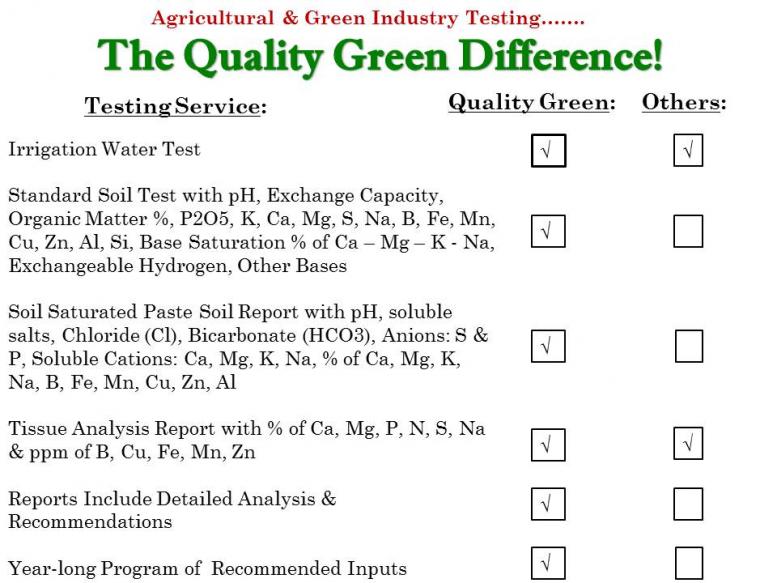
Thursday, September 1, 2016
Yesterday, another grove received an application of easy to spread, organic (OMRI listed) Azomite® volcanic mineralizer in granulated form. It has an amazing combination of minerals, all at the right levels, including 65% of available silicon dioxide (almost always limiting in sandy & very high organic soils) and over 70 minerals total. We are convinced it takes an on-going multi-prong effort including the best materials like Azomite and frequent nutritional sprays, but one grower told us that Azomite alone brought his grove back from Greening. Here a cover crop is being planted on the mowed areas mineralized with the Azomite. All of our fertilizer blends contain granulated Azomite. That is one of the many reasons it works so much better than other fertilizers. Photos taken 8-31-16.
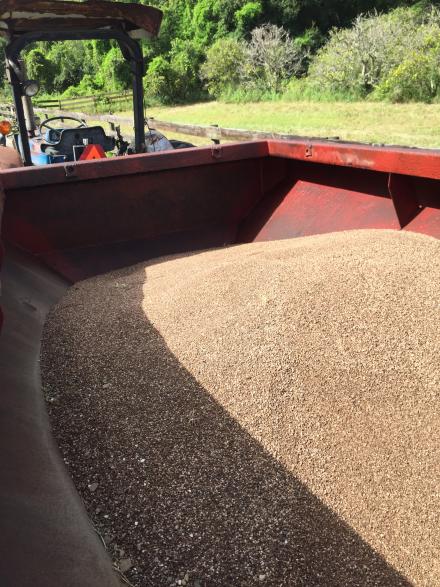
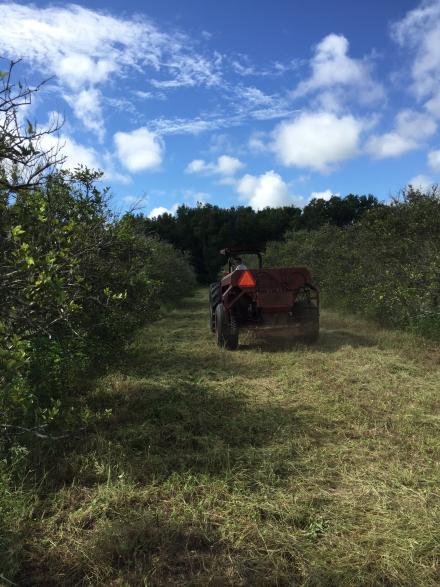
Wednesday, August 31, 2016
Yes, olives are starting to ripen on the Arbequina olive trees at the nursery as you can see below. Photo taken 8-30-16.
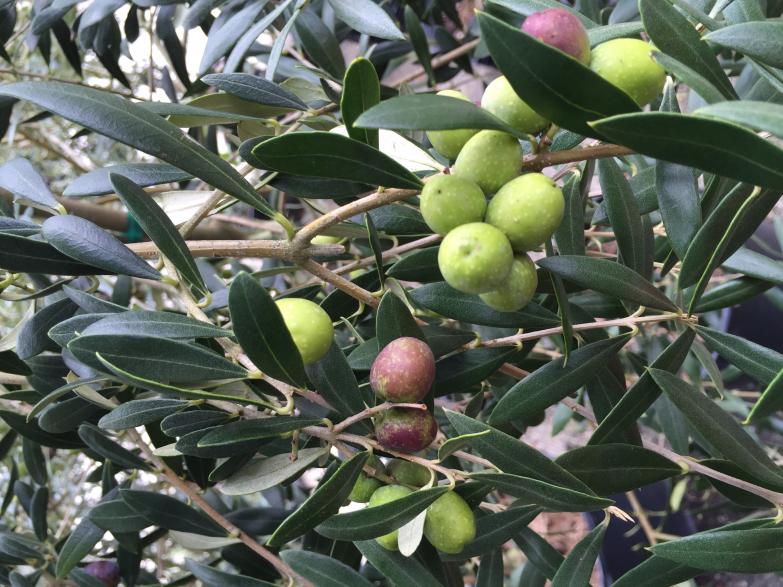
Tuesday, August 30, 2016
Attention Olive Growers – this is an an invitation to have your olives milled for oil:
Dear Growers, The Florida Olive Council will be collecting fruit from olive growers in Florida during the first week in September. We will mill the fruit in north Florida. If you have at least 100lbs of olives on your trees , please contact me. Thank You,
Michael O’Hara Garcia President Florida Olive Council, LAA 3324 W. University Ave. #160 Gainesville, FL 32607 (202) 246-2001 michael@floridaolivecouncil.org
Monday, August 29, 2016
This is a great time of year to have your soil tested and leaf tissue of your crop(s) analyzed. We pride our testing service and believe we have the best overall testing service available.
Q: Why do we strive to make our testing as good as possible?
A: We want to give you the best possible information so that your management decisions will be easy, precise, and effective. The bottom line: we want to see your crop production and quality increase significantly in order for you to make more money.
Q: What tests do we perform?
A: We perform irrigation water testing, standard comprehensive soil testing, saturated paste soil testing, and leaf tissue analysis. This time of year, we recommend the standard comprehensive soil test, saturated paste test and, for established crops, leaf tissue analysis. If your water has not been tested recently, we also recommend a water test.
Q: Why are two different soil tests necessary?
A: The standard soil test shows the total amount of all the key minerals in the soil, while the saturated paste analysis shows what will actually dissolve into the soil water and is available for uptake by the plant roots. Often there are sufficient levels in the soil of most minerals based on the standard test, while at the same time most minerals are deficient in the soil water because of various mineral sequestrations (tie-ups) between various minerals. Often, we find zinc (Zn) and manganese (Mn) less than (<)0.02 ppm (below the level of detection) in the soil water of Florida soils.
Q: Why is the leaf tissue analysis necessary?
A: It is true that a leaf tissue test is the last place a severe mineral deficiency will be found because plants will work hard (expend lots of resources/energy) to keep a more or less optimum level within the plant tissue, even against a severe osmotic gradient when minerals dissolved in the soil water are at a low level. However, when the supply of a mineral in the soil water is exhausted, the tissue content of that mineral in the tissue will soon become low or deficient. The minerals we sometimes find deficient in the leaf tissue are: manganese, zinc, copper, boron, calcium, and phosphorus. Nitrogen is rarely low in the tissue and in fact is usually excessive! When a mineral is found deficient in the tissue, immediate correction is needed. For trace mineral deficiencies, often rapidly absorbed liquid nutritionals through foliar spraying or fertigation are best. Correction of micronutrient deficiencies with soil applications often is more difficult because of soil tie-ups. Foliar zinc deficiency in Citrus should never be corrected with soil applications because it is easily tied up in the soil and most of what is taken up becomes clogged in the trunk of the tree. * Please note: If correction of a copper deficiency is necessary, always spray copper separately. Plant health and metabolic activity quickly decline when even one essential mineral is absent. All minerals are not created equal. Avoid unavailable oxide forms at all cost. To ensure fast correction of any deficiencies detected, we stock all essential minerals in very bio-available forms, primarily high quality natural and organic.
Q: What do we test for in the standard soil test that makes it better than the typical soil test performed by others?
A: We test for pH, cation exchange capacity (because as the exchange capacity increases, the optimum mineral holding capacity also increases, and is an important management tool along with the percentage of each mineral ion with a positive charge or cation in the base saturation of the soil) [Base saturation refers to the total and percentages of each base or cation held in the soil at the time of testing.], sulfur in parts per million (ppm), phosphorus by Mehlich III in pounds per acre (lbs/ac) & by Bray I in parts per million (ppm) [This tells you the potentially available and unavailable phosphorus in the soil and indirectly the level of mineralizing bacteria in the soil.], calcium in lbs/ac, magnesium in lbs/ac, potassium in lbs/ac, sodium in lbs/ac [Because sodium is taken up by the same root transporting mechanism as potassium, both are needed as a management tool – potassium should always be at least twice as much as sodium to avoid a potentially weak, disease prone & freeze susceptible plant], the micronutrients (trace minerals) boron, iron, manganese, copper, and zinc in ppm, the heavy metal aluminum (potentially very toxic, particularly if found at over 400 ppm and the pH is a too acidic 6.0 or less), and silicon (the second most important mineral – after carbon – for plant growth as available silicon dioxide, unlike the silicon oxide in sand). We test in more ways than most other soil tests. Many soil tests do not even test for iron, but you need to know how much iron there is in the soil to manage effectively. High iron levels tie up manganese and phosphorus, for example. We explain each of these tests (and relate them to the saturated paste and tissue analysis) in our complete, easy to understand recommendations.
Q: What do we test for in the saturated paste report?
A: pH, soluble salts (ppm), chloride (ppm), bicarbonates/HCO3 (ppm) [important to be low to help remediate HLB/Citrus Greening Disease], sulfur (ppm), phosphorus (ppm), calcium (ppm), magnesium, (ppm), potassium (ppm), sodium (ppm), percent each in the soil water of calcium, magnesium, potassium, and sodium, ppm of the trace minerals, boron, iron, manganese, copper, and zinc, and ppm of potentially toxic aluminum.
Q: What do you test for in the tissue analysis report?
A: Percentages in the tissue of calcium (Ca), magnesium (Mg), phosphorus (P), potassium (K), nitrogen (N), sulfur (S), and sodium, and ppm of boron (B), copper (Cu), iron (Fe), manganese (Mn), and zinc (Zn).
Now you see why we can give you the finest recommendations because we do the most complete testing. Plus, we give you a recommended program of exact inputs for your crop (s) at your specific location for the entire season. Plus, if you wish, we will mix and deliver (in bags or bulk) the custom-blended products precisely when you need them. Now you know why growers who follow our recommendations are seeing remarkable improvement in crop health and production. By the way, we do all three tests, the individualized recommendations and the season-long program recommendations for a very reasonable fee, which is credited toward the purchase of our high quality, reasonably-priced products. The cost of the standard soil test is $50.00. The cost of the saturated paste report is also $50.00. The cost of the leaf analysis report is $65.00. All this for $165.00 and that includes the detailed recommendations for needed inputs and site-specific season-long nutritional program recommendations.
Saturday, August 27, 2016
This olive oil has some of the first commercially produced oil from Florida olive trees and a 10% off coupon to boot!
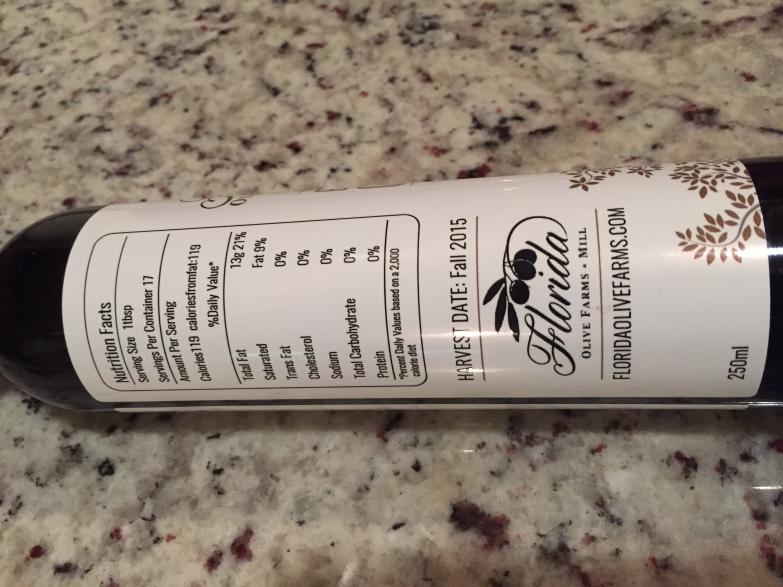
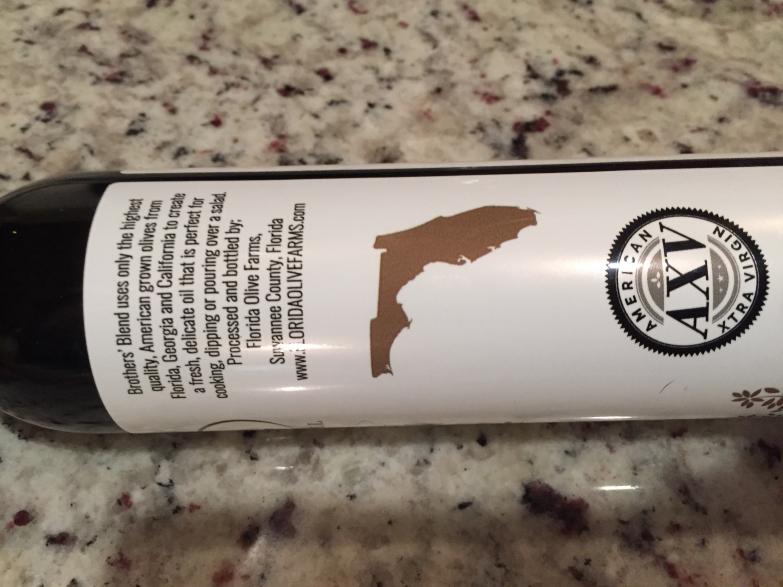

Thursday, August 25, 2016
Good news for all our customers. We have been able, thanks to our volume sales, to lower the price of our great Super Blend Compost from $95.00 per yard to only $75.00 per yard. The same great compost, now at a more affordable price! Try it for all your raised beds and planting needs – you’ll be glad you did! Try our great potting soil as well. The price of our potting soil is $65.00 per yard. Volume discounts apply to both. Prices plus delivery or you can buy by the yard or by the bag at the store. Price per 32 Quart bag of potting soil is $7.50 and $8.50 for Premium Organic Compost.
Yesterday, Allen & I are visited Citrus growers and helped them set up two field trials of a new Organic foliar spray material designed to compliment our Citra Thrive Plus in further suppressing the Liberobacter (HLB/Greening) bacterium and the psyllid that spreads the Liberobacter. The old saying is “The Best Never Rests”.
Monday, August 22, 2016
Below: Yes, we have lots of 7 gallon Florida Prince peaches in our great potting soil (and yards for sale)!
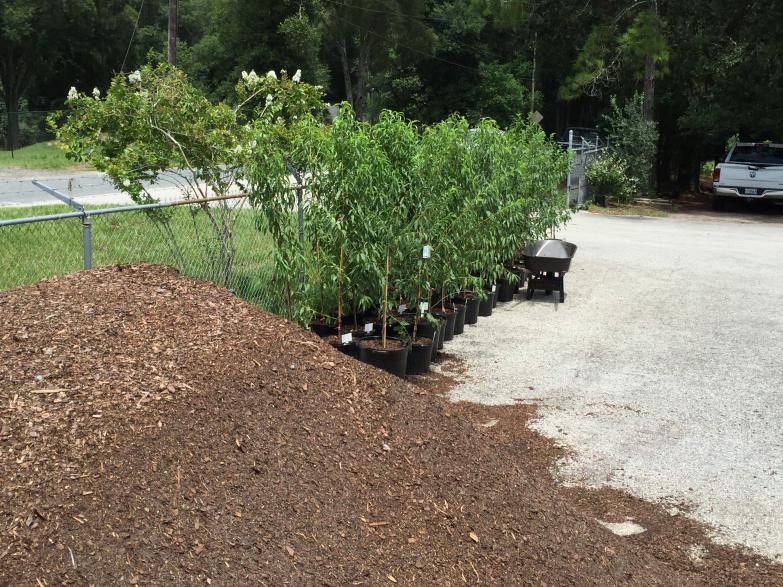
Tuesday, August 16, 2016
Below is a new brochure, “Did You Know?”, for sharing at the Citrus Expo in North Ft. Myers this week, Wednesday & Thursday, August 17 & 18. We will be outside the Expo Center by the walk going from the Main Hall to the Educational Hall where the educational sessions will be held. For more information, go to:
http://citrusexpo.net/about/

Saturday, August 13, 2016
Yes, we are open today 8-5. The front display is eye-catching, making it easy to find us at 1639 N. State Road 15A (Spring Garden Ave.), DeLand 32720. Turn on Greens Dairy Rd. to the main entrance & paved parking lot behind our store – the wide selection of fancy fruiting plants & fruit trees will amaze you. Come visit today and see for yourself. See the front display, Citrus section & new crop staked olives below. Photos taken 8-11-16.
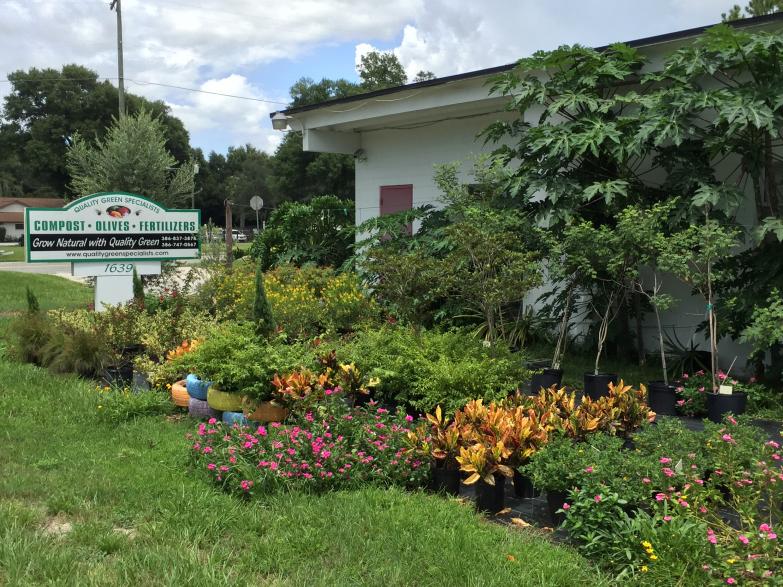


Thursday, August 11, 2016
Yesterday, Allen and I checked groves for HLB (Citrus Greening) following our extensive testing and grower folllow-up treatments in the Wauchula area. All the groves following our recommendations showed noticeable improvement and have a much larger and better, more uniform-sized fruit load this summer compared to last summer:
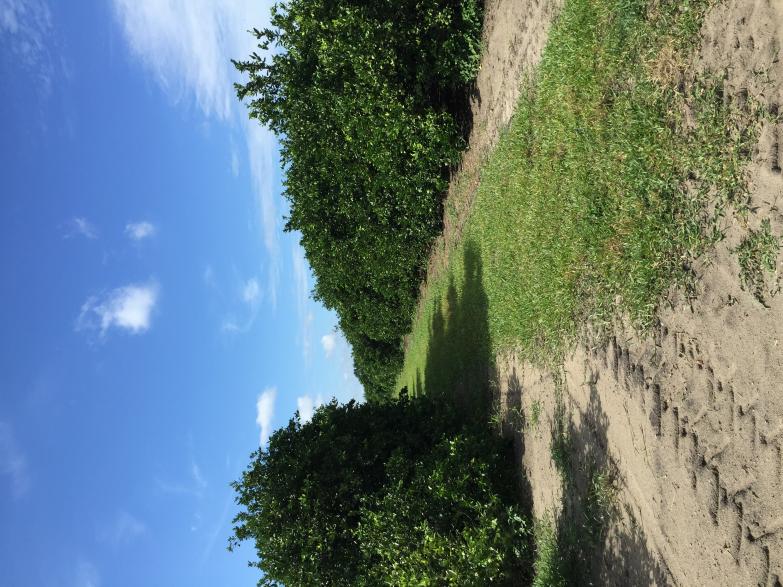
Above: Ron Kelly’s grove is no longer showing HLB & deficiency symptoms and there is a large fruit load with no fruit drop to date. We tested the soil and tissue to make sure all minerals are optimum to help ensure that there is minimal fruit drop this year, e.g., Calcium (Ca) in the leaf tissue has been elevated to the optimum 4.5%. Photo taken 8-10-16.
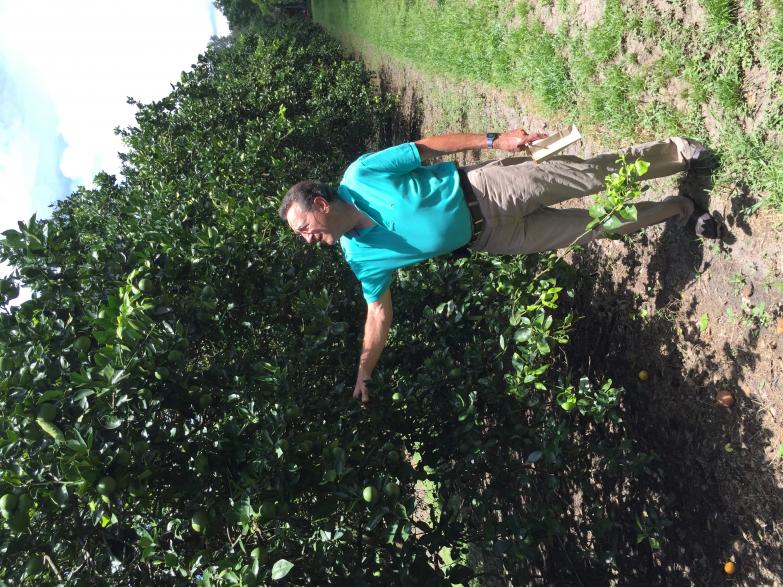
Above: Co-owner Allen Day demonstrating Wilbur Robertson’s green, healthy grove devoid of HLB and deficiency symptoms seen last year. Not only that, the fruit load is heavy with uniform, properly sized fruit for this time of year, with minimal fruit drop. We did the testing to help ensure that the minerals are optimized to help ensure high pound solids and to keep these beautiful fruit on the tree until they are harvested. Photo taken 8-10-16.
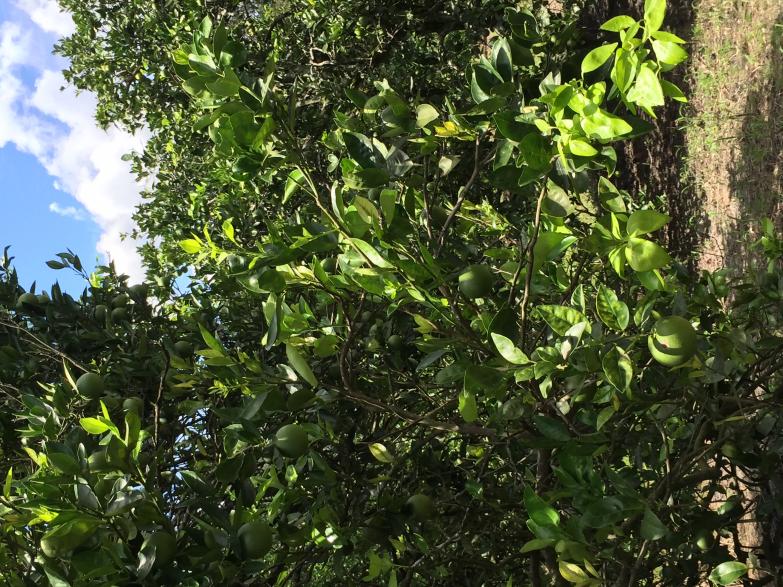
Above: Another nearby grove without our treatments still showing HLB and deficiency symptoms throughout the grove. Photo taken 8-10-16.
Wednesday, August 10, 2016
Growers, it’s time for annual soil testing and leaf tissue analysis. Compare our testing service against any other, and you will find that our testing and recommendations are by far the best. Put me to the test. Call me today on my cell at 386-837-3878 and I will be happy to visit your farm or grove soon at a time convenient to your schedule.
The Nursery at Quality Green has never been more fully stocked. Come by and see a full selection of Citrus, peaches, olives, figs, guavas, strawberry guavas, plums, pears, mulberries, blackberries, blueberries, apples, sugar apples, pineapples, avocadoes, papayas, feijoa (pineapple guava), and more.
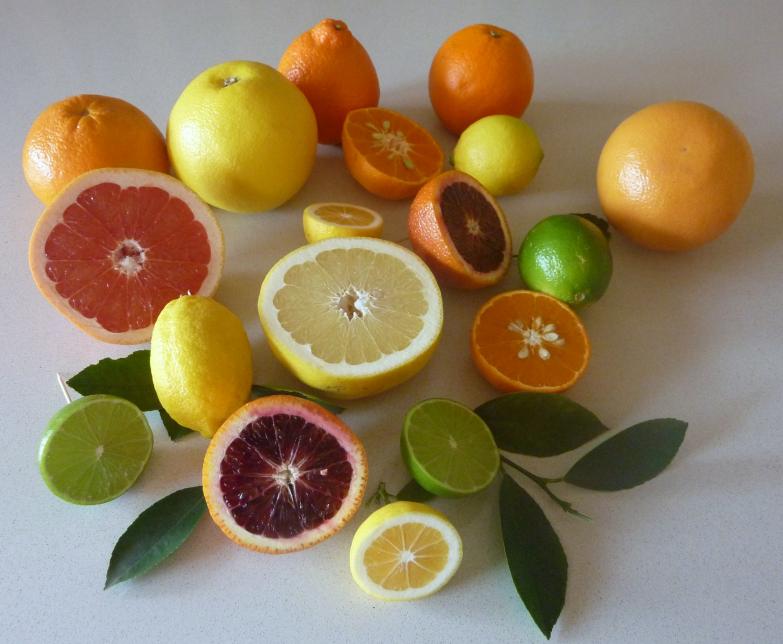

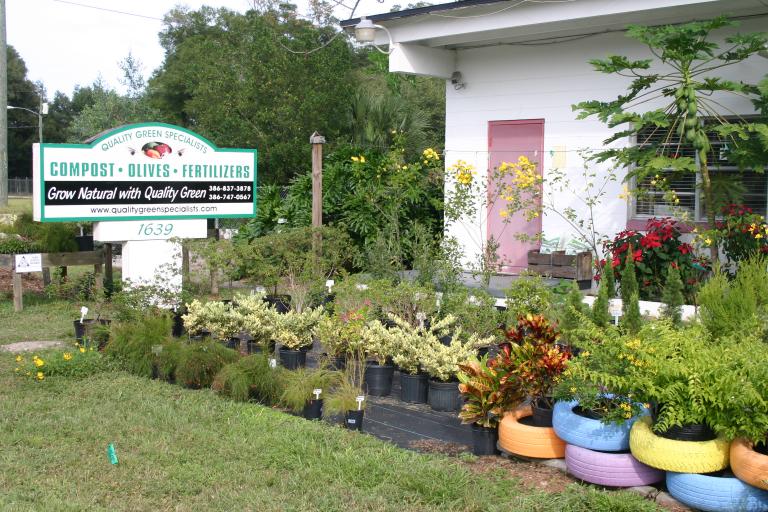
Thursday, August 4, 2016
Today is the day that we are working to get our new low-volume irrigation system up and running at our Fruit Tree Nursery. Now all the trees in the back section of the nursery will have daily pulse irrigation.
Tomorrow is Farmers Market Day at Artisan Alley from 6-9 p.m. in downtown DeLand.

One of our olive trees with fruit at Artisan Alley on a beautiful Friday evening.
Tuesday, August 2, 2016
Field peas such as black-eye peas are a very popular crop in the summer in Florida and the south. Here are some things to know before planting field peas. The same basic information applies to growing or establishing other legumes (often as a cover crop); the difference is that the type of nitrogen fixing bacteria varies, depending on the type of legume being grown.
Most all the nitrogen required by field peas will be supplied by Rhizobium nitrogen fixing nodules on the roots of the plants if the Rhizobium bacterium is present. A low starter rate of around 30 pounds of nitrogen per acre (lbs N/ac) may be required for early plant development on low nitrogen soil (which is typical). To ensure large numbers of this nitrogen fixing Rhizobium are present in the peas nodules, you should inoculate pea seed at sowing with Rhizobium leguminosarum bv. viciae if the field has not been inoculated with this rhizobium, or has not grown a crop of a suitable host legume in the last 4 years. [bv. represents biovar; a biovar is a variant prokaryotic strain that differs physiologically and/or biochemically from other strains in a particular species; Bacteria are prokaryotes, which consist of a single cell with a simple internal structure.] Extension services have good publications on inoculating seeds with nitrogen-fixing bacteria. *Note: Compost will not work for inoculation because compost contains composting microbes, but not the Rhizobium bacterium; however digested compost is very helpful for supplying much needed carbon (see end of next paragraph).
The fixed nitrogen is not free; the plant must contribute a significant amount of energy in the form of photosynthate (photosynthesis-derived sugars) and other nutritional factors for the bacteria. However, some legumes are more efficient than others. Cowpea, for example, requires 3.1 mg of carbon (C) to fix 1 mg of N. White lupin, however, requires 6.6 mg of C to fix 1 mg of N (Layzell et al., 1979). A soybean plant may divert up to 50% of its photosynthate to the nodule instead of to other plant functions when the nodule is actively fixing nitrogen (Warembourg et al., 1982). Reference: New Mexico State University College of Agricultural, Consumer and Environmental Sciences | ACES Because field peas require over 3 mg of carbon to fix 1 mg of nitrogen, this shows the importance of available, digested carbon/organic matter in the soil and/or humates primarily in the form of bio-available fulvic acid (which is available in high amounts in some of our foliar products).
Any stress that reduces plant activity will reduce nitrogen fixation. Factors like temperature and water availability may not be under control, but nutritional stress (especially phosphorus, potassium, zinc, iron, molybdenum, and cobalt) can be corrected with fertilizers. When a nutritional stress is corrected, the legume responds directly to the nutrient and indirectly to the increased nitrogen nutrition resulting from enhanced nitrogen fixation. Poor nitrogen fixation in the field can be easily corrected by inoculation, fertilization, irrigation, or other management practices. Reference: New Mexico State University College of Agricultural, Consumer and Environmental Sciences | ACES
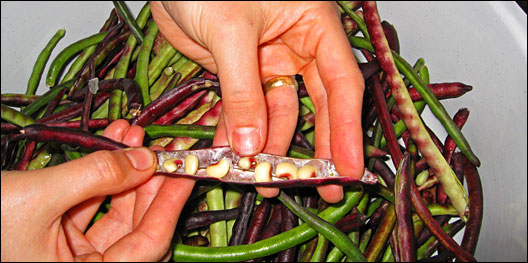
Yes, even dooryard Olive trees will set clusters of fruit in central Florida. And who could ask for a more beautiful framing tree for a home?
Saturday, July 30, 2016
We are open today, Saturday, from 8-5. Come by and see the best selection of fruit trees & fruiting plants in central Florida. We are located at 1639 N. Spring Garden Ave., DeLand, FL 32720. Then, if you agree, follow this link and vote for us for “Best of the West” in the Daytona Beach News-Journal annual readers poll: http://news-journal.secondstreetapp.com/l/Daytona-Beach-NewsJournals-Best-of-West/Ballot
Under “Around the Home” scroll down to “Fruit Tree Sales” to cast your ballot.
You have until August 5th to cast your ballot. Thanks to all of you for voting us Best of the West for Fruit Trees in 2014 and 2015.
Friday, July 29, 2016
Today from 6-9 p.m., I’ll be at the Artisan Alley Farmer’s Market in the heart of downtown DeLand just S.W. of U.S. Hwys. 17-92 (Woodland Blvd.) and S.R. 44 (New York Ave.) behind the Beacon newspaper office and by The Nest. For your convenience, I’ll have 10 pound bags of premium blend potting soil, premium-blend compost, and Super Green 3-0-5 Fertilizer. Also, I’ll have olive trees (Olea Europea, var. ‘Arbequina’) and some organic produce: peppers, okra, and sweet potatoes. Check out all the other vendors as well! Come by the nursery today from 8-5 for a complete selection of fruit trees and natural & organic fertilizers, potting soil, compost and more.
Thursday, July 28, 2016
The red crape myrtles are making a big splash of color at Quality Green Nursery:
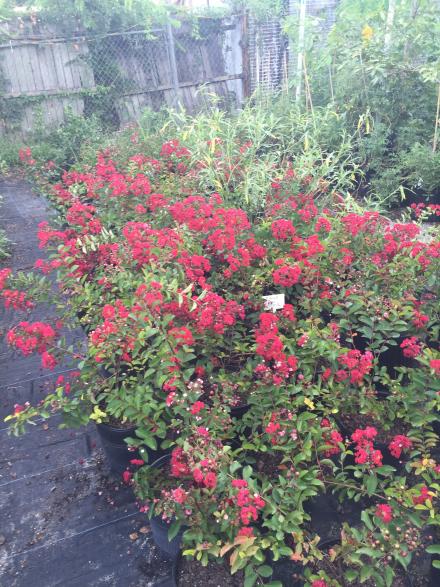
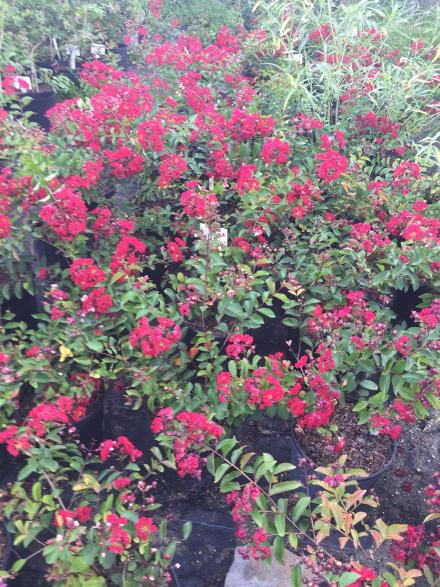
Wednesday, July 27, 2016
If you have a warmer or well-protected location, you may like to grow a mango tree in central Florida. In fact, I just ate one from my garden tree in DeBary. Here is a good article to learn more about how to propagate and grow mangoes. I would suggest keeping a mango tree well pruned so that it can be protected in case of a hard freeze that may happen from time to time in central Florida. If you grow a tree from seed, make sure it is a known poly-embryonic variety (see details in the below article):
Growing Mangoes (Mangifera indica)
From Tropical Permaculture [an Australian source, with a few comments from yours truly]
Permaculture is about “…saving the planet and living to be a hundred, while throwing very impressive dinner parties and organising other creatures to do most of the work.”
How To Grow Mango Trees From Seeds
Mango trees are extremely easy to grow and manage.
In the right climate growing mangoes takes no effort or attention at all.
Through my friends I can get all the mangoes I want for free, and then some. But I still grow mango in my own garden, about a dozen different varieties.
Mangoes come in different colours and sizes, have different flavours, and they ripen at slightly different times.
Growing different mango tree varieties keeps things interesting, but most importantly it stretches out the harvest time of this feast or famine fruit. You can eat fresh mango for a few months instead of only a few weeks!
What do mango trees look like?
The mango is a very attractive, evergreen tree with glossy, dense foliage. The new shoots are reddish, the mature leaves a dark green.
Depending on the variety mango trees can grow huge (to 35 m and 15 m across for seedling trees of older varieties). But you can keep a mango tree small by pruning it regularly.
A mango tree in full flower is a sight to behold. The large pink panicles are at the ends of the branches and cover the whole tree. Oh, and they smell good, too!
Where can you grow mangoes?
Mangoes are a strictly tropical fruit. They love the tropics. The best climate to grow mangoes is frost free, with cool, dry winters and steamy, hot summers.
Mangoes like growing in light and free draining soils, they don’t need rich soil. You actually get the best crops on soils of somewhat lower fertility.
Getting started with growing mangoes
There are two ways to get started: you can buy mango trees at a nursery or you can grow your own from seed. The seed grown trees will take a lot longer to bear fruit. (Unless you know how to graft them or know someone who does.)
Mango trees that were grown in a nursery are usually grafted and should fruit within three to four years. Seedling trees may take five to eight years.
Seedling mango trees grow much bigger and stronger than the nursery trees and have an indestructible root system.
Grafted trees are of a more manageable size. Another advantage is that you know you will get a reliably bearing tree. If you grow mango from seed you need to know exactly which tree your mango seed came from or you won’t know what you are getting until eight years later…
If you buy mango trees in a nursery I suggest you don’t look just for size and colour. Have you ever tasted the variety you are about to buy? Some mangoes taste awful… True. Some of the commercial varieties are bred for shelf life, size and looks, but are barely edible. (Yes, I am totally spoiled when it comes to mangoes.) So, know the variety you buy!
Secondly, if you plan to grow more than one mango tree, find out if it is an early or late fruiting variety. Don’t buy three trees that all fruit at the same time.
Thirdly, if you live in a cooler, subtropical area, make sure you get a variety that flowers well in those conditions. All mangoes will grow if your climate is frost free, but flowering habits depend on temperature and vary. And without flowers there will be little fruit…
And last but not least, especially if you live in an area where it may rain during the cooler time of the year, you should also look for a variety that shows good resistance to the mango disease anthracnose. (More on that below.)
If you buy your mango trees you can skip the next section:
Growing mango trees from seed
Growing mangoes from seed is actually quite easy. (All the seeds of the mangoes I eat, dry and freeze are thrown out in the garden as mulch, and they all grow…)
The most important step is the seed selection! If you take any old shop bought seed it may not grow true to type. The seed needs to come from what is called a “poly-embryonic” variety.
[Poly-embryonic seeds produce a number of shoots, one of which originates from fertilization. The fertilized seedling is often weak and stunted and should be discarded. The other seedlings are clones of the mother tree.
See the following site for a list of poly-embryonic varieties:
http://forums.gardenweb.com/discussions/2181543/mangoes-polyembryonic-source
I just ate a delicious Thong Dam – pronounced like tong dum – (Black Gold) mango from Thailand. It is absolutely delicious and fiber-less. The seed sprouts quickly and easily, but unfortunately it is a mono-embryonic variety and sprouts only one seedling that may not be like the parent.] The skin of this mango remains green even when it is ripe. This fools the animals, but it is difficult to know when they are ripe.
Ideally you know the parent tree, it’s from your area, grows really well and gets a bumper crop every year! If not, oh well. Get seed from a poly-embryonic variety and at least you know that the fruit you harvest will taste the same.
The best time to grow mangoes from seed is the beginning of the wet season (beginning of summer).
Eat a nice mango, remove as much flesh from the seed as possible and then let it dry for a day or two.
To germinate the mango seed you could just put the whole thing in a warm, moist place and wait for it to sprout. Then cut off all the seedlings except for one. (The smallest supposedly gives you the best fruit.)
Or, if you prefer to fuss over them (or if you have only one seed but want half a dozen trees) then you can carefully cut a corner of the fibrous big seed. Cut only just deep enough so you can see the two halves of the seed, and then break it open.
Inside you find several small bean shaped seeds. Hopefully they are white and not all grey or brown and shrivelled…
You can plant those mango seeds individually. They should take about ten days to sprout. I like to sprout my seeds right where they are to grow. That way I don’t need to worry about hardening them off (getting a shade grown seedling used to full sun) or about transplanting shock. If you are worried about the little thing getting eaten, uprooted or trampled you can always put a barrier around it.
If you prefer to first grow your mango tree in a pot, follow the instructions for nursery trees when it comes to planting time:
Planting a mango tree
You plant a mango tree just like you plant any other fruit tree, so I won’t go into specifics here. (A page about planting fruit trees is coming soon.)
The best time to plant your mango tree is the beginning of the wet season (summer).
Make sure you select a place in full sun. (And make triple sure you really want a big tree there!)
The tree needs to be sun hardened. If your mango tree was grown in a shade house, gradually get it used to the sun first. Then dig a big enough hole. Carefully separate tree and pot without disturbing the roots. Put tree in hole, fill in, water.
Caring for a mango tree
I mentioned at the beginning that mangoes need little care. It’s true.
Young mango trees do benefit from regular watering and a little fertilizing until they are established. But don’t love your mango tree to death. Overwatering can kill it, especially if your soil is a bit heavy. And too much nitrogen fertilizer will make it weak and sappy, all leaves and little fruit, susceptible to bugs and diseases.
The older the tree gets, the less nitrogen it needs. Phosphorus and potassium are more important.
Mulch your mango tree heavily and spread a bit of compost every now and then. If your soil is reasonable that should be all the tree needs.
If the compost is made with wood ash, all the better. (Wood ash supplies potassium which will encourage fruiting and make the fruit taste better.) For mulch use only rough stuff like hay or lucerne, nothing that may mat down and become all soggy like grass clippings. [Try using our Azomite® volcanic pumice or our 4-0-5 (formerly 3-0-5) Fertilizer that contains lots of volcanic pumice and lots of potassium magnesium sulfate and other organics and beneficial microorganisms – nothing works better!]
Fertilize mango trees in spring and summer only, and only a little at a time.
A good way of helping the tree is foliar spraying with fish fertilizer or seaweed solution. It provides trace elements and avoids deficiencies, but it doesn’t overfeed.
But your best bet, even on very poor soil, is still lots of organic matter by way of compost and mulch.
When the tree is one metre high, cut it back by a third so it branches.
When those branches get to a metre, cut the tips off again.
That should give you a nice shaped tree.
Pruning a mango tree
Mangoes respond very well to pruning. And they are forgiving. Whatever you mess up, it will grow back…
Mangoes grow terminal flowers (they flower at the tip of a branch), so the more branches you have the better the crop. You can encourage lateral branching with tip pruning. (Only taking off the tips of branches.)
You should also aim for an open crown, taking out whole branches if the centre becomes too crowded, so that air and light can penetrate.
You can use pruning to keep your tree a manageable size and a nice shape. Mango tree growing too tall? Cut it down. Too wide? Cut it back.
Pruning mangoes is not a science. In fact, the commercial growers here hire a big, scary machine with a long arm with three huge rotating blades.
The machine drives along the rows and gives the trees a good hair cut so they all end up exactly the same height and width… You can do something similar by hand if you want to keep your tree a certain size.
Usually mango pruning is done after harvest, though in some cooler areas the preferred time is just before flowering.
Ideally you prune only a little bit every year. If you let a mango tree grow much too big first, and then cut it back to a third of its size, the tree will likely skip the next crop… (Cut it back to a stump and it will take two years or more. But amazingly they will grow back even from that!)
Having said all that, after the initial cuts to encourage branching as mentioned in the previous section, you don’t HAVE to prune a mango tree. If you don’t mind having a real big tree, mangoes grow and fruit very well without pruning!
Flowering, fruit set and harvesting mangoes
Mangoes flower profusely and self pollinate very well.
The flowering is triggered by cool nights. In the true tropics a severe cold snap will bring out masses of flowers. For us a severe cold snap is a night below 15°C. In years where it doesn’t get so cold we end up with poor crops.
(But there are mango varieties that flower well even when it doesn’t get so cold… That’s why I grow a dozen different ones.)
In colder climates it can easily be too cold for mango flowers to be viable. Selecting cold hardier varieties is important for you. (Nam Doc Mai would be a suitable variety in Australia.)
Initially you may see masses of tiny mangoes on your flower panicles, but the tree will shed a lot of them and keep only what it can handle. So don’t worry if you see a lot of them drop off.
The mangoes will grow bigger and plumper, and eventually they will start to change colour. How long that takes depends on your climate. The hotter the weather the faster the mangoes ripen.
Usually your mangoes will be ready by the beginning of the wet season (late spring/early summer).
If your mangoes get eaten (wild birds, bats, possums, the neighbour’s kids…) you can pick them half green. They will ripen at room temperature. (Ha! My rooms are about 40°C at that time of the year… when they say room temperature they mean 18-22°C.)
Be careful when harvesting mangoes, don’t get any of the sap on you. The sap can spurt from the fruit stem when it snaps off and can cause burns, allergies and dermatitis.
It also burns the skin of the mango, which will go rotten at that spot.
(Doesn’t matter if you eat it straight away, but it does when you pick them half green.)
The best way to harvest mangoes is to cut them off with a long section of stem still attached, and to handle them carfully so that the stem does not snap off.
Mango pests and diseases
The most serious mango disease is anthracnose, a fungus that can cause the flowers to go black and fall off. It also causes black spots on stem and small fruit, leaves may go brown…
Some varieties are more susceptible to it then others and it’s worse in wet weather. It is worst in areas where it rains during flowering and fruit set. In areas with dry winters anthracnose can often be seen only once the fruit ripens. It develops black patches that go rotten…
Unless you want to spray nasty stuff, like copper solution or fungicides, you may have to live with anthracnose and accept some losses. A healthy tree with strong cell walls will show less infections than a weak one. So keep piling on that compost and spraying that seaweed…
There are many newer mango varieties that show good resistance to anthracnose. Get one of those if you live in a climate with winter rains!
Any other mango pests and diseases, like fruit spotting bugs and borers and whatever else is around, should be kept in check if you have a diverse permaculture garden that encourages beneficial insects.
One more hint is to forsake neatness and leave your lower mango tree branches drooping onto the ground. When everything else has been stung, sucked and eaten, there are usually still mangoes hiding under there…
Can you grow mangoes indoors?
Nope. But you can grow mangoes in pots! So if it is just a little bit too cold in winter where you are, you can buy a dwarf variety and grow it in a tub and bring it inside during the coldest time of the year.
However, even a mango tree growing in a pot still needs lots and lots of heat and sun in summer. Growing mangoes indoors won’t do!
Tuesday, July 26, 2016
Yesterday, I visited two orange groves near Dundee and Lake Wales. Following our testing and recommended inputs, including the use of our Citra Thrive Plus, they are healthy and full of fruit. For more information about our testing protocol, Citra Thrive Plus, and CitrusPro Fertilizer, go to the third tab on the left: Citrus Greening Answers.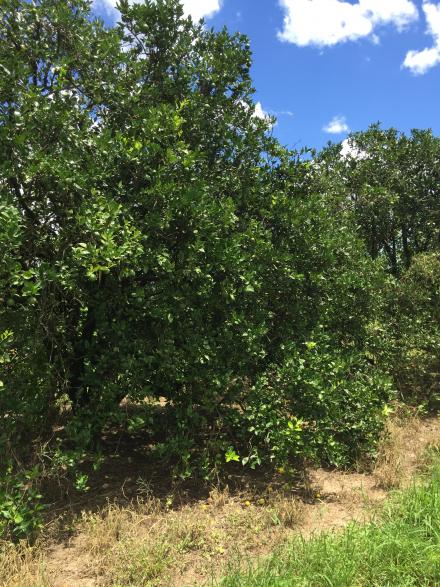
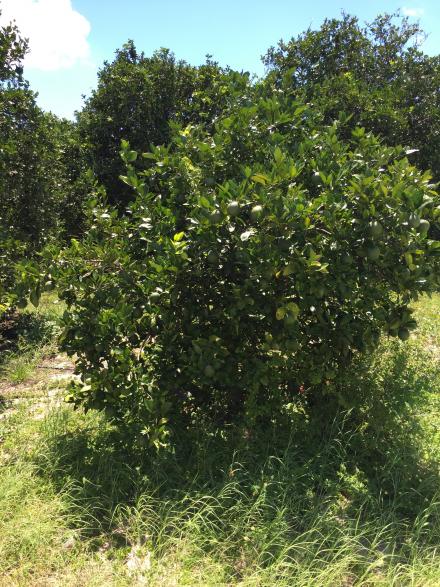
Monday, July 25, 2016
In a protected location, yes you can grow Mangoes in central Florida. I picked another beauty yesterday from the tree in the landscape in DeBary. 
Everyone enjoyed Artisan Alley Farmer’s Market last Friday night. I sold okra, sweet potatoes, Sweet Banana peppers, our great potting soil and compost, our Multipurpose 4-0-5 Fertilizer, and a red Crepe Myrtle.
Friday, July 15, 2016
Today from 6-9 p.m., I’ll be at the Artisan Alley Farmer’s Market in the heart of downtown DeLand just S.W. of U.S. Hwys. 17-92 (Woodland Blvd.) and S.R. 44 (New York Ave.) behind the Beacon newspaper office and by The Nest. For your convenience, I’ll have 10 pound bags of premium blend potting soil, premium-blend compost, and Super Green 3-0-5 Fertilizer. Also, I’ll have olive trees (Olea Europea, var. ‘Arbequina’) and some produce: peppers, okra, and papayas. Check out all the other vendors as well! Come by the nursery today from 8-5 for a complete selection of fruit trees and natural & organic fertilizers, potting soil, compost and more.
Thursday, July 14, 2016
Our new crop of strawberry guavas and large ‘Meaty Pink’ & ‘White Snow’ guavas are looking nice and are ready for sale:
Below: Our new crop of Arbequina olives, ‘Dana’s White Peach’, and ready-for-sale Cassava plants (back center, below photo) are coming along fine (plus, we have large olive trees ready for sale):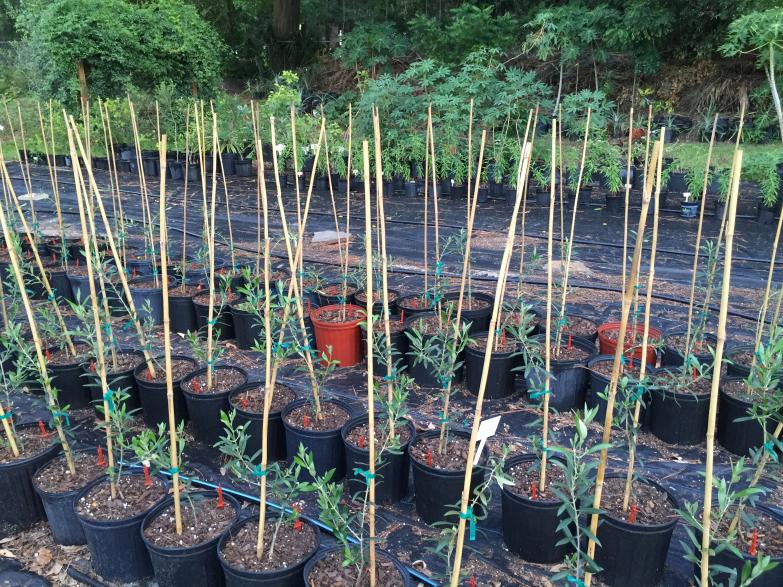
Below: The 7 and 15 gallon olive trees are super nice and the 15 gallon trees have lots of olives on them.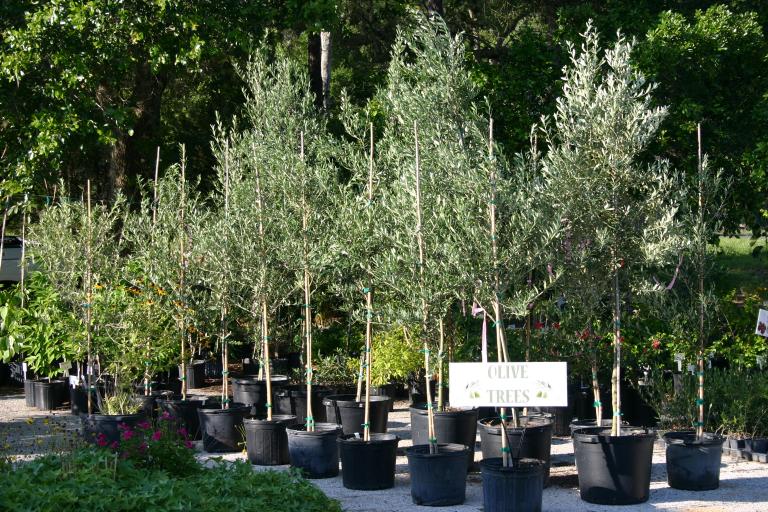
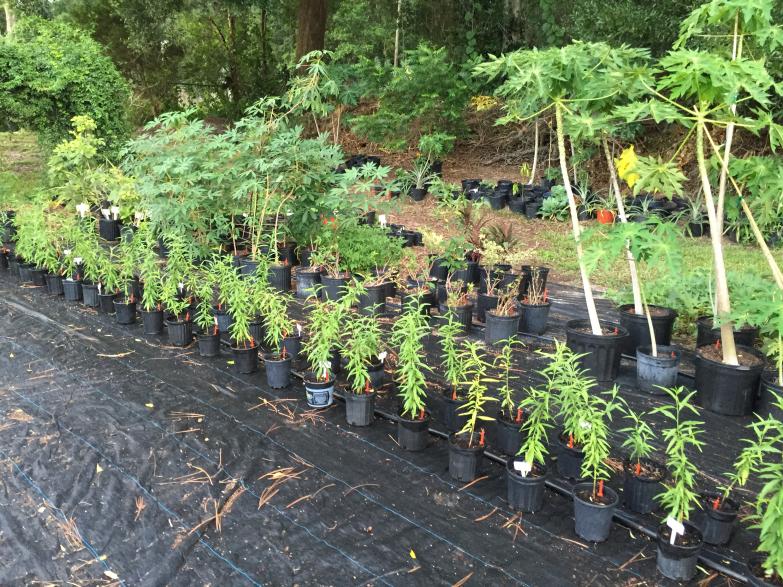
Above: Close-up of Dana’s White Peach, a super hardy, extra delicious, sweet, freestone peach. (Cassavas are pictured in the back left & papayas are on the right).
Thursday, July 14, 2016 (continued):
Tomorrow from 6-9 p.m., I’ll be at the Artisan Alley Farmer’s Market in the heart of downtown DeLand just S.W. of U.S. Hwys. 17-92 (Woodland Blvd.) and S.R. 44 (New York Ave.) behind the Beacon newspaper office and by The Nest. For your convenience, I’ll have 10 pound bags of premium blend potting soil, premium-blend compost, and Super Green 3-0-5 Fertilizer. Also, I’ll have olive trees (Olea Europea, var. ‘Arbequina’) and some produce: peppers and okra. Check out all the other vendors as well!
Thursday, July 7, 2016
Today, we installed six irrigation lines with low volume emitters in the back half of the nursery capable of watering 1,000 trees. With daily pulse irrigation (two cycles of watering every day), the grow-out time for our fruit trees will be much quicker and the quality of the plants will be even better. (Caution: do not water your crops or yard twice per day – water your yard twice per week at most in the summer). We will still hand water the front half of the nursery with ready to sell trees. Below is a photo of a sweet potato bed and our large fruiting olive trees ready for planting in the background.
Saturday, July 2, 2016
The olive tree I took to the Farmer’s Market last evening had lots of olives on it. It is one of our largest 15 gallon trees. We also have nice 7 gallon, 3 gallon, and 4″ liner trees.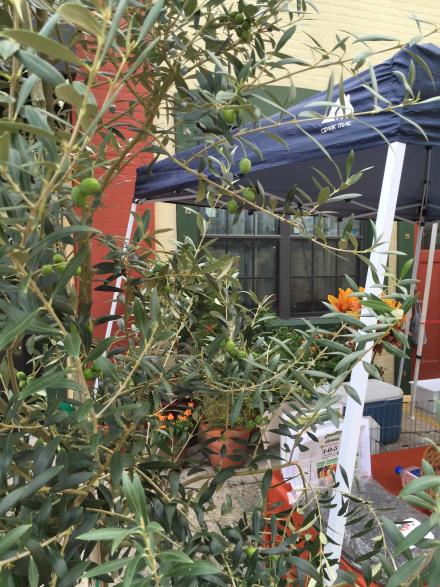

Friday, July 1, 2016
We have the best selection ever of high quality fruit trees. Come to The Nursery and see for yourself. The Nursery is behind our Organic Fertilizer Store at 1639 N. Spring Garden Avenue, DeLand, FL 32720. We are open 8-5 today and tomorrow, Saturday July 2. We’ll be closed Sunday, July 3 and Sunday, July 4 except for watering the nursery plants. (They never take a day off.)
Tonight from 6-9 p.m., I’ll be at the Quality Green Specialist’s booth at the Artisan Alley Farmer’s Market in the heart of downtown DeLand just S.W. of U.S. Hwys. 17-92 (Woodland Blvd.) and S.R. 44 (New York Ave.) on Artisan Alley by The Nest. For your convenience, I’ll have 10 pound bags of premium blend potting soil, premium-blend compost, and Super Green 3-0-5 Fertilizer. Also, I’ll have olive plants (Olea Europea, var. ‘Arbequina’) and some produce: peppers, okra, and fresh-picked sunflower seeds.
Thursday, June 30, 2016
Today, I am asking questions to illustrate the importance of a working knowledge of plant nutrition, and the value of comprehensive testing and complete nutrition.
1. Did you know that the most important element for growing plants is carbon?
2. Did you now that the biologically active part of carbon that is easily metabolized is fulvic acid? (Fulvic acid is humic acid with an extra oxygen.)
3. Did you know that Quality Green uses humates that have been energized (an extra oxygen added) to contain over 58% fulvic acid?
3. Did you know that silicon is the second most important element for growing plants?
4. Did you know that silicon dioxide is the available form of silicon that plants take up (unlike sand, which is unavailable silicon oxide)?
5. Did you know that Quality Green Specialists has the best source of silicon dioxide in the form of Azomite® volcanic pumice?
6. Did you know that silicon promotes sturdy plants, develops strong vascular tissue, properly aligns leaves to the sun, suppresses disease infections, relieves stresses, and promotes more cold hardiness?
7. Did you know that hydrogen & oxygen (from air and water) are more imortant than the primary fertilizer elements N-P-K, secondary fertilizer elements, and micronutrients?
8. Did you know that Quality Green Specialists addresses all of these factors with their research-based, primarily organic fertilizers?
9. Did you know that our fertilizers work so well because they supply everything a plant needs with good slow release/controlled release minerals in research-based amounts (scroll down to see some of our fertilizer labels)?
Wednesday, June 29, 2016
Yes, we have 30 gallon Citrus trees in stock and we are ready to deliver!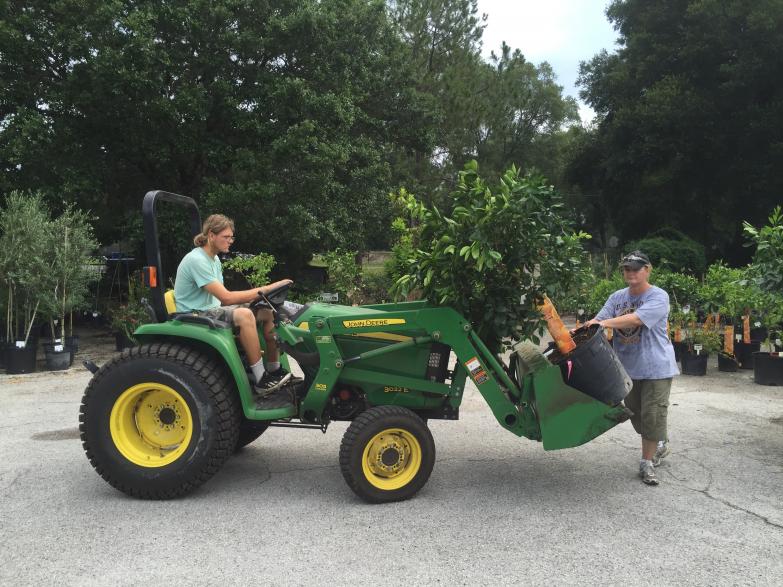
Above: Alex Andrews on the left and Sonya Mayer on the right.
Tuesday, June 28, 2016
Our new label for our Organic-based 4-0-5 Fertilizer is now completed:
Monday, June 27, 2016
The web-site issues have been resolved – we are back on-line! The Pitaya (Dragonfruit) at the nursery has just finished blooming. Talk about spactacular! We do have pitaya in gallon pots. Pitaya is a type of cactus and each bloom is open only for one night. The fruit of the dragonfruit is absolutey delicious.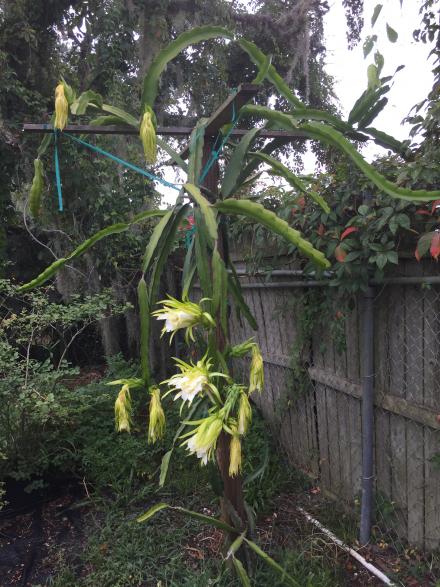
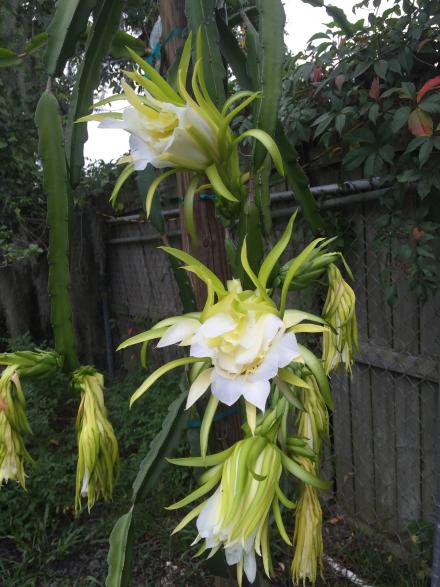

Thursday, June 16, 2016
Just in time for the Florida Citrus Industry Annual Conference, I would like to announce the release of our proprietary Quality Green CitrusPro Fertilizer with a label that does justice to this great fertilizer (designed by yours truly). CitrusPro is designed to be used in combination with foliar applications of Citra Thrive Plus, both being modified based on our comprehensive analytical testing. You just have to try CitrusPro to believe how good it is:
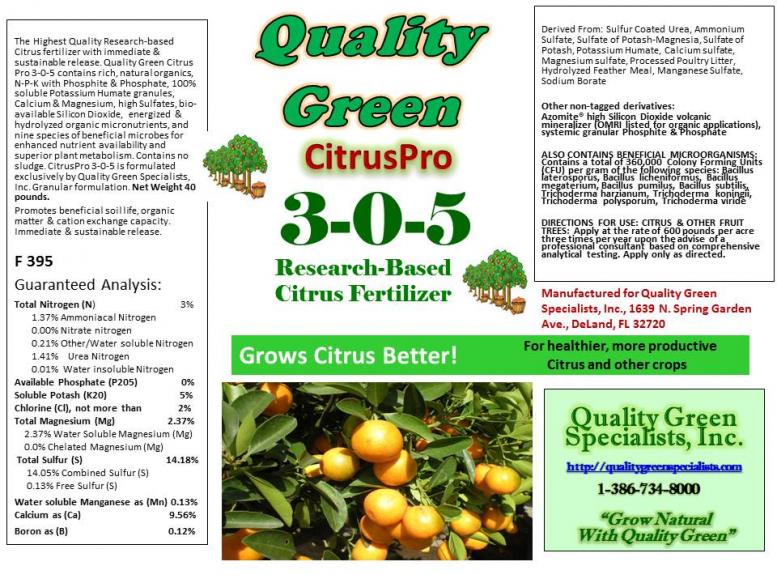
See you at the Citrus Conference.
Monday, June 13, 2016
Yours truly will be representing Quality Green Specialists, Inc. at The Florida Citrus Industry Annual Conference at the Hyatt Regency Coconut Point in Bonita Springs this week June 15-17, 2016. We strive to keep abreast of the latest research and developments in the Citrus industry to ensure we are an industry leader staying at the cutting edge with our recommendations and products.
Thursday, June 9. 2016
Come to our nursery and see the best selection of fruit trees around. Also come by the Farmer’s Market on Artisan Alley (behind the Beacon office) in downtown DeLand tomorrow, Friday from 6-9 p.m. I’ll have some 10 pound bags of fertilizer, olive trees, peppers, okra, and more!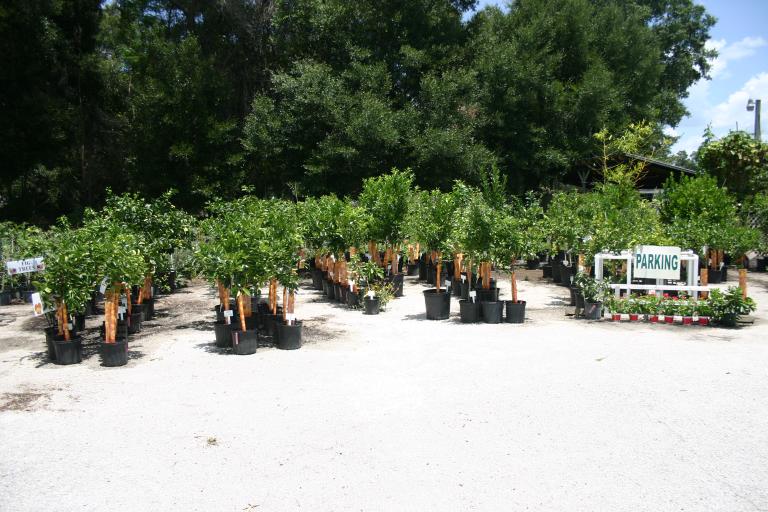
You’ll enjoy seeing many varieties of super nice Citrus trees.
Wednesday, June 8, 2016
Below is the label for our root promoting fertilizer, RootPro 3-7-4 (especially designed to promote healthy Citrus root growth and remediate Citrus Greening) for Citrus and other trees & plants. In Citrus, it is designed to be used together with other fertilizer minerals needed, according to soil, water, and plant tissue testing, at the researched rate of 50 pounds per acre three times per year. RootPro 3-7-4 Fertilizer is a key ingredient in our CitrusPro 3-0-5 Fertilizer and it will provide the 50 pound per acre rate when CitrusPro 3-0-5 is applied at a rate of 600 pound per acre three times per year.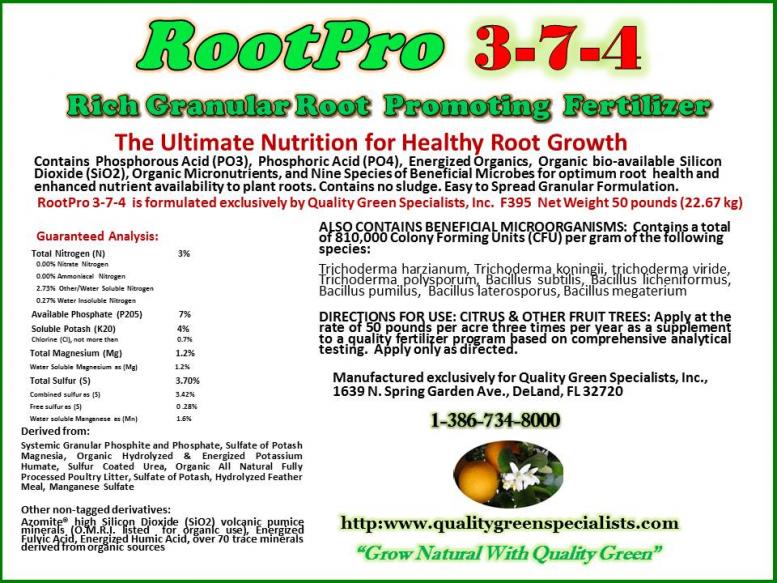
Tuesday, June 7, 2016
Below is a copy of the label for our new, improved Super Green 4-0-5 Fertilizer (formerly 3-0-5) dry, granular Fertilizer designed for general purpose use.
Monday, June 6, 2016
Below is a copy of the label for our new research-based CitrusPro dry granular Fertilizer [now with a new label – see post for June 15, 2016] designed to support optimum Citrus tree health and production along with our Citra Thrive Plus liquid treatment.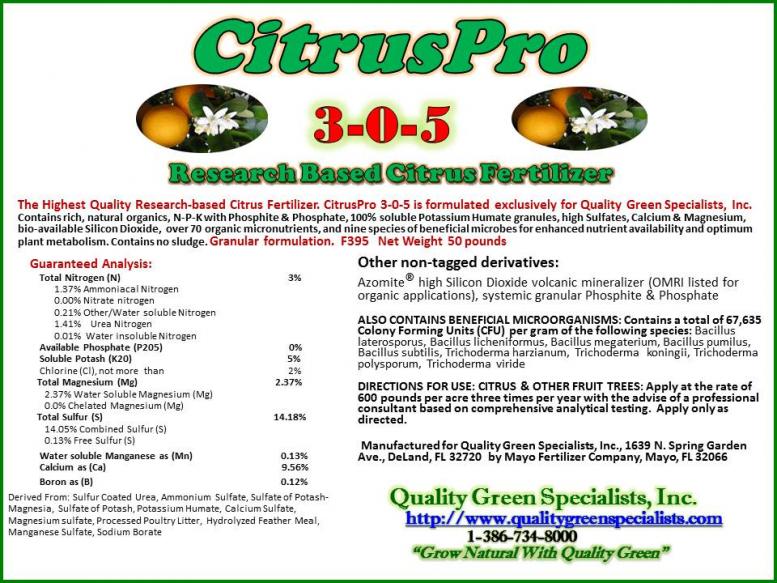
Saturday, June 4, 2016
Yes, we have summer vegetables: potted okra, peppers, and sweet potatoes: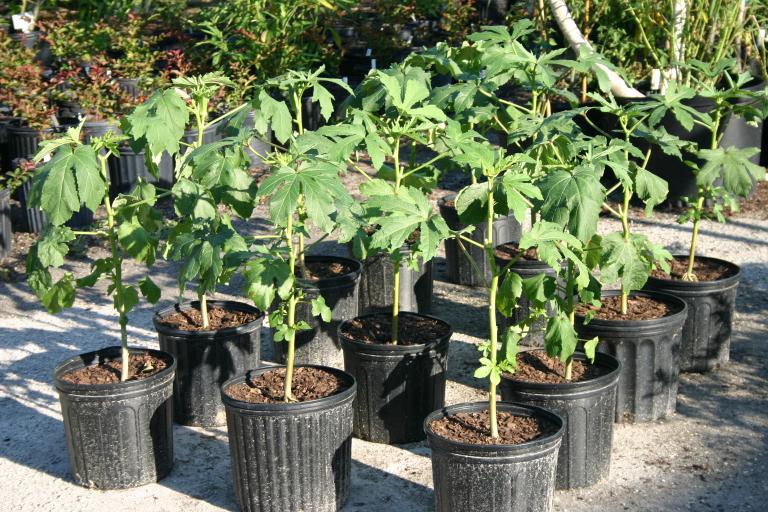
Above: Okra in 3 gallon containers are looking good. Photo taken 6-2-16.
Peppers are looking super healthy and have lots of large peppers. Photo taken 6-2-16.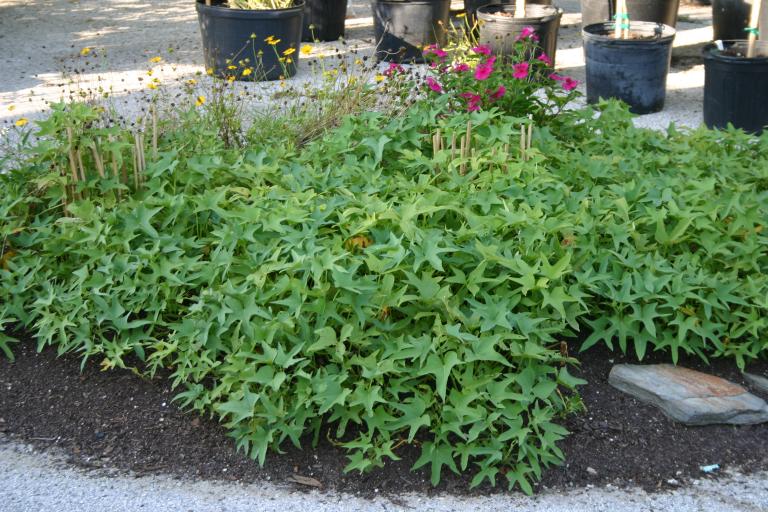
Soon we will be digging large sweet potatoes from our shallow compost beds on top of hard surfaces. The roots swell up when they grow down and hit the hard surface below. Photo taken 6-2-16.
Friday, June 3, 2016
Our large specimen Arbequina olives (in 7 gallon & 15 gallon black nursery pots) are ready for sale. Pictures cannot do them justice, so come by and see them close up in person. You’ll especially enjoy seeing the olive fruit on the larger 15 gallon trees. Yes, these trees are grown right here in Volusia County, Florida.
Thursday, June 2, 2016
You may be interested to know why we enhance fulvic acid to over 58% of the humic acid content in our liquid and dry fertilizers.
Humic acids come in three forms: humic acid, fulvic acid, and ulmic/humin acid. Humic acid is the most abundant form in nature but has low biological activity. Fulvic acid is the second most abundant, but is by far the most biologically active. Ulmic acid is the least abundant and least active.
To improve biological performance, we energize humic acid to make it fulvic acid by a process known as humifying. This process creates a more soluble and lighter humic acid molecule known as fulvic acid. Fulvic acid has a lighter molecular weight with higher oxygen content. Fulvic acids are a more energized and biologically active form of humic acid. Adding extra oxygen electrons not only makes fulvic acids lighter but results in single unbonded electrons that are responsible for many naturally occurring reactions in soils and in plant cells. Nutrient uptake into plants is accelerated either by roots or by foliage. Nutrient ions are quickly moved within the cells to where they are needed. Metabolism is increased within plants. The bottom line for plants and crops: you will see faster growth, improved color, better health, and higher yields.
Tuesday, May 17, 2016
Figs are a great fruit tree for central Florida and we have some of the best varieties: Brown Turkey and Black Mission. Azomite® volcanic pumice is one of our secrets to keep figs super hardy and to prevent nematodes from being a serious pest. Our 3-0-5 Fertilizer works great as well because of the generous amount of Azomite and other high quality natural minerals (in good ratios) that it contains.
###FIG IMAGE###
Monday, May 16, 2016
Yes, we are open today, Saturday 8-5 as well as six days a week Monday through Saturday 8-5.
What is a good way to plant your new fruit tree grown in a 3 to 5 gallon container? A tendency is to plant a new tree too deeply into the ground. Dig the planting hole only as deep as the root ball and 2 to 3 times the width of the root ball. Amend the soil taken out of the planting site (back-fill) with a relatively small proportion of compost or potting soil (enough to fill a gallon size pot works well) and a half-cup of our organic Super Green 3-0-5 Fertilizer. Do not put compost or potting soil (or other organics) under the root ball. A half-cup (no more than about 4 ounces) of our 3-0-5 granular fertilizer under the root ball is helpful to get the tree off to a good start. Before planting, shave off any matted roots on the surface of the root ball. When you place the root ball into the planting hole, the top of the root ball should be slightly above the soil line (allows for settling). Alternately water and fill with the amended back fill. Make sure the root ball is “mudded-in” (pushing a water hose with the running water down into the back-fill around the root ball is desirable) and the air pockets are pushed out by thoroughly saturating the fill. When finished filling and watering thoroughly, the top of the top-most lateral root should be at the surface or barely covered. If the tree is top-heavy, make sure it is properly staked. To make sure the root ball is thoroughly wetted when you water, make a circular berm (watering ring) 4-6″ high and about 18″ to 24″ out from the trunk of the tree. Water every other day for two weeks, then reduce watering to twice per week. After two months, or after the heat of the summer is over, watering may be reduced to once per week or less. Caution: Watering every day almost always results in lots of root rot. When the tree is well rooted in and new growth emerges, put a half-pound of our 3-0-5 Fertilizer just to the inside of the watering ring. Repeat every 2 months during the growing season. Place some of the fertilizer to the outside of the watering ring as well. The watering ring may be removed after several months. The following year, the fertilizer inputs should be increased to a pound of fertilizer every two months. Be sure to place the fertilizer at least 18″ out from the tree trunk and scatter it out in a donut ring up to two times the width of the tree canopy. Periodically remove any soil or fertilizer that accumulates around the trunk. Remove any soil until you see the top of the top-most lateral root or to where the root flare begins. If too much soil covers the trunk, tree growth is stunted.
Saturday, May 14, 2016
Yes, we are open today, Saturday 8-5 as well as six days a week Monday through Saturday 8-5. I thought this dooryard Citrus tree was going to die for sure, but after applying our energizied (extra oxygen added to key fertilizer ingredients) granular CitrusPro fertilizer and our Citra Thrive Plus foliar treatment (energized to increase the fulvic acid portion of the high humate content to over 58%) in February, guess what happened by the last of March? Healthy new growth and healthy, disease-free small fruit!
Quality Green Specialists, Inc.
1639 N. Spring Garden Ave., DeLand, FL 32720
Dana Venrick : 386-837-3878 Allen Day : 386-747-0567
www.qualitygreenspecialists.com
386-734-8000
Sample Recommendations for a Citrus Grove
The exchange capacity is 7.85 (was 6.13 last January), which is a fairly good holding capacity for minerals in Florida sandy soils. Organic matter is low for sandy soil at 1.70%.
The pH level is above desirable: 6.8 (Last year the pH was 6.6. The goal is a pH between 6.0 to 6.5.) The pH needs to be adjusted to below 6.5 but not less than 6.0 because of high aluminum (726 ppm). Prilled sulfur should be used to lower pH when the pH is above 7.2, which is not the case in your grove. Fortunately, bicarbonates are 37 ppm, desirably below 100 ppm.
Nitrogen (N) in the leaf tissue should range between 2.5-2.7%. The content now is 2.81% (slightly high) (The N content last January was 3.08%.)
Sulfur in the soil should be at least 50 ppm, but is deficient at 19 ppm (was 12 ppm), low in the soil water (1.81 ppm – should be 5-10 ppm) but is only slightly low in the tissue at 0.19% (should be 0.20-0.40%). (Last year S was optimum in the tissue at 0.37%.)
Mehlich III (available) Phosphorus (P) is excessive at 2364 lbs/ac (was 2,393 lbs/ac in the soil – 130 lbs/ac is the minimum. Optimum is around 500. Bray I phosphorus (unavailable P) is 413 parts per million (was 205 ppm) and is undesirably above 25 ppm, which means poor soil microbial life. Bray I P at 413 ppm is equal to about 826 lbs/ac, which is very high, but at least is desirably less than ½ of the Mehlich III test amount. Phosphorus fertilizer for this soil will not be needed for years. P in the soil water should be 1-3 ppm but it is low at 0.06 ppm. Phosphorus is 0.18% in the tissue, which is close to the optimum 0.2-0.3 ppm optimum in the tissue (last year it was undesirably lower at 0.13%); however, applications of phosphite (the non-nutritional PO3- anti-pathogenic/anti-microbial form) along with some phosphate in our Citra Thrive Plus 4-10-10 will continue to push tissue P toward a more desirable 0.3% and is an important part of the treatment to keep HLB suppressed.
Calcium (Ca) at 2286 lbs/ac is somewhat above the desired holding capacity (2134 lbs/ac) for soil with this exchange capacity (7.85) (Last year, Ca in the soil was 2476 lbs/ac which was 11 lbs/ac below the exchange capacity at that time.) Ca is occupying 72.82% of the base saturation, which is above the 60-70% desirable range. (Last year it was 67.69%, which was within the desirable range.) Calcium is 3.18% in the tissue, which is below the desirable 4.5% based on the latest research. Last year Ca was slightly higher at 3.38%. Ca in the tissue should be increased (see recommendations).
IMPORTANT RESEARCH NOTES ON ELEVATING CALCIUM IN THE TREE TISSUE: Leaf tissue content near 4.5% is the latest recommendation for Ca in the leaf tissue, according to UF/IFAS Professor Dr. Jim Graham. If the pH is 6.5 or above (6.8 in your grove), a fairly inexpensive calcium source is calcium sulfate/gypsum (two applications per year, 500 lbs/ac each time. (If the pH is 6.4 or less and the bicarbonates are less than 100 ppm, light applications of limestone [1/2 ton per acre or less] are inexpensive and are recommended.) Another part of the strategy is to use liquid calcium nitrate. We have a liquid calcium nitrate product with micros called Gro-Cal that is absorbed four times more efficiently than calcium nitrate alone. Also, the pH needs to be reduced to below 6.5, but not less than 6.0 because of high aluminum in the soil. We emphasize sulfate forms of fertilizer that are effective. If used carefully, prilled sulfur at 150 lbs/ac each time applied twice during the year [use no more than this] can be very effective to reduce pH and help push calcium levels up to 4.5% in the leaf tissue. Prilled Tiger 90 is one sulfur product often used. Both liquid and dry applications need to be used to get calcium up to the desired 4.5% level in the leaf tissue. For high pH water over 7.2, the pH needs to be reduced to less than 6.5 with N-phuric or sulfuric acid.
Total magnesium (Mg) is excessive at 307 lbs/ac (was 427 lbs/ac), an excess of 81 lbs/ac (was excessive by 164 lbs/ac). Mg should be around 226 pounds per acre (lbs/ac) with this holding capacity. Mg should be 8-12 ppm in the soil water, but is only 1.97 ppm. Mg should be 0.3-0.49% in the tissue and is optimum at 0.38%. (Last year Mg was optimum in the tissue at 0.41 ppm.)
The Ca to Mg ratio is a desirable 7.4:1 ratio (last year it was 5.8 to 1). A desirable ratio should be somewhere between 3:1 and 8:1 and not more than 11:1 or less than 2:1.
Total potassium (K) is very deficient in the soil. It is 156 lbs/ac short in the soil. (Last year it was 165 lbs/ac short.) K should be 15-20 ppm in the soil water, but is only 1.32 ppm in the soil water. K should be 1.2-1.7% in the leaf tissue; K is optimum at 1.67%. Last year K was optimum in the tissue but lower at 1.27%. This is an important improvement; K is the mineral taken up most by plants. K is the most important mineral for disease protection (available silicon is also very important for disease protection).
The magnesium (Mg) to potassium (K) ratio is another important indicator of soil health and mineral availability. The goal when correcting magnesium and potassium deficiencies is to keep the ratio of Mg:K to not much less than 0.9:1. It is well documented that the very lowest ratio of Mg:K should never be less than 0.67:1. The Mg:K ratio is: 3.5:1. Last year the ratio was 3.6:1.
Sodium (Na) is at an acceptable, very low level of 66 lbs/ac. (Last year it was 17 lbs/ac.) Potassium (K) should be at least twice the amount of K, which is not the situation here. This is solely a problem of low K in the soil which can be corrected with boosted potassium supplementation. Also, as a percentage of base saturation in the soil, Na should be not more than 3%. The present level is a low 0.39%.
Manganese (Mn) is deficient in the soil testing at 28 ppm – Mn should be 50-75 ppm. (Last year it was 44 ppm.) Mn in the soil water should be about 0.1 ppm; the level now is half that amount at 0.05 ppm. Mn has improved in the tissue to 36.64 ppm, within the optimum range of 25-100 ppm. (Last year Mn was low in the tissue at 21.70 ppm.) Research indicates production results are better with Mn closer to 100 ppm. Recommend supplementation with organic glucoheptonate chelated Mn (see recommendations). Manganese is the second most important mineral for disease protection, second only to potassium.
Total iron (Fe) in the soil should be in the range of 100-250 ppm. Fe is optimum at 213 ppm (Last year Fe was 187 ppm.) Fe in the soil water should be about 0.3 ppm, but is excessive at 0.71 ppm. Fe should be 60-120 ppm in the tissue; Fe is optimum in the tissue at 103.5 ppm. (Last year Fe in the tissue was low at 57.99 ppm.) Supplementation of Fe is not needed at this time.
Total copper (Cu) in the soil should be 4-5 ppm. Cu is extremely excessive at 44.17 ppm (Last year Cu was 32.43 ppm.) Cu should be 0.08 ppm in the soil water and is exactly 0.08 ppm. Cu should be 5-16 ppm in the leaf tissue, but is low at 2.36 ppm. (Last year, Cu was excessive at 25.5 ppm.) Cu should be sprayed SEPARATELY as glucoheptonate chelated copper.
Total zinc (Zn) is excessive in the soil at 20.88 ppm. (Last year Zn was 26.94 ppm.) Zn should be 0.08 ppm in the soil water, but is below the level of detection (<0.02 ppm). Zn should be 25-100 in the leaf tissue and has improved to 29.43 ppm and is in the lower part of the optimum range. (Last year Zn was very deficient at 8.07 ppm.) Continue to apply foliar applications of zinc glucoheptonate.
Total silicon (Si) should be over 100 ppm, but is very low at 20.5 ppm. (Last year Si was 23.6 ppm.) Citrus trees take up large amounts of silicon if it is in a bio-available silicon dioxide form (unlike the silicon oxide of sand), and evidently the trees took up more silicon than was applied to the grove. Recommend increasing the rate of Azomite® volcanic mineralizer (with over 65% bio-available silicon) to provide more bio-available silicon dioxide to the Citrus trees and to increase the level of Si in the soil.
The trace mineral boron (B) should be 1-4 ppm in the soil, but is deficient at 0.24 ppm. (Last year B was 0.35 ppm.) The desirable range for B in the soil water is 0.1 ppm, but is below the level of detection (<0.02 ppm). The optimum range for B in the leaf tissue is 36-100 ppm and is in the middle of the optimum range at 62.42 ppm. Apply B as a foliar spray of KeyBor (glucoheptonate chelated boron) at least once early in the year, but not more than two times per year (see recommendations). Also apply boron twice as 10% granular sodium borate (borax) at the rate of 7.5 lbs/ac in February and 7.5 lbs/ac in September (or 3.75 lbs/ac of 20% boron Solubar each time). Boron as a soil application increases uptake of calcium. Boron must be applied yearly because it is the only micronutrient that is highly leachable. Do not exceed the recommended rates because excessive boron is very toxic and prevents chlorophyll synthesis.
Aluminum (Al) in the soil is at a potentially toxic level of 726 ppm (last year Al was 729 ppm.) Al is a problem if the pH drops below 6.0 (too acidic with more than 400 ppm Al in the soil). Avoid the over-use of products containing aluminum and other heavy metals.
RECOMMENDATIONS:
- 1. With a pH of 6.8 and a surplus of calcium in the soil, no dolomite is needed this year. Only when the pH drops to below 6.3, make an application of ½ ton per acre of dolomite. The soil and the Citrus will be far healthier if the pH is adjusted slowly, then maintained at a pH between 6.0 to 6.5 (raising the pH too quickly kills microbial life that makes minerals available and ties up essential micronutrients).
- 2. Apply our proprietary Root Pro 3-7-4 at the rate of 50 lbs/ac in February, 50 lbs/ac in May or June, and 50 lbs/ac in September. See appendix for product description.
- 3. Apply potassium sulfate at the rate of 50 lbs/ac in February, 50 lbs/ac in May or June and 50 lbs/ac in September.
- 4. Apply potassium magnesium sulfate at the rate of 60 lbs/ac in February, 60 lbs/ac in May or June and 60 lbs/ac in September.
- 5. Apply sulfur coated urea (SCU) as a nitrogen (N) source at the rate of 35 lbs/ac in February, 35 lbs/ac in May or June and 35 lbs/ac in September.
- 6. Apply ammonium sulfate at the rate of 60 lbs/ac in February, 60 lbs/ac in May or June and 60 lbs/ac in September (Ammonium sulfate makes potassium available – use as one of the nitrogen sources when making applications of potassium.)
- 7. For silicon as 65% available silicon dioxide and all trace minerals at low levels, apply Azomite® volcanic pumice at the rate of 66 lbs/ac in February, 66 lbs/ac in May or June, and 66 lbs/ac in September.
- 8. To account for Ca withdrawal from the soil and to help make calcium more available, apply 150 pounds per acre of gypsum (calcium sulfate) in February, 150 lbs/ac in May or June, and 150 lbs/ac in September (total of 450 lbs/ac for the year).
(Ca needs to be released by leaching with irrigation and/or a good rain after applying sulfur, sulfates, and calcium sulfate/gypsum. Do not apply gypsum without adding magnesium if the base saturation in the standard soil test is over 60% (now 67.69% in your grove); when saturation is over 60%, gypsum starts to unlock Mg before unlocking Ca).
- 9. Apply boron twice as 10% granular sodium borate (borax) at 7.5 lbs/ac in February and 7.5 lbs/ac in September. Boron as a soil application increases uptake of calcium.
Foliar Spray Recommendations:
- 1. Because of Citrus Greening, recommend 6 liquid spray applications this year of our Citrus Greening Treatment, consisting of Citra Thrive Plus and the trace minerals as detailed below. In a spray tank of 100 gallons (or more) of water to be sprayed per acre, add 3 gallons of Citra Thrive Plus for the first three applications, then reduce rate to 2 gallons for the last three sprays as explained below. The treatments work best on new flushes of growth when most of the new leaves have expanded by 2/3 of full size.
- 2. Apply the first three applications of Citra Thrive Plus at the 3 gallon/acre rate in February, March, and April. Then apply the last three at the lower 2 gallons/acre rate in June, July and September. The next paragraph tells how to combine Citra Thrive Plus with the needed micros.
- Recommend combining the trace minerals manganese and zinc as MZ Mix (and boron for the first and September foliar applications only) with the Citra Thrive Plus. For all six sprays, put one gallon per acre of the MZ Mix into the spray tank (after putting in Citra Thrive Plus). For the first spring and September applications only (only two per year), also put KeyBor (glucoheptonate chelated boron) into the spray formulation. Apply KeyBor in the spring at the rate of one gallon per acre. Lower the rate for the September application of KeyBor to 2 quarts per acre. Lower the rates for Citra Thrive Plus and KeyBor only. Do not lower the rates for the MZ Mix in each of the six applications.
- Spray Copper X (glucoheptonate chelated copper) SEPARATELY at the rate of one quart per acre for each of three applications spring to summer.
Additional Notes & Precautions:
- Use glyphosate/Roundup, etc. at most once per year. Do not apply glyphosate closer to one month from an application of phosphorus or a fertilizer that contains phosphorus because glyphsate forms a soluble toxic compound with phosphorus and ties up Mn and many other minerals.
- The recommended urea and sulfate forms work together to release minerals locked up in the soil.
- Fortunately, at only 37 ppm, bicarbonates are below the level of concern in your grove.
APPENDIX:
RootPro 3-7-4: RootPro 3-7-4 is our proprietary breakthrough dry, granular fertilizer amendment containing both 100% water soluble energized Phosphite (Phosphorous Acid/PO3-) and Phosphate (Phosphoric Acid/PO4-), Organic Hydrolyzed (ionized & energized with an extra oxygen atom on each molecule) 100% water soluble Potassium Humate Granules with over 58% fulvic acid, Enriched Organics, Sulfate of Potash Magnesia, Silicon Dioxide from an organic source (Azomite® volcanic pumice), Manganese Sulfate, over 70 trace minerals derived from organic sources, 3.76% sulfur, and nine beneficial microbes for optimum root health and enhanced nutrient availability to plant roots. RootPro 3-7-4 is designed to fortify needed macro and micronutrients based on our extensive soil and leaf tissue testing. RootPro 3-7-4 is effective in the control of Phytophthora fungal root infections and other diseases. RootPro 3-7-4 is designed to promote strong root recovery, higher production, and better pound solids when complimenting a sound nutritional program based on our comprehensive analytical testing.
NOTES FROM RESEARCH:
Calcium Deficiency
A Ca deficiency in citrus is expressed as a fading of the chlorophyll along the leaf margins and between the main veins during the winter months. Small necrotic (dead) spots can develop in the faded areas. Calcium deficiency produces small, thickened leaves and causes loss of vigor, thinning of foliage, and decreased fruit production. Severely deficient trees can develop twig dieback and multiple bud growth of new leaves. Trees with a Ca deficiency produce undersized and misshapen fruit with shriveled juice vesicles. Fruits from Ca-deficient trees are slightly lower in juice content but higher in soluble solids and acids.
These leaves show calcium deficiency symptoms, including fading of the chlorophyll along the leaf margins and between the main veins during the winter months. Credit: Dr. R.C. Koo
These fruit show calcium deficiency symptoms; they are undersized and misshapen with shriveled juice vesicles. Credit: Dr. R.C. Koo
Calcium deficiency usually occurs on acidic soils where native Ca has leached. Continuous use of ammonium-containing fertilizer, particularly ammonium sulfate, accelerates Ca loss from soils. Using muriate of potash [potassium chloride] and S causes similar losses of soil Ca. Soil testing is a widely used method of making liming recommendations. In the long term, liming is the most effective and economic practice to supply Ca to crops in Ca-deficient acid soils because liming the soil neutralizes soil acidity and supplies available Ca. [When pH is 6.5 or higher, use gypsum/calcium sulfate.] Calcium deficiency can also occur in highly saline soils because of the excessive sodium (Na) concentration. Under such a situation, gypsum can correct the deficiency and reduce the deleterious effect of Na. Short-term calcium deficiency can be addressed by foliar spraying with a water-soluble Ca source such as calcium nitrate. Calcium efficiency in crop production can also be improved by using farmland manures [must be at low rates].
Sulfur Deficiency
Because S is associated with forming proteins and chlorophyll, deficiency symptoms resemble those of N deficiency, but the symptoms first appear on new growth. Such chlorosis in citrus is worse on new growth because S does not move readily from old to young leaves like N. Plants are stunted and pale green to yellow in color. Visual diagnosis of S deficiency is not easy to identify in citrus production. Accurate diagnosis should involve tissue analysis.
These leaves have sulfur deficiency symptoms because they show chlorosis (pale green to yellow in color) similar to N deficiency. S deficiency symptoms appear on new growth because S does not move readily from old to young leaves like N. Credit: M. Zekri
Sulfur deficiency occurs most commonly with high N fertilizer rates. If the supply of N is not supplemented with adequate S, the N available for crop use may be excessive in relation to S. Under high N and low S conditions, plant growth processes are disrupted and plants develop symptoms of S deficiency. Sometimes total growth is reduced by fertilization with N alone, whereas combined applications of N and S provide normal growth and yield.
Sulfur deficiencies have become more common in the past few decades with the increased use of fertilizers lacking S, such as ammonium nitrate, potassium nitrate, urea, concentrated superphosphate, monoammonium phosphate (MAP), and diammonium phosphate (DAP). Decreased use of S-containing pesticides and fungicides may also contribute to the more common occurrence of S deficiency. Sulfur deficiency in citrus can easily be corrected by soil application of S-containing fertilizers such as ammonium sulfate, potassium sulfate, or magnesium sulfate. Applying gypsum is an inexpensive option that can also correct S deficiency and supply Ca. Using manures [must be at low rates] may also be a good management strategy to increase S availability to citrus trees.
Comments by Dr. Jim Graham, UF/IFAS for Phytophthora & HLB control entitled:
“Integrated Management of Root Health of HLB-Affected Trees and Canker In Grapefruit”, a presentation at the Florida Citrus Show on January 24, 2016:
•Phytophthora may have to be managed with fungicides more aggressively to sustain root health.
•If propagule count is >10-20 recommend mefenoxam treatments after spring and fall shoot flushes and alternation with Aliette or phosphite-based fungicides [also reported at Citrus Show to be a compound that kills Liberobacter bacterium that causes HLB] – for pest control details refer to the Florida Citrus Pest Management Guide (FCPMG) at www.crec.ifas.ufl.edu/extension/pest/
•Check status of well water for bicarbonates, pH and salinity.
•We are currently investigating whether there is benefit from conditioning irrigation water with acid treatments.
Tuesday, May 10, 2016
Here is a sample report for a new Citrus grove planting. The leaf tissue analysis will be done later this summer.
Quality Green Specialists, Inc.
1639 N. Spring Garden Ave., DeLand, FL 32720
Dana Venrick : 386-837-3878 Allen Day : 386-747-0567
www.qualitygreenspecialists.com
Recommendations for a Citrus Grove (Sample Report)
Important: The saturated paste extract test should not be done as a stand-alone test. It should be done in conjunction with a standard soil test and, after the grove is established, a leaf tissue analysis.
The pH of 5.6 is lower than desired – a goal should be from 6.0 to 6.5. Based on the standard soil test, the CEC/M.E. (total exchange capacity) is 8.10, which is a good holding capacity for Florida soils. Organic matter is higher than typical at 3.38%. Bicarbonate is desirably low at 34 ppm. Above 100 would be cause for concern.
Sulfur (S) should be between 5-10 ppm in the soil water (shown by the saturated paste report); the saturated paste report shows 0.73 ppm, which is very deficient. Total S shown on the standard soil test is 15 ppm – it should be above 50 ppm. Sulfate forms of minerals are needed. Sulfur deficiencies are most prevalent on sandy soils subject to leaching, soils with low organic matter content, high nitrogen use, and when groves are disked.
The saturated paste report shows that some minerals in the soil water solution are very low. This means that the Citrus tree roots would have to work very hard to pull enough minerals from the soil water solution in order to meet basic requirements.
Phosphorus (P) is absent from the soil water at <0.03 ppm. A satisfactory level is between 1-3 ppm. NOTE: High levels of zinc (Zn), aluminum (Al) & iron (Fe) tie up P. Because aluminum (Al) is the only one of the three that is excessive (600 ppm), this is the probable cause of the tie-up. Total P in the soil is 378 pounds per acre (lbs/ac). 500 lbs/ac is optimum, with 130 lbs/ac a minimum for plant needs. Energized, highly soluble and systemic phosphite and phosphate are needed to make phosphorus available.
The water soluble Calcium/Ca (determined by the de-ionized water saturated paste extraction) is deficient at 4.38 ppm. It should be in a range of 40-60 ppm. The percentage of Ca in the soil water should be 55-60%. At present it is 46.32%. Total calcium is low (for this soil CEC) at 1647 lbs/ac., a deficiency of 555 lbs/ac. There is tie-up of calcium in the soil. Here are some of the possible reasons. Ammonium forms of nitrogen sequester (tie-up) calcium. Being a major cation, calcium availability is related to the soil CEC – it is in competition with other major cations such as sodium (Na+), potassium (K+), magnesium (Mg++), ammonium (NH4+), iron (Fe++), and aluminum (Al+++) for uptake. High K applications have been known to reduce Ca uptake. Also, if the soil pH is low (as in this case), too much Fe++ and Al+++ become soluble and combine with Ca to form insoluble compounds.
Magnesium (Mg) in the soil water is 1.35 ppm. This is far below the optimum range of 8-12 ppm. Mg is deficient even though the total magnesium in the soil is excessive by 33 lbs/ac. Tie-ups are often associated with acidic soils such as yours.
The ratio of the total calcium to total magnesium in the soil should be between 3:1 and 8:1. The ratio in your soil is 6.19:1, which gives more flexibility when applying amendments to supply sufficient Ca and to unlock tie-ups of Ca and Mg.
Potassium (K) is 2.56 ppm in the soil water, which is far below the optimum range of 15-20 ppm. Total K in the soil is deficient by 197 lbs/ac. Low potassium results in many problems, including small fruit and low pound solids. Low boron at times is probably also involved. Note: Potassium is the number one mineral for disease protection (manganese is number two). Potassium becomes fixed (tied up) in the presence of certain soil clay types.
Sodium (Na) should be less than 20 ppm in the soil water (here it is 1.73 ppm) and as a percentage less than 3%. Because calcium is unusually low as a percentage, the sodium percentage is unusually high at 15.89%. The actual amount of Na is not too much. Basically, more potassium is needed. Potassium should always be more than sodium in the soil water. Until needed potassium is supplemented, the reverse is true. Also, when the percentage of potassium and sodium in the soil water together are over 10% (here it is 29.96%), manganese (Mn) uptake is extremely difficult.
Boron (B) is below the level of detection in the soil water at <0.02 ppm. B should be 0.1 ppm. The standard soil test shows B to be deficient at <0.2 ppm ppm, below the optimum range of 1-3 ppm. Whether or not boron is present and/or tied up, it must be applied once every spring because it is the only micronutrient that is easily leached. Boron sometimes forms an insoluble, unavailable compound with calcium.
Iron (Fe) is excessive in the soil water at 0.43 ppm. The optimum level is about 0.3 ppm. Total iron in the soil is low at 68 ppm (the desirable range is 100-250 ppm). No iron is needed at the present time.
Manganese (Mn) is absent in the soil water at <0.02 ppm. It should be 0.1 ppm. The total amount of Mn in the soil is very deficient at 7 ppm (the optimum range is 50 – 75 ppm). Because very little Mn is available from the soil, it must be applied as a foliar spray.
Copper (Cu) is below the level of detection in the soil water at <0.04ppm. The optimum level is 0.08 ppm. Total Cu is low in the soil at 1.43 ppm, well below the optimum range of 4-5 ppm). Copper must be used carefully as excessive amounts are toxic in the soil.
Zinc (Zn) is below the level of detection in the soil water at <0.02 ppm. The optimum amount is 0.08 ppm. Deficiencies are most common on alkaline soils, during cool, wet weather, on highly weathered acid, coarse textured soils, and with high levels of N, P, Fe, Cu and Mn. Total zinc in the soil is low at 5.89 ppm (it should be 8-10 ppm) and zinc is deficient in the tissue at 6.72 ppm. Zinc should be applied to Citrus trees as a glucoheptonate foliar spray because ground applications contribute to tie-ups. As ground applied zinc moves from the roots upward through the water conducting tubes (xylem tubes), zinc ties-up with amino acids and clogs the xylem near the bud union of Citrus trees and contributes to the cause of Blight. For this reason and because zinc is tied-up in the soil, it should never be ground applied.
Total aluminum (Al) in the soil is 600 ppm and is toxic with a pH below 6.0 as in your soil. When calcium and magnesium levels are increased, the pH will increase to over 6.0 and you can live with this higher than desirable Al. (Over 400 ppm is cause for concern.) Al is 1.02 ppm in the soil water. When Al is excessive, it may tie-up phosphorus.
Silicon (Si) is low in the soil at 26.8 ppm. It should be >100 ppm. Trees take up lots of Si in the form of silicon dioxide (unlike sand that is unavailable silicon oxide) if it is available. Our product, Azomite® volcanic pumice mineralizer, has a typical analysis of 65.85% bio-available silicon dioxide.
NOTE: With all micronutrient levels, an acceptable range of variability from the ideal levels would run plus (+) or minus (-) 0.02 ppm.
Recommendations:
For pH, the recommendation (when aluminum is excessive) is to keep the pH between 6.0 to 6.5. The pH now is 5.6. Apply 1,000 pounds (1/2 ton) per acre (lbs/ac) of limestone (calcium carbonate). This will raise the pH to about 6.1 and, assuming 21% Ca, will contribute 210 lbs/ac of needed Ca to the soil. Next year, apply anther ½ ton of limestone to raise the pH to around 6.3 (make sure you use calcitic limestone/calcium carbonate in future applications; otherwise magnesium, that is already more than sufficient in the soil, will become too excessive at some point). Then keep the pH between 6.0 – 6.5 by applying ½ ton/acre of limestone to the soil every time the pH drops back to close to 6.0. Do not let the pH drop below 6.0.
Correcting potassium (K) and silicon (Si) deficiencies, and supplying Sulfur Coated Urea (SCU) for nitrogen (N): Apply 400 lb/acs of potassium sulfate (SOP), 308 lbs/ac of Azomite volcanic pumice, and 200 lbs/ac of sulfur coated urea (SCU) (total of 908 ls/ac) to the soil for 2016 in three split applications, now, June, and September. SOP supplies sulfur that is deficient in the soil as well as potassium. Azomite supplies silicon as silicon dioxide to correct the silicon deficiency. The acidic dissociation of the sulfate anions (with needed H+ forming) and the acidic reaction of SCU in the soil water also releases minerals tied up in the soil.
Foliar sprays should be applied 6 times per year to the Citrus trees after they have been planted because of Citrus Greening. Recommend our Citrus Greening Treatment, consisting of Citra Thrive Plus and the trace minerals as needed. Details on this later.
Use glyphosate/Roundup, etc. at most once per year. Do not apply closer to one month from an application of phosphorus on the ground or a fertilizer that contains phosphorus because it forms a soluble toxic compound with phosphorus and ties up Mn and many other minerals.
Monday, May 9, 2016
Rubeckia (Black-eyed Susan) wildflowers add a nice touch to the landscape.
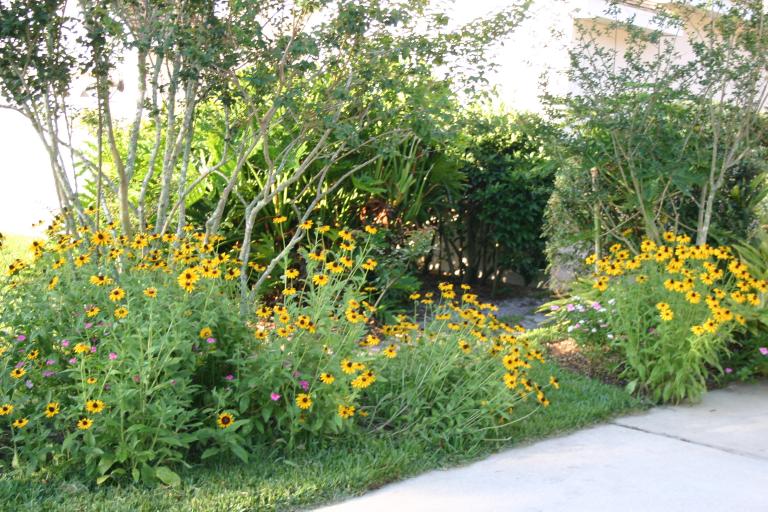
Saturday, May 7, 2016
Have you wondered how I report and make recommendations based on our comprehensive soil and leaf tissue testing ? Well, here is a sample of a report based on our standard soil test in a new olive grove planting (and includes references to leaf tissue optimum mineral levels; we’ll perform leaf tissue testing later in the summer). This particular test does not include the soil saturated paste report. We highly recommend the saturated paste test (which tests the level of minerals that actually dissolve into the soil water) as a companion to the standard soil test and leaf tissue analysis, particuarly in more highly stressed Citrus groves affected by Citrus Greening Disease (HLB). I’ll log a sample of a complete report for a Citrus grove later.
Quality Green Specialists, Inc.
1639 N. Spring Garden Ave., DeLand, FL 32720
Dana Venrick : 386-837-3878 Allen Day : 386-747-0567
www.qualitygreenspecialists.com
Test Results & Recommendations – Sample Report
The exchange capacities are 3.00 for Olive 1 and 4.46 for Olive 2, which are low. Organic matter is 1.76% & 1.89%. The organic matter and exchange capacity will improve (soil will hold more minerals) when the below recommended amendments are used for your grove nutritional program. The number one way soil organic matter is built is by the cycling of beneficial microorganisms. The number one way microorganisms are built is with good, complete minerals in the soil for the microorganisms to digest (and as a result, release ionic forms for the olive roots to take up). Organic matter is the only component of soil that prevents the leaching of both positively charged minerals (cations) and negatively charged minerals (anions).
The pH in both areas is extremely acidic at 4.9 & 4.5. A good pH range in an olive grove is between 7.3 to 7.5. As the soil pH increases toward an alkaline pH range of 7.3 – 7.5, the high aluminum in the soil (861 parts per million/ppm & 687 ppm), will not be an issue. Excess aluminum in the soil dissolves into the soil water at toxic levels when the pH is too acidic (5.5 or lower).
When nitrogen (N) is tested in the leaf tissue, the optimum range should be in the neighborhood of 1.8% N. Phosphorus (P), but not potassium (K), increases in olive leaf tissue as N increases to an optimum level. Optimum N in the leaf tissue, along with optimum P has been demonstrated to increase fruit set. Optimum potassium, on the other hand, increases fruit yield (citation is at the end of the paragraph following discussion of high aluminum toxicity).
Total sulfur (S) in the soil is very deficient at 7 ppm & 8 ppm. 50 ppm in the soil is the minimum for good growing conditions. The recommended inputs of potassium magnesium sulfate (SPM) and sulfur coated urea (SCU) will supply the needed sulfur (as well as the needed potassium, magnesium, and nitrogen). When tested, sulfur (S) in the leaf tissue should range from 0.20 to 0.40%.
Total phosphorus (P) in the soil from the Mehlich III test: Phosphorus (P) is excessive in the soil at 427 lbs/ac & 632 lbs/ac. Minimum needed in the soil is 130 lbs/ac with the optimum level around 500 lbs/ac. Bray I phosphorus tells us the level of unavailable P. Bray 1 P is undesirably above 25 ppm at 142 ppm (284 lbs/ac) & 179 ppm (358 lbs/ac), which means poor soil microbial life. Another indicator of tie-ups is when Bray 1 P is more than ½ of the Mehlich III P, which is the situation in both areas. Phosphorus ground applications should not be necessary for at least several years. Phosphorus is not very soluble and is tied up (sequestered) by high levels of aluminum/Al as in these soils. As more P dissolves within the soil water and more is taken up by the olive roots into the trees, N & K levels increase in the leaf tissue as well.
Total calcium (Ca) is extremely deficient in both areas by 458 lbs/ac in the Olive 1 and 721 lbs/ac in Olive 2. When Ca is tested in the leaf tissue, the desirable range should be 1.0 to 1.70%. Leaf tissue levels are often satisfactory even though there is a deficiency in the soil. This illustrates the point that trees are able to take up minerals against a severe osmotic gradient. However, they have to work extra hard pulling needed minerals from mineral deficient soil water in an effort to keep key minerals at optimum levels in the living tissue; therefore, the tree tissue is often the last place to show that a severe problem exists. The best and least expensive way to correct the total soil deficiency of calcium and magnesium (even if only partially) is with dolomitic limestone (calcium magnesium carbonate) as detailed in the recommendations.
Total magnesium (Mg) in the soil is deficient by 120 lbs/ac & 137 lbs/ac. Deficiencies are often associated with very acidic soils and low cation exchange capacity soils. When Mg is tested in the tissue, the optimum range should be 0.20 to 0.30%. A tie-up in the soil often occurs between phosphorus and magnesium. Also, deficiencies are associated with low cation exchange soils, acidic soils of pH 5.5 or less (both soils), soils subject to leaching, high calcium (not in this instance), and high potassium (K) fertilization.
Ideally, the Ca to Mg ratio in the soils should be about 3:1 for olive groves and should be the long term goal. The ratios in these areas now are: 4.5:1 and 7.8:1. Both soils need additional supplementation with Mg because of low Mg in both sites. The Ca:Mg ratios will also improve.
Total potassium (K) is very deficient in the soil by 146 lb/ac & 161 lbs/ac. When tested, potassium in the leaf tissue should be around 1.37%. Potassium is the mineral taken up most by olive trees and a good, natural source with a low salt index, like potassium magnesium sulfate (SPM), that doesn’t readily leach, is the material of choice. Potassium (K) is the most important mineral for disease protection (manganese, magnesium, sulfur, available silicon, calcium, zinc, copper, and other minerals are also very important). Potassium is the most important mineral for promoting flowering in olive trees. K increases the formation of IAA oxidase, which stimulates flower induction. K also promotes the synthesis of pyruvate chinase, which infuences a number of amino acids involved in flower induction. Potassium fertilization is essential for olive trees, particularly because greater than 60% of the plant’s K is located in the fruit and is removed annually with harvesting (López Villalta, 1996). Soil application of a large quantity of fertilizer containing K has been demonstrated to be responsible for major yield increases in olive orchards that had previously been seriously K deficient. Optimum levels of leaf potassium dramatically increases the total number of olives harvested as well. (Hartmann et al., 1986).
The magnesium (Mg) to potassium (K) ratio is another important indicator of soil health and mineral availability. The goal when correcting magnesium and potassium deficiencies is to achieve a ratio of Mg:K around 1:1. The Mg:K ratios in the two areas now are 1.5:1 and 1.6:1. Following the recommendations will improve these ratios. The Mg:K ratio should never be less than 0.67:1 to avoid Mg sequestration (tie-up).
(Ca + Mg)/K should = 10 to 15. The current situation is: for Olive 1: 357 +80 = 437/54 = 8.1 undesirable); for Olive 2: 491 + 63 = 554/39 = 14.2. These numbers are probably not too significant at this time because of the severe deficiencies of all three minerals.
The test for sodium is important, because sodium represents salt (sodium chloride) and is taken up identically to potassium and competes for the same uptake sites. After supplementation with potassium, K should be more than twice as much as sodium to support good soil health. Sodium is sufficiently low in the soil at the present time.
Total manganese (Mn) in the soil should range between 50-75 ppm; Mn now is only 6 ppm in both sites, which is very deficient. When tested, Mn in the leaf tissue should be within a range of 25 – 70 ppm. Recommend our very efficiently absorbed organic, glucoheptonate chelated micros to include manganese, zinc, and boron (see recommendations). Even though it is a micronutrient, manganese is the second most important mineral for disease protection, second only to potassium.
Total iron (Fe) in the soil is 117 ppm & 162 ppm, within the optimum range of 100-250 ppm. When tested, the optimum range of iron in the tissue samples should range between 60 – 120 ppm. Iron, along with boron, are the two microelements documented to increase flower induction in olives. Deficient B has been demonstrated to increase the percentage of imperfect flowers and to decrease fruit set (Perica et al., 2001).
Total copper (Cu) in the soil is ideal in Olive 1 at 4.47 ppm and a little high in Olive 2 at 12.77 ppm. Cu in the soil is optimum when it is within the range of 4-5 ppm. When tested, copper should range between 6 ppm to 20 ppm in the leaf tissue.
Total zinc (Zn) in the soil is low in both samples at 2.71 ppm & 4.17 ppm – the optimum should be between 8-10 ppm. When tested, Zn should range between 10-30 ppm in the leaf tissue. Because zinc is low in the soil and is readily tied up by calcium, and is not available from the soil water, foliar applications of very bio-available forms of zinc such as zinc glucoheptonate are appropriate.
Total boron (B) in the soil should be within a range of 1-3 ppm. In both places, B is very deficient at <0.20 (below the level of detection) & 0.23 ppm. Because B is highly soluble in the soil (easily leached) and readily volatilized, B needs to be supplied at least once in the spring. Do not exceed the recommended application rate and never apply more than twice per year (once in the spring and once after fruit set), as even a small excess can be toxic. Excess amounts prevent chlorophyll synthesis.
Total silicon (Si) in the soil (as available silicon dioxide) should be over 100 ppm, but now is only 1.5 ppm & <0.5 ppm. Suggest the use of Azomite®, a volcanic pumice mineralizer (O.M.R.I. listed) with 65% highly bio-available silicon (as silicon dioxide, unlike sand, which is unavailable silicon oxide). Azomite will help remediate the severe shortage of silicate and will promote tree sturdiness, health, production, cold hardiness, and disease resistance.
Aluminum is at toxic levels when the amount exceeds 400 ppm and the soil is too acidic. In these two areas Al is 861 ppm & 687 ppm. It becomes even more of a severe problem if the amount exceeds 1,000 ppm. Apply dolomitic limestone as recommended below with a goal of maintaining a pH between 7.3-7.5. Be careful with chemical fertilizers, as they are often high in aluminum contamination. Use no aluminum based pesticides such as Aliette fungicide – use phosphite (phosphorous acid) instead to help control water mold diseases (root diseases) such as Phythothera and Pythium, and other diseases. University of Florida studies have shown that phosphite products control these diseases as well as or better than Aliette and is much safer. When each is used at the recommended rate, phosphite costs less than ¼ as much as Aliette.
Interestingly, fruit yield has been demonstrated to not correlate well with leaf N or P concentrations but to correlate significantly with leaf K with 26% of yield variability correlated. In a study of micronutrients, fruit yield was significantly correlated with leaf B and Fe concentrations, which, respectively, explained 35% and 10% of the total yield variability. On the other hand, leaf Mn, Zn, and Cu concentrations were not correlated to fruit yield. (Modelling the Effects of Soil Conditions on Olive Productivity in Mediterranean Hilly Areas by Ashraf Tubeileh,1,2 Francis Turkelboom,1,3 Anwar Al-Ibrahem,4 Richard Thomas,1 and Kholoud Sultan-Tubeileh2).
The above cited study revealed that variations in soil potassium and soil depth were the major factors affecting olive yield under poor shallow soil conditions in hilly areas of the Mediterranean. The importance of soil depth for olive production has already been shown by other studies in countries south of the Mediterranean (e.g., B. Ben Rouina, A. Trigui, and M. Boukhris, “Effect of the climate and the soil conditions on crops performance of the “chemlali de sfax” olive trees,” Acta Horticulturae, vol. 586, pp. 285–289, 2002), as deeper soils allow more water and nutrients to be stored and explored by tree roots. The research documented strong correlations between fruit yield on the one hand and K in the root zone, K in the topsoil, and, to a lesser extent, leaf K. The conclusion is that the availability of potassium is critical for olive production. This research confirms the observations of Hartmann et al. [47] in California (as well as many other), who compiled literature data showing a close relationship between productivity and leaf K. Florida is in a good position to maximize olive production in our sandy soils when good soil mineralization programs emphasizing potassium are maintained.
RECOMMENDATIONS:
Important information about nitrogen: The nitrogen (N) level in the soil is not tested because N is always extremely low in the soil. However, when trees are established the leaf tissue level needs to be tested in the summer, which is very important to know if N inputs need to be increased or decreased for the following year. As a general rule for olive production, nitrogen is applied at a rate of 50 pounds per acre (lbs/ac) per year and 75% of the N needs to be applied early in the year (in January) before spring flush begins. For example, when applying our 3-0-5 fertilizer (actually over 4% N and almost 6% K) to supply adequate nitrogen (and supply the research-based ratio of nitrogen to potassium), apply 1250 lbs/ac of root zone (1250 x .04 = 50). This equals 29 lbs/1,000 square feet (sq.ft.) of root zone (1250/43.56 = 29) of 3-0-5 Fertilizer. This provides 1.2 lbs N/1,000 sq.ft. of root zone (29 x .04 = 1.2). The first January application of 3-0-5 Fertilizer should be 938 lbs/ac (1250 x .75 = 938) or 22 lbs/1,000 sq.ft. Then apply the rest of the 3-0-5 fertilizer (312 lbs/ac or 7 lbs/1,000 sq.ft.) in April. (This may be split between two applications in April and June). When nitrogen leaf tissue content is tested later, the optimum amount of N should be close to 1.8%. See “Correcting nitrogen (N) and sulfur (S) deficiencies” in the step by step recommendations below.
NUTRITION NOTES ABOUT NITROGEN INTERACTIONS: Phosphorus (P), but not potassium (K), increases in olive leaf tissue as N increases to an optimum level. Optimum N in the leaf tissue, along with optimum P has been demonstrated to increase fruit set. Optimum potassium, on the other hand, increases fruit yield.
Today, let’s look at nutrition and mineralization requirements for olive trees, which is of utmost importance:
- Yearly applications of dolomitic limestone are needed until the pH climbs to 7.3. Recommend 1,000 lbs/ac (23 lbs/1,000 sq.ft.) of dolomitic limestone (calcium magnesium carbonate). The pH will continue to rise (which is desirable for olive production) before the pH begins to drop. When the pH drops back to around 7.3, apply another 1,000 lbs/ac (23 lbs/1,000 sq.ft.) of dolomitic limestone.
- Correcting potassium (K), Magnesium (Mg), and Sulfur deficiencies: Apply 700 lbs/ac/year of potassium magnesium sulfate (SPM/KMag/SulPoMag) which is 16 lbs/1,000 sq.ft. of root zone, with 500 lbs/ac in January (12 lbs/1,000 sq.ft.) and 200 lbs/ac (5 lbs/1,000 sq.ft.) after fruit set in April.
- Correcting nitrogen (N) and sulfur (S) deficiencies: Nitrogen inputs are based on a low 50 pounds per acre (lbs/ac) per year rate and 75% of the N needs to be applied early in the year before spring flush begins (in January). When using our 3-0-5 fertilizer to correct N deficiency: olives need 0.86 lbs N/1,000 square feet (sq.ft.) of root zone early in the year or 22 lbs/1,000 sq.ft. of our 3-0-5 fertilizer. Then the rest of the 3-0-5 fertilizer (7 lbs/1,000 sq.ft. of root zone) after fruit set in April. An option is to use sulfur coated urea (SCU) at the rate of 85 lbs/ac or 2 lbs/1,000 sq.ft. of SCU in January (providing 37 lbs/ac of N) and 30 lbs/ac of SCU after fruit set in April (providing 13 lbs/ac N). Apply no nitrogen containing fertilizer later than June.
- If phosphorus (P) becomes deficient after a few seasons, apply 40 lbs/1,000 sq.ft of root area of bone meal (10% Phosphorus). Apply at this rate once in the spring when the soil test indicates less than 200 lbs/ac in the soil.
- Correcting silicon deficiency: Apply 220 lbs/ac (5 lbs/1,000 sq.ft.) of Azomite volcanic pumice (with 65% bio-available silicon dioxide) in January and 220 lbs/ac (5 lbs/1,000 sq.ft.) after fruit set in April.
- Recommend three liquid spray applications (with the last application in June) of our 3-6-9 liquid foliar fertilizer and Essential Plus (high in kelp and available amino acids), our 3 in 1, and the trace minerals as follows. In a spray tank of 50 gallons (or more) of water to be sprayed per acre, add one gallon of 3-6-9 (one ounce per gallon) and 1 to 2 quarts (1/2 to 1 oz. per gallon) of Essential Plus, and two gallons per acre (2 ounces per gallon) of our organic 3 in 1 (fish, humic acid, kelp, blackstrap molasses). Add the micronutrients manganese, zinc, and boron (for the first and last applications only), in organic cheated glucoheptonate form, as detailed below.
Combine the trace minerals boron as KeyBor (first & last applications of the year only), manganese and zinc as MZ Mix with the 3-6-9 Foliar fertilizer, 3 in 1, and Essential Plus. For all three sprays (January, April, and June), put 2 quarts per acre of the MZ Mix (one teaspoon/gallon) into sufficient water into the spray tank (after putting in the 3-6-9, 3 in 1, and Essential Plus). For the January and June applications only (only two per year), also put KeyBor (glucoheptonate chelated boron) into the spray formulation. Apply KeyBor in January at the rate of one gallon per acre (one ounce/gallon). Lower the rate for the June application of KeyBor to 2 quarts per acre (1/2 ounce per gallon). Lower the rate for KeyBor only. Do not lower the rates for the other spray materials.
- Copper (Cu) is not needed at the present time. If copper becomes deficient at some point, Cu should be applied as a foliar spray and it must be sprayed SEPARATELY. The rate for two sprays during the January to June period is one ounce of Copper X in a minimum of 12 gallons of water, which equals 0.5 teaspoon per gallon of water. Do not exceed this rate!
- Do not use glyphosate/Roundup as olives have extreme sensitivity to this material. Glufosinate ammonium is an alternative.
- Important: Avoid excessive ammonium form of nitrogen (N) in fertilizer, or limit the amount to 15% of the total nitrogen. Ammonium ties-up calcium when it supplies more than 15% of the total N. Calcium availability is crucial as Ca facilitates the uptake of other minerals.
- Avoid chlorine as it is very toxic to olive trees. Avoid high salt index fertilizers with muriate of potash which is potassium chloride.
- The recommended sulfur coated urea works to release minerals locked up in the soil.
Every year, apply the required fertilizer amendments in two split applications: January (before bud break) and April after fruit set. Apply 75% of the dry, ground applied fertilizer in January and the remaining 25% in April after fruit set. Alternately, the final 25% may be split between April and June. The foliar combination spray should be applied three times (along with needed micronutrients) January through June as well. A basic long term goal is to work toward a 3:1 ratio of calcium to magnesium in the soil with a sufficient amount of each. Adding dolomite (that has a 2:1 ratio of Ca:Mg) when the pH is below or drops to 7.3 and using potassium magnesium sulfate or magnesium sulfate (always make sure that the potassium component being applied is 1.6-1.7 times as much as the low rate of nitrogen) are two ways to work toward lowering the Ca:Mg ratio. Overall, keeping potassium in the soil at high levels is one of the top priorities.
Basis for using potassium magnesium sulfate and other low salt index, slow release fertilizer materials: Often, potassium in conventional chemical fertilizer is in the form of potassium chloride, a.k.a. muriate of potash/MOP. MOP has a very high salt index, is highly soluble, toxic and will leach below the root zone with the first rain or irrigation and will not improve soil potassium levels. Also, chlorine is very toxic to olive trees. It is important to remember that only organic matter in the soil will prevent the leaching of both cations (positive charge minerals like potassium, calcium, and magnesium) and anions (negative charge mineral forms like nitrate and sulfate). The number one way to build soil organic matter is to increase beneficial microbial life in the soil. The number one way to increase beneficial soil microbial life is with natural, slow-release minerals that are held in the soil for an extended period of time. Avoid hot, high salt index fertilizer, with lots of ammonium form and chlorine form, which do not contribute to building the health of the soil.
Friday, May 6, 2016
How about an Urban Garden? You may not be this ambitious, but check out this Two-Home Urban Garden in New Port Richie that supports a lot of families with vegetables. There’s no grass here!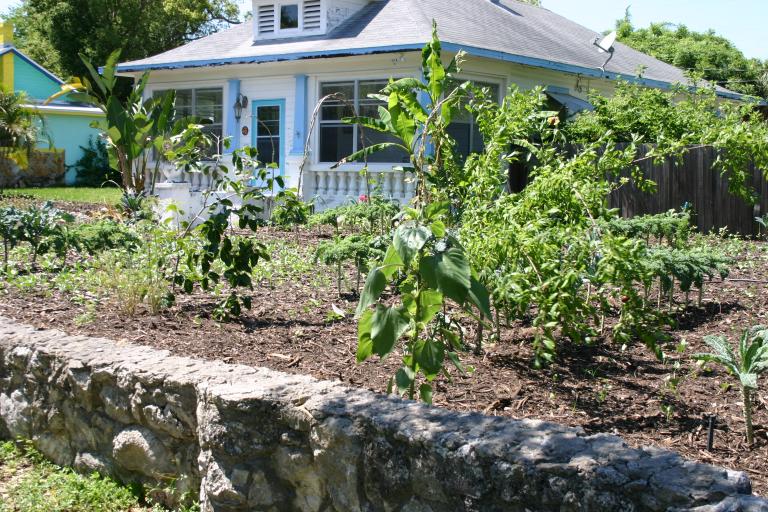

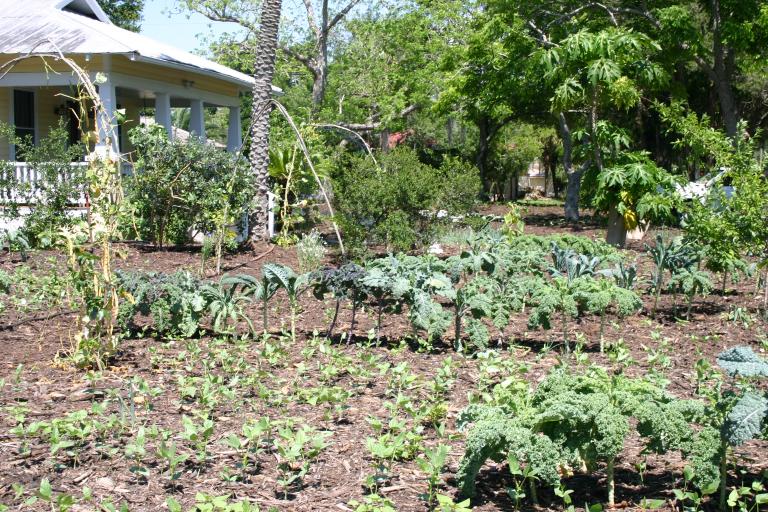

Thursday, May 5, 2016
Azomite® volcanic pumice is an incredible mineral supplement great for both plants and animals. You have to try it to believe how well it works. It relieves any “hidden hunger” that crops, plants, or turf may be experiencing with resulting strong, productive growth promoting plants that live longer and have more fruit with a longer shelf life. Quality Green carries three formulations in 10 lb. bags, 44 lb. bags, and pallet or tote quanties: granulated, micronized, and slow release. We buy in truckload quantities, so you can be assured we are giving you the best price available.
Above: Azomite in the slow release formulation.
Wednesday, May 4, 2016
What are the keys to producing olives in central Florida? We know that there are enough chill hours. So, what are some of the basic cultural practices besides hard selective pruning (reduction cuts of alternate halves of the tree every year and topping to a height of 9 feet), well-drained soil, four or more hours of direct sunlight, regular irrigation but at reduced intervals compared to most other crops (generally, allowing the soil to dry to about 55% of the water-holding capacity of the soil before re-watering)?
Nitrogen (N) in the soil is not tested because N is always extremely low in the soil. However, when trees are established the leaf tissue level needs to be tested in the summer and compared to known optimum levels, which is very important to know if N inputs need to be increased or decreased for the following year. As a general rule, nitrogen is applied at a rate of 50 pounds per acre (lbs/ac) per year and 75% of the N needs to be applied early in the year (in January) before spring flush begins. For example if using our 3-0-5 fertilizer (actually over 4% N and almost 6% K) to correct N deficiency early in the year (which supplies almost twice as much potassium as nitrogen, which is 1250 lbs/ac of root zone (1250 x .04 = 50). This 29 lbs/1,000 square feet (sq.ft.) of root zone (1250/43.56 = 29) of 3-0-5 Fertilizer is needed. This provides 1.2 lbs N/1,000 sq.ft. of root zone (29 x .04 = 1.2). The first application of 3-0-5 Fertilizer should be 938 lbs/ac (1250 x .75 = 938) or 22 lbs/1,000 sq.ft. for the January application. Then apply the rest of the 3-0-5 fertilizer (312 lbs/ac or 7 lbs/1,000 sq.ft.) in April. (This may be split into two applications in April and June). When nitrogen leaf tissue content is tested later, the optimum amount of N should be close to 1.8%.
NUTRITION NOTES ABOUT NITROGEN INTERACTIONS: Phosphorus (P), but not potassium (K), increases in olive leaf tissue as N increases to an optimum level. Optimum N in the leaf tissue, along with optimum P has been demonstrated to increase fruit set. Optimum potassium, on the other hand, increases fruit yield.
- Yearly applications of dolomitic limestone are needed until the pH climbs to 7.3. Recommend 1,000 lbs/ac (23 lbs/1,000 sq.ft.) of dolomitic limestone (calcium magnesium carbonate). The pH will continue to rise (which is desirable for olive production) before the pH begins to drop. When the pH drops back to around 7.3, apply another 1,000 lbs/ac (23 lbs/1,000 sq.ft.) of dolomitic limestone.
- Correcting potassium (K), Magnesium (Mg), and Sulfur deficiencies: Apply 700 lbs/ac/year of potassium magnesium sulfate (SPM/KMag/SulPoMag) which is 16 lbs/1,000 sq.ft. of root zone, with 500 lbs/ac in January (12 lbs/1,000 sq.ft.) and 200 lbs/ac (5 lbs/1,000 sq.ft.) after fruit set in April.
- Correcting nitrogen (N) and sulfur (S) deficiencies and/or maintaining sufficient levels of N & S: Nitrogen inputs are based on a low 50 pounds per acre (lbs/ac) per year rate and 75% of the N needs to be applied early in the year before spring flush begins (in January). For example, if using our 3-0-5 fertilizer to correct N deficiency: olives need 0.86 lbs N/1,000 square feet (sq.ft.) of root zone early in the year or 22 lbs/1,000 sq.ft. of our 3-0-5 fertilizer. Then the rest of the 3-0-5 fertilizer (7 lbs/1,000 sq.ft. of root zone) after bloom in April. An option is to use sulfur coated urea (SCU) at the rate of 85 lbs/ac or 2 lbs/1,000 sq.ft. of SCU in January (providing 37 lbs/ac of N) and 30 lbs/ac of SCU after fruit set in April (providing 13 lbs/ac N). Apply no nitrogen containing fertilizer later than June.
- If phosphorus (P) becomes deficient: Apply 40 lbs/1,000 sq.ft of root area of bone meal (10% Phosphorus). Apply P when the soil test indicates less than 200 lbs/ac in the soil.
- Correcting silicon deficiency: Apply 220 lbs/ac (5 lbs/1,000 sq.ft.) of Azomite volcanic pumice (with 65% bio-available silicon dioxide) in January and 220 lbs/ac (5 lbs/1,000 sq.ft.) after fruit set any time between April and June.
- Recommend three liquid spray applications (with the last application in July) of our 3-6-9 liquid foliar fertilizer and Essential Plus (high in kelp and available amino acids), our 3 in 1, and the trace minerals as follows. In a spray tank of 50 gallons (or more) of water to be sprayed per acre, add one gallon of 3-6-9 (one ounce per gallon) and 1 to 2 quarts (1/2 to 1 oz. per gallon) of Essential Plus, and two gallons per acre (2 ounces per gallon) of our combination 3 in 1 (fish, humic acid, kelp, blackstrap molasses) . Add the micronutrients manganese, zinc, and boron (for the first and last applications only) in glucoheptonate form as described below.
- If manganese and available zinc are low in the soil (almost always), combine the trace minerals boron (first & last applications only) manganese, and zinc as KeyBor & MZ Mix (boron should be applied routinely every year two times for the spring and June foliar applications only) with the 3-6-9 Foliar fertilizer and Essential Plus. For all three sprays (January, April, and June), put 2 quarts per acre of the MZ Mix (one teaspoon/gallon) into sufficient water in the spray tank (after putting in the 3-6-9 liquid fertilizer). For the January and June applications only (only two per year), also put KeyBor (glucoheptonate chelated boron) into the spray formulation. Apply KeyBor in January at the rate of one gallon per acre (one ounce/gallon). Lower the rate for the June application of KeyBor to 2 quarts per acre (1/2 ounce per gallon). Lower the rate for KeyBor only. Do not lower the rates for the other spray materials.
If iron (Fe) is also deficient, Add MZFe Mix (manganese, zinc, and iron glucoheptonate) at the rate of 3 quarts per acre with each of the 3-6-9, 3 in 1, and Essential Plus applications starting in January and stopping in June.
- If copper is deficient, Cu should be applied as a foliar spray and it must be sprayed SEPARATELY. The rate for two sprays during the January to June period is one ounce of Copper X in a minimum of 12 gallons of water, which means 0.5 teaspoon per gallon of water. Do not exceed this rate!
- Do not use glyphosate/Roundup as olives have extreme sensitivity to this material. Glufosinate ammonium is an alternative.
- Important: Avoid the ammonium form of nitrogen (N) in fertilizer, or limit the amount to 15% of the total nitrogen. Ammonium ties-up calcium when it supplies more than 15% of the total N. Calcium availability is crucial as Ca facilitates the uptake of other minerals.
- Avoid chlorine as it is very toxic to olive trees. Avoid high salt index fertilizers with muriate of potash which is potassium chloride.
- The recommended sulfur coated urea work to release minerals locked up in the soil.
Every year, apply the required fertilizer amendments in two split applications: January (before bud break) and April. Apply 75% of the dry, ground applied fertilizer in January and the remaining 25% in April. Alternately, the 25% may be split between April and June. A high potassium liquid 3-6-9 fertilizer with kelp should be sprayed three times (along with needed micronutrients) January through June as well (see paragraph #3). A basic long term goal is to work toward a 3:1 ratio of calcium to magnesium in the soil with a sufficient amount of each. Adding dolomite (that has a 2:1 ratio of Ca:Mg) when the pH is below or drops to 7.3 and using potassium magnesium sulfate or magnesium sulfate (always make sure that the potassium component being applied is 1.6-1.7 times as much as the low rate of nitrogen) are two ways to work toward this goal. Overall, keeping potassium in the soil at high levels is one of the top priorities.
Basis for using potassium magnesium sulfate and other low salt index, slow release fertilizer materials: Often, potassium in conventional chemical fertilizer is in the form of potassium chloride, a.k.a. muriate of potash/MOP. MOP has a very high salt index, is highly soluble, toxic and will leach below the root zone with the first rain or irrigation and will not improve soil potassium levels. It is important to remember that only organic matter in the soil will prevent the leaching of both cations (positive charge minerals like potassium, calcium, and magnesium) and anions (negative charge mineral forms like nitrate and sulfate). The number one way to build soil organic matter is to increase beneficial microbial life in the soil. The number one way to increase beneficial soil microbial life is with natural, slow-release minerals that are held in the soil for an extended period of time. Avoid hot, high salt index fertilizer, with lots of ammonium form and chlorine form, which do not contribute to building the soil.
Tuesday, May 3, 2016
Yes, we have pomegranates, to include the outstanding “Salavatski” variety.
“Salavatski” is also known as “Russian-Turk”. It has very large red fruit with red arils and sweet/tart juice. It is extremely cold hardy and was imported from Afghanistan to the USDA Station in Byron, GA. It has survived temperatures as low as -6F in Georgia!
Tree Form: Bush
Height:10′
Pollination: Self-pollinating
Bears: August-October often bears after only 2-3 years
Light requirements: Full sun
Soil type: Well-drained pH 5.5-7.0
Pruning: Keep pruned 3 to 6 main trunks
Maintenance: Easy
Hardiness Zone: 6-9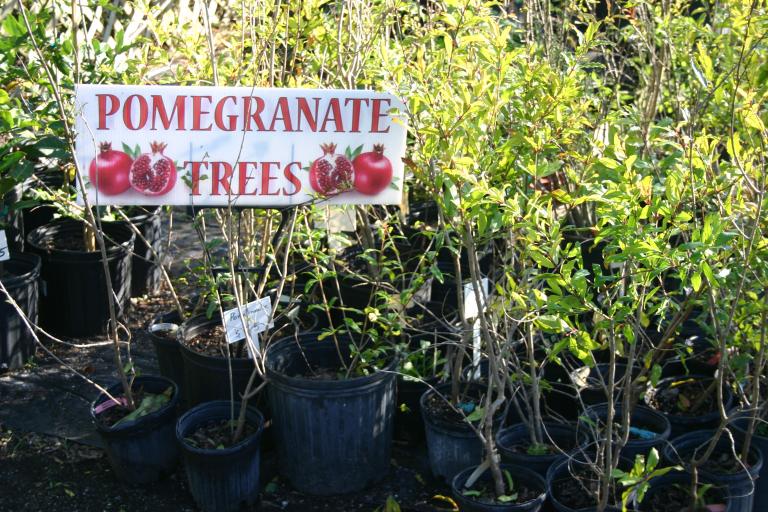
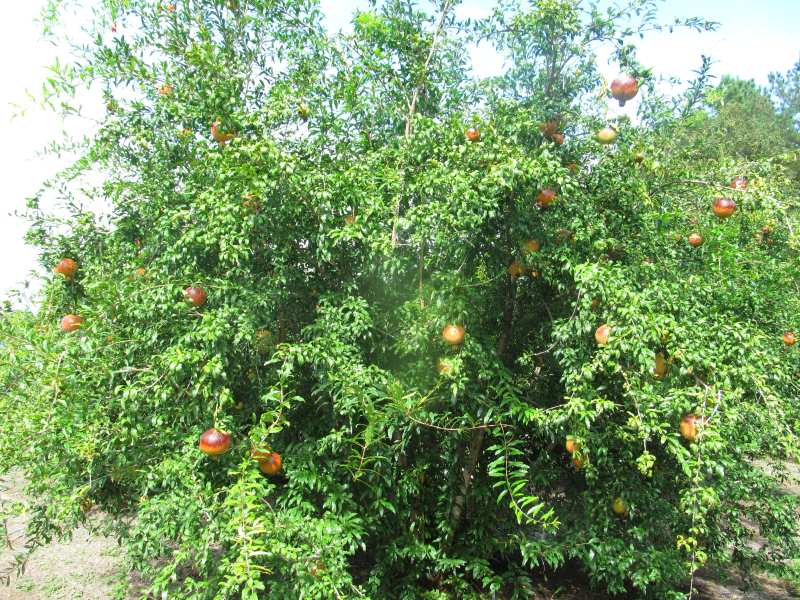
Monday, May 2, 2016
The Artisan Alley Farmers Market was a big success Friday evening. 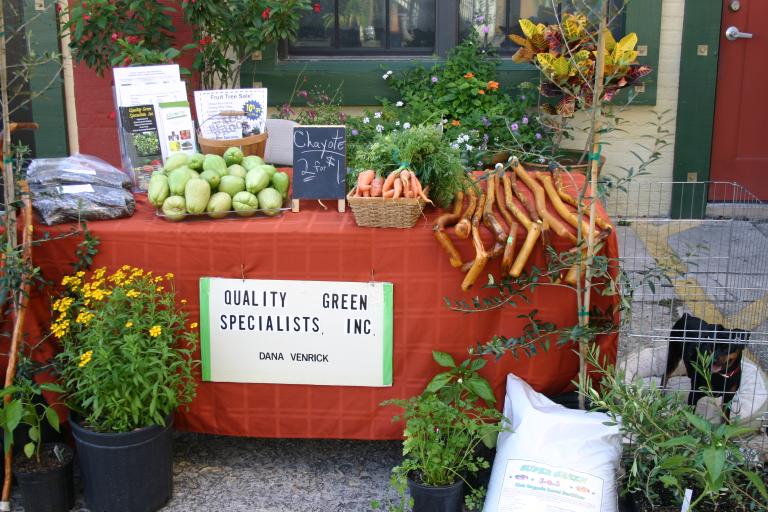
Friday, March 29, 2016
If you are in the area, be sure to stop by the Artisan Alley Farmers Market in downtown DeLand tonight from 6-9 p.m. I’ll have olive trees, pepper plants, delicious fresh-picked chayote squash, bunches of fresh carrots, papayas, and more. I’ll also have my beautiful hand-carved walking canes. See you there! Artisan Alley is located 1/2 block west of the intersection of Woodland Ave. & New York Ave. behind the Beacon newspaper office. Artisan Alley is a special place to meet and greet friends, buy locally grown produce, find some of the best local crafts (like artisan soaps and candles), and enjoy great breads, deserts, and all types of food & beverages. A special treat is watching the bats come out at dusk. As usual, our beautiful nursery is open 8-5 for your browsing pleasure.
Thursday, April 28, 2016
So, how is the lawn fertilized with our Super Green 3-0-5 Fertilizer on March 28, 2016 looking? Well, here are the before and now photos:
Above: This is how dark green the lawn is looking now (photo taken April 28, 2016).
Above: This is how faded the lawn was looking on March 28, 2016.
Wednesday, April 27, 2016
Below: Olive groves are becoming more common in central Florida. Pictured below is yours truly in John Fall’s grove in Dade City.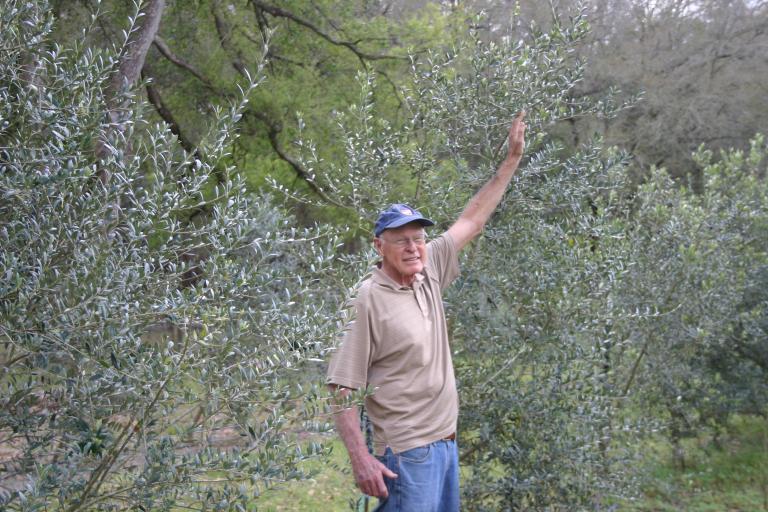
Tuesday, April 26, 2016
Good news. Just released: our new granular fertilizer, CitrusPro 3-0-5, designed to work in tandem with our liquid treatment Citra Thrive Plus 4-10-10. CitrusPro 3-0-5 is research based, having a high level of available, energized/oxygenated carbon as fulvic acid, phosphite, silicon dioxide (from Azomite), generous amounts & a desirable ratio of calcium & magnesium, and much higher sulfur than a typical fertilizer. Not only does CitrusPro contain over 3% nitrogen and 5% potassium, but also it has 9.5% calcium, 2.3% magnesium, and 18% sulfur and all the micronutrients. This fertilizer supplies all of the essential minerals plus the high amount of sulfates unlocks minerals tied up in the soil and gets them into your Citrus trees!
Monday, April 25, 2016
Our energized (extra oxygen & immediately bio-available fulvic acid) Citra-Thrive Plus spray & energized granular fertilizer promote recovery from Citrus Greening. This thornless Grapefruit seedling was dying. There had been no new growth for a year and there was extensive die-back of terminal branches (and no doubt die-back of the roots as well). Now, after treatment in February, there is healthy new growth and bloom & some fruit for the first time. To keep the tree healthy, fertilize with our energized granular fertilizer three time per year at the three main flushes of growth and spray with our Citra Thrive Plus on a regular basis (at least three times per year, with monthly sprays working the best).
Above: Note the healthy new growth and the thornless character of this seedling grapefruit.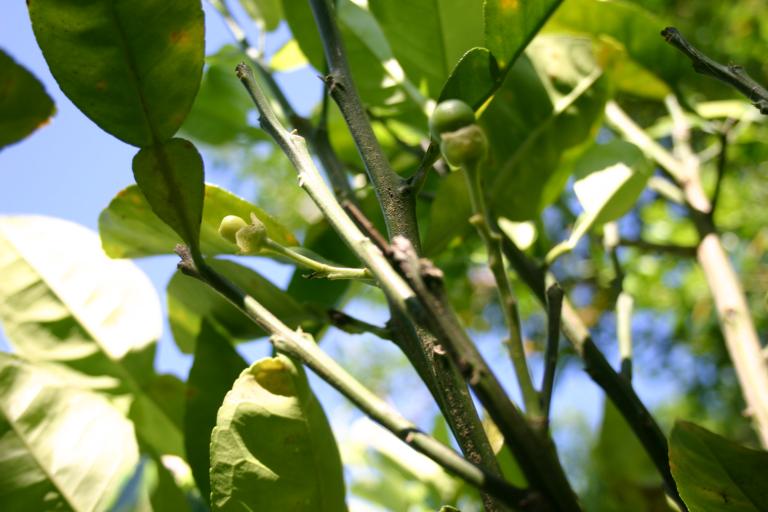
Above: First fruit on this thornless seedling grapefruit. Notice the evidence of previous die-back. Also note the big rachis connecting the blade of the leaf (on the left) to the stem that is characteristic of grapefruit leaves. There are a few spots visible that are caused by greasy spot, a fungal pathogen – not Greening. A copper spray with our organic Copper X will stop greasy spot. Above two photos taken on April 21, 2016.
Saturday, April 23, 2016
More high quality fruit trees & fruiting plants are now ready: Mulberries, Paw Paws (Asimina triloba), pecans, persimmons, fruiting Arbequina olives, custard apples, peaches, Avocados, blueberries, Muscadine grapes, Dunstan chestnuts, dwarf solo papayas, Japanese plum (Loquat), pink, white, and strawberry guavas, hardy thornless blackberries, and more. Below: Another happy customer at the Artisan Alley Farmer’s Market last evening with a Chayote squash we grew at the nursery.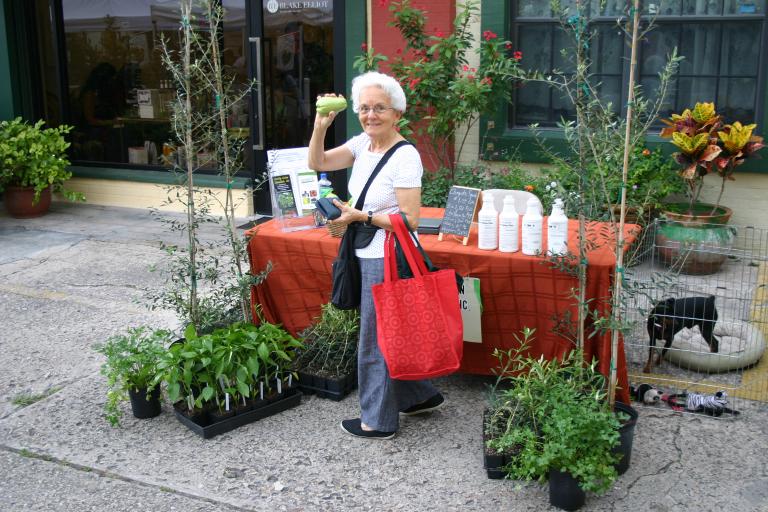
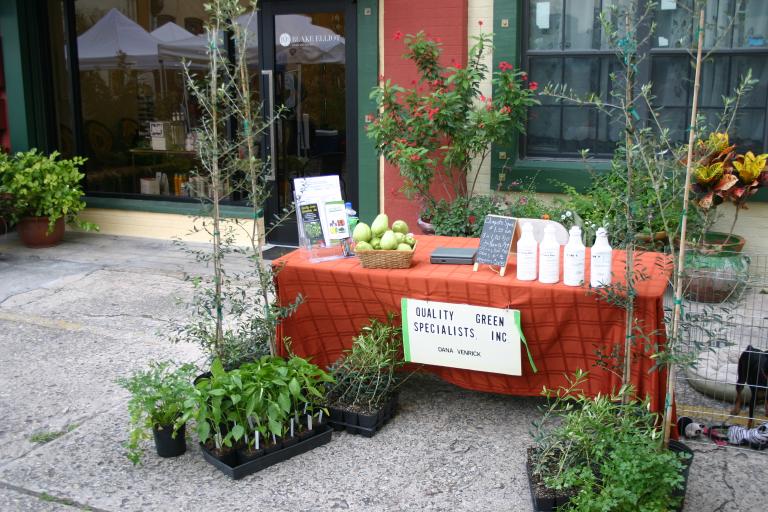
Friday, April 22, 2016
Good news. The new crop of olive liners are ready and a huge selection is now on display at the nursery. These are top quality Arbequina and Koroneiki liners. Arbequina is the best fruiting variety for Florida and Koroneiki is the best pollinator. Both are self pollinating; however, having the Koroneiki as a pollinator (one Koroneiki for up to 20 Arbequina in a planting) improves fruit set and produces very high quality oil as well. Because they are both Olea Europea (genus & species), the cut green leaves also produce high quality olive leaf extract.
How do you make olive leaf extract? Here is our easy to follow recipe using a three gallon slow cooker. Put 4 ounces of green, fresh-cut leaves (about two full hand-fulls) in 3 gallons of water in the slow cooker. Turn to 180 degrees F., cover, and slow cook for 12 hours. Turn off and leave covered to steep for another 5 hours. Then strain through cheese cloth. Delicious and super healthful! Keeps well for two weeks when refrigerated. Great with honey.
Also, it’s Farmer’s Market Day at the Artisan Alley 6-9 p.m. in downtown DeLand.
Thursday, April 21, 2016
Let’s see how the Citrus trees are looking as they are recovering from Greening: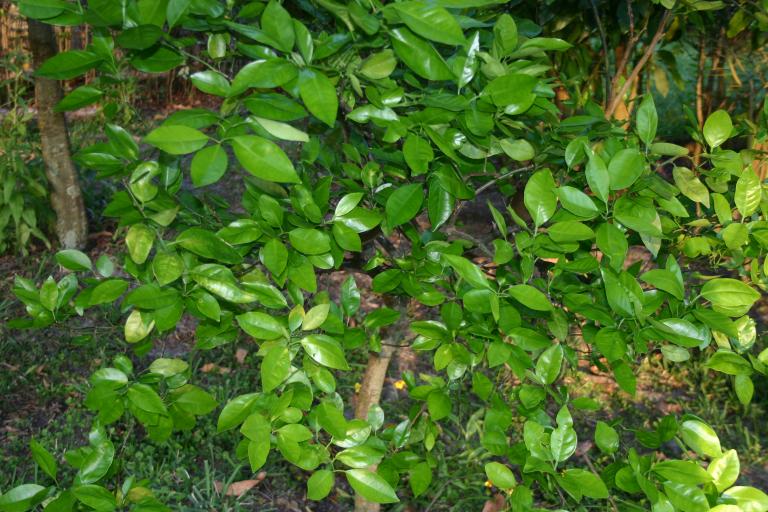
Above: How the white tangelo looks now (April 19, 2016). Notice that the new leaves have a green, healthy glow.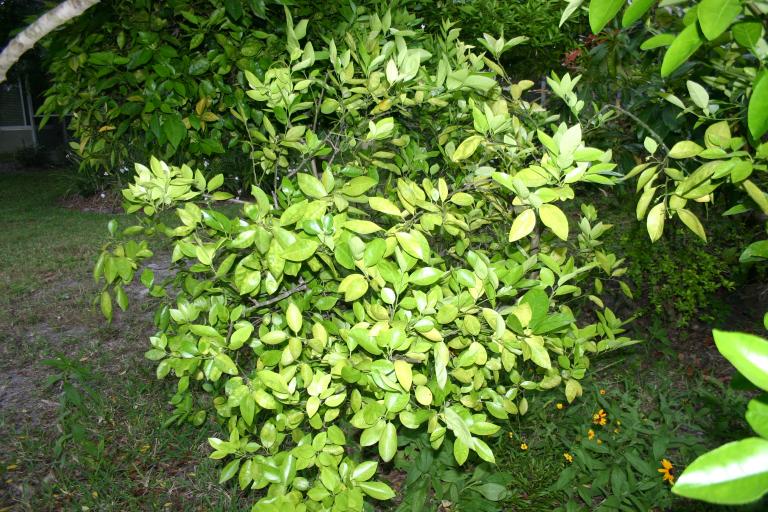
Above: This is how the foliage of the white tangelo looked one year ago on April 19, 2015 before treating with Citra Thrive Plus and our granular CitrusPro Fertilizer. The health of the tree became progressively worse until it was treated early in 2016.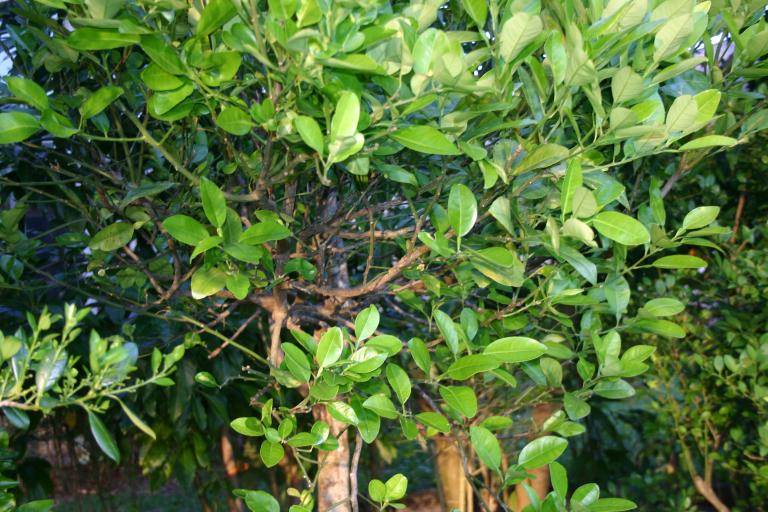
Above: The grapefruit tree now has healthy looking foliage and a few small fruit for the first time. Photo taken on April 19, 2016.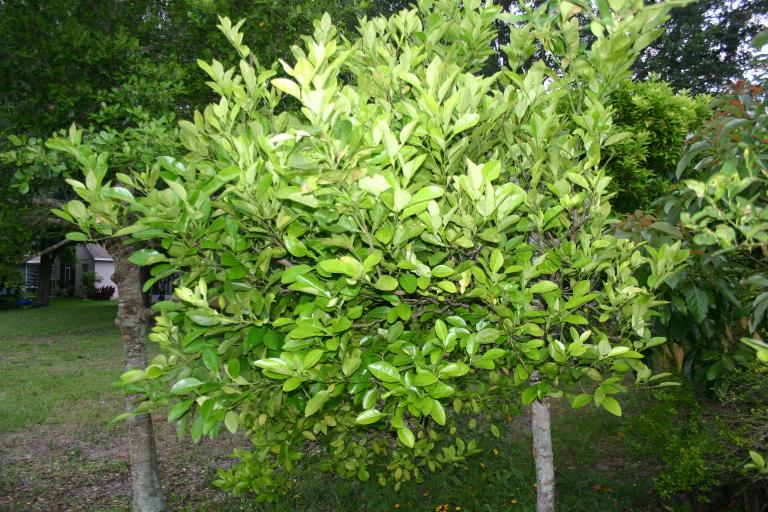
Above: The grapefuit tree had a chorotic look before treatment on April 19, 2015 – after this, the tree weakened further and had lots of dead terminal branches until it was treated with foliar CitraThrive Plus and granular RootPro Fertilizer.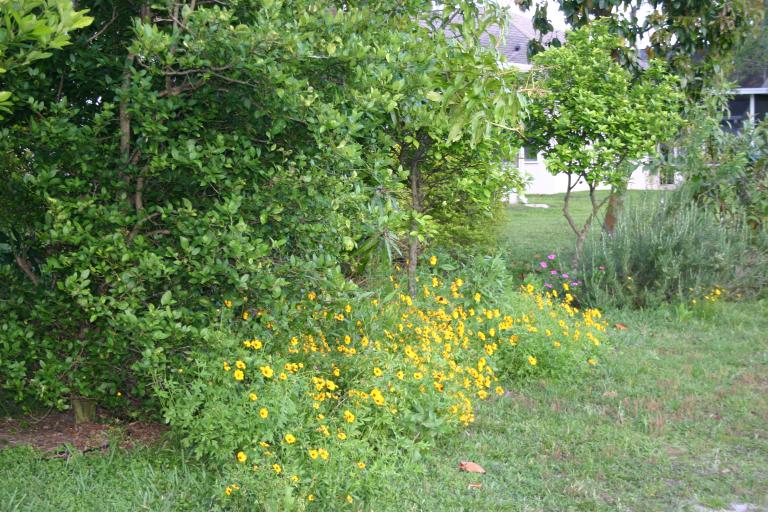
Above: The Key Lime (left side) and two orange trees are regaining health on April 20, 2016.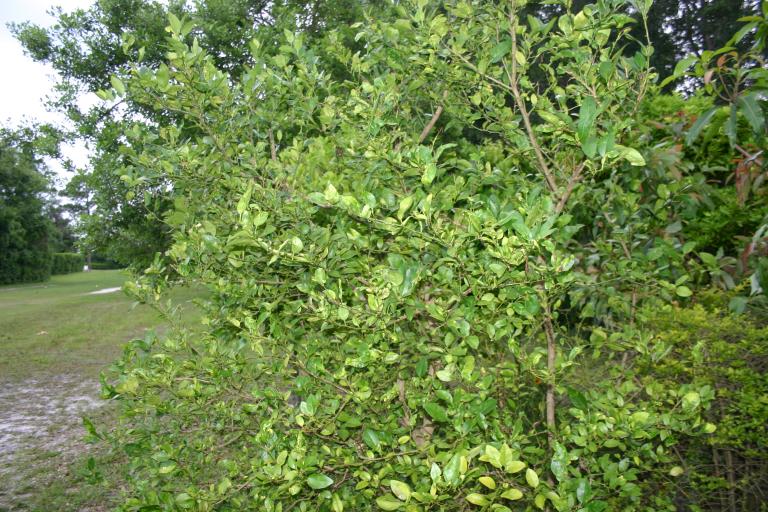
Above: The Key Lime looked thin and chlorotic before treatment. Photo taken 4-19-15.

Above: This is the unhealthy condition of the orange tree before treatment shown the the middle of the above photo of healthy trees. Photo taken 4-19-15.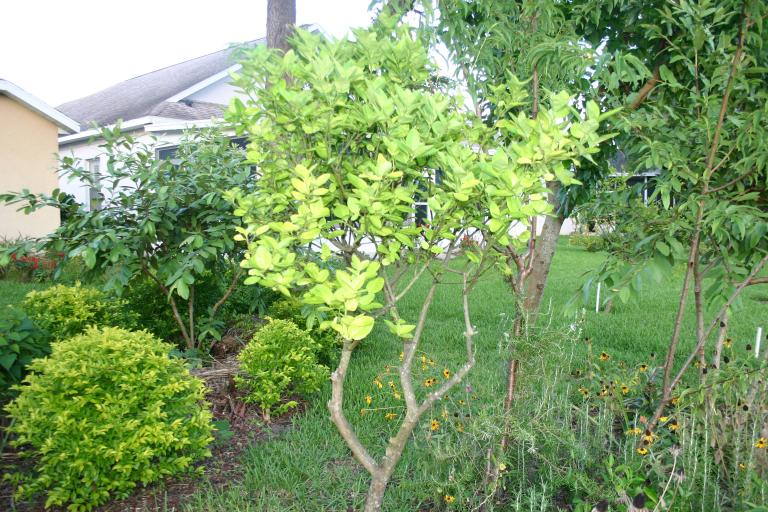
Above: The orange tree on the right (in the photo of the healthy trees in 2016) was already looking unhealthy in 2014.
Above: Here is another orange tree recovering from Greening. The tree has lots of healthy new foliage and healthy small green fruit. Photo taken 4-19-15.
Above: This is how this orange tree looked on 4-19-15 before treatments.
Wednesday, April 20, 2016
Would you like a flower for bright sunlight and one to brighten up that shady part of your yard? We have the answers: beautiful yellow Coreopsis & red impatiens!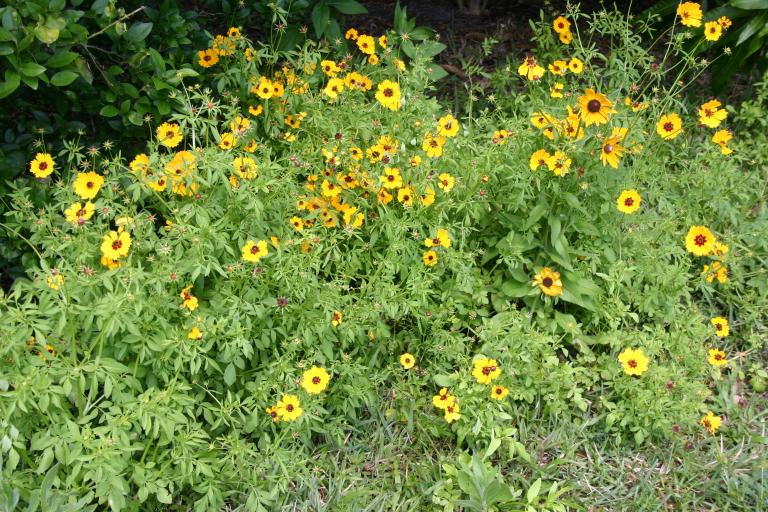
Above: Coreopsis basalis putting on a beautiful display in the landscape.
Above: Impatiens we are growing at the Nursery. What could be better to brighten up a dull, shady area?
Tuesday, April 19, 2016
Yes, Quality Green has ‘Jack Frost’ Ligustrum. This is the beautiful, low-growing green & gold landscape plant ideal for foundation plantings in the landscape. It contrasts well with red & pink flowers and is great for adding a colorful touch to your edible landscape design.
Above: ‘Jack Frost’ Ligustrum in the front display at Quality Green. They draw the eye along with the pink flowers.
Above: Notice how well the gold color of the ‘Jack Frost’ Ligustrum compliments the bergundy color of the Loropetalum and Hibiscus, and the red and pink of the flowers in the landscape bed. The sheared orange tree (top, second from left), papaya (trunk showing to right of the orange tree) and Arbequina olive fruit tree (the bushy corner tree above the Loropetalum) become a subtle backdrop to this colorful landscape. Not visible, behind the orange tree, is a strawberry guava.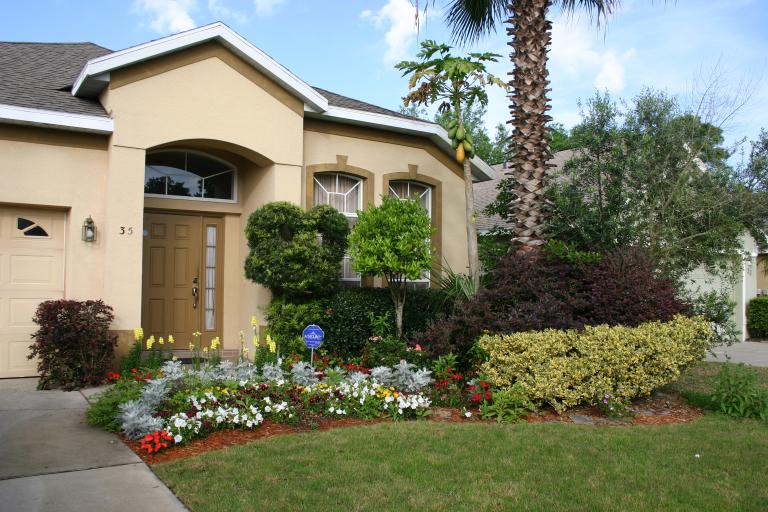
Another view showing how using ‘Jack Frost’ Ligustrum as a foundation planting beautifies and “ties together” part of an edible landscape. Note the edibles left to right: Sheared orange tree, papaya, strawberry guava (cattley guava), and Arbequina fruiting olive.
Monday, April 18, 2016
The Nursery is showing lots of color with blooming yellow Coreopsis, spp. (the official State of Florida wildflower, Rudbeckia hirta (Black-eyed Susan), red Impatiens, Vinca (Periwinkle), and red Knockout roses. They add a lot of interest when shopping the finest & largest selection of fruit trees and fruiting plants in central Florida. Yes, we have wildflowers, Impatiens, Vinca, and red Knockout roses for sale in containers. They add a nice touch to your favorite fruit trees, whether it be olives, Citrus, pomegranates, persimmons, avocados, peaches, pears, sugar apples, papayas, pecans, Dunstan chestnuts, figs, guavas, or others.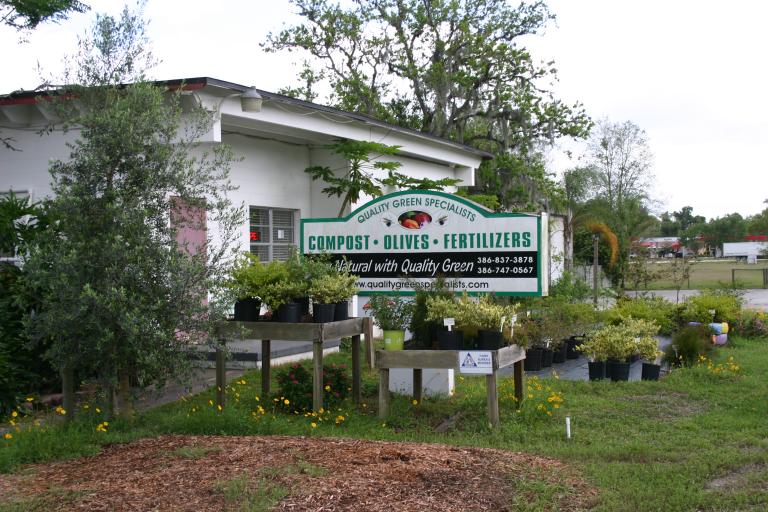
Coreopsis are blooming profusely in the front display area and in the main nursery in back. Above: Coreopsis are highlighting the company sign and a beautiful Arbequina olive tree.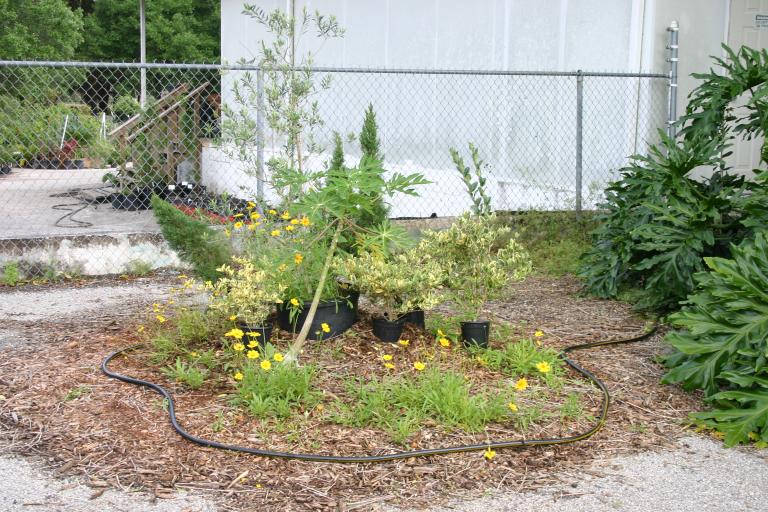
Above: More Coreopsis give a nice touch to the display bed by the front parking space. They are so easy. They come up on their own every year. We keep all the weeds pulled by hand except the Coreopsis, Rudbeckia, and Vinca that germinate and grow in certain areas. 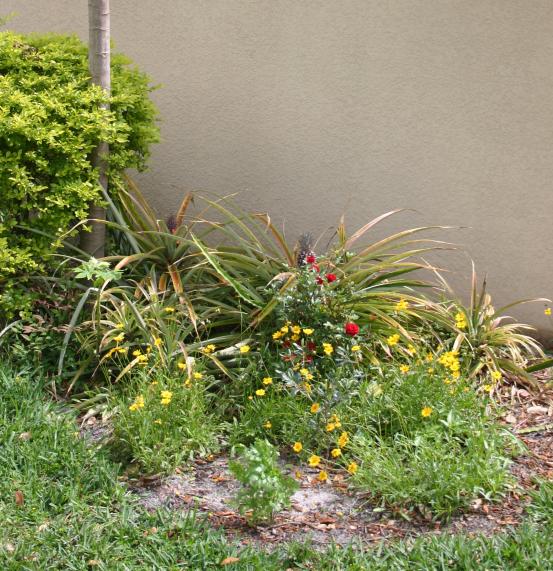
Above: At home, these Coreopsis also came up on their own from an original wildflower seeding about 10 years ago. Leave bare spaces here and there and pull them out where they are not wanted. It’s great to have long-lasting, easy to care for wildflowers. Both Coreopsis and Rudbeckia have been coming up in my yard from this original seeding for almost year-round color. This edible landscape bed displays not only Coreopsis but also a papaya, pineapples with fruit, a red knockout rose, gold mound (Duranta) foundation plants, a cilantro plant in front, and small basil plants coming up to the lower right.
Above: More of my “edible landscape” along the south side of the house: pineapples, coffee plants that bear coffee cherries every year, a guava plant and a Vibernum. My special white peach and a pineapple guava (feijoa) is on the corner just beyond the Vibernum. What could be better than having something to eat from your landscape year-round?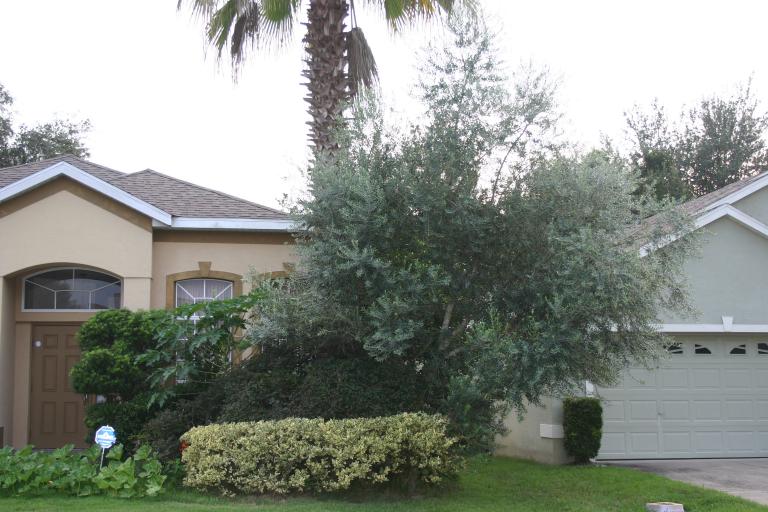
A front view of my “edible landscape” from last year. From left to right: a Seminole pumpkin vine – a Florida native (that had three delicious squash), a Podocarpus topiary shaped like Mickey Mouse, American holly, a croton (the touch of red to the left of the gold colored Ligustrum, a papaya, a hard-pruned orange tree (behind the papaya), ‘Jack Frost” Ligustrum (gold-colored), Loropetalum (behind & above the Jack Frost, my 20’ high Arbequina Olive (that had 20 pounds of olives last year), and a strawberry (cattley) guava tucked behind the olive.
Above: Here are black-eyed Susan and Vinca in the landscape bed to the left front of the house.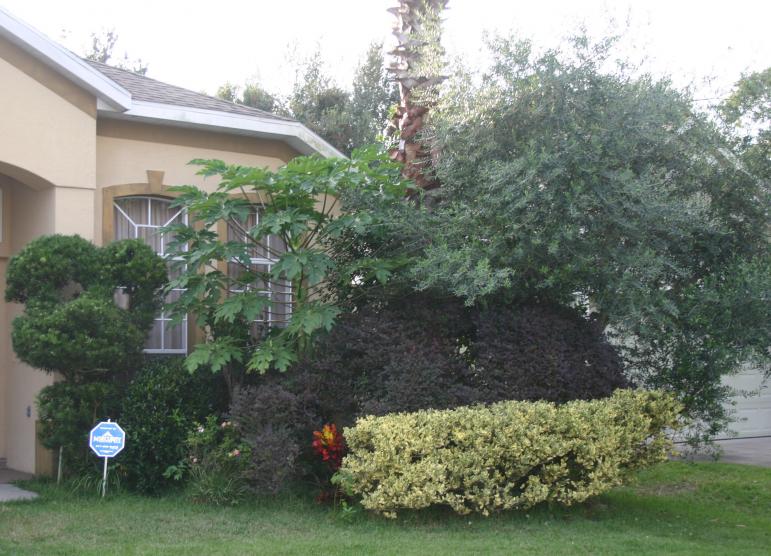
Above: Here is a recent view. Also visible is a Floribunda rose. A cluster of Rudbeckia that came up this spring is about to bloom in front of the croton. I’ll post the photo soon when there are blooms.
Saturday, April 16, 2016
Yes, we are open today 8-5. Yes, we sell our great compost and premium composted potting soil in bulk (1-10, 20, and 40 yard loads) and also in 32 quart bags.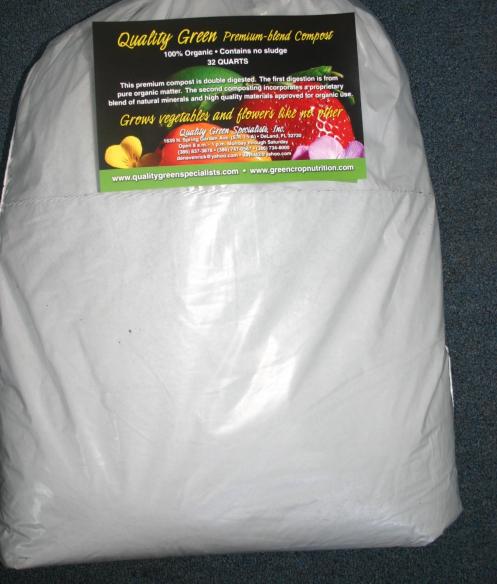
Friday, April 15, 2016
Be sure to stop by the Artisan Alley Farmers Market in downtown DeLand tonight from 6-9 p.m. I’ll have olive trees, tomato plants, pepper plants, bunches of fresh carrots, papayas, and more. I’ll also have my beautiful hand-carved walking canes. See you there! Artisan Alley is located 1/2 block west of the intersection of Woodland Ave. & New York Ave. behind the Beacon newspaper office. Artisan Alley is a special place to meet and greet friends, buy locally grown produce, find some of the best local crafts (like artisan soaps and candles), and enjoy great breads, deserts, and all types of food & beverages. A special treat is watching the bats come out at dusk. As usual, our beautiful nursery is open 8-5 for your browsing pleasure.
Thursday, April 14, 2016
Did you know that the plant usable bio-available fraction of humates is fulvic acid, not humic acid? You’ll be happy to know that the humate portion on our Citra Thrive Plus and Citra Thrive Greening Treatment liquid supplements is made with energized humates that contains over 58% fuvic acid. Our RootPro 3-7-4 that is a complimentary ground treatment for HLB (Greening) also contains higher than usual amounts of fulvic acid. The process we use is what happens to carbon in peat deposits over many, many years – the conversion of carbon and humic acid in an unavailable form to a highly reactive, easily available, and easily metabolized form – fulvic acid. This is Mother Nature’s most important secret for promoting the growth and reproduction of super healthy plants. We speed up and enhance the conversion to fulvic acid by adding extra oxygen to the carbon molecules.
Sadly, synthetic fertilizers and chemicals have depleted soil carbon on farms and in gardens. Sooner or later, growers must put carbon back into their agronomy practices in an efficient way, while reducing dependency on synthetics that deplete the soil. This is the way agriculture becomes sustainable; otherwise tremendous amounts of carbon will continue to be depleted from our soils and released to the atmosphere. A case in point is anhydrous ammonia fertilizer increasingly used after World War II. Many conventional growers have been relying unwittingly on an unsustainable method of adding energy into the soil food system, without the corresponding carbon, disregarding the critically important carbon to nitrogen ratio. Unit for unit, soil organisms consume 10 times as much carbon as nitrogen. The lack of soil carbon being promoted in many conventional agricultural practices has led to soil mineral depletion and poor soil microbial life with excessive minerals leaching below plant root zones.
Humates are a key in combating salinity that arise from heavy use of
synthetic fertilizers and poor quality water. Feeding soil bacteria sufficient amounts of available carbon (their primary food source), along with good soil structure and essential minerals at appropriate levels, stimulates vigorous root growth. Bigger, healthier root systems mean more water and nutrients taken up for the biosyntheisis of numerous plant compounds, to include sugars. Plant health and production are dependent on the plant’s ability to produce more carbohydrates than are consumed. Plant health, vigor and yield are increased
when there is a sufficiency of carbohydrates.
Unfortunately, the misuse and overuse of chemical fertilizers and chemicals in general have increased soil salinity and reduced soil microbial life. These unwise “quick fix” practices limit the ability of plants to grow substantial root masses and therefore decrease a plants ability to absorb nutrients from compromised soil.
Elemental sulfur, Epsom salt and other high salt index materials often increase total salinity, further compromising soil health. Synthetic fertilizers and chemicals, along with many conventional farming techniques, have contributed to the depletion of soil humus and beneficial bacteria to a level where crop sustainability is severely threatened.
Humates through mankind’s history been regenerated in the soil through such practices as cover crops, crop rotation, and applying compost. These practices are time consuming, costly and today’s economic pressures often prevent growers from following any of these practices. Quality Green Specialists has addressed these issues by combining natural low salt index, slow release minerals, many in organic form, that are held in the soil, along with the use of humates, with the majority of the humate as bio-available fulvic acid, in our dry and liquid fertilizer formulations. Our liquid products incorporate humic acid, fulvic acid, and seaweed along with other carbon sources, necessary minerals, and beneficial microbes. Our dry products include activated and mineralized humates for immediately incorporating essential carbon back into soils, along with all the needed essential minerals, and beneficial microbes. Not only that, we go the extra step to incorporate bioavailable silicon dioxide/SiO2 (as OMRI listed Azomite® volcanic mineralizer that contains 65% SiO2). It is important to know that the two elements needed most for plant growth and fruiting are carbon and silicon. Also of utmost importance are hydrogen and oxygen (think water/H2O). Of lesser importance are the “fertilizer minerals” potassium, nitrogen, phosphorus, calcium, magnesium, sulfur, and the micronutrients.
Think of it this way: Plants are composed of over 90% carbohydrates to include sugar (made of C-H-O/carbon, hydrogen, and oxygen). Less than 10% of a plant is composed of fertilizer minerals such as N-P-K. To remind us of the relative importance of elements and minerals, think of expression of C-Si-H-O-P-N-K-S-Ca-Fe-Mg (C.C.Hopkns Café mighty good), which stands for carbon, silicon, hydrogen, oxygen, phosphorus, nitrogen, potassium, sulfur, calcium, iron (a micronutrient), and magnesium (not to mention manganese, copper, zinc, boron, and other micronutrients).
Carbon increases the Cation Exchange Capacity (holding capacity) of the soil, along with water and essential nutrients. Bio-available elements are the number one way beneficial microorganisms are built in the soil and the re-cycling of microbes are the number one way the carbon level and holding capacity of the soil is built. Our liquid humic acid/fulvic acid and kelp (and other organics such as blackstrap molasses) for our liquid products, and dry granular activated humates, with high fulvic acid work hand-in-hand with all the minerals essential for promotion of beneficial soil microbial life and unsurpassed plant growth and yield.
Wednesday, April 13, 2016
Two of our many specialties are Premium Blend Compost and Quality Green Composted Potting Soil. The Potting Soil is great for container growing along with our organic Super Green 3-0-5 Fertilizer. Want to make a raised bed and grow the best vegetables ever? Try this formula. Use the potting soil (with coarser texture) for the base on the bottom of the bed and use a thinner layer of compost for topping off. Then fertilize by banding around the vegetables with our 3-0-5 fertilizer. We sell in bulk (loaded into your truck or trailer at our location or delivered) or by the 32 quart bag. Do not disturb the profile of the bed and once a year simply top off the bed with a thin layer of compost. Water the bed when the soil is starting to dry 1″ below the surface.
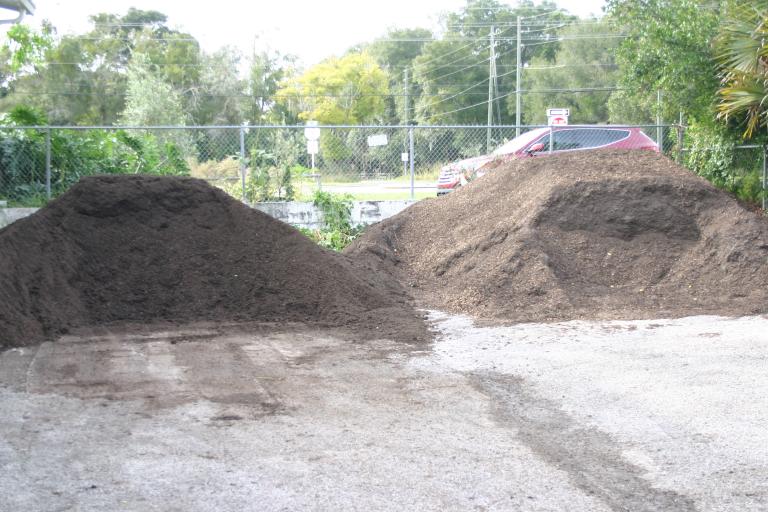
Above: Our richer compost is shown on the left and our potting soil is on the right.
Monday, April 11, 2016
Yes, fruit trees are blooming and making fruit.
Olive trees are now blooming. Photo taken April 7, 2016.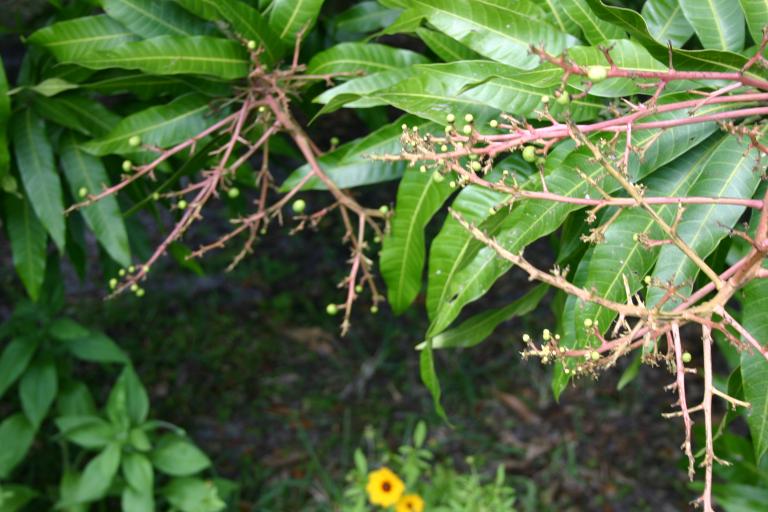
The mango at home in DeBary is setting lots of fruit. By the way, the tree is 25′ tall! The yellow flower at the bottom of the photo with the red center is a tickseed wildflower, Coreopsis basalis. Scroll down for a photo of this wildflower bed.
The strawberry guava (cattley guava) is full of bloom.
The avocado tree survived red bay disease and is now full of bloom!
The pineapples are blooming & growing fruit.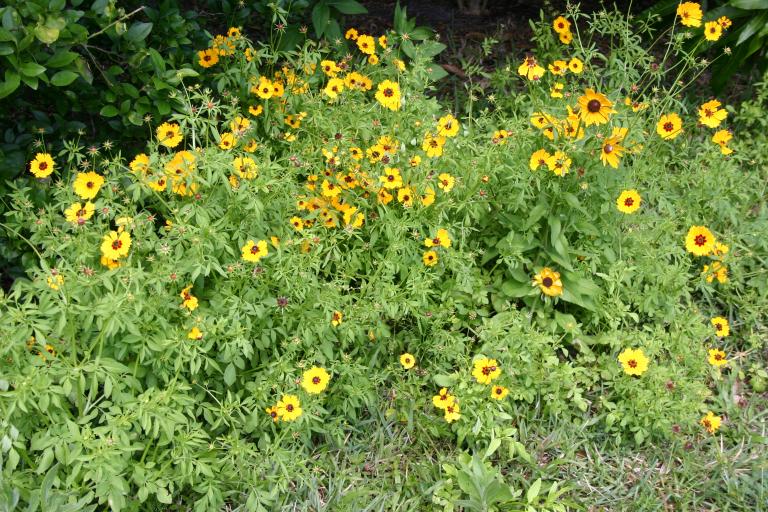
It’s not fruiting, but yes, we do have blooming wildflowers. Shown: Coreopsis basalis blooming in my yard on 4-10-16. Did you know that Coreopsis, spp. (the multiple species) are the official state of Florida native wildflower. Did you spot the black-eyed Susan (Rudbeckia hirta) hiding among the Coreopsis?
Friday, April 8, 2016
Yes, we have pomegranate trees and we have varieties that do well in central Florida, such as the Salavatsky, highly rated for its great taste. Pomegranates, of course, have super health benefits. Come visit us 8-5 Monday through Saturday and see all of our great selection of fruit trees, fruiting plants, and vegetables.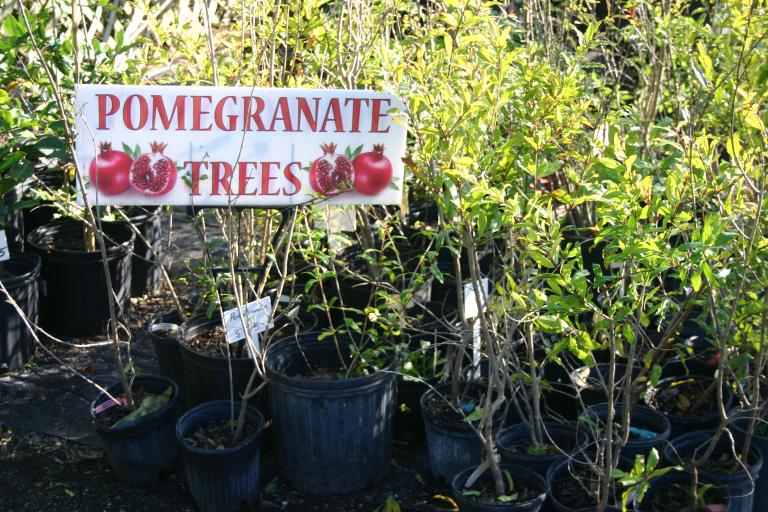
Thursday, April 7, 2016
One of our customers asked me to post the application rates for Citra Thrive Plus & MZ Mix (organic manganese & zinc glucoheptonate) in a spray program to remediate Citrus Greening (HLB). The rates are 3 ounces per gallon or 3 gallons per 100 gallons of water per acre. The rate for the MZ Mix is one teaspoon per gallon or one pint per 100 gallons per acre. Be sure to fertilize with our special granular fertilizer for Citrus three times per season as well. When starting early in the year, apply the Citra Thrive Plus three months in a row at the 3 ounces per gallon rate (spray until run-off from the foliage and also spray the ground around the drip-line of Citrus trees). Then, spray three more times at the rate of 2 ounces per gallon. If starting now, spray in April, May, June at 3 ounces per gallon, then spray at 2 ounces per gallon in July and September. Add one tablespoon per gallon (2-3 quarts per acre) of MZ Mix for each of the spray applications. Also put one ounce per gallon (one gallon per acre) of Key Bor (organic boron) into the spray tank for the first spray of the year, and then 1/2 ounce per gallon (1/2 gallon per acre) of Key Bor into the spray tank for the September application.
This Saturday, April 9, we will be at the Master Gardener Plant Faire at the UF/IFAS
Volusia County Agricultural Center in the morning, 3100 E. S.R. 44 (E. New York Ave.), DeLand 32724. As usual, we will be at The Nursery from 8-5 every day Monday – Saturday.
Lots of fruit trees & fruiting plants are blooming now: Olives, Strawberry (Cattley) Guavas, Oranges and other Citrus trees, Avocadoes, Surinam Cherries, Mangoes, Starfruit (Carambola), Blueberries, and more!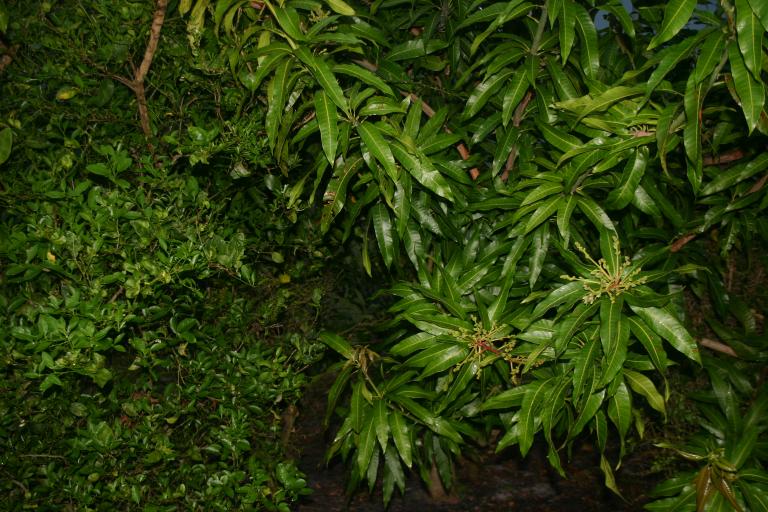
Mango tree in bloom in DeBary, Florida.
Monday, April 4, 2016
Friday night at the Artisan Alley Farmers Market turned out to be very successful and Saturday’s Florida Wildflower & Garden Festival was awesome! Next Saturday we will be at the Master Gardener’s Plant Faire at the UF/IFAS Volusia County Agricultural Center in the morning, 3100 E. S.R. 44, DeLand 32724. As usual, we will be at The Nursery from 8-5 every day Monday – Saturday 8-5.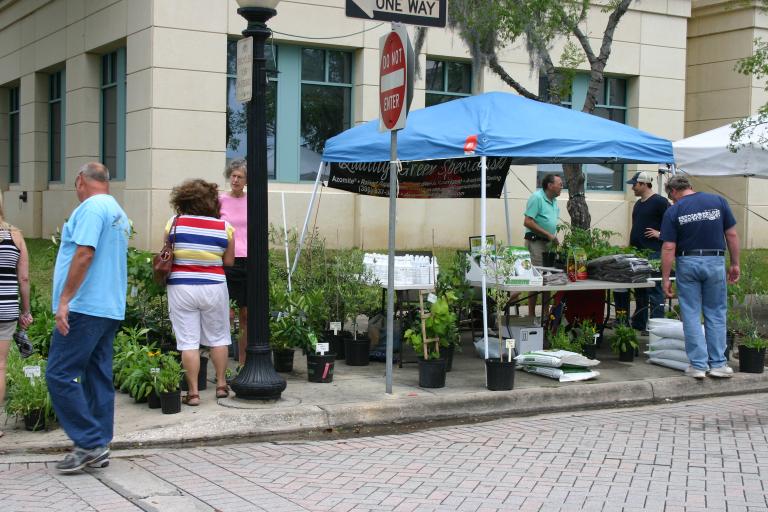
Employee Judy in Pink shirt on left & Co-owner Allen in the green shirt on the right.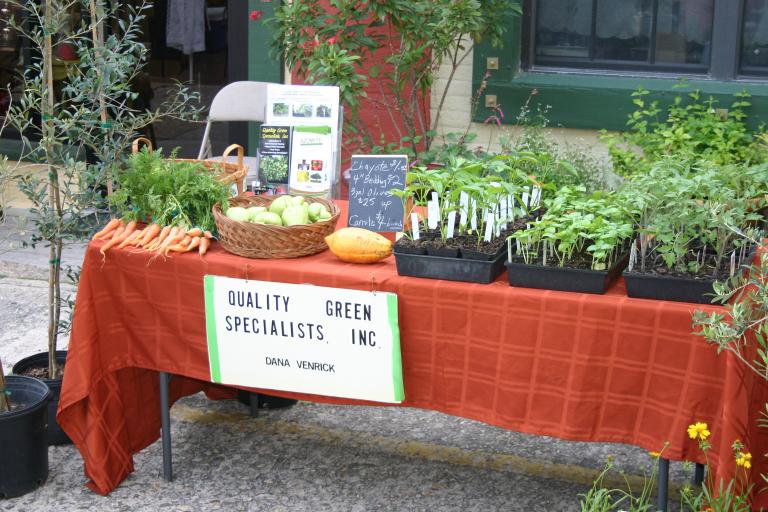
Quality Green’s display Friday night at the Artisan Alley in downtown DeLand.
Saturday, April 2, 2016
Today is the day. Be sure to come out to the 10th Annual Florida Wildflower and Garden Festival today 9 am to 3 pm. This has become a state of Florida award winning event. The venue is Indiana Avenue to the west side of Woodland Blvd. and the beautiful Athens Theater facing Indiana Avenue on N. Florida Avenue. My presentation at 9:30 a.m. in the Athens Theater will be: “Wildflowers Grow in Popularity” giving the history of the festival and the remarkable growth in the use of wildflowers all over the state of Florida since the Festival began 10 years ago. Other great speakers are Tom & Joanie MacCubbin and Dr. Walter Taylor, Ph.D. Professor Emeritus, UCF. For details about all the speakers and activities go to: http://mainstreetdeland.org/flwildflowerfest
Monday, March 28, 2016
One of our flagship products is our Citra Thrive Plus 4-10-10, a liquid concentrate which is specifically designed as a foliar treatment to remediate Citrus Greening disease (HLB). This product has the latest oxygen enhanced technology with the carbon humate portion having over 58% of the biologically available & metabolically active fulvic acid (as opposed to most humates having a much higher percentage of metabolically inactive humic acid).
Citra Thrive Plus achieves such a high percentage of highly active fulvic acid from a process called reduction oxidation of electrons (REDOX). REDOX is a process where as one element is oxidized, the other element is oxygen reduced. This process creates fulvic acid molecules that contain more oxygen electrons. Because fulvic acid contains more oxygen elections, the molecular weight of fulvic acid is lighter than humic acid. Those un-bonded (extra) oxygen electrons promote many natural occurring reactions in soils and more efficient metabolism within plant cells. The bottom line: plants are healthier, grow faster, nutrients flow easily, and systemic acquired resistance (SAR) is strongly boosted. Citrus trees managed with Citra Thrive Plus and our energized granular fertilizer blends regain vigorous health and have greater production of high quality fruit.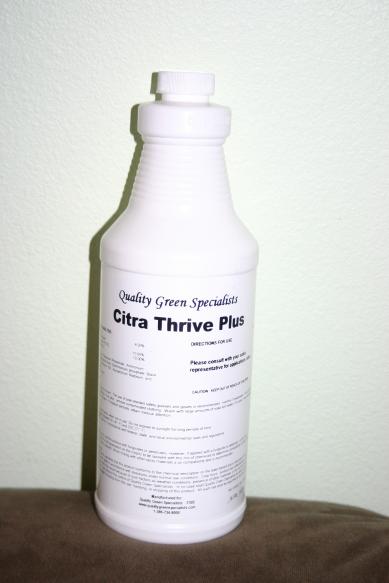
Friday, March 25, 2016
Be sure to stop by the Artisan Alley Farmers Market in downtown DeLand tonight from 6-9 p.m. I’ll have olive trees, tomato plants, pepper plants, carrots in 3 gallon containers, bunches of fresh carrots, fresh Chayote squash, papayas, and more. I’ll have my beautiful hand-carved walking canes. See you there! Artisan Alley is located 1/2 block west of the intersection of Woodland Ave. & New York Ave. behind the Beacon newspaper office. Artisan Alley is a special place to meet and greet friends, and enjoy some of the best food and beverages around. A special treat is watching the bats come out at dusk.
Come by The Nursery from 8-5 at 1639 N. Spring Garden Ave. in DeLand 32720 and see what is new. You’ll enjoy things like blooming pineapple plants developing fruit (each purple flower develops into a segment of the pineapple fruit):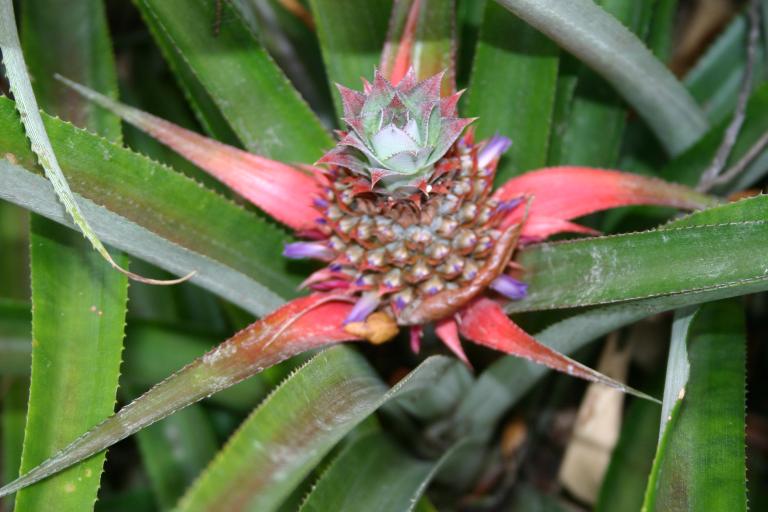
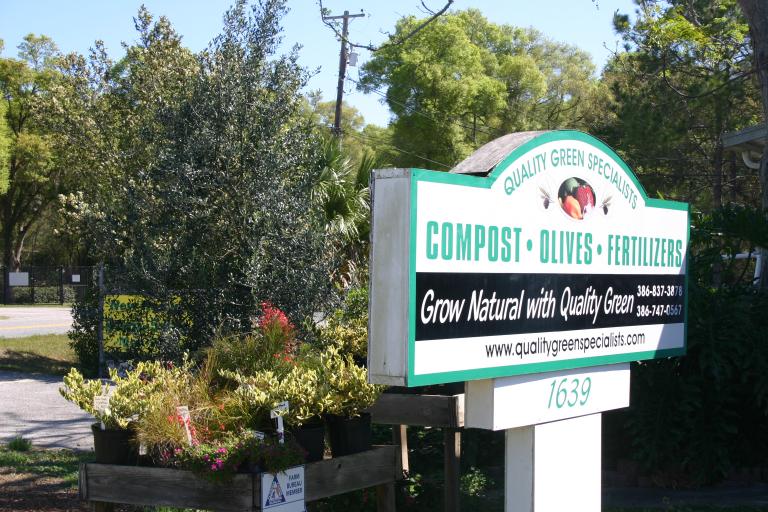
Thursday, March 24, 2016
Did you know that we grow a nice selection of potted vegetables? Check out the bush beans, tomatoes, peppers, and more in our vegetable display. Not shown: We also have potted carrots, Seminole pumpkins, Calabaza squash, sweet potatoes, and okra planted for the summer. Photo taken 3-23-16.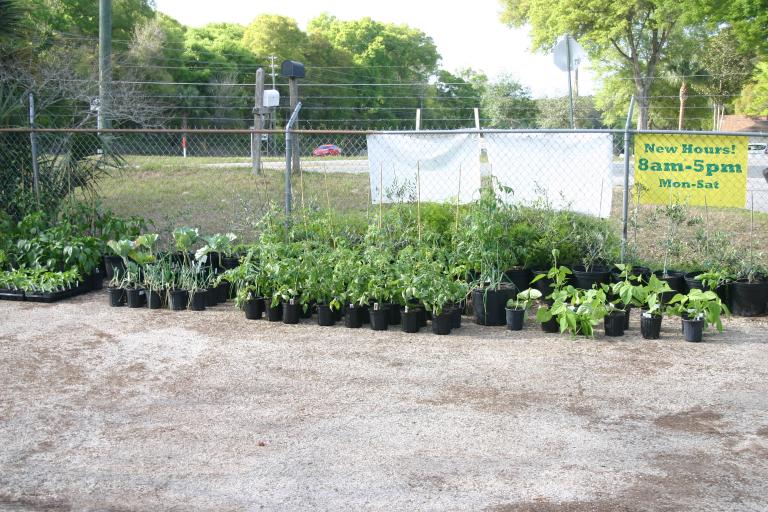
Wednesday, March 23, 2016
Did you know that Quality Green Specialists, Inc. has their own line of high quality liquid and granular fertilizers? For example, our 3 in 1 liquid fertilizer with 1.00% nitrogen, 0.38% phosphate (P2O5), and 0.86% potassium (K2O) has all organic ingredients: fish emulsion, molasses, kelp, and humic acid. 3 in 1 works great in combination with higher analysis liquid fertilizers such as our own 
3-6-9, another one of our products which we formulate as a foliar fertilizer for olives and the fruiting stage of fruit trees and fruiting plants.
Tuesday, March 22, 2016
Want to grow your own super delicious tomatoes? Now is the time to put containerized plants into the ground for good spring yields (it’s too late in central Florida to start tomatoes from seed). We make it easy with a nice selection of tomato varieties in 4″pots for $3 and 6″ pots for $5. We have nice 6″ peppers for $5 as well. Plus, we have the potting soil, compost, and fertilizers to give you the very best results.
Monday, March 21, 2016
Visit our nursery to see our big selection of super healthy fruit trees. Check out our many varieties of Citrus trees. We have oranges, grapefruit, tangerines, tangelos, kumquats, calamondins, lemons, limes, and more. Plus, we will be happy to give you all the tips and tell you about our proven products to keep your trees healthy and productive.
Sunday, March 20, 2016
Spring is here! Pictured below are before (April 19, 2015) and after (March 19. 2016) photos of a Meyer Lemon control tree without treatments of Quality Green’s energized granular fertilizer blend and our liquid Citra Thrive Plus foliar treatment. Then look below at the before (April 18 & 19, 2015) and after (March 19, 2016) photos of the treated trees.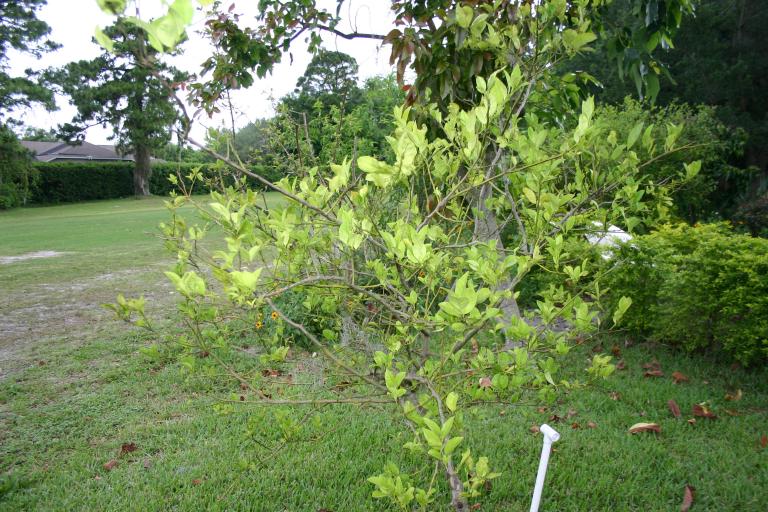
Above: The control Meyer Lemon as it looked on 4-19-15.
Above: Control Meyer Lemon on 3-14-16. Not much has changed except some die-back of limb terminals has taken place.
Larger orange tree on 4-18-15 before beginning treatments.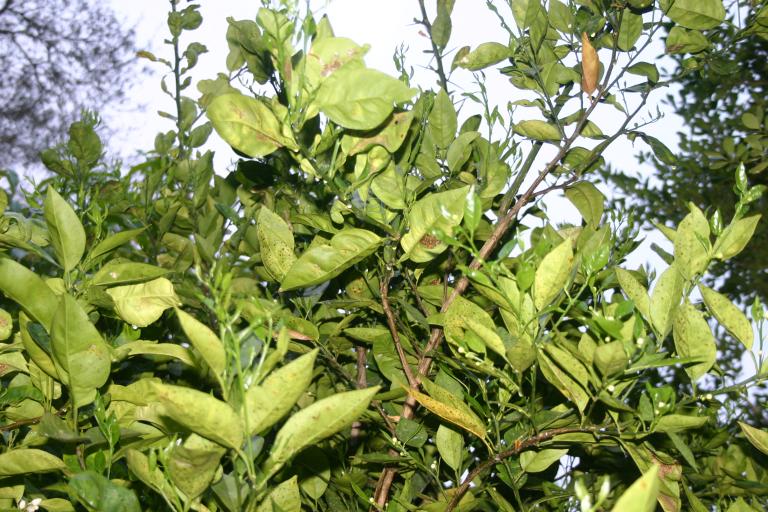
This year, it’s a whole new story. The same larger orange tree with healthy, dark green new growth emerging, after treatments were applied to the soil and foliage. Imagine how much better the tree will look in the middle of April, one year after the trial began. Photo taken on 3-14-16.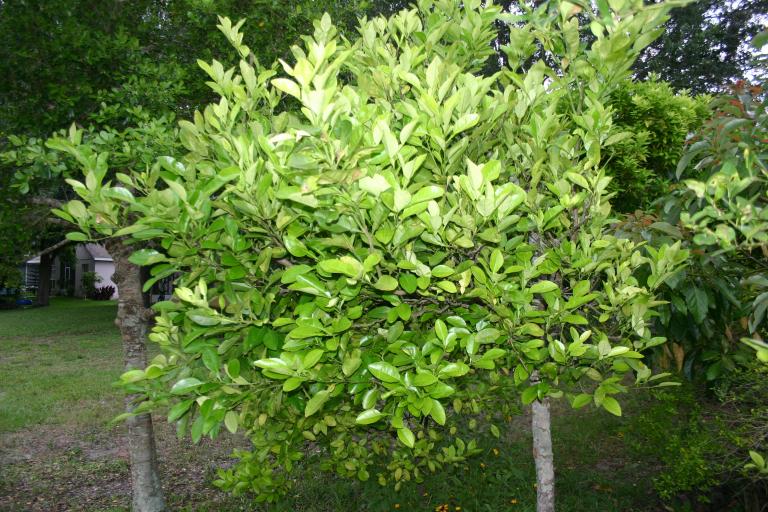
Grapefruit tree last year on 4-19-15.
Grapefruit tree after treatments. Photo taken 3-14-16.
White tangelo before treatments on 4-18-15.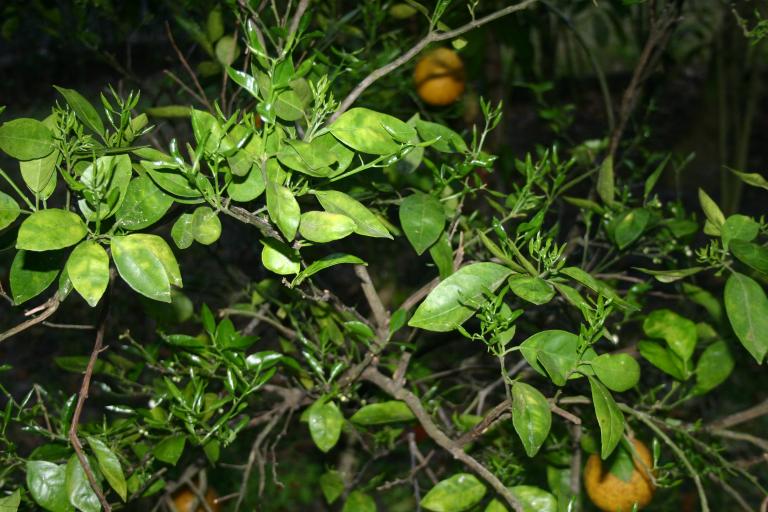
White tangelo after treatments showing recovery with a strong, dark green spring flush unlike last year. Photo taken 3-14-16.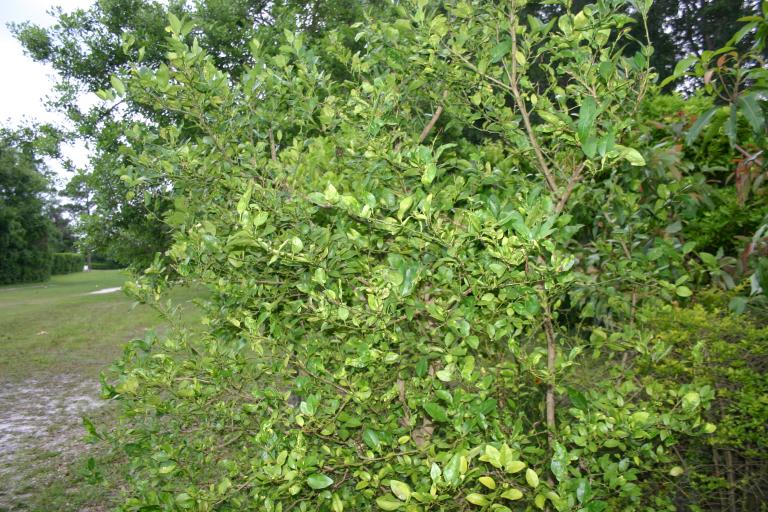
The Key Lime looked like this before treatments. Photo taken 4-19-15.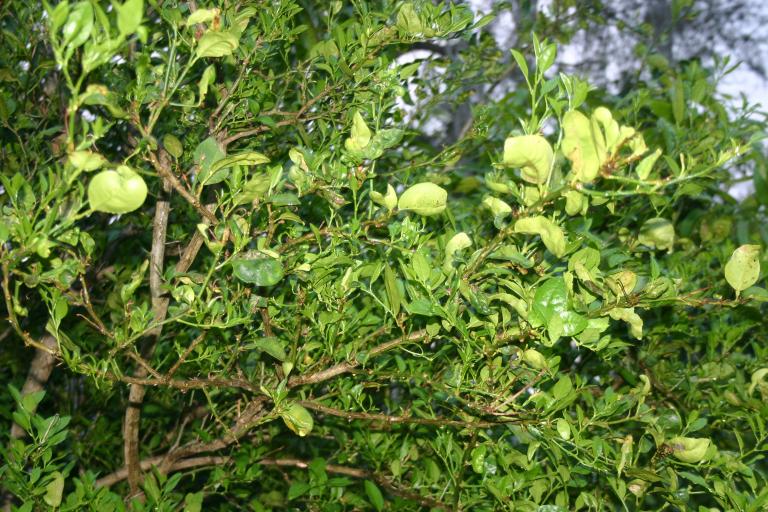
The Key Lime is coming out with healthy new growth on 3-19-16.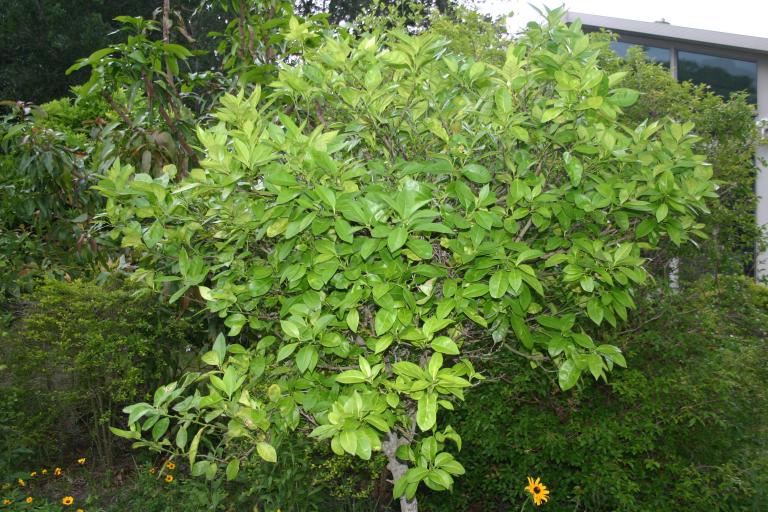
Smaller orange tree as it looked before treatments on 4-19-15.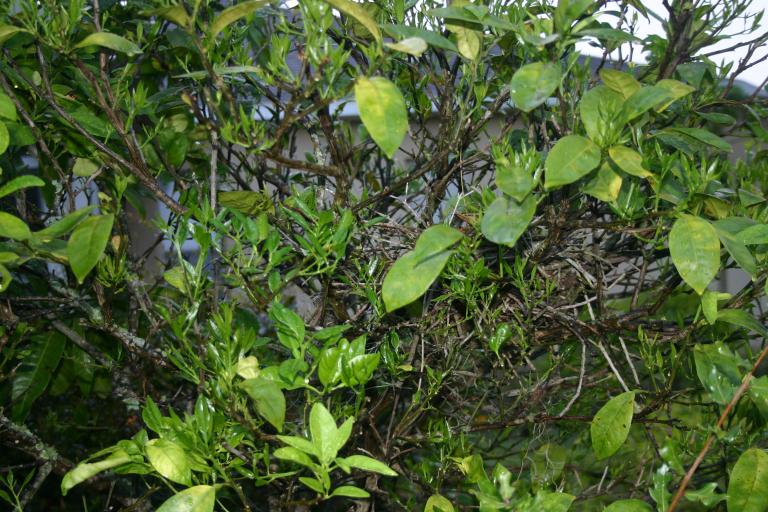
Smaller orange tree exploding with dark green, healthy new growth on 3-19-16.
Saturday, March 19, 2016
Spring officially starts tomorrow, so it is truly the time to plant and fertilize. We have the best selection of fruit trees and fruiting plants and the best fertilizers that we formulate to the highest standards. No one beats our quality because we use the best natural ingredients. We are open today, Saturday (and every day Monday through Saturday 8-5), so come on out and visit out beautiful fruit tree nursery and organic fertilizer store and garden center. You’ll really enjoy your visit!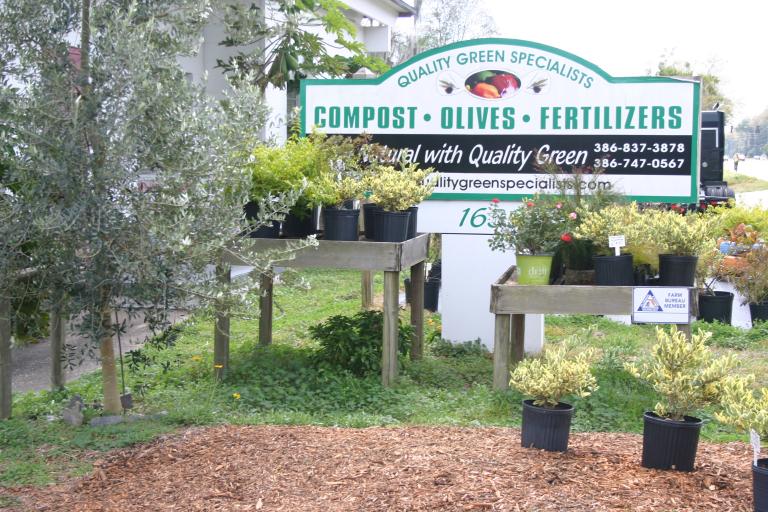
Look for our sign and beautiful display at 1639 N. Spring Garden Ave., DeLand 32720. Notice the Arbequina olive tree to the left of the sign.
Friday, March 18, 2016
Yes, we have Feijoa trees (they grow to 15′ tall). They are also called Pineapple Guavas. They have delicious, edible flowers and fruit and are cold-hardy to South Carolina. Here are images of the tree, the flowers, and fruit:
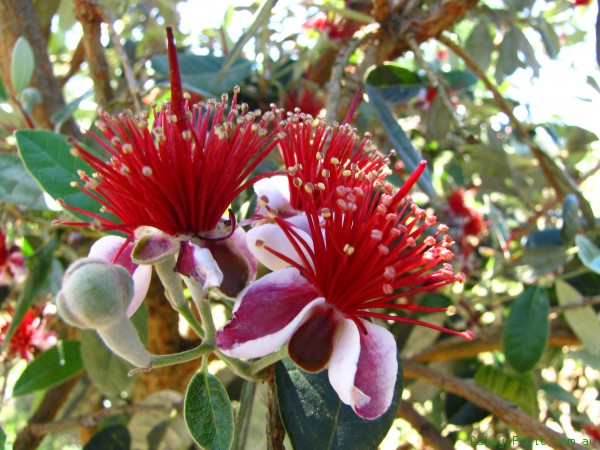

Be sure to stop by the Artisan Alley Farmers Market in downtown DeLand tonight from 6-9 p.m. I’ll have olive trees, tomato plants, pepper plants, carrots in 3 gallon containers, bunches of fresh carrots, fresh Chayote squash, papayas, and more. I’ll have my beautiful hand-carved walking canes. See you there! Artisan Alley is located 1/2 block west of the intersection of Woodland Ave. & New York Ave. behind the Beacon newspaper office. Artisan Alley is loads of fun!
Thursday, March 17, 2016
Here is a bookmark for listening to Quality Green Associate Alex Andrews live on Goliath Radio (AM 1380) every third Wednesday from 5:15 p.m. to 6:00 p.m. He makes being “green” and sustainable easy to understand. Open this website and you will be re-directed to a Listen Live Tab (twice as a tab on the upper right): http://www.goliathradio.com/level3/bigtalk.aspx
Call in to the show every third Wednesday for all your plant, agriculture, and green questions to Alex at 386-523-1380 (Big John Studio line).
Wednesday, March 16, 2016
Quality Green now has a nice selection of Dunstan Chestnuts, Grape vines, persimmons (including non-astringent Fuyu), Anna & Dorsett Apples, blueberries, and pineapple guavas/Feijoa (all cold hardy). Plus, dozens of other fruit trees & fruiting plants! Visit our nursery while the selection is best!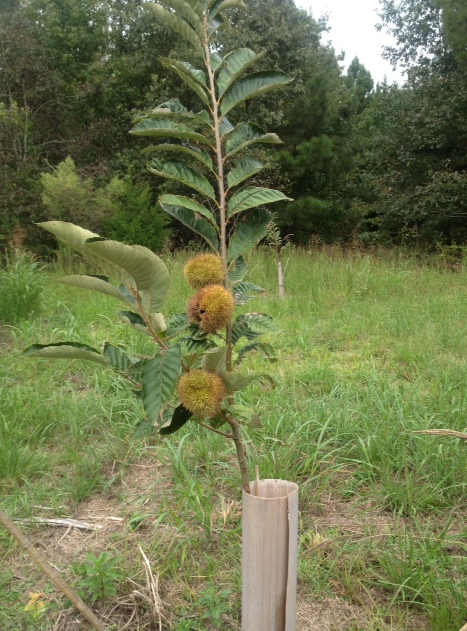
Dunstan Hybrid Chestnuts have been around for over 30 years and there have been no reports of their dying of blight infection! Plus, they perform exceedingly well in Florida.
The Fuyu non-astringent persimmon is an improved variety with three key qualities – it has no core, no seeds and no tannins (tannins make persimmons astringent). Fuyu persimmons have a flattened & rounded tomato-like shape and have an indented leaf at the stem end. The eating quality is outstanding.
Tuesday, March 15, 2016
My Citrus trees were beginning to show strong symptoms of HLB (Citrus Greening Disease), and so I fertilized them with our new CitrusPro dry granular fertilizer and sprayed them with our liquid Citra Thrive Plus. All the trees are now full of some of the best, dark green new growth I have ever seen. Obviously, the trees have by-passed any phloem blockage that may have existed in the trees, the roots have recovered, and are pushing strong, healthy new growth. Here are unretouched photos of five trees (the first photo is an orange tree; the second photo is a grapefruit tree):


Above: Healthy, dark green flush on a Key Lime tree.
Above: Super healthy new growth on a white tangelo tree with old leaves showing strong Greening symptoms.
Above: Another orange tree showing strong recovery including pin-head bloom.
Saturday, March 12, 2016
Yes, we are open today 8-5. Another hard-to-find small fruit tree great for Florida is the Surinam Cherry. Great for delicious red, cherry-like fruit and good for natural landscape plants as well. Yes, we have a nice selection, with some now in bloom.
Friday, March 11, 2016
Be sure to stop by the Artisan Alley Farmers Market in downtown DeLand tonight from 6-9 p.m. I’ll have olive trees, tomato plants, pepper plants, carrots in 3 gallon containers, bunches of fresh carrots, and fresh Chayote squash. I’ll also have my beautiful hand-carved walking canes. See you there! Artisan Alley is located 1/2 block west of the intersection of Woodland Ave. & New York Ave. behind the Beacon newspaper office. This places bustles with active people having lots of fun!
Yes, we have wildflowers adapted for central Florida. We have them at the nursery and will have them at the Florida Wildflower Festival on April 3, 2016. Choose from a blend of southeastern wildflowers, Rudbeckia, and Coreopsis.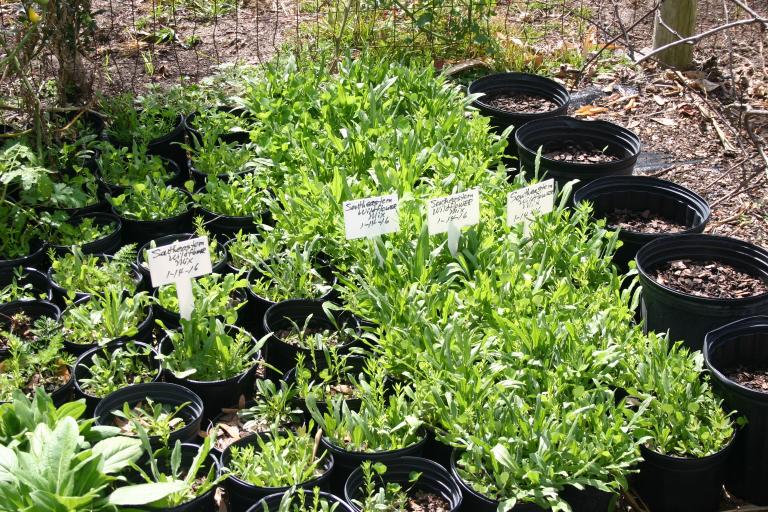
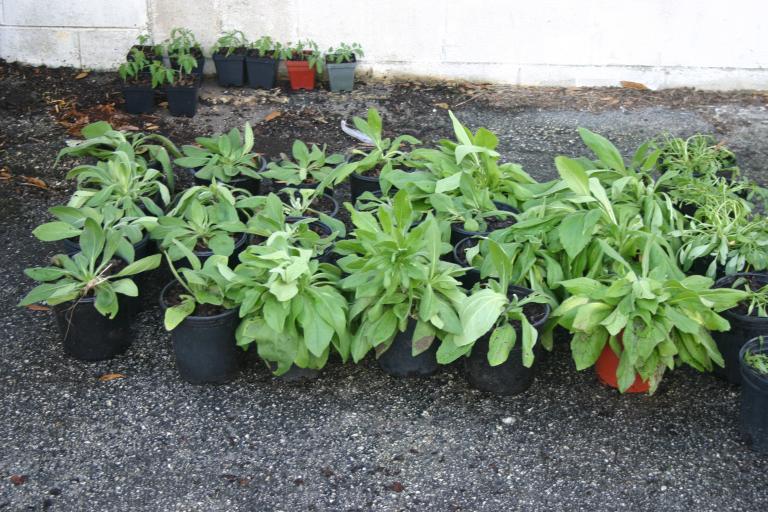
Above: Rudbeckia hirta (Black-eyed Susan)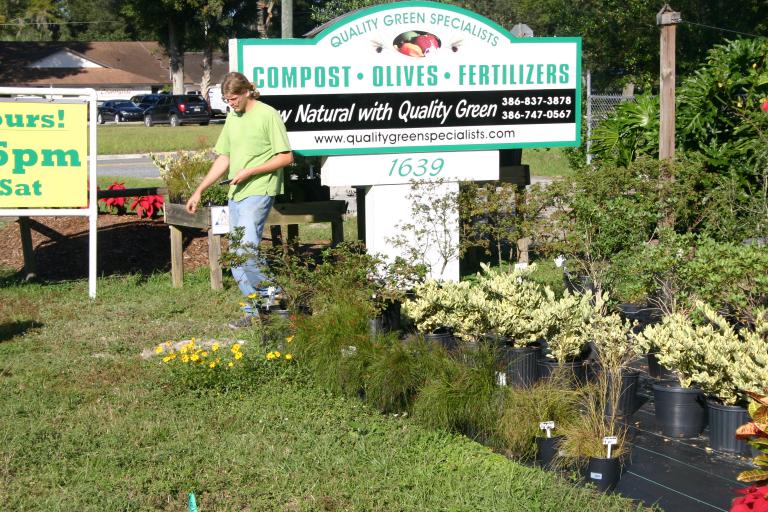
The native Florida Coreopsis has a beautiful, long-lasting yellow flower. Did you know that Coreopsis is the official Florida wildflower? Shown: Coreopsis grandiflora
Thursday, March 10, 2016
Olive groves are showing results in central Florida! Click on the following link for the latest good news regarding olive production in Florida: http://www.floridaolivecouncil.org/FOC/Publications_files/Fall_2015-fnl.pdf
Of particular interest is the installation of a big new olive press and bottling facility in Ocala, Florida. The olive mill was installed by Bill Dennis and Camila-Gonzalez at their Clear Creek Farm northwest of Ocala off Hwy 326. It is a top-line Pieralisi olive mill and will service many new growers in the area. The address is 9501 W. S.R. 326, Ocala.
Wednesday, March 9, 2016
Now ready: 4″ and 6″ assorted tomato plants ready to set in your garden! Also nice 6″ bell peppers, banana peppers, and jalapeno peppers.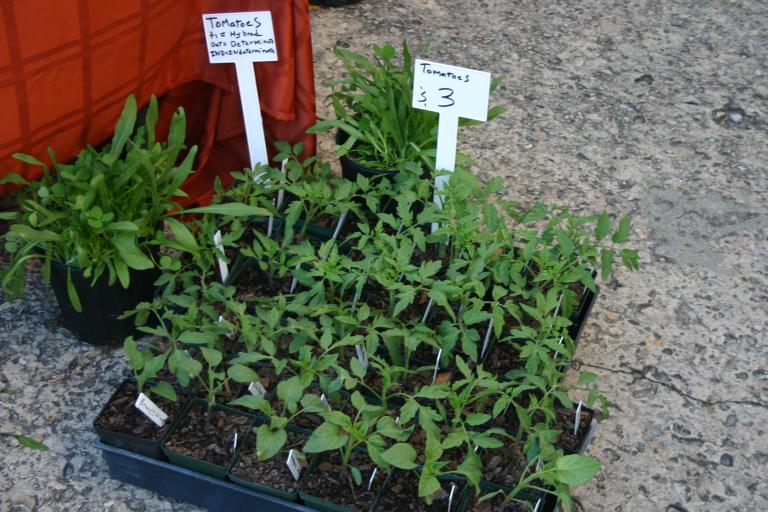
Monday, March 7, 2016
Yes, we are well stocked with avocadoes & we have the great Brazos Belle Avocado as well as other cold-hardy avocadoes. Brazos Belle has a medium to large, purple black (6-8oz) fruit and is extremely cold hardy down to 15 F! It has a rich nutty flavor. It survives and bears fruit as far north as Charleston South Carolina. It is self fertile and the fruit ripens July-August. Zones 8b-11. Yes, Dunstan Chestnuts are also now in stock. Come by and visit. I would love to see you.
Saturday, March 5, 2016
Here are photos of pinhead bloom just starting on the Arbequina olives at the nursery (photos taken March 4, 2016).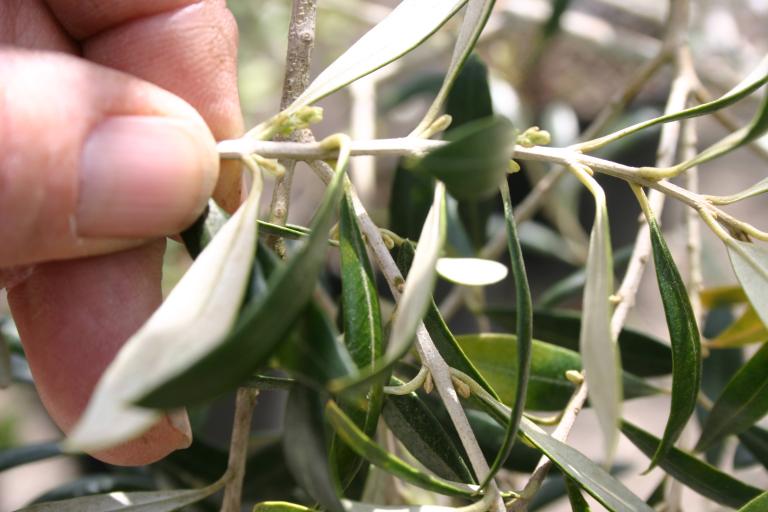

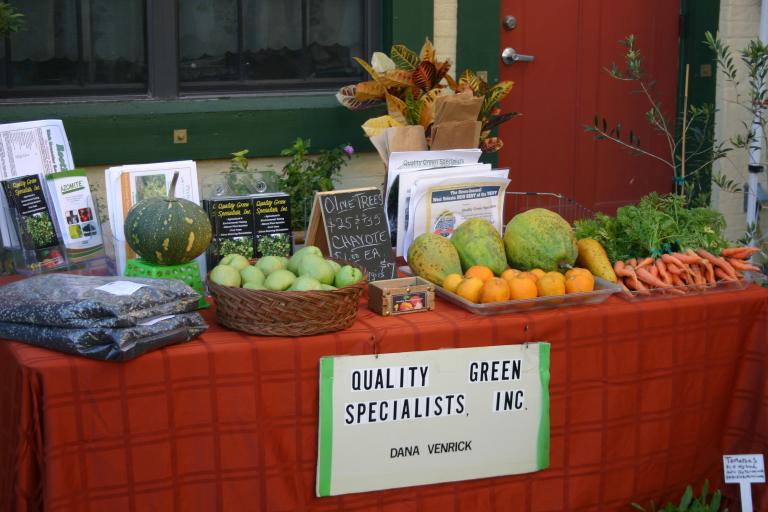
Above photo: Our produce and olive trees were looking good Friday night.
Friday, March 4, 2016
Yesterday (March 3), I saw the first pin-head bloom on the olive trees at Quality Green’s Nursery in DeLand. I will take photos today and post them on this page tomorrow so that you will know what to look for to find early bloom on your olive trees as well. If for some reason you don’t get bloom and fruit on your 3-year old or older olive trees in Florida, call me and I will tell you the simple procedures to make your trees bloom and bear fruit.
Like to have an enjoyable time this evening and every Friday evening? Well, come to the Artisan Alley Farmer’s Market in downtown DeLand tonight from 6-9 p.m. to enjoy meeting and greeting, special breads, olives, veggies, fruit, jams & jellies, candles, soaps, delicious hot food, great beverages and more. I’ll have olive trees, flats of tomato plants ready to put into the garden at exactly the right time, bunches of fresh carrots, pots full of healthy, delicious carrots ready to start pulling for dinner, tomato plants in flats, Chayote squash, and more. See you there!
Artisan Alley is located 1/2 block west of the main intersection in downtown DeLand (Woodland Blvd. & New York Ave.), behind the Beacon Newspaper office.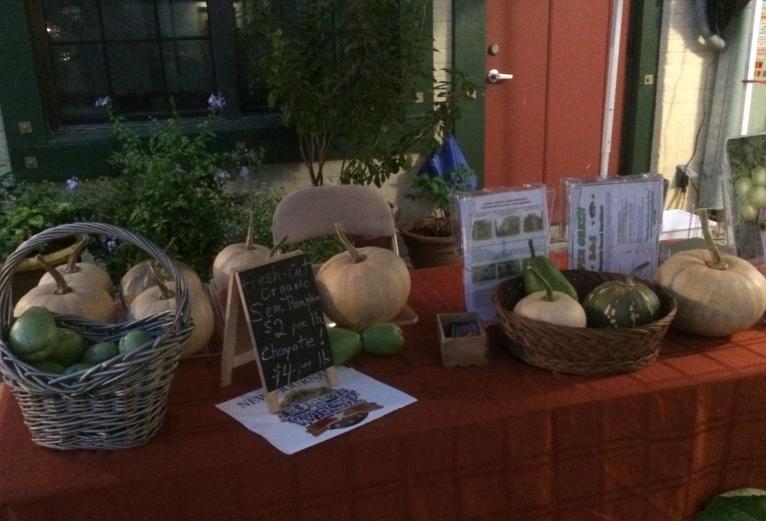
Also, be sure to visit out beautiful nursery soon. We have over 50 varieties of fruit trees and fruiting plants, as well as selected ornamentals & native plants. We are open 8-5 Monday through Saturday. Allen, David, Judy, or I look forward to seeing you today or tomorrow!
Thursday, March 3, 2016
Like to have an enjoyable time Friday evening? Well, come to the Artisan Alley Farmer’s Market in downtown DeLand tomorrow from 6-9 p.m. to enjoy meeting and greeting, special breads, olives, veggies, fruit, jams, candles, soaps, delicious hot food, great beverages and more. I’ll have olive trees, tomato plants in flats, Chayote squash, and more. See you there!
It’s March and its time to plant and fertilize. Try some of our organic and energized fertilizers designed with “Mother Nature” in mind and enhanced to take advantage of Mother Nature’s best secrets. Bio-available carbon, the most important element for plant growth (of more importance generally in order of: silicon, hydrogen, oxygen, potassium, nitrogen, phosphorus, calcium, magnesium, sulfur, and micronutrients) normally is a very long conversion process and is a low percentage of carbon materials in the soil.
Take decomposed vegetation that over many years becomes fine, powdery humus carbon/peat/humate materials before they harden into coal (and eventually into diamonds!). Well, we speed up the process of making nature’s incredible bio-available humate, fulvic acid, by adding an extra oxygen to each of the humate molecules to make a humate material, not with a small fraction of fulvic acid, but over 58% fulvic acid! It’s taking nature’s very slow decomposition process of making plant available humate (fulvic acid), where normally nature’s soft carbon products may contain around 10% fulvic acid, then super-charging the activity, taking the fulvic acid to over 58%!
What are some of the things can you expect from our energized, high fulvic acid products products? Well here are a few:
1) Nutrient uptake is increased from soil and foliar nutrients.
2) Plant metabolic activity is increased and nutrients are utilized more easily and effectively.
3) Chlorophyll production is increased.
4) Plant disease resistance is far better/plant systemic acquired resistance (SAR) is strongly boosted.
5) Nutrients move more readily within the plant overall and within plant cells.
6) Plants grow faster, have far better health, and higher production.
7) Free metals are complexed in plant cells for more complete utilization.
8) Enzyme activity is enhanced.
9) Plant tissue content of elements is increased to more favorable levels (e.g., calcium to 4.5% in Citrus leaves), documented to be of utmost importance, for example, in the remediation of HLB (Citrus Greening Disease).
Tuesday, March 1, 2016
Avocadoes are ready! Brazos Belle avocadoes are now ready at The Nursery for the spring as well as other cold-hardy avocadoes. Also now available are plums, Black Mission Figs, blueberries, fruiting Arbequina, Koroneikei & Arbosana olive trees, beautiful Citrus trees, persimmons, pears, mulberries, pomegranates (including the great cutivar called ‘Salavatsky”), papayas, peaches, nectarines, Moringa trees, cattlet guavas, pink guavas, white guavas, lots of tomato plants in flats, carrots ready to start pulling in 3 gallon containers, large pineapple plants, pecan trees, Cassava plants, mixed wildflower plants in gallon containers for planting in florida, and much more. Speaking of wildflowers, the Wildflower Festival is coming April 2 to DeLand on Indiana Avenue & the beautifully restored Athens Theater at the intersection of Indiana & Florida Avenues. Go to: http://mainstreetdeland.org/flwildflowerfest online for details.
Monday, February 29, 2016
It’s leap year and today is “Leap Day”. Quality Green is leaping forward with our Nursery and our “State of the Art” Plant Nutrition products employing the latest technology. The Citrus trees are looking great and the Olive trees will be blooming soon. Plus, we have 3 gallon pots full of carrots almost ready to pull!
Above: You talk about sweet, tender carrots – Bugs Bunny would love these! These are growing with our outstanding potting soil and our improved state of the art energized fertilizer. 
Above: The Citrus trees are looking great – and what a selection!
Above: Yes, we have lots of fruiting Arbequina olive trees as well as Arbosana & Koroneiki olives. Look for bud break and bloom soon!
Monday, February 22, 2016
Truly, Citrus tree root health has become a top priority in the all-out effort to stop Citrus Greening from devastating the Citrus industry. I would like to share the following that details the importance of soil health:
From: “Growers To Dig Deeper”: from Growing Produce, January 15, 2016
By: Frank Giles |
Why Are Soils Important?
- Soils are a key enabling resource for human well-being, central to the creation of a host of products and essential ecosystem services.
- Soils are the basis for the production of food, fibers, fuel, and medicinal products.
- Soils absorb, store, alter, purify, and release water, both for plant growth and water supply.
- Soils interact with the atmosphere through absorption and emission of gases (e.g., carbon dioxide, methane, water vapor) and dust.
- Soils make up the greatest pool of terrestrial organic carbon (more than double the organic carbon stored in vegetation).
- Soils regulate carbon, oxygen, and plant nutrient cycles (N, P, K, Ca, Mg, etc.).
- Soil is the habitat of numerous animals and organisms such as bacteria and fungi and thus sustain biological activity, diversity, and productivity.
- Soil is the habitat for seed dispersion and dissemination of the gene pool.
- Soils buffer, filter, and moderate the hydrological cycle.
Friday, February 19, 2016
Be sure to come by the Artisan Alley Farmer’s Market in downtown DeLand this evening from 6 p.m. until 9 p.m. Come early for the best selection! I’ll have Seminole pumpkins (it’s the famous Florida native that can be eaten like a pumpkin or a like a squash). Needless to say, they are absolutely delicious! Also, I’ll have fresh Chayote squash that Alex, David or I picked from our 15′ trellis. They look like an avocado, but they are a solid, meaty squash with a sweet, nut-like flavor. I’ll have potted Arbequina olive trees ready to bloom and set fruit. Plus, I’ll have potted greens and carrots, ready to harvest is a short time! By the way, Artisan Alley is located 1/2 block west of the main intersection in downtown DeLand (Woodland Blvd. & New York Ave.), behind the Beacon Newspaper office.
Also, be sure to visit out beautiful nursery soon. We have over 50 varieties of fruit trees and fruiting plants, as well as selected ornamentals & native plants. We are open 8-5 Monday through Saturday. Allen, David, Judy, or I look forward to seeing you today or tomorrow!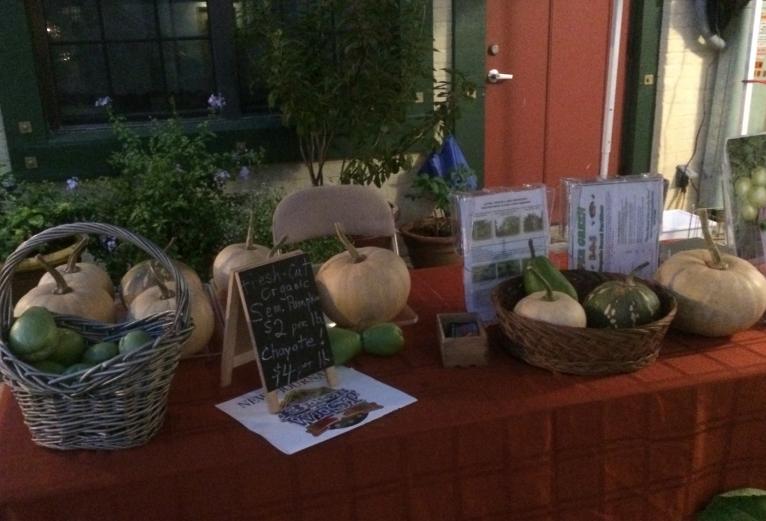
Tuesday, February 16, 2016
Here is an article from Florida Grower News, February 16, 2016, that mentions BioWash, a great product we include in our HLB remediating Citra Thrive Plus:
“Emphasis On Soil Health Moving Growers To Dig Deeper”By: Frank Giles |
Last year was designated the International Year of Soil by the Food and Agriculture Organization (FAO) to shine a light on the importance of soil quality in improving food security and resilience to floods and droughts. The educational outreach and events that made up the Year of Soil also aimed to educate that globally soil degradation is happening.
According to the FAO, studies show that about 33% of the world’s soils are facing moderate to severe degradation. Some studies indicate half of the topsoil on Earth has been lost in the past 150 years. The current rate of soil degradation threatens the capacity to meet the needs of future generations. Soil degradation comes in various forms, including erosion, salinization, nutrient depletion, loss of biodiversity, pollution, compaction, and loss of organic matter. Any one of these factors directly impacts the productivity of crops being grown on a particular piece of land.
In the U.S., modern agriculture has maintained the productivity of crops compared to other places in the world where newer technology and practices are not available. But, even here growers are realizing a more balanced approach and paying attention to soil health is important to the sustainability of agricultural lands.
Getting It Right
The use of fertilizers has helped keep yields up in Florida fields. But, there can be too much of a good thing. Overuse of fertilizer leads to soil and water contamination and a reduction in microbial activity.
The fertilizer industry and agricultural associations have done a good job promoting the 4Rs Nutrient Stewardship program to promote the correct application of nutrients. The four Rs include: The Right source (match fertilizer type to crop needs); Right rate (match the amount of fertilizer to crop needs); Right time (make nutrients available when crops need them); Right place (keep nutrients where the plants can use them).
The 4Rs program provides detailed training modules on how to implement the program on farms on its website. The experts who developed 4Rs note the program is not a single set of practices and reminds growers careful nutrient management must be accompanied by a package of other production and conservation techniques to be successful.
Fertilizer can increase yields as well as increase the nutrient density of crops. But, other factors can influence yield and quality. According to the International Plant Nutrition Institute (IPNI), the same can be said of the health of soils. Soil health depends on maintaining nutrient reserves as well as practicing soil conservation practices.
IPNI notes overemphasis on nutrient-use efficiency can lead to nutrient-depleted soils and lost productivity. Too much emphasis on productivity can lead to poor nutrient-use efficiency. The organization suggests following the 4Rs guidelines allows growers to balance the needs of nutrient-use efficiency and productivity.
A World Of Biodiversity
Soil is more than just a static substance that holds the roots of plants in place. Well-managed soils are teaming with life and activity. There are billions of microorganisms such as bacteria, fungi, and protozoans in the soil, as well as thousands of insects, mites, and worms. According to the FAO, 25% of the planet’s biodiversity is found in soils.
Many of these microorganisms have beneficial effects to plant health. Mycorrhizae fungi have long been associated with plant health. Dr. Jim Graham, a Professor of Soil Microbiology for UF/IFAS, has studied mycorrhizae in citrus. Graham published research on the benefits and interactions with pathogens of citrus mycorrhizae in the journal HortScience.
In the publication, Graham noted that mycorrhizae are the “normal” condition of roots on citrus trees and most other horticultural plants. However, he adds many “normal” horticultural practices such as the use of fertilizers and pesticides, soil sterilization, and plant production in sterile soilless media can reduce soil microorganisms. These technical advances have led to the rapid production of pathogen-free plants, but mycorrhizae have been sacrificed in the process. This may be especially true in citrus production today given all the actions take to fight HLB.
Graham goes on to note that growers should consider how to reintroduce mycorrhizae into soils given the demonstrated benefits.
The are a number of industry suppliers of soil supplements that contain mycorrhizae and other beneficial soil microorganisms. Florida-based companies include Pathway BioLogic; EcoMyc; Quantum Growth; Life Soils; and BioWash. [NOTE: BioWash100 is one of the key ingredients in our great Citra Thrive Plus 4-10-10 Liquid Citrus Greening Treatment.]
Monday, February 15, 2016
Quality Green’s Nursery & Fertilizer Store (with lots of quality minerals & organics) is open today and every day Monday through Saturday 8-5. Did you know that we carry over 70 products for commercial growers as well as home gardeners? Friday night’s display at the Artisan Alley Farmer’s Market received many compliments for its overall appearance and the nice selection of potted vegetables almost ready to harvest. Also nice were the fresh-picked Chayote squash and Seminole pumpkins we grew. “Grow Natural With Quality Green”.
Also, notice my hand-made walking canes and little Thor as my “watch-dog”.
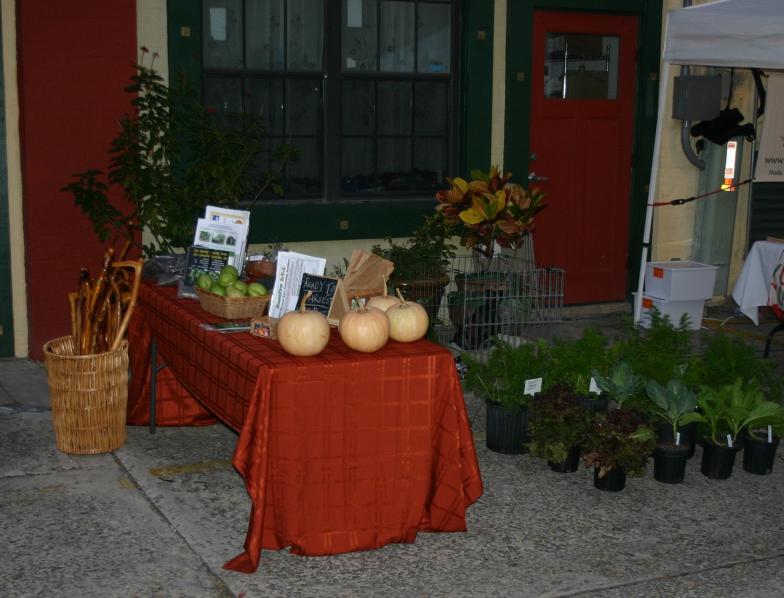

Many customers were curious about our company and our unique products.
Friday, February 12, 2016
Be sure to come by the Artisan Alley Farmer’s Market in downtown DeLand this evening from 6 p.m. until 9 p.m. Come early for the best selection! I’ll have Seminole pumpkins (it’s the famous Florida native that can be eaten like a pumpkin or a like a squash). Needless to say, they are absolutely delicious! Also, I’ll have fresh Chayote squash that Alex, David or I picked from our 15′ trellis. They look like an avocado, but they are a solid, meaty squash with a sweet, nut-like flavor. Plus, I’ll have potted greens and carrots, ready to harvest is a short time! By the way, Artisan Alley is located 1/2 block west of the main intersection in downtown DeLand (Woodland Blvd. & New York Ave.), behind the Beacon Newspaper office.
Also, be sure to visit out beautiful nursery soon. We have over 50 varieties of fruit trees and fruiting plants, as well as selected ornamentals & native plants. We are open 8-5 Monday through Saturday.
Wednesday, February 3, 2016
Dr. Jim Graham presented guidelines for promoting calcium and magnesium uptake from the soil at last week’s Florida Citrus Show. Calcium (Ca) & magnesium (Mg) are the two minerals that drop the most in the tissue of HLB infected Citrus trees. Calcium may be high in the soil, but low in the tissue. A critically important goal is to get the tissue level of Ca up close to 4.5%.
First of all, the pH must not be over 6.5 and bicarbonates must not be over 100 ppm. If these adverse conditions exist, Ca uptake is reduced as well as Mg, potassium (K), and iron (Fe) uptake.
Soil pH and minerals should be checked in the irrigation wetted zone. pH may be reduced with N-phuric or sulfuric acid. As an example, trees with 3.3% Ca in the leaf tissue were promoted to 4.5% with 3.0 gallons per acre per season of N-phuric acid. Another way is to use sulfur, e.g., 150 pounds per acre (lbs/ac) of prilled Tiger 90 sulfur. We think that a better way is to use sulfate forms of minerals along with needed potassium and magnesium, plus gypsum (calcium sulfate) which releases calcium and magnesium into the soil water for greater uptake driving leaf tissues up to desired, higher levels.
There are three ways to elevate Ca in the tree tissues and fruit. The most expensive way is by using calcium nitrate. An inexpensive way is to use calcium sulfate [if the base saturation of Ca in the soil is less than 60%] at the rate of one ton per acre in two applications per year of 500 lbs/ac each time. A cheaper way is to use dolomite (calcium magnesium carbonate) if the pH is less than 6.0 and the bicarbonates are less than 100 ppm. Don’t put too much! I recommend the use of no more than 1/2 ton yearly when soil testing indicates a need. Please note: gypsum may be used when potassium and magnesium are applied. Also, some some ammonium sulfate may be used when applying potassium as it makes potassium available. Call me for more details.
For best results to lower pH and increase calcium & magnesium in the tissue, about 50% of the inputs should be dry & 50% should be liquid.
Saturday, January 30, 2016
The Florida Citrus Show in Ft. Pierce was a valuable event for Quality Green Specialists. Allen Day and I talked with a many current & prospective customers. We told the remarkable stsory of how we are bringing Citrus groves back a a healthy condition with nice profits for the growers. The reception we received was quite positive and our booth was one of the most eye-catching. See for yourself: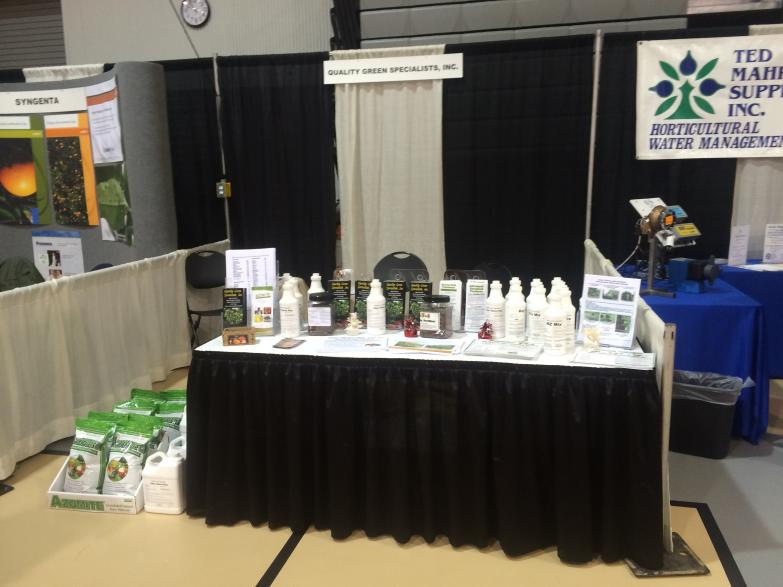

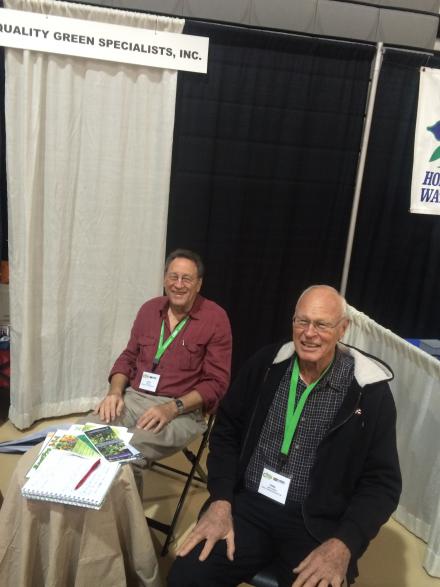
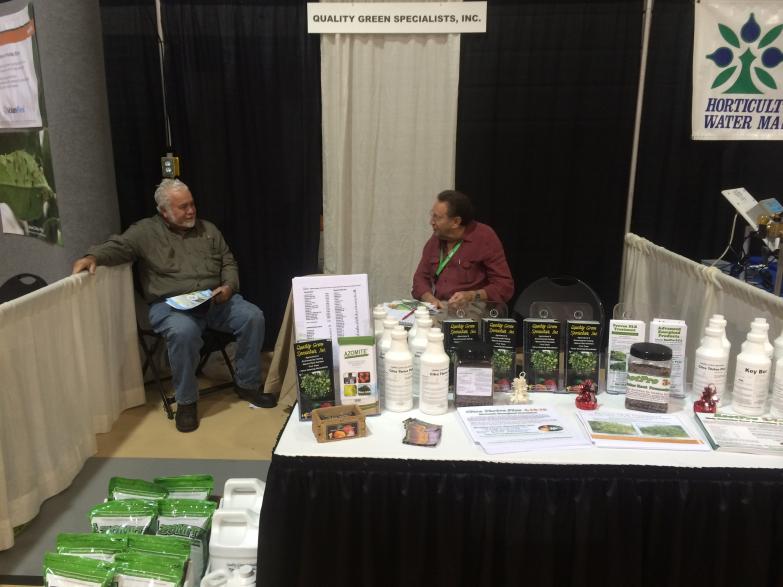
Be sure to go to the “Citrus Greening Answers” page of our web site to learn how we are achieving breakthroughs in the treatment of Citrus Greening (HLB). Our programs are the result of hard work to include standard soil testing, saturated paste analysis, and leaf tissue analysis along with our research-based energized nutritional & remedial treatments. Please go to: https://qualitygreenspecialists.com/index.php?p=1_43_Citrus-Greening-Answers to see how we are achieving dramatic Citrus grove recoveries to good health, higher production, and more pound solids with our programs.
Monday, January 25, 2016
Allen and I are getting ready for the Florida Citrus Show in Ft. Pierce Wednesday and Thursday, January 27th & 28th. The Show will be held in Ft. Pierce at the Fenn Center. Be sure to read the January 23rd post for information and how to register free of charge. Look to see you at the Show! Alex will be at the Nursery along with assistance to keep the Store and Nursery open as usual 8-5.
Last week Allen and I visited three olive groves that Quality Green helped to start. All three harvested olives in 2015 and all three growers are following our recommendations regarding cultural practices and fertilization. Scroll down to see photos and information about the groves. Then scroll on down to find more information about growing olives. Click on the Olive tabs on the left for all the information you need regarding the growing of bearing olives trees and how to make valuable (and super healthful) olive leaf extract.
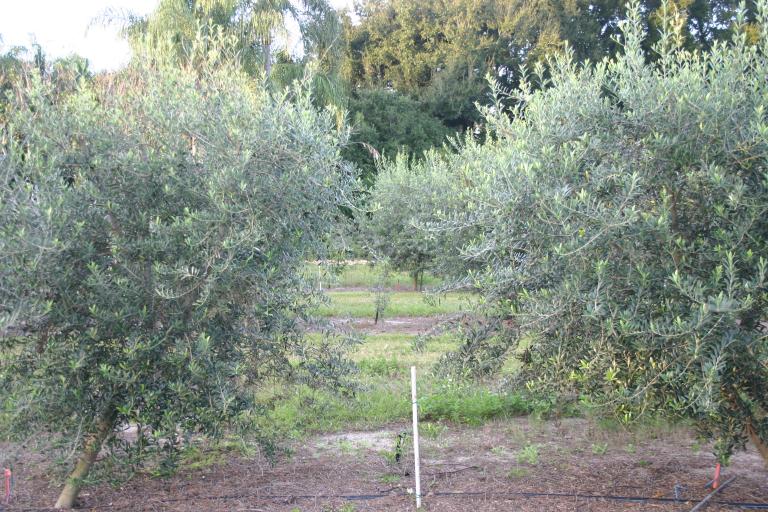
The olive grove in Winter Haven owned by Steve Oliva is looking terrific.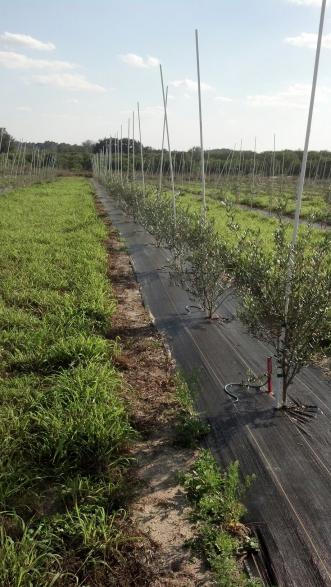
Jim Tschida’s grove in Haines City, Florida two years ago. The grove was first planted in early 2013 with a follow-up planting of additional trees in 2014. Photo taken in 2014.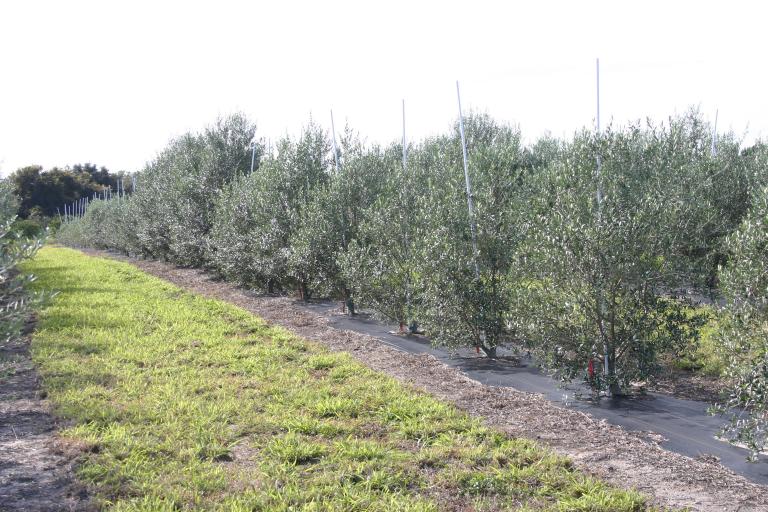
Jim Tschida’s grove as of January 20, 2016. Some trees are two years old. Others are three years old. The key secrets: our soil testing & leaf tissue analysis, lots of dolomitic limestone with a resulting alkaline pH between 7.2 – 7.5, low nitrogen, high potassium, Azomite® (O.M.R.I. listed organic volcanic pumice) with 65% available silicon dioxide, amino acids/seaweed (Ascophyllum odosum), no fertilizer between July and January. Liquid amino acids & seaweed and our 3-0-5 Fertilizer in January, April, and June (based on 50 pounds total per season of nitrogen per acre of rooting area); mild pruning through year 2 or 3 (depending on how big they have grown), then hard pruning of every other branch or every other side of the tree year to year to 12-18″ stubs about the first of September or right after picking the olive fruit, along with topping the trees to 9′ tall; (Fruit is produced on the previous season’s new growth.) skirting to 18″ of bare trunk in year 3 or 4; calling and talking with me at 386-837-3878. Please click on the “Olive Production” tab or click here: https://qualitygreenspecialists.com/index.php?p=1_13_Olive-Production for more photos and information.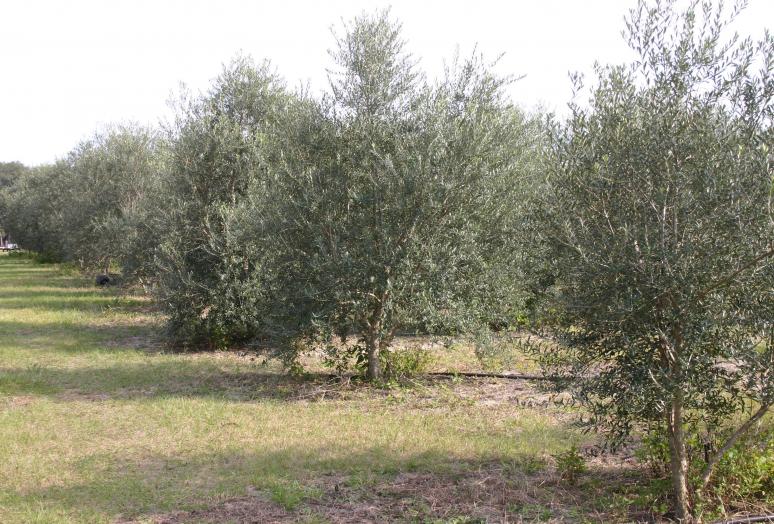
Above: Dr. Michael McDonough’s grove in Pierson, Florida is looking great. Last year he had his olives pressed for oil in Georgia. Now there are olive presses/mills much closer in Florida, e.g. Clear Creek in Ocala. The trees are receiving volcanic minerals this month. Note that the trees are ready for hard pruning this year to make them more productive. Photo taken January 21, 2016.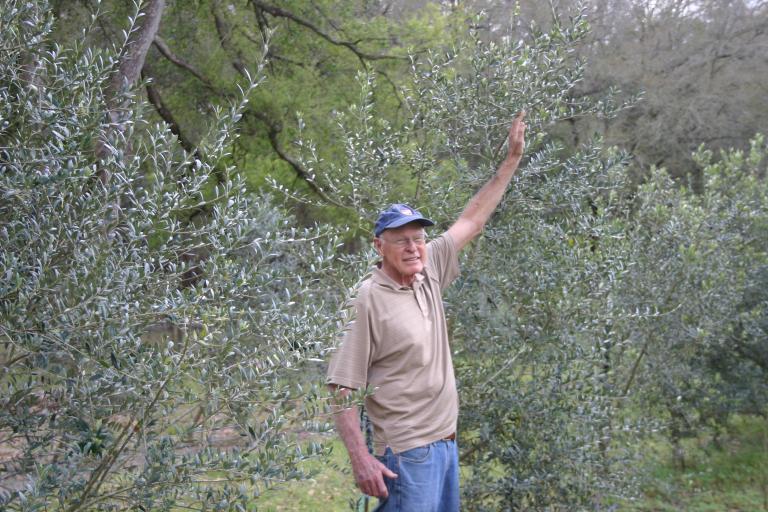
Another olive grove following Quality Green’s cultural recommendations: John Fall’s olive grove in Dade City. Shown is Dana Venrick.
Saturday, January 23, 2016.
Attention Citrus growers concerned with HLB/Citrus Greening and survival of your grove: Quality Green Specialists will have a display booth at the Florida Citrus Show to be held the Fenn Center in Ft. Pierce, Florida next week. We will be sharing our success stories, telling why our soil and leaf tissue testing is the most complete, and showing our great line-up of products to include our improved energized Citra Thrive Plus and our new energized granular RootPro 3-7-4. We will also share how we custom-blend the best fertilizer possible for each grove – without fillers or sludge – based on our comprehensive testing. The show is Wednesday, January 27 & Thursday, January 28. Registration is free for growers and you will find us (Allen Day & Dana Venrick) at Booth # 96. For more information and to register for the Florida Citrus Show, go to: (http://www.cvent.com/events/2016-florida-citrus-show/event-summary-70bdfb9f3c57446788430d3bf9f3bf01.aspx)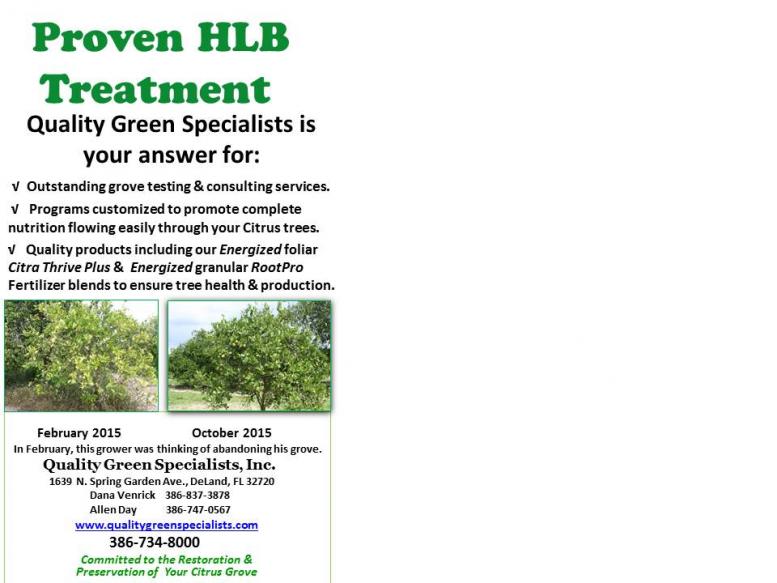
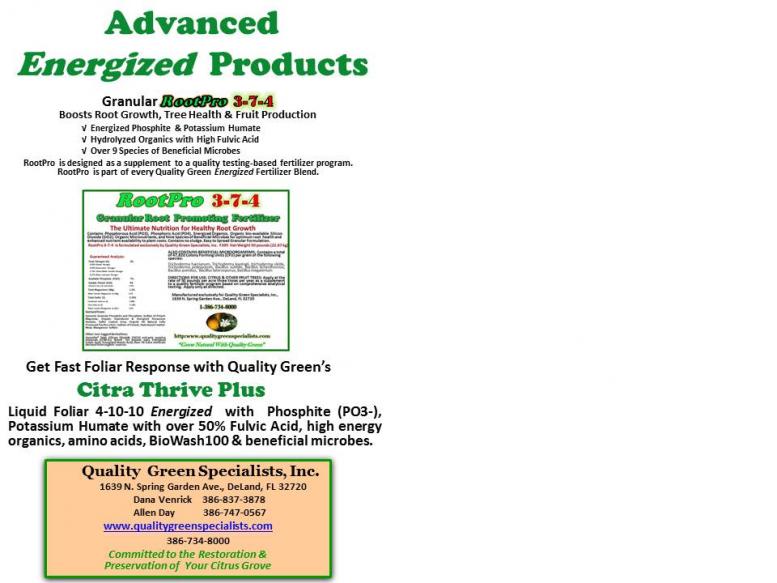

Saturday, January 16, 2016
I worked on the “Citrus Greening Answers” page of our web site to tell a better story of how we are achieving breakthroughs in the treatment of Citrus Greening. Our programs are the result of hard work to include standard soil testing, saturated paste analysis, and leaf tissue analysis along with our research-based nutritional treatments. Please go to: https://qualitygreenspecialists.com/index.php?p=1_43_Citrus-Greening-Answers to see how we are achieving dramatic Citrus grove recovery with our programs.
Friday, January 15, 2016
We have the comprehensive testing and advanced nutritional programs to bring your Citrus grove back to a more productive and profitable condition in spite of HLB. The results you can expect like R. Kelley last year: more production and higher pound solids! Plus, the cost per acre is surprisingly affordable. Give me a call at 386-837-3878 or Allen at 386-747-0567 for complete details about our HLB remediation program.
Wednesday, January 13, 2016
Another cool morning. Yesterday, Allen and I took soil and leaf tissue samples from a beautiful Citrus grove in Bowling Green where the owner used our dry fertilizer and liquid foliar program (based on testing) last year. The Valencia orange trees have a much bigger crop with good size fruit than they had the previous season and there is virtually no fruit drop! This year, he plans to follow our recommendations again. I am confident he will see even better results because our recommended inputs will be even better.
Attention Citrus growers and everyone who wants to grow or keep their Citrus trees: While at our store, try our new, even better ENERGIZED Citra Thrive Plus now with the humate portion energized (energizing results in an extra oxygen being added to the molecules) with over 50% fulvic acid! Now you can restore and/or maintain your Citrus trees in a state of health and productivity.
Yes, we improved our essential (to recovery from HLB) Citra Thrive Plus and also the dry, granular fertilizer inputs now will include 50 pounds per acre of our incredible new RootPro 3-7-4 root promoting fertilizer. Check out our label below. There is no other product like this!
Tuesday, January 12, 2016
Yes, it’s “winter” in Florida. The temperature will be in the upper 30’s in DeLand by early morning. Certainly not enough cold to be too concerned about. All the beautiful plants should be fine.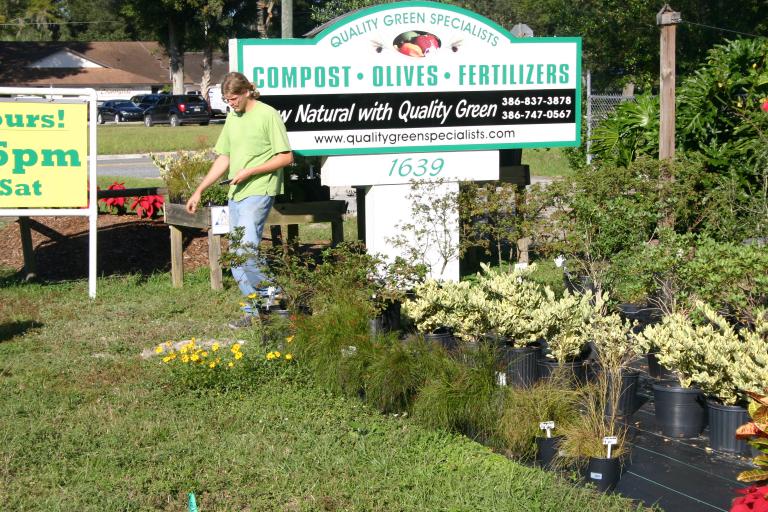
Above: Alex Andrews shown in the front display area with blooming Coreopsis grandiflora (Large yellow Tickseed) and all the other colorful plants that attract so much attention.
Monday, January 11, 2016
Just picked a pineapple I grew with our organic Super Green 3-0-5 Fertilizer. There were three slips at the base of the pineapple, so we can start four new plants between the slips and the pineapple top. Generally, plants from the slips grow out better than the crown of the pineapple. It is important to twist off the pineapple top from the fruit (this leaves no fleshy part attached) and let it dry for several days before planting or potting. Plant it at a shallow depth and place three small stakes to hold it in place until it roots. Pineapples root easily. In warmer climates like central Florida and south, pineapples make an interesting foundation planting for a landscape and you can enjoy picking pineapples year-round! And yes we sell large rooted pineapple plants in containers, grown in our own potting soil, to give you a head start.
Saturday, January 9, 2016
Our display and little puppy Thor (Torie) were a hit at yesterday evening’s display at Artisan Alley Farmers Market in downtown DeLand. The Market is held every Friday evening from 6-9.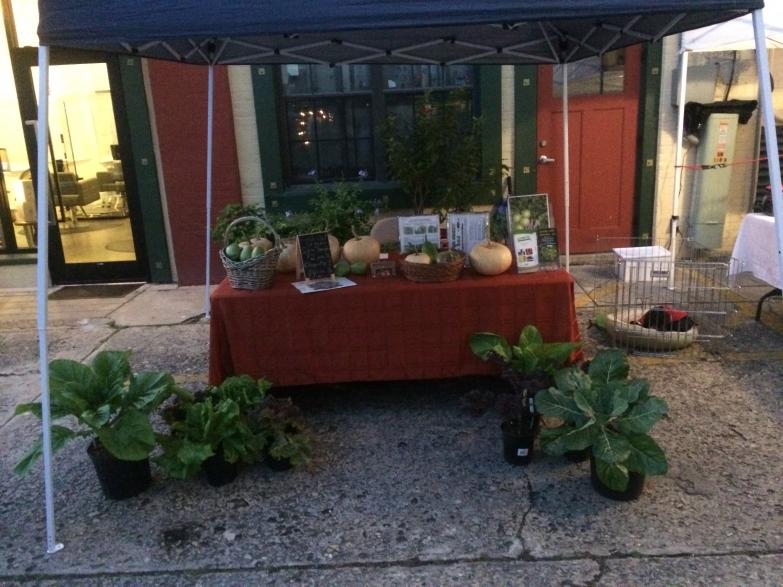
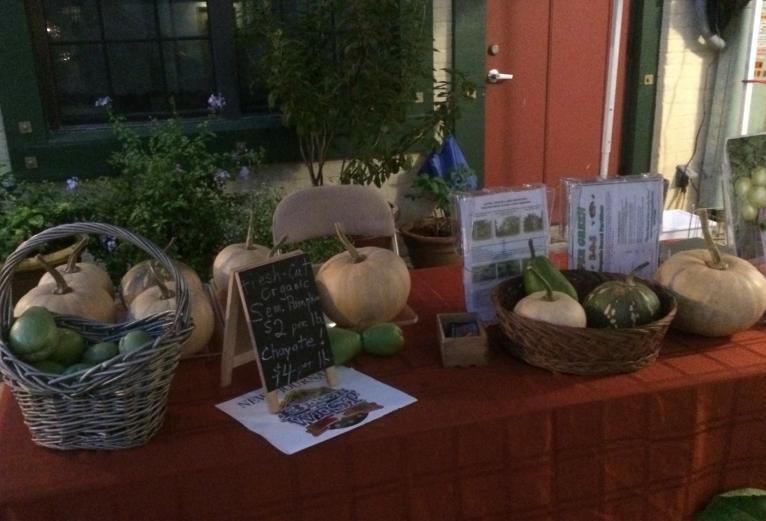
From a previous blog: Far more than HLB and the Liberobacter bacterium infection is going on with problems in Florida’s Citrus groves. In fact, trees could be set up for Greening disease because of poor cultural practices. Sound familiar? In the human intestinal tract and body, disease often occurs when a terrible diet or an extended time on antibiotics allow disease pathogens (e.g., E. coli bacteria) to gain the upper hand and outnumber the “good” intestinal bacteria and cause sickness. The same thing happens in Citrus trees. That’s why we put a large number of beneficial bacteria in our foliar Citra Thrive Plus and in our RootPro Fertilizer Blends and our Super Green 3-0-5 Fertilizer to suppress the Liberobacter bacterium that initiates HLB disease. And that is why if you use antibiotics on your trees that kill everything, you should also be using our liquid and dry fertilizer blends with “probiotics”. Believe me, you can’t eliminate all pathogens in the tree or the surrounding environment. In time, antibiotics weaken the trees defenses and resistance to the antibiotics develop (because a few pathogenic bacteria will survive the “kill all” antibiotics and then begin to dominate). Then trees are hit hard by HLB & other diseases without sufficient beneficial bacteria (and other beneficial microbes & natural antibiotics produced by the trees) to fight off not only HLB but a host of other resistant pathogenic microbes. I personally have known a number of people who were on an extended antibiotic regimen and then came down with an even more serious infection, such as the deadly C. difficile Colitis (C. diff), because the use of probiotics were not even considered.
Thursday, December 31, 2015
Happy New Year! This week while taking soil and leaf tissue samples in a Sunburst grove we found a few extremely distorted fruit. The fruit are green with bright orange vertical lesions!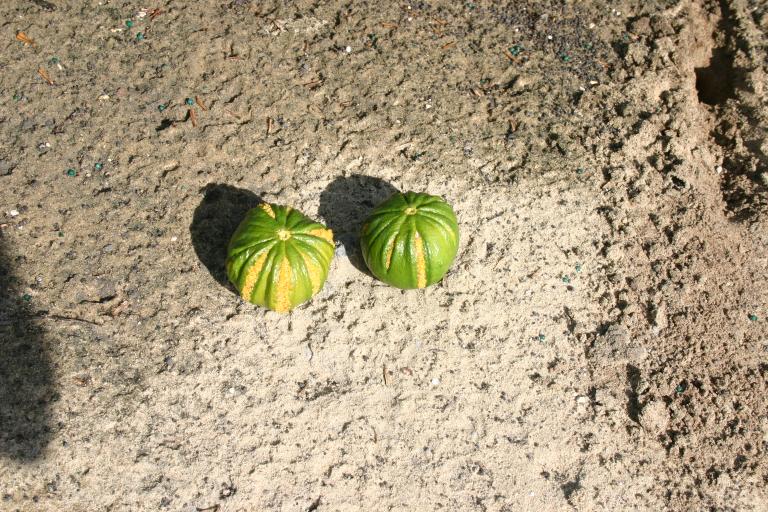
These are two of the distorted fruit. Notice the crusty soil. This grove is in serious need of remediation and is a serious challenge to rescue from years of amending the soil with “unbalanced” materials (too much iron and phosphorus from sludge and an extreme ratio of calcium to magnesium – far too much calcium and too little magnesium) that has left the soil with minerals tied-up, crusty, and low in organic matter and beneficial microbial life.
Monday, December 28, 2015
It is very gratifying to receive a testimonial like the one I received today from J. Falls:
“Dana,
Since your visit in April 2015 to take samples for testing and the recommendations you gave based on the results. My trees have responded better than I imagined they could in such a short time. The older trees have had more growth than ever and the young trees have at least doubled in size. I can hardly wait for spring to see how they do this year. See you soon for this year’s testing.
Thanks for the excellent service.
J. Falls”
Thank you and I look forward to seeing the olive trees soon!
Thursday, December 24, 2015
Want a Christmas gift to last a life-time and have delicious fruit to enjoy as well? Look no further than Quality Green for fruit trees and fruiting plants everyone will love, including Santa!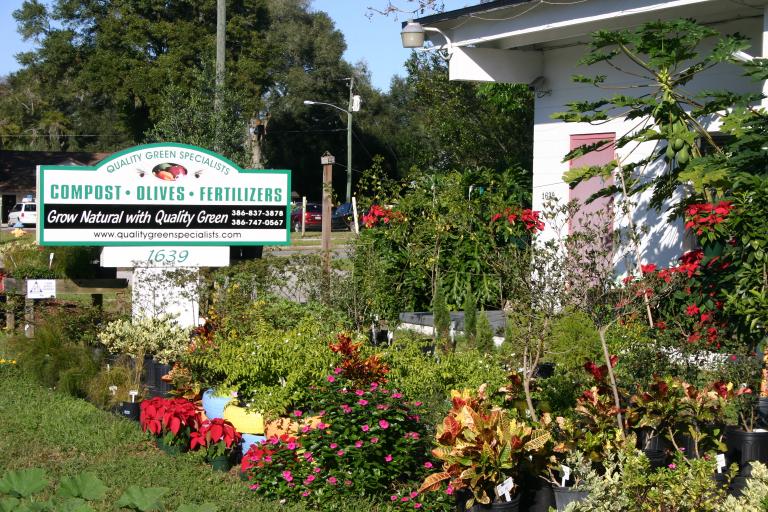
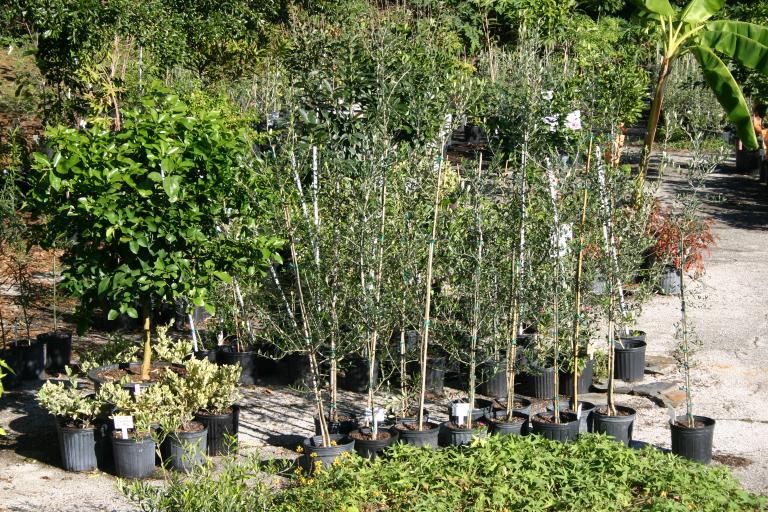
Yes, we have fancy 3 gallon and larger fruiting Arbequina olive trees.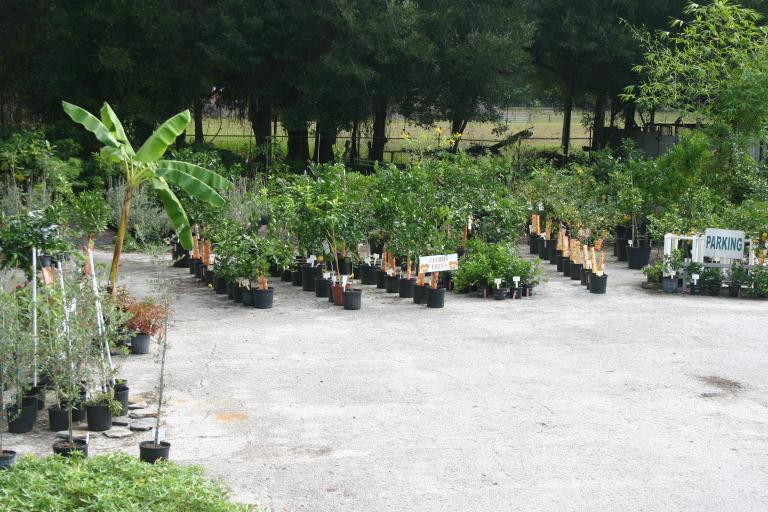
Yes, we have a great selection of Citrus trees and so much more!
Tuesday, December 22, 2015
Merry Christmas! We have Santa’s best selection of fruit trees for gifting or for planting for your own special Christmas. And, yes we do have gift cards. These are just a few of our fruiting trees on the south side of The Nursery:
Arbequina Olive Trees, beautiful red Poinsettias (lots more in front), papayas, and elderberries.
Going toward the left, more Arbequina fruiting olive trees – then grape vines, pear trees, blueberry bushes, peach trees, nectarine trees, plum trees, and 25 varieties of Citrus trees.
Saturday, December 19. 2015
It’s Pruning Time for Florida Low-Chill Peaches (“Bearing trees can be pruned from late December to early January.”)
Pruning is necessary to form a well-shaped, strong tree and to maximize production of high-quality fruit. The predominant system in Florida is an open-center or open-vase system with three to five scaffolds covering 360°. When planted, trees can be cut back to a single stem 15–20 inches high. This encourages lateral branching and various shoots from which scaffold branches can be selected. If lateral branches have formed on the nursery tree, cut the laterals off nearly flush with the stem if they are within 12 inches of the soil line. If lateral branches have already formed in an appropriate location for scaffold development (see below), they can be left on and pruned back to 1–2 inches long or longer if desired. For trees planted in the autumn, select three or four evenly spaced, vigorous, wide-angled shoots to be the major scaffold branches between 10 and 20 inches from the soil surface. Remove or cut back other shoots and remove all low-growing suckers, including those from the rootstock when growth begins in February and March.
In the first winter after planting, cut back the main scaffold branches that developed during the previous growing season by approximately a third to allow lateral branches growing on the scaffold to spread. Water sprouts and limbs that are too low should also be removed. The height of limbs selected to be scaffolds affects the eventual height of the canopy from ground level; orchards in Florida are maintained at a height of about 8 feet. The tree canopy should be low enough to facilitate fruit harvest from ground level but high enough for management practices, such as weed management, fertilization, and irrigation line maintenance. Continue this training procedure for the second and third winters. Bearing trees can be pruned in late December to early January. As the trees grow larger (3+ years), the main objectives of winter pruning are to remove overcrowded branches and water sprouts, and to head back terminal growth to prevent excessive tree vigor. This keeps the center of the tree open to allow sunlight to reach all parts of the tree. Take care to keep three to four short shoots in the center of the tree. This provides some shade to prevent the upper surfaces of scaffold limbs from getting sunburned and cracked. In order to reduce excess fruit load, fruiting laterals need to be thinned and renewed depending on vigor, flower bud set, and cultivar habits. To promote bud development lower on the tree and control tree height, top vigorous shoots and remove vigorous sprouts from the center of the tree in summer after harvest.
Pruning is a time-consuming, costly operation. Along with fruit thinning, it is one of the major production costs. Studies from other production areas have shown that 18–23 hours of labor per acre are required for pruning, and 21–35 hours are required for thinning heavy crops. Other studies have found that mechanical hedging, followed by some hand-detailed pruning, can cut pruning time in half.
From: Florida Subtropical Peaches, Publication # HS 1109, Production Practice, from University of Florida/EDIS, By M. Olmstead, J. Chaparro, J. G. Williamson, R. Rouse, R. Mizell, P. Harmon, and J. Ferguson
Thursday, December 17, 2015
Yes, we have low chill peach varieties developed by the University of Florida/IFAS. Two varieties, FL Prince and Tropic Beauty require only 150 chill units. These two varieties will bear fruit to south of Lake Okeechobee.
‘TropicBeauty’ is a non-patented cultivar released jointly by the University of Florida and Texas A&M in 1989. It requires a low 150 chill units and will bear as far south as Immokkolee. The medium-sized, semi-freestone fruit have yellow, melting flesh and develop 70% blush over a yellow ground color. ‘TropicBeauty’ has a FDP (fruit development period) of 89 days.
‘Tropic Beauty’ peach shown above.
‘Flordaprince’ requires 150 chill units. It was released by UF in 1982 and its fruit have melting flesh. It has been a standard low-chill peach cultivar worldwide and is one of the earliest ripening. The fruit develop 80% red blush with dark red stripes over a yellow ground color. ‘Flordaprince’ fruit are large, uniformly firm, and yellow, with semi-clingstone pits. The fruit ripen about 7–10 days earlier than ‘TropicBeauty’ in Gainesville, Florida with an FDP of 78 days.
Shown: ‘Flordaprince’ low chill peach.
Wednesday, December 16, 2015
We have more: how about a nice selection of blueberries and pomegranates to choose from:
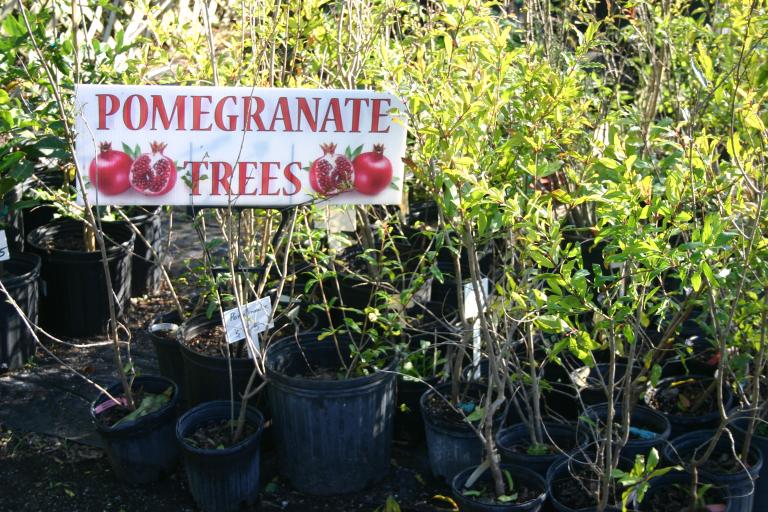
Tuesday, December 15, 2015
Today I have photos of our current inventory of stone fruit trees: Apples, Pears, Peaches, Plums, and Nectarines:
Above: Our apple tree section. Photo taken 12-11-15.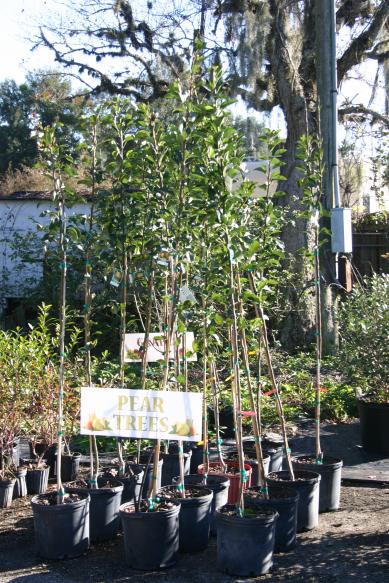
Above: Big Hood, Southern Home, and Pineapple Pear Trees. Photo taken 12-11-15.
Yes, we have a nice selection of peaches, nectarines, and plums bred for Florida conditions. Photo taken 12-11-15.
Sunday, December 13, 2015
Below is a picture of the first olives on a tree in Steve Oliva’s grove in Winter Haven in July, 2015. Below this photo are pictures taken on December 7, 2015 of Steve Oliva’s olive grove as it looks now. Quality Green Specialists planted the grove in the summer of 2013, converting a Citrus grove to Arbequina olives with Koroneiki & Arbosana pollinators. 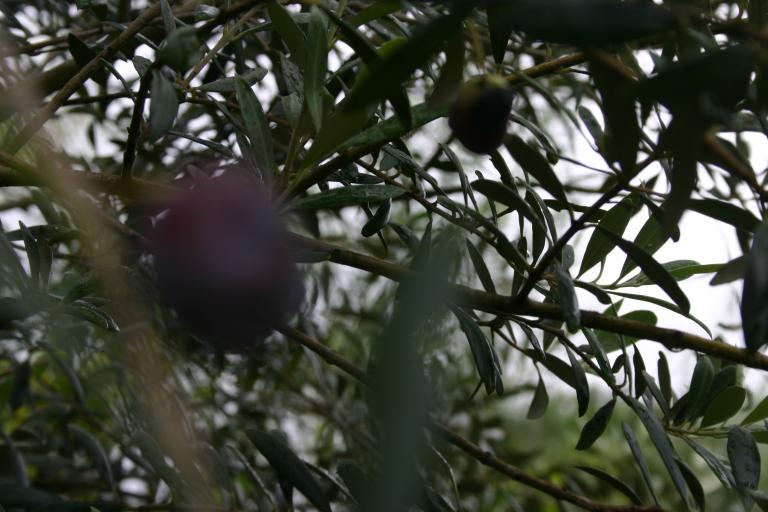
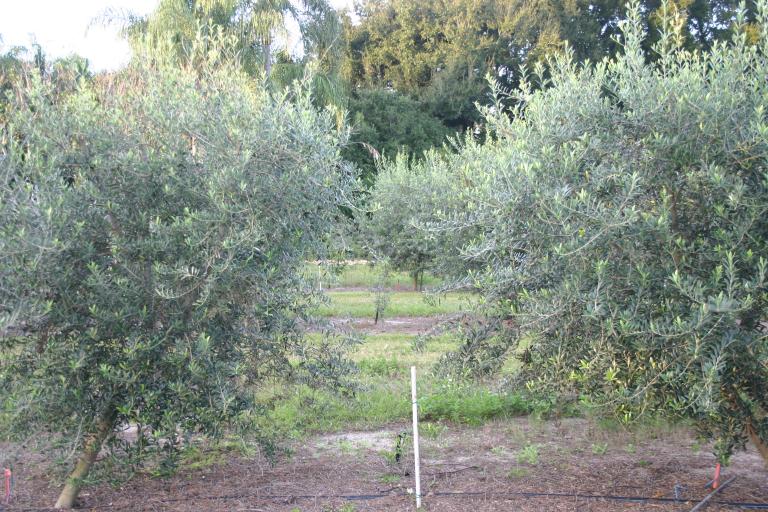
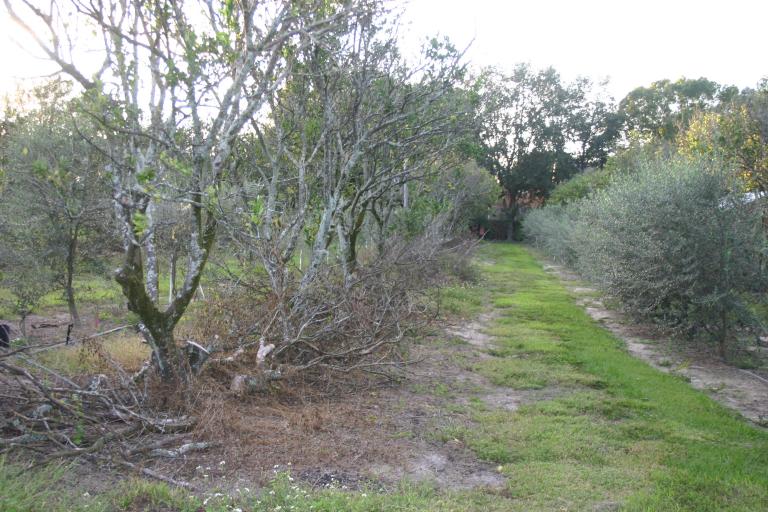
Steve is successfully converting his Citrus grove to an Arbequina olive grove.
A close-up of one of the olive trees we planted in 2013. The growth in 2 1/2 years is amazing!
Another row of olive trees in Steve Oliva’s grove.
Saturday, December 12, 2015
We are learning more and more about how to improve olive fruit production in Florida.
There are many factors from: 1) low fertilizer & low nitrogen rates 2) maximizing chill hour units to prevent the reversal of partial accumulation of chill induced compounds (mainly studied is the amino acid arginine) when the trees have only received part of the chill hours normally required for good bloom and fruit set. 3) The biggest factor is still irrigation. Research indicates that maximum production of bearing age trees is reached at about 500 gallons of water per tree (gty) per year (leveling off with additional water). However, maximum oil quality is reached at about 300 gty. Therefore, I am recommending keeping irrigation water somewhere in the range between 300-500 gty. Olive trees fruit the best when the trees are water stressed between irrigations to somewhere between 57% to 71% of the total Evapo-transpiration (ET) capacity of the tree. One estimate, based on experience in California, is to give olive trees between 1-2 gallons of water every other day. Another way to look at irrigation is that olive trees require up to 2/3 less water than Citrus trees. 4) Another big factor is targeted pruning. 5) Also very important in Florida is to make sure essential micronutrients are provided to the olive trees in our micronutrient depleted soils. We do that very successfully with Azomite® OMRI listed organic volcanic mineralizer. It works. Of course, use low nitrogen, 2x as much potassium as nitrogen, low phosphorus, and lots of extra calcium and magnesium to push soil alkalinity to around a pH of 7.5. And no nitrogen fertilizer between July and January. Be ready to use dry and liquid foliar fertilizer in early January! More on this in a later post…..
We have had blooms and fruit on trees we manage the last several years, so we must be doing something right. Olive trees love to grow big and bushy in Florida. They just need some basic management to make them bear consistently with a big crop. Shown: new flower breaks last February.
Friday, December 11, 2015
Come see our fresh stock of fruit trees, Ouachita blackberries, and Emerald blueberries. We have fresh pineapple, Hood, and Flordahome pears, Great Wall (astringent), Ichi (non-astringent), and Jiro (non-astringent) persimmons, Flordaglo & Flordaprince peaches, Sunmist nectarines, Tropic Sweet, Anna, and Dorsett apples (two are needed for cross pollinization), Salavatski, Christine, Eversweet, and Ambrosia pomegranates, and Stuart & Cape Fear Pecans (good for cross pollinization). Plus a huge inventory of other fruit trees and fruiting plants to include fruiting olives and Citrus.
Tuesday, December 8, 2015
Yes, we have nice 3 gallon size Elderberry plants for sale.
Elderberry (Sambucus, spp.) is a genus of flowering plants in the family Adoxaceae; it is sometimes called elder. The ripe, cooked berries (pulp & skin) of most species of Sambucus are edible. However, most uncooked berries and other parts of plants from this genus are poisonous. In 1984, a group of 25 people were sickened, apparently from elderberry juice pressed from fresh, uncooked Sambucus mexicana berries, leaves, and stems. However, all twenty-five recovered quickly, including one person who was hospitalized after drinking five glasses! Elderberry juice is often used to make wine and the flowers are delicious when dipped in tempura batter and fried. The berries are a very valuable food resource for many birds.
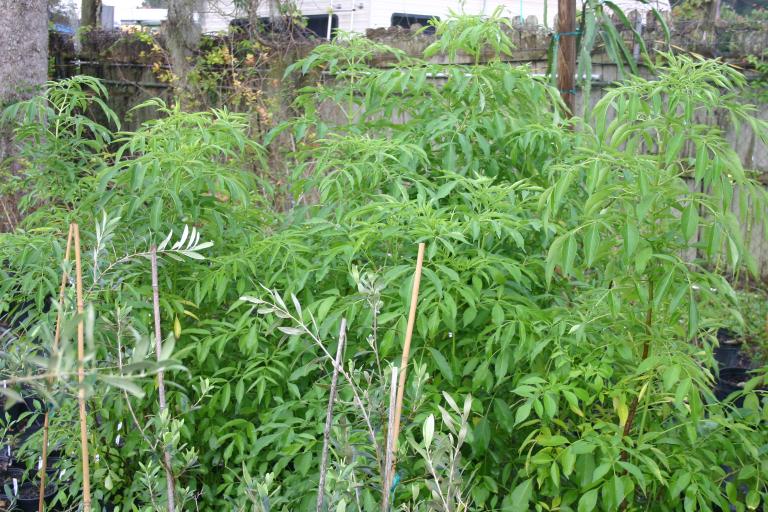
These 3 gallon Elderberry plants are super nice and ready for planting.
Visit us today for a beautiful botanical experience browsing through over 70 varieties of fruiting plants. Our Citrus tree section is exceptional and has most any variety you may like. Plus we have the expertise and products to keep your Citrus trees healthy and productive. Like our own custom-made dry fertilizers, Azomite® O.M.R.I. listed organic volcanic pumice, and our amazing liquid treatment we call Citra Thrive Plus to keep Citrus Greening (HLB) in check.
Monday, December 7, 2015
We are in the Holiday spirit! Come by for a personal tour and you will be in a joyful mood when you see our amazing selection of fruit trees, fruiting plants, cool weather vegetable plants, and others as well.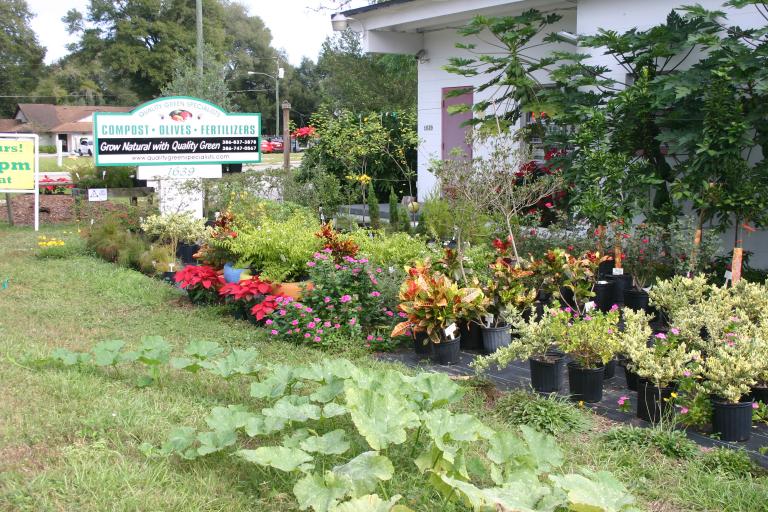
View of the front Nursery display driving north on Spring Garden Ave. (State Road 15A). Shown in the background is Greens Dairy Road and Countryside Animal Clinic. To enter the main Nursery, turn right on Greens Dairy Road, then take an immediate right into the Nursery to the parking area. You will find yourself surrounded by a world of plants. It’s a botanical world of fruiting plants, fruit trees and color.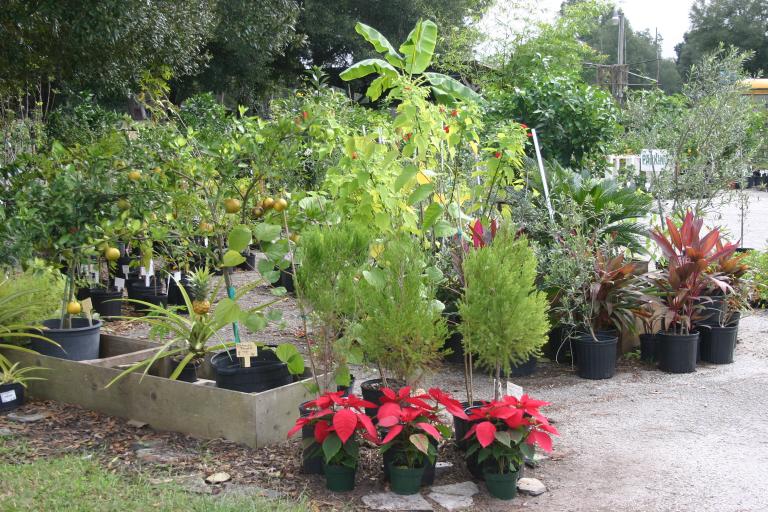
Your first view driving into the Nursery.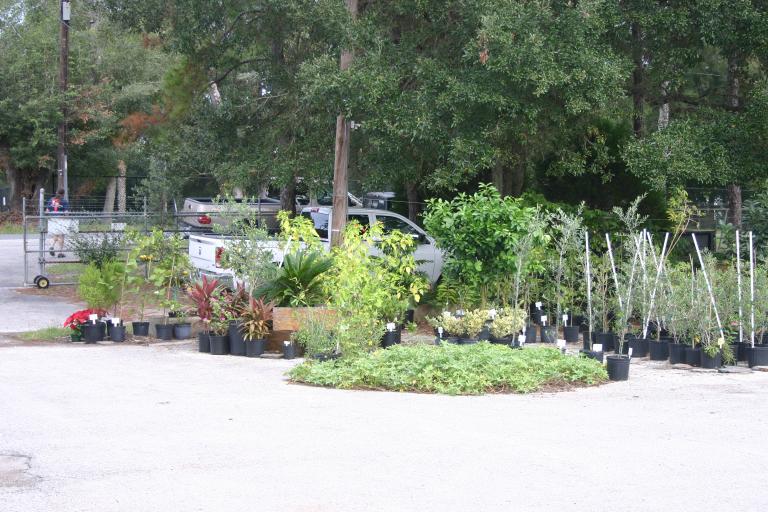
Your view to the left as you are entering the main parking lot.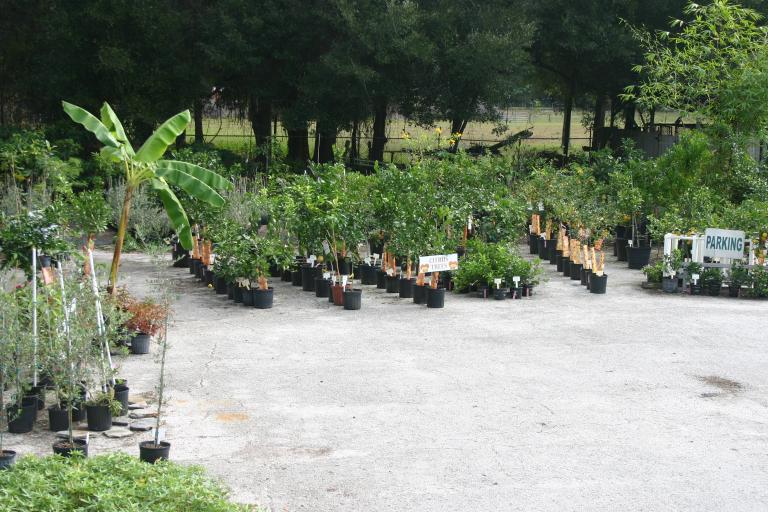
Your view to the front as you are parking. Notice the huge selection of Citrus to the front and olive trees to the left. (More olive trees are behind the Citrus and to the right.)
As you pull up to the PARKING sign, you will see lots of ripening fruit on the Citrus trees.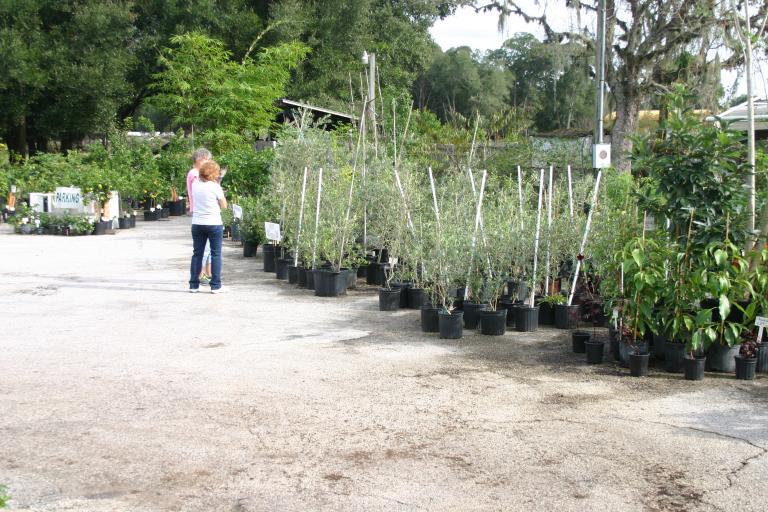
View to the front right side (looking northeast) as you are parking showing avocados, elderberries, blueberries, lots of Arbequina olives and Citrus to the front left.
View to the right (south) side showing papayas, moringa trees, olives, elderberries, Barbados cherries, blueberries, peaches, and more.
View farther to the right side (southwest section) displaying our large selection of cold hardy vegetables, guavas, papayas, and more.
Saturday, December 5, 2015
Christmas and all the other great Holidays of the season are coming soon and Quality Green Nursery is getting in the spirit!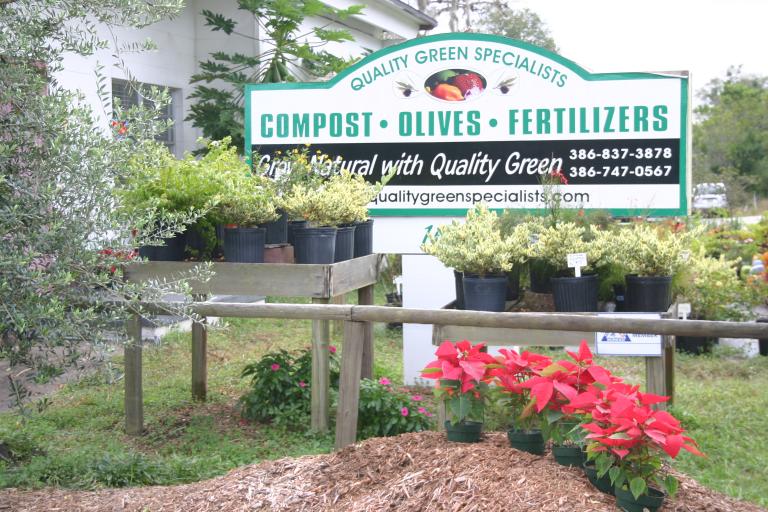
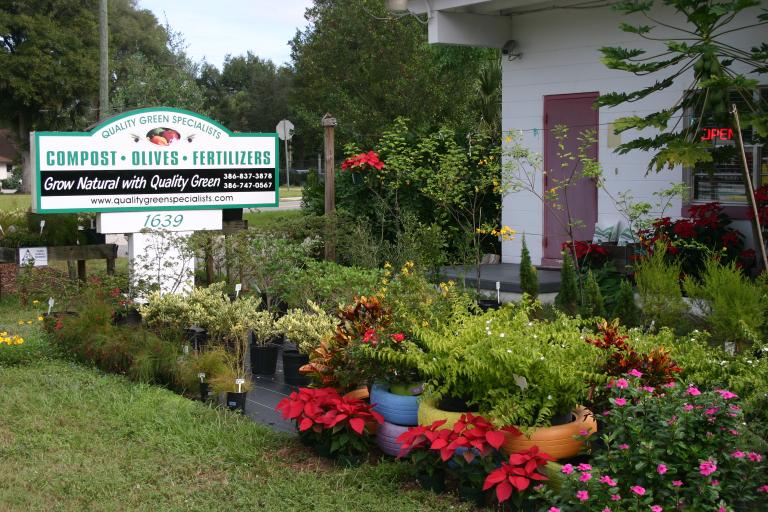

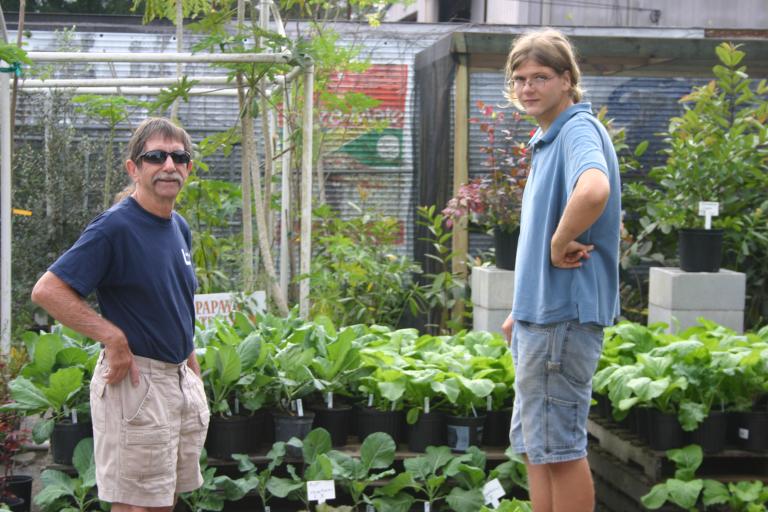
Alex Andrews with a customer showing our big selection of cold-hardy greens.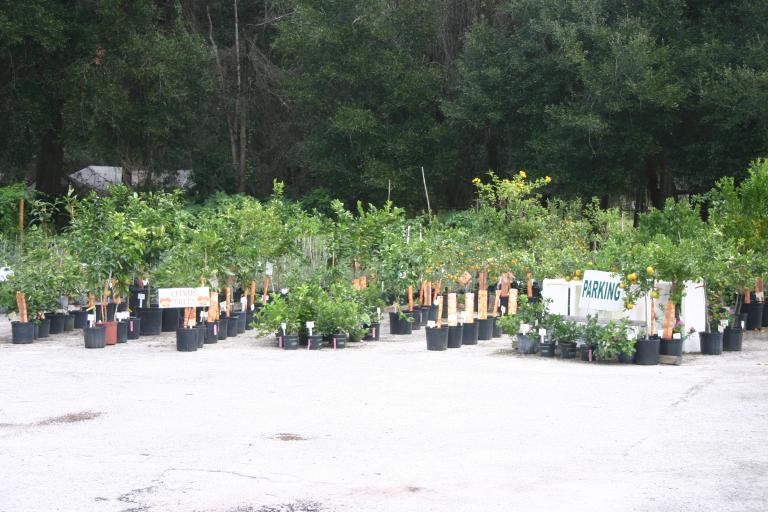
We have 25 varieties of beautiful, healthy Citrus & over 70 varieties of fruit trees and fruiting plants in all!
Friday, December 4, 2015
Come by and see what’s new at Quality Green in the way of plants and products. And come by the Artisan Alley Farmer’s Market this evening in downtown DeLand from 6-9 p.m. I’ll have okra, sweet potatoes, Seminole pumpkins, tangerines, and potted cool weather vegetable plants.
Also, today I was inspired to tell you about the importance of sustainable soil health through the promotion of carbon (organic matter) and good minerals at appropriately low levels:
Why Use Humic Acid/Humates?
Synthetic fertilizers and chemicals have depleted soil carbon on farms and in gardens. Sooner or later, growers must put carbon back into their agronomy practices in an efficient way, while reducing dependency on synthetics that deplete the soil. This is the way agriculture becomes sustainable; otherwise tremendous amounts of carbon will continue to be depleted from our soils and released into the atmosphere. A case in point is anhydrous ammonia fertilizer increasingly used after World War II. Many conventional growers have been relying unwittingly on an unsustainable method of adding energy into the soil food system, without the corresponding carbon, disregarding the critically important carbon to nitrogen ratio. Unit for unit, soil organisms consume 10 times as much carbon as nitrogen. The lack of soil carbon being promoted in many conventional agricultural practices has led to soil mineral depletion and poor soil microbial life with excessive minerals leaching below plant root zones.
Humates are a key in combating salinity that arise from heavy use of
synthetic fertilizers and poor quality water. Feeding soil bacteria sufficient amounts of carbon (their primary food source), along with good soil structure and essential minerals at appropriate levels, stimulates vigorous root growth. Bigger, healthier root systems mean more water and nutrients taken up for the biosyntheisis of numerous plant compounds, to include sugars. Plant health and production are dependent on the plant’s ability to produce more carbohydrates than are consumed. Plant health, vigor and yield are increased
when there is a sufficiency of carbohydrates.
Unfortunately, the misuse and overuse of chemical fertilizers and chemicals in general have increased soil salinity and reduced soil microbial life. These unwise “quick fix” practices limit the ability of plants to grow substantial root masses and therefore decrease a plants ability to absorb nutrients from compromised soil.
Elemental sulfur, gypsum, Epsom salt and other high salt index materials often increase total salinity, further compromising soil health. Synthetic fertilizers and chemicals, along with many conventional farming techniques, have contributed to the depletion of soil humus and beneficial bacteria to a level where crop sustainability is severely threatened.
Humates through mankind’s history been regenerated in the soil through such practices as cover crops, crop rotation, and applying compost. These practices are time consuming, costly and today’s economic pressures often prevent growers from following any of these practices. Quality Green Specialists has addressed these issues by combining natural low salt index, slow release minerals, many in organic form, that are held in the soil, along with the use of humates in our dry and liquid fertilizer formulations. Our liquid products incorporate humic acid and seaweed along with other carbon sources, necessary minerals, and added beneficial microbes. Our dry products include activated and mineralized humates for immediately incorporating essential carbon back into soils, along with all the needed essential minerals, and beneficial microbes. Not only that, we go the extra step to incorporate bioavailable silicon dioxide/SiO2 (as OMRI listed Azomite® volcanic mineralizer that contains 65% SiO2). All of this is available for you at a price so reasonable, you will be astonished at how we do it (the answer: we put all this together ourselves). It is important to remember that the two elements needed most for plant growth are carbon and silicon. Also of utmost importance are hydrogen and oxygen (think water/H2O). Of lesser importance (but still very important and essential to plant productivity) are the typical “fertilizer minerals” potassium, nitrogen, phosphorus, calcium, magnesium, sulfur, and the micronutrients.
Think of it this way: Plants are composed of over 90% carbohydrates, which includes sugar (made of C-H-O/carbon, hydrogen, and oxygen). Less than 10% of a plant is composed of fertilizer minerals such as N-P-K. To remind us of the relative importance of elements and minerals, think of expression of C-Si-H-O-P-N-K-S-Ca-Fe-Mg (C. Hopkns Café mighty good), which stands for carbon, silicon, hydrogen, oxygen, phosphorus, nitrogen, potassium, sulfur, calcium, iron (a micronutrient), and magnesium (not to mention manganese, copper, zinc, boron, and other micronutrients).
Carbon increases the Cation Exchange Capacity (holding capacity) of the soil, along with water and essential nutrients. Bio-available elements are the number one way beneficial microorganisms are built in the soil and the re-cycling of microbes are the number one way the carbon level and holding capacity of the soil is built. Our liquid humic acid/kelp for our liquid products and dry granular activated humates work hand-in-hand with all the minerals essential for promotion of beneficial soil microbial life and unsurpassed plant growth and yield.
Wednesday, December 2, 2015
Poinsettias are now ready for sale. We have beautiful red Poinsettias in 6″ pots with decorative supports for only $5.00. What a colorful addition to your Christmas and Holiday decorations, no matter how you celebrate!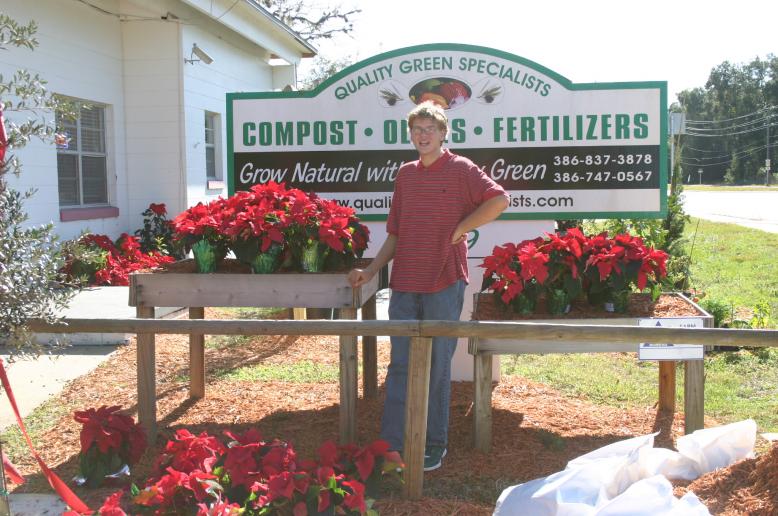
Alex Andrews working on our Holiday display.
Tuesday, December 1, 2015
Today, I’ll be part of the Florida Wildflower & Garden Festival Planning Committee. We are organizing the award winning festival I helped found back in 2007. The 10th Annual Festival will be held on Saturday, April 2, 2016 on Indiana Ave. and in the Athens Theater in downtown DeLand. LEARN HOW EASY IT IS TO GROW BEAUTIFUL AND LONG-LASTING WILDFLOWERS. Put it on your calendar!
Yes, we have Moringa trees, the incredibly nutritious trees prized for their delicious leaves and edible seeds. Their nutritional value is so great, it’s off the chart!

Monday, November 30, 2015
Today, we are open to serve you 8-5. Associate Alex Andrews will be on hand to assist you as well as my business partner Allen Day. I will also be there part of the day and away consulting with customers part of the day.
Yes, we have low-chill Florida apples. Two varieties are needed for pollination. We both the Anna and Dorsett types.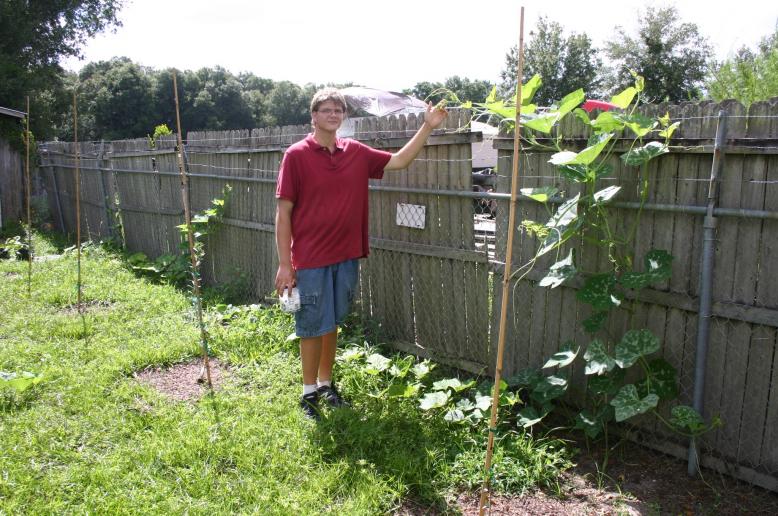
Shown above: Associate Alex Andrews looks forward to greeting you. Here Alex is shown demonstrating how easy it is to grow the native Seminole pumpkin with our compost and Super Green 3-0-5 Fertilizer.
Saturday, November 28, 2015
Today, we are open to serve you 8-5. Come see us for all your planting needs, from the best selection of Citrus and olives and 70 fruiting varieties in all, to a complete selection of organic soil amendments and fertilizers.
Above: The Citrus section at Quality Green Nursery.
Wednesday, November 25, 2015
Today we are open 8-5. We will be closed tomorrow, Thursday, November 26, Thanksgiving Day. Happy Thanksgiving! We will be open again as usual on Friday and Saturday.
A view of our storefront display area highlighting the QGS sign, colorful plants, and a papaya tree by the entrance full of papayas. We have a nursery full of fruit trees, fruiting plants, and vegetables out of view behind the showroom. Photo taken November 14, 2015.
Saturday, November 21, 2015
Today we are open 8-5. We will be closed tomorrow, Sunday. Next week we will be open every day except Thursday, Thanksgiving Day. Soon we will have lots of papayas. Papayas like to be grown up close to a building. And because they are succulents, they won’t disturb the foundation. Plant them on the south/southeast side where they will be easy to protect from a possible freeze. Be sure to generously incorporate our compost and Azomite® volcanic pumice to make them vigorous and more cold hardy. Then fertilize with our SUPER GREEN 3-0-5 Organic Fertilizer (O.M.R.I. listed) in the spring. Yes, we have in stock lots of quality papaya plants grown in-house. Happy Thanksgiving!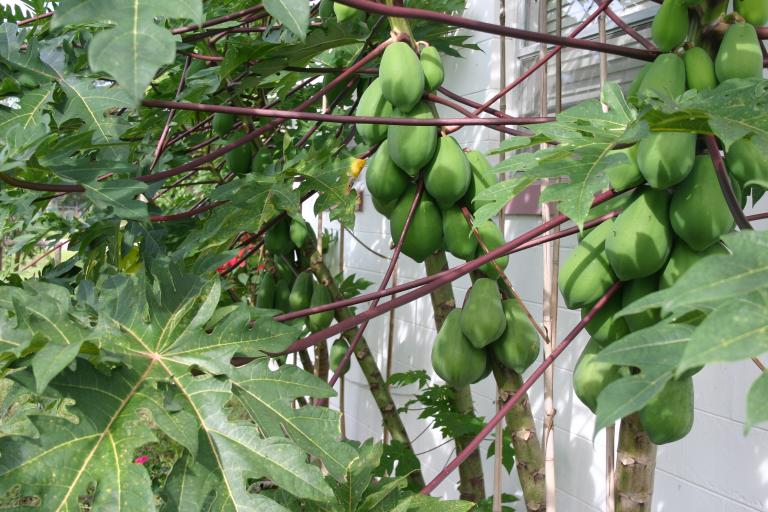
This is the papaya patch in front of the store. I noticed one starting to ripen (turn yellow) yesterday. Photo take November 14, 2015.
Friday, November 20, 2015
Yes, we have a big selection of vegetables for the fall and winter season. Come visit and see for yourself. Also, come by my booth at the Artisan Alley Farmer’s Market in DeLand this evening from 6-9 p.m. I’ll have fresh okra, sweet potatoes, vegetable plants, and some of our outstanding organic products like compost, potting soil, and our organic SUPER GREEN 3-0-5 fertilizer.
Wednesday, November 18, 2015
Cooler weather is here and it’s planting time. Come see our great selection of fruit trees, fruiting plants, and cool weather vegetables ready to plant!
Above: Yes, we have many vegetable plants to choose from!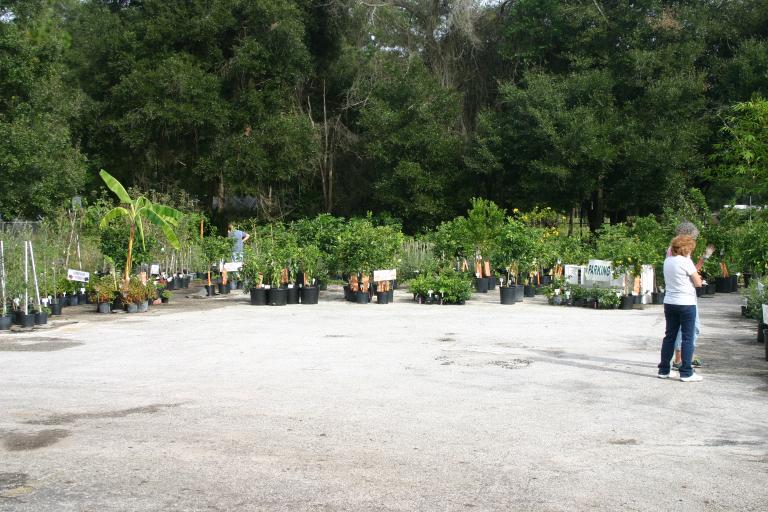
Above: Judy Swiatosz (on other side of customer) and Alex Andrews (in the back of The Nursery) pictured showing our complete selection of fruiting plants and vegetables to customers. David Wiggins, Allen Day, and I are here to help you as well.
Tuesday, November 17, 2015
Christmas is coming sooner every year. This Poinsettia at The Nursery is ahead of time as well! No, there was no special treatment. Mother Nature did this on her own (along with our compost & Azomite)!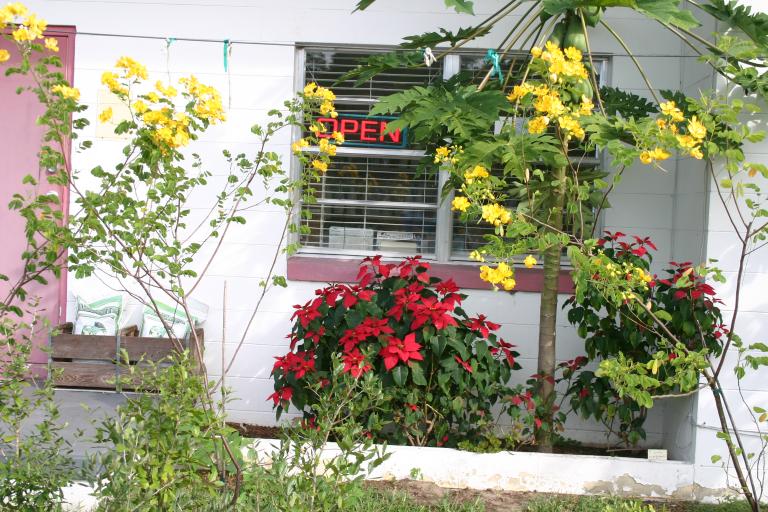
Monday, November 16, 2015
This Seminole Pumpkin patch at The Nursery has exploded with multiple long vines with several dozen pumpkins. The Secret? Quality Green Premium-Blend Compost and organic Super Green 3-0-5 Fertilizer! This patch of three vines was started from seeds in a 6″ deep bed of our compost and was fertilized with our amazing 3-0-5 Fertilizer. Did you know that this delicious pumpkin is a native Florida squash? Photos taken on November 14, 2015.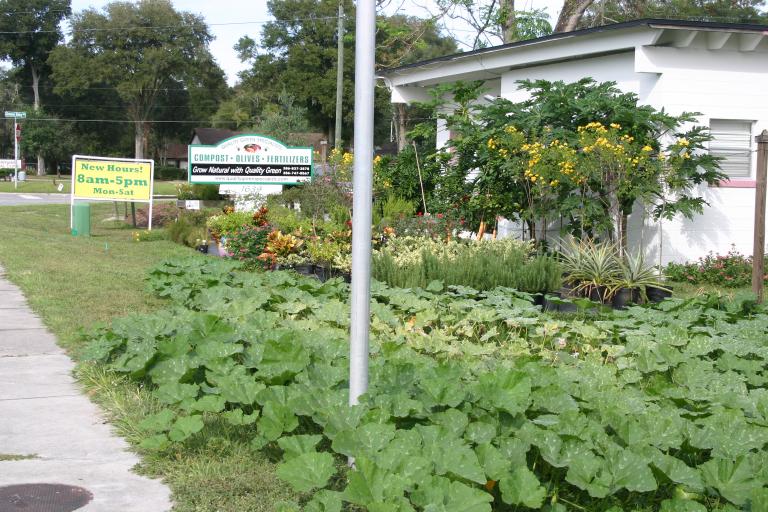
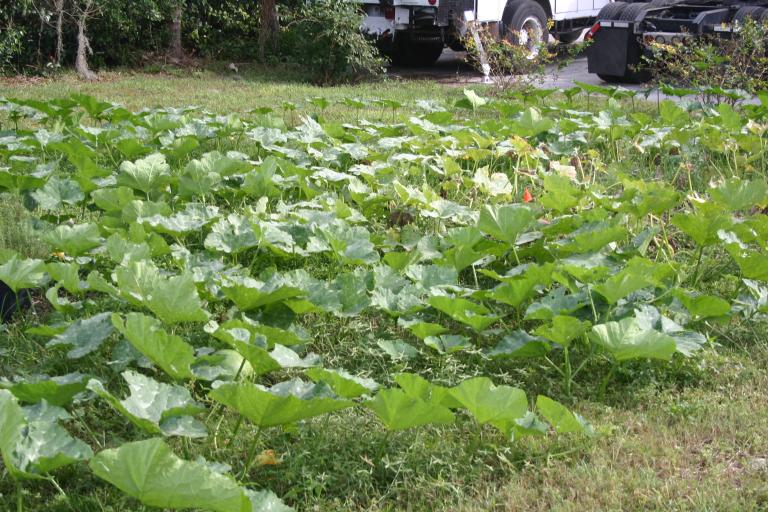
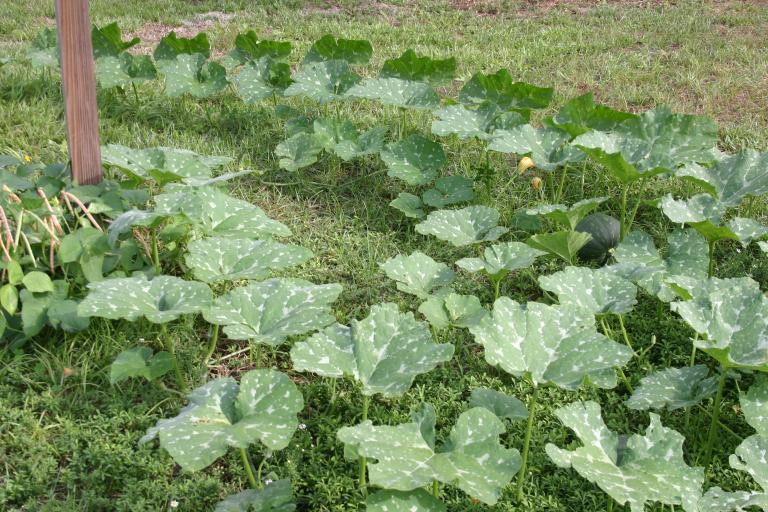
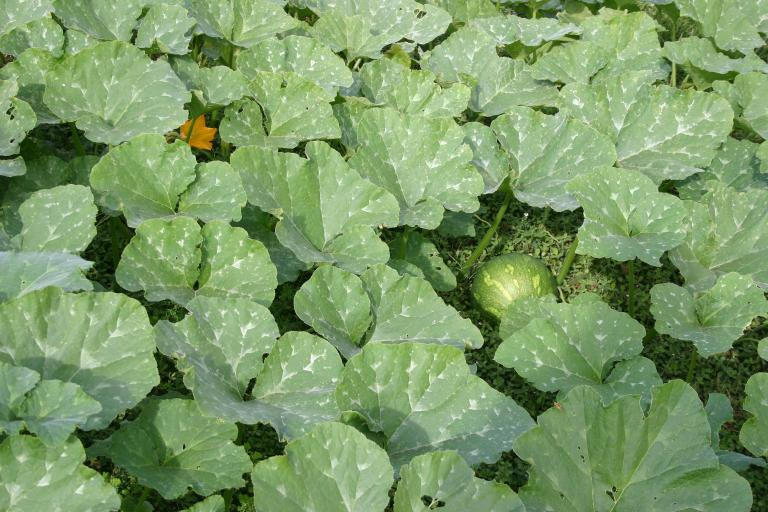
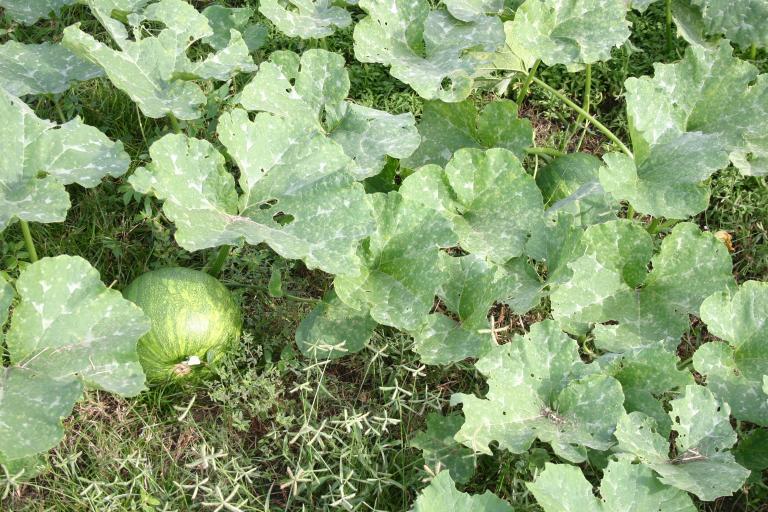
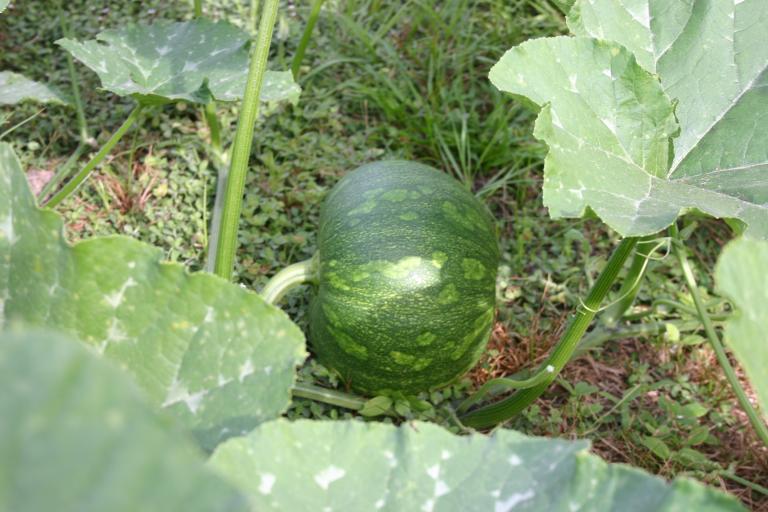
Friday, November 13, 2015
Happy Friday the 13th! Come by The Nursery today to see the best selection of fruiting plants ever.
This evening I will be at the Artisan Alley Farmer’s Market in beautiful downtown DeLand from
6 p.m. to 9 p.m. Artisan Alley is located in downtown DeLand between “Dally in the Alley” Restaurant and The Beacon newspaper. This is between Georgia Ave. and New York Ave. 1/2 block west of Woodland Blvd. (U.S. Hwys. 17-92). Look for dry, pleasant “Florida weather”. Meet new friends and enjoy the company of old friends. I look forward to seeing you. Take home some of our cold-hardy vegetable plants, fresh-dug sweet potatoes, fresh-picked okra, and some of our great fertilizers, compost, and potting soil that we formulate and make ourselves! 
Thursday, November 12, 2015
Today, Alex Andrews and I are on the radio as “The Green Gardeners”. Listen live at govstuff.org from 5:15 to 6:15 p.m. Please call in your gardening or farming questions to us at 386-523-1380.
Tuesday, November 10, 2015
Thanks to you, all our customers, we have been in business now for over 5 years. The company was founded by me in July, 2010 after my retirement as the UF/IFAS Volusia County Commercial Horticulture Agent. I soon began working with Allen Day and we incorporated Quality Green Specialists in January, 2011. We have helped so many people grow better, healthier plants in a safe, sustainable way. Thank you for helping us make a difference.
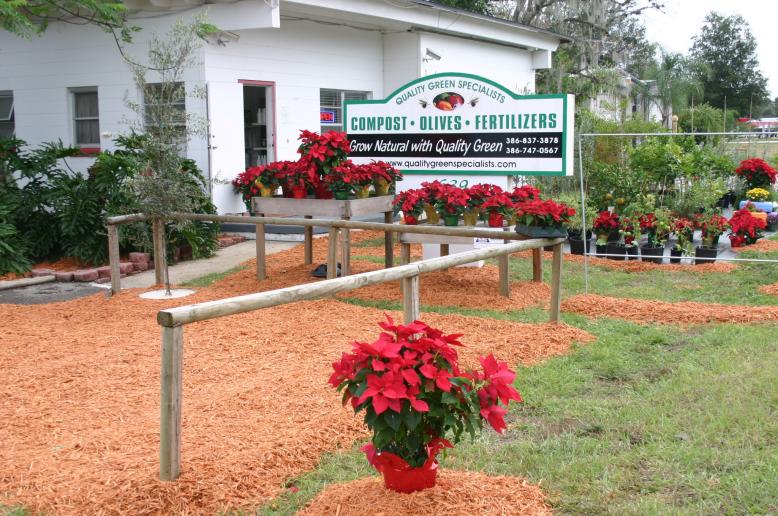
Monday, November 9, 2015
There are lots of green Seminole Pumpkins on the vines at the nursery and they will be ripe soon. These vines are super healthy with nice big pumpkins.
Soon they will look like those in the above photo. What is our secret? Actually two: Our great Super-Blend Organic Compost and our organic Super Green 3-0-5 Fertilizer containing Azomite® volcanic mineralizer and lots of other essential minerals in good ratios.
Saturday, November 7, 2015
Everyone had a good time at the Artisan Alley Farmer’s Market last evening. More and more people are finding out about Quality Green Specialists and what we do. I invite you to visit the nursery today to find the best selection of fruit trees and fruiting plants anywhere. Remember our convenient location in DeLand: 1639 N. Spring Garden Ave, DeLand 32720. You will be astounded by our huge inventory of fruiting Arbequina olive trees and beautiful Citrus trees.
This beautiful Arbequina olive tree in my landscape yielded 20 pounds of olives this year!
Friday, November 6, 2015
It’s Farmer’s Market night at Artisan Alley in DeLand, Florida from 6-0 p.m. From 8-5 p.m. visit our nursery for great deals on olive trees, Citrus trees, stone fruit trees, avocadoes, persimmons, mulberries, moringa trees, papaya trees, guava trees, and so much more. Mention this post and receive 10% off our already low prices! While there, check out the best natural and organic fertilizers, potting soil, and compost found anywhere! Come by the Artisan Alley Farmer’s Market this evening in the heart of downtown Deland from 6 to 9 p.m. and you’ll find me with ready to eat okra, sweet potatoes, 4″ vegetable plants and more. Look for the “Quality Green Specialists” and “Welcome to Our Patch” signs. See you there!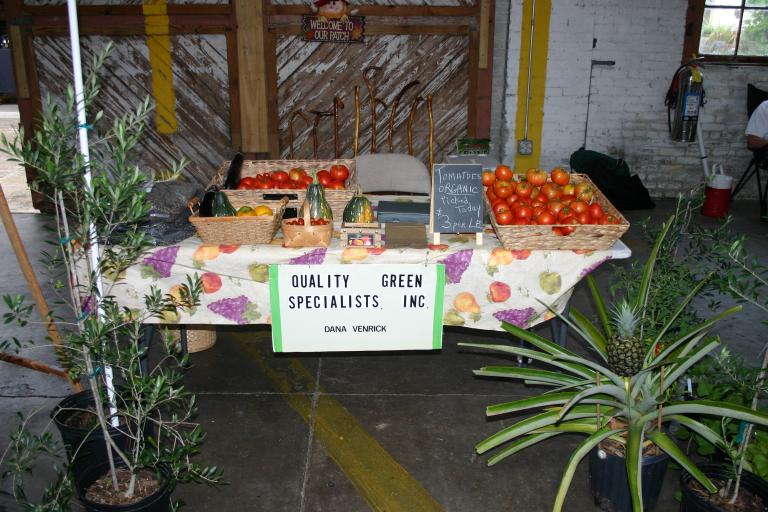
A Farmer’s Market night from earlier this year.
Thursday, November 5, 2015
Rudbeckia or black-eyed Susan and Vinca (Periwinkle) make a nice combination in a landscape bed and are easy to grow. In fact, these came up from seed on their own from plants grown in the yard for many years!
Monday, November 2, 2015
This hardy seedling peach tree reaching 21′ high was grown with organic Azomite® O.M.R.I. listed volcanic mineralizer and our own Super Green 3-0-5 Fertilizer. It has delicious white freestone peaches and is the result of many generations of careful selections made by me since 1989. “Dana’s White Peach” is now available at Quality Green Nursery along with UF releases such as “Florida Prince” and ‘Florida Belle”. As an added bonus, receive 10% off our low list price when you mention you saw this on my blog. By the way, this is the best time of year to plant peaches and other hardy trees because sap is moving down tree trunks to promote root growth during cooler weather. Then trees grow out better when roots are well established first!
What a hardy tree and you never tasted more delicious peaches. The 21′ tree is taller than the house! Note the 7′ ladder next to the tree.
Saturday, October 31, 2015
Happy Halloween! We are open today 8-5. Last night was fun at the Artisan Alley Farmer’s Market. I sold all the sweet potatoes and the last Seminole Pumpkin I grew this summer. But lots more are maturing at the nursery!
Friday, October 30, 2015
It’s our Farmer’s Market night at Artisan Alley in DeLand, Florida. From 8-5 p.m. visit our nursery for great deals on olive trees, Citrus trees, stone fruit trees, avocadoes, persimmons, mulberries, moringa trees, papaya trees, guava trees, and so much more. While there, check out the best natural and organic fertilizers, potting soil, and compost found anywhere! Come by the Artisan Alley Farmer’s Market this evening in the heart of downtown Deland from 6 to 9 p.m. and you’ll find me with ready to eat okra, sweet potatoes 4″ vegetable plants and more. Look for the “Quality Green Specialists” and “Welcome to Our Patch” signs. See you there!
Wednesday, October 28, 2015
This field of blooming Sunn Hemp (Crotalaria juncea L.) is a spectacular view on Plymouth Ave. just west of S.R. 15A (Spring Garden Ave.) in DeLand. Sunn Hemp is a cover crop grown in Florida and other mild climates for fixing nitrogen in the soil and for biomass for biofuels. It is planted after growing a crop of corn or vegetables.
Monday, October 26, 2015
The Artisan Alley Farmer’s Market Friday evening was quite rewarding because I shared some healthy 4″ vegetable plants and delicious vegetables with a lot of people, not to mention the interesting conversations throughout the evening. What a fun venue! The bats coming out at dusk, the wonderful aromas in the air, the delicious food and wonderful local crafts, the eclectic Dally in the Alley Restaurant, the Sangrias and other beverages at the Nest, the micro-brewery with delicious hand-crafted beer at Persimmon Hollow, the entertainment at DaVinci Lounge. See you next Friday!

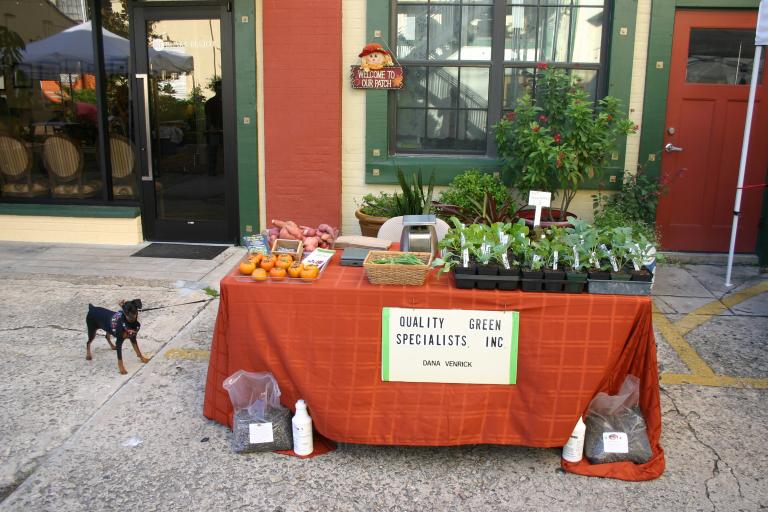
Friday, October 23, 2015
It is happening in DeLand, Florida. Come by the nursery for great deals on olive trees, Citrus trees, stone fruit trees, avocadoes, persimmons, mulberries, moringa trees, papaya trees, guava trees, and so much more. Come by the Artisan Alley Farmer’s Market this evening in the heart of downtown Deland from 6 to 9 p.m. and you’ll find me near the New York Avenue end of the market with ready to eat persimmons, okra, and sweet potatoes and some potted edible plants. See you at the nursery at 1639 N. Spring Garden Ave. and at the Artisan Alley!
Thursday, October 22, 2015
It was great to see Ron Kelly’s grove yesterday in Bowling Green. Literally, it looks like a new grove after this season’s treatments with our Citra Thrive Plus and testing-based quality nutrition! Now the few symptoms of Citrus Greening/HLB are hard to see.
Above: Ron Kelly’s grove pictured on October 21, 2015.
Above: This was the condition of Ron Kelly’s trees on February 23, 2015 before treatments with Citra Thrive Plus and testing-based quality fertilizer.
Above: This orange tree in Ron Kelly’s grove was in big trouble on February 23, 2015.
After treatments: This is how the same orange tree looked yesterday on October 21, 2015. Most of the fruit seen on the ground were knocked off the tree when the large grapefruit tree with canker next to it was removed.
Wednesday, October 21, 2015
October and fall is for planting and for fall color. Don’t forget cold hardy vegetables like collards, mustard greens, turnip greens, kale, Swiss chard, broccoli, onions, beets, lettuce, and more. October is the last month of the year for a light dry fertilizer application as well. Also, check out our great SUPER GREEN 3-0-5 Fertilizer. You’ll be glad you did!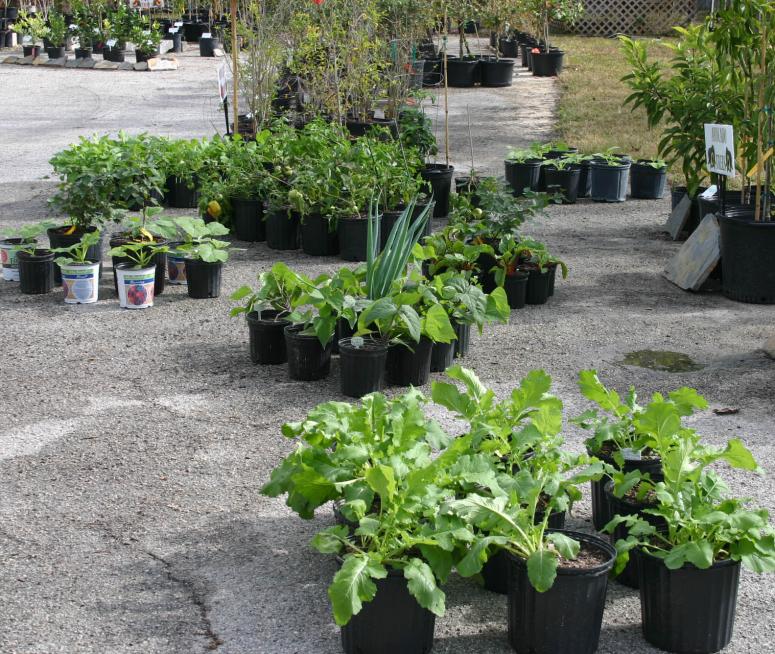
Above: Healthy Greens at Quality Green’s Nursery.
Tuesday, October 20, 2015
Here is another edible that we have at the nursery – Cassava, called Yuca in Espanol. The starchy roots can be harvested in two years and are very versatile, from being made into flour, to making tapioca, to making mouth-watering fries even better than french fries.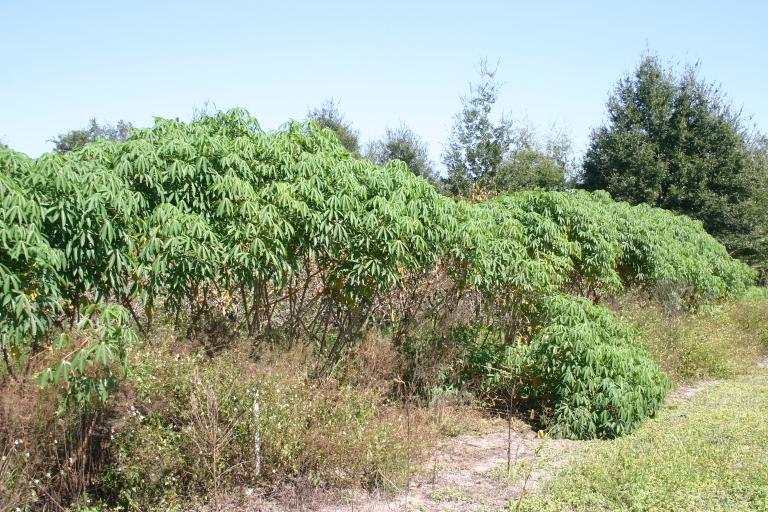
This is a large stand of Cassava in Barberville, Florida. Photo taken October 17, 2015.
Cassava root contains natural toxic cyanogenic glycoside compounds linamarin and methyl-linamarin. Injury to tuber releases linamarase enzyme from the ruptured cells, which then converts linamarin to poisonous hydrocyanic acid (HCN). Eating raw cassava root results in cyanide poisoning with symptoms of vomiting, nausea, dizziness, stomach pains, headache, and death. In general, cyanide content is substantially higher in its outer part and peel. While peeling lessens the cyanide content, sun drying, and soaking followed by boiling in salt-vinegar water results in evaporation of this compound and makes it safe for human consumption.
Monday, October 19, 2015
Fall is the best time for planting! Yes, persimmons are getting ripe now in October and they are an outstanding crop for central Florida: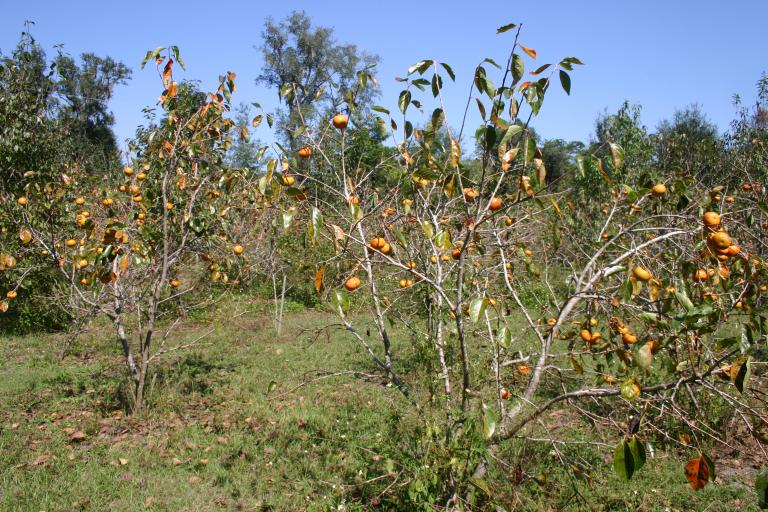
Check out these Fuyu persimmons (a great non-astringent variety) full of fruit ready to eat. Photo taken on October 17, 2015.
Saturday, October 17, 2015
Yes, we are open today 8 to 5. Come by and browse through the best selection of fruit trees in central Florida. You’ll be glad you did. Persimmons ripen this time of year and they are one of over 70 varieties of fruiting plants that we have in stock: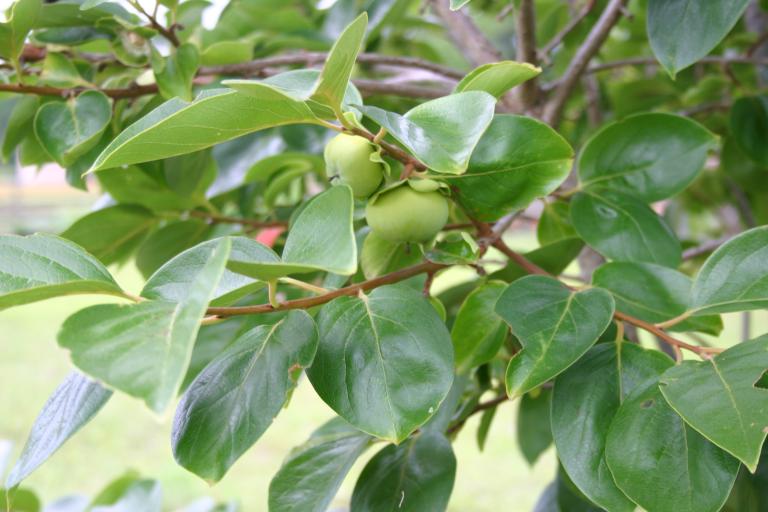
Friday, October 16, 2016
Visit the Artisan Alley Farmer’s Market this evening in downtown DeLand (just west of the intersection of Woodland Blvd. and New York Ave, behind the Beacon newspaper office). You’ll be glad you did. This is a fun experience for all. Quality Green will have cured olives picked from our own olive trees, okra picked from our own plants, sweet potatoes dug from the beds at Quality Green’s Nursery, as well as Arbequina olive trees and Moringa trees we grew ourselves. By the way, we have just completed sticking Arbequina olive cuttings for a new crop next year: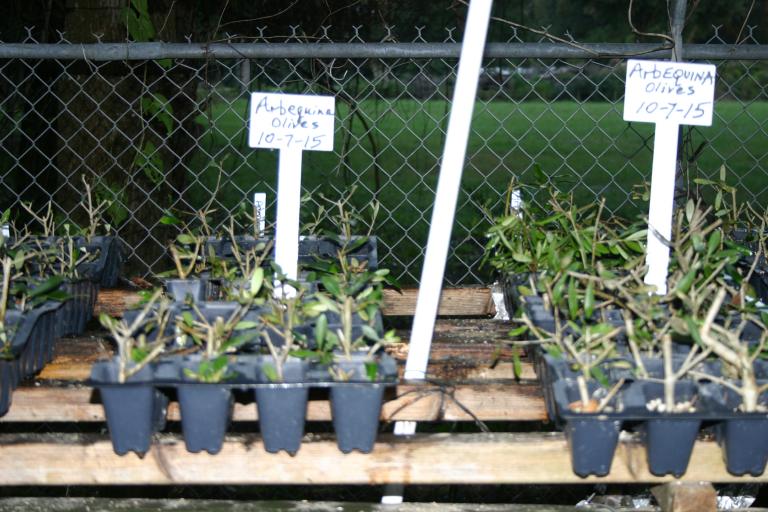

Yes we have Surinam Cherries, along with over 70 varieties of fruit trees and plants.
Tuesday, October 13, 2015
Yes, we have fruiting olives and the cured olives from our trees to prove it. Home grown Arbequina olives of all sizes are ready for sale. We also have 4″ liner size and 3 gallon size Arbosana and Koroneiki olive trees.
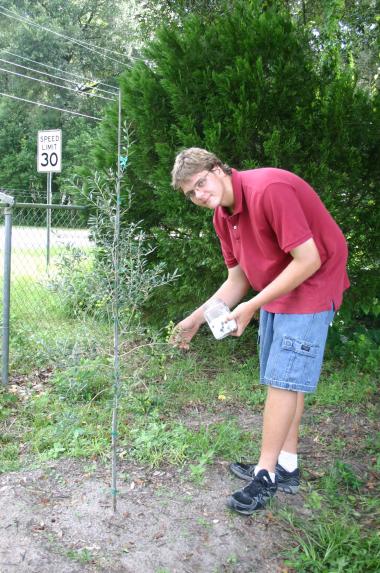
Associate Alex Andrews picking olives from an in-ground two-year old Arbequina olive tree at Quality Green’s Nursery in DeLand.
Monday, October 12, 2015 Columbus Day
Fall is in the air. It’s time to plant that favorite fruit tree or plant, or, in some cases, lots of them. This is when sap is moving down toward the roots and roots become readily established; and then will grow out better next spring.
Wednesday, October 7, 2015
Today is a beautiful fall-like day in Florida. I am consulting with a Citrus grower regarding his soil and leaf tissue testing. There is lots of work in the nursery as usual. The mower is repaired and it’s almost time to mow the grass again. There are some weeds to pull every day. They never cease to pop up. We only weed by hand as we pride ourselves in our nature-friendly nursery.
Come see our wide selection of fruiting trees – the selection has never been better! Fall is the best planting time as well!
BONUS: Say you saw “Dana’s Daily Blog” and ask for a 10% discount on all tree & plant prices!

Above: One of our beautiful olive trees just after planting in a home landscape.
Monday, October 5, 2015. Did you know that fall is the best planting time for hardy fruit trees and fruiting plants as well as hardy ornamentals? Sap is starting to move toward the roots to let the top growth slow or stop while promoting root growth over the cooler months to prepare for renewed growth in the spring. By establishing a strong root system first, the tree or plant grows out faster and better next year and for the life of the plant. Starting out with strong root growth first is a key to long-term healthy, productive plants.
Saturday, October 3, 2015
Yes, we are open to serve you today 8-5. Come by and explore our huge variety of fruit trees, fruiting plants, vegetables, herbs, and ornamentals. It like a botanical park of edibles to enjoy everywhere. We look forward to meeting you!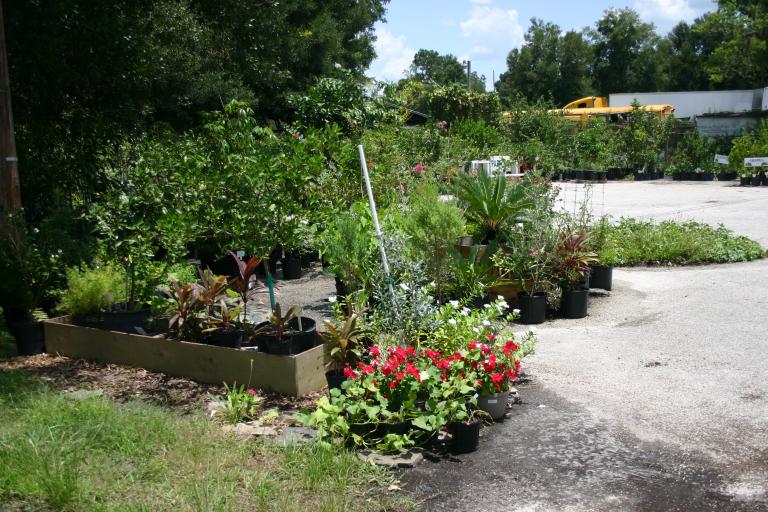
Wednesday, September 30, 2015
Here are photos of eggs of the Asian Citrus Psyllid, Diaphorina citri. Photo from USDA.
Below: Here are two photos of the nymphal instar stages of the Asian Citrus Psyllid. The first, from a grove in DeLand, Florida, was taken by by me on 9-25-15.
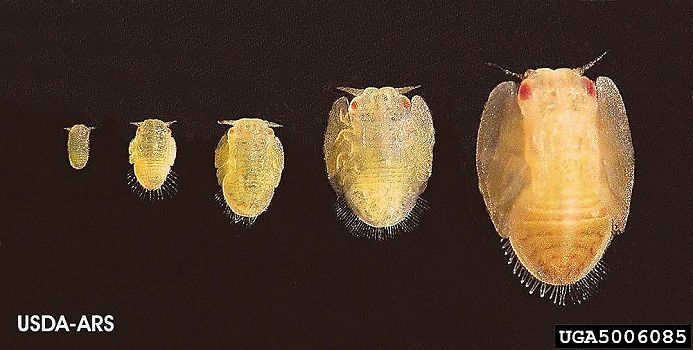
Above: The five nymphal instars of Diaphorina citri (Asian Citrus Psyllid). The first instar is 0.25 mm and the fifth instar is 1.5-1.5-1.7 mm.
Below: Adult Asian Citrus Psyllid. Note the feeding at about a 30 degree angle. Photo from USDA.
Below: The life cycle of Tamarixia radiata, the parasitic wasp that feeds on the Asian Citrus psyllid nymphal instars. From Cornell University.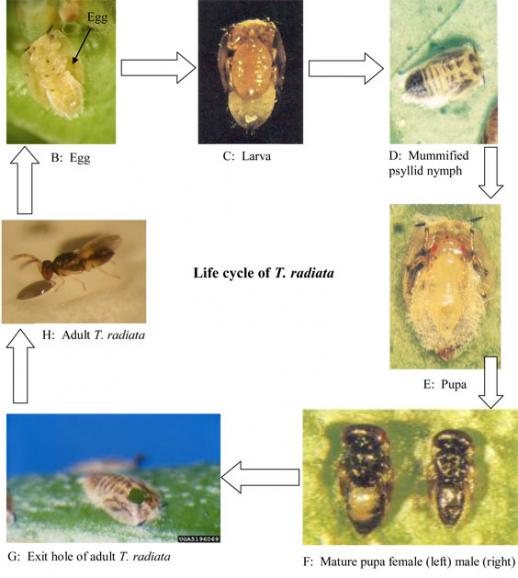
Tuesday, September 29, 2015
Rains are continuing in central Florida to make this a very rainy September. Azomite® O.M.R.I. listed organic volcanic mineralizer is becoming better known all over Florida and beyond. It is one of the key materials in our Citrus Greening (HLB) remediation program giving results like shown below in young trees as well as older trees.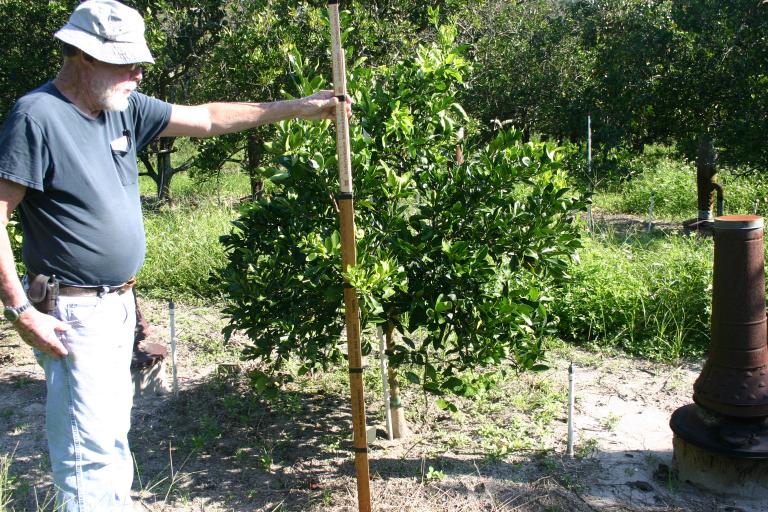
Three year old Navel Orange tree at Richard Marshall’s grown with fertilizer with Azomite.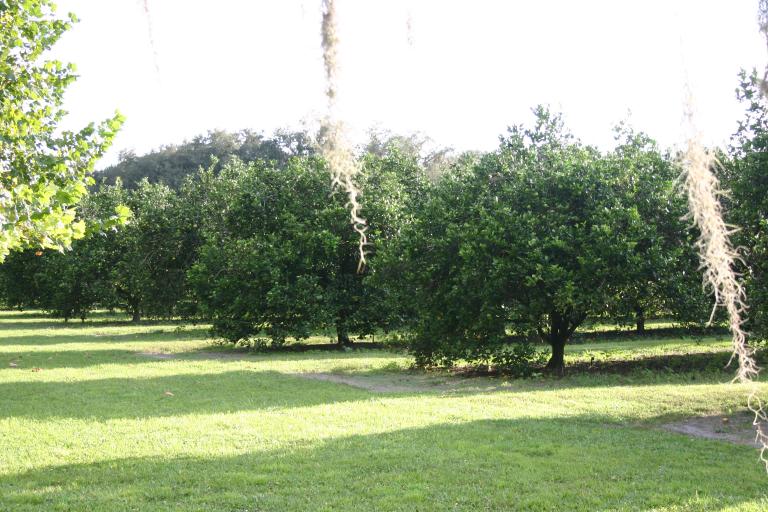
We are seeing dramatic recovery of HLB infected trees such as Wilbur Robertson’s grove once again a picture of health.
Saturday, September 26, 2015
The Farmer’s Market went well. I sold some of the olives we cured from our our home-grown olive trees. The rain came and went and it turned out to be a nice evening.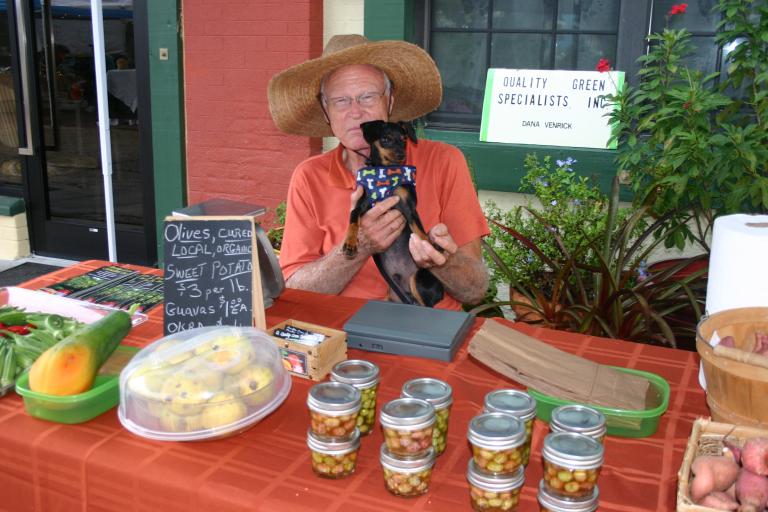
Friday, September 25, 2015
Today is Farmer’s Market Day at Artisan Alley in downtown DeLand 6-9 p.m. I’ll have delicious white guavas picked ripe from my guava trees, fresh-cut okra from the nursery, and sweet potatoes fresh dug from our potato beds. Come by and visit. Artisan Alley is the place to meet and greet and have a good time. Artisan Alley is 1/2 block west of Woodland Blvd. between New York Ave. and Georgia Avenue behind the Beacon newspaper office. Enjoy dining at the Dally in the Alley Restaurant, refreshments at The Nest, beer at Persimmon Hollow, entertainment at DaVinci Lounge, and of course all the great, healthy treats from the vendors!
Thursday, September 24, 2015
Today, Allen and I are taking leaf samples from tomato fields being trialed with supplemental Azomite® volcanic pumice. Generally, we take three samples during the crop cycle: before bloom, at marble size fruiting stage, and just before the tomato fruit turn red/mature. Per field, we take about 40 of the most recently mature compound leaves with petioles (snapped off by hand, not cut). These leaves are generally the fourth or fifth from the growing tip.
Plant tissue nutrient sufficiency ranges for tomato nutrients are: N = 3.5-5.0%, P = 0.3-0.65%,
K = 3.5 – 4.5% or 2.8 – 4.0%*, Ca = 1.0-3.0%, Mg = 0.35-1.0%, S = 0.2-1.0%, Fe = 50-300 ppm, Mn = 25-200 ppm, Zn = 18-80 ppm, Cu = 5-35 ppm, B = 30-75 ppm
*The sufficiency range for K changes depending on the plant growth stage at the time of sampling. For tissue collected from seedlings,early growth or plants in bloom, the target sufficiency range for
K is 3.5–4.5%. For tissue collected from fruiting or mature plants, the target sufficiency range is 2.8–4.0%.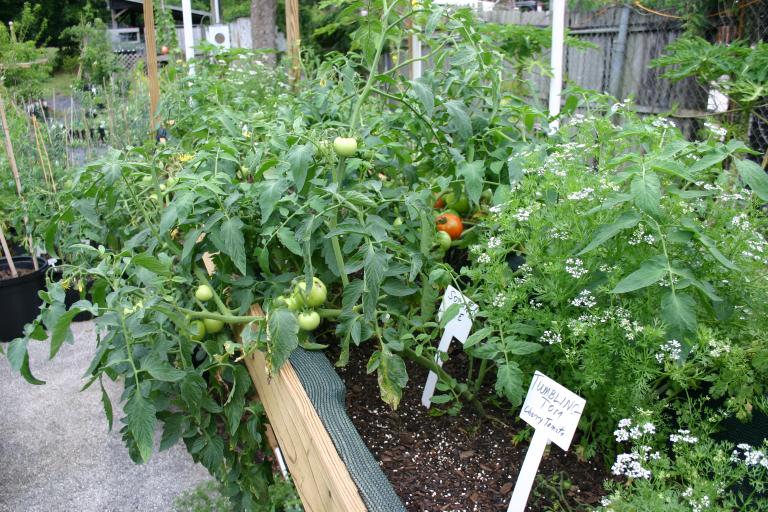

Wednesday, September 23, 2015
Come by and visit us today. Not only do we have over 50 varieties of fruiting plants, but we also have over 70 high quality products (most natural or organic) to help you grow the best crops and the best plants ever. Our products include Agri-Fos (phosphite & phosphate for disease protection and phosphorus nutrition), Azomite® natural and organic (O.M.R.I. listed) volcanic mineralizer) – the best volcanic or rock type mineral found anywhere, liquid humic acid and kelp, our own “Vital Green 3 in 1” organic liquid fertilizer, our own 3-6-9 liquid fertilizer, our own 3-0-5 dry, granular organic fertilizer, custom ferilizer mixes, fish emulsion, bone meal, blood meal, blood & bone meal, cottonseed meal, Gro-Cal MGB (calcium nitrate with micronutrients for improved absorption), ground cover/landscape fabric, gypsum (calcium sulfate), “KeyBor” glucoheptonate chelated boron, limestone with calcium and magnesium, “Micro-Boost” organic micronutrients, all types of organic micronutrients (glucohetonate chelated), potassium magnesium sulfate (SPM/KMag), perlite, germinating mixes, our own high quality potting soil, our own “double composted” organic compost, “Repel-It” and other organic pesticides, shade cloth (saran), organic Spinosad & Dipel/Bt insecticides for controlling worm & larva pests, high quality black plastic containers of all sizes, vermiculite, bamboo stakes, rooting hormones, sulfur coated urea, Stimp-Up (potassium silicate), and others to meet all your growing needs.
Saturday, September 19, 2015
We are open today. Our display at the Tapas and Wine Festival last night was very popular. Many more people found out about Quality Green Specialists for the first time. Fresh-cut samples of fresh picked white Guavas were especially popular. Yes we grow lots of guavas, in fact four different kinds – white guava, pink guava, strawberry guava, and pineapple guava (Feijoa). In a protected spot like mine and with our Azomite® organic pumice and using our high quality mineralized fertilizer (Super Green 3-0-5), you can grow delicious guavas in central Florida.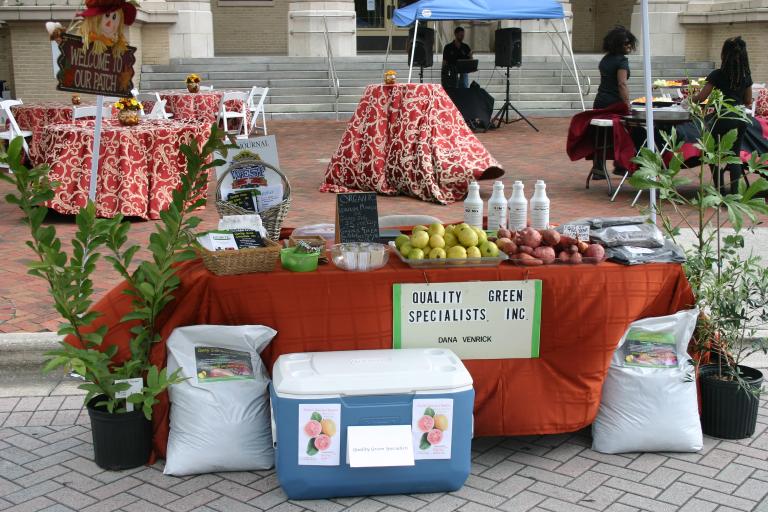
Friday, September 18, 2015
We will have a booth today, Friday evening, September 18 at the 3rd Annual DeLand Tapas and Wine Festival. I’ll have delicious, ripe, fresh-picked white guavas and guava treats, olives in Himalayan and sea salt, okra, and sweet potatoes, all of which we grew locally. Come early because they will go fast! The location is West Indiana Avenue and Chess Park going west from Woodland Blvd. (U.S. Hwys. 17-92). Enjoy beautiful historic downtown DeLand, a recent winner of the best downtown in central Florida! For more information about the festival contact the Chamber of Commerce at 386-734-4331. For more information about Quality Green’s booth contact me at 386-837-3878.
Thursday, September 17, 2015
We will have a booth tomorrow, Friday evening, September 18 at the 3rd Annual DeLand Tapas and Wine Festival. I’ll have delicious, ripe, fresh-picked white guavas and guava treats, olives in Himalayan and sea salt, okra, and sweet potatoes, all of which we grew locally. Come early because they will go fast! The location is West Indiana Avenue and Chess Park going west from Woodland Blvd. (U.S. Hwys. 17-92). Enjoy beautiful historic downtown DeLand, a recent winner of the best downtown in central Florida!
Gems from the August Citrus Expo: The largest annual cost of producing oranges in Southwest Florida was pegged at $1153.00 for foliar sprays and fertilizer. This is unnecessarily expensive! Our advanced program, proven to give outstanding results, costs in the neighborhood of $600.00 to $800.00 per acre for foliar treatments and liquid fertilizers, and ground applied fertilizers. The cost varies depending on what you need based on the results of our advanced comprehensive testing. By the way, our testing is not expensive. Our total cost for testing is only $50.00 for a comprehensive standard soil test, $50.00 for a saturated paste extract (how much, if any, of the total minerals in your grove will actually dissolve into the soil water in your grove and be available to the tree roots), and $65.00 for a complete leaf analysis. Not only do we give a complete analysis, but we give complete recommendations for inputs and a suggested complete foliar and ground applied fertilizer program for the entire year!
Also, University of Florida Professor Jude Grosser reported that he and his fellow scientists have “discovered” that good nutrition is extremely important in the effort to maintain HLB [Citrus Greening] infected trees. “Ground applied nutrition really matters”, he explained. What have I been saying for years? Yes, tree can defend themselves against a bacterial disease if there are no limiting elements either from being absent or being sequestered (tied-up). As discussed, resistance to diseases in Citrus trees is called SAR (systemic acquired resistance). “Just as animals contain white blood cells that are involved in protecting the body against infections, plants also have the ability to produce an immune response following infection. This immune reponse [known as systemic acquired resistance (SAR)] occurs after plants are infected and can provide strong resistance to subsequent infections.” (from the cover story in the Citrus Industry magazine, September, 2015, page 11 by Manjul Dutt and Jude Grosser, both with the UF/IFAS Citrus Research and Education Center in Lake Alfred, Florida.)
Tuesday, September 15, 2015
Our high quality potting soil and compost is selling extremely well. The word is definitely getting around. Thank you! We deliver bulk by the yard or in 32 quart bags. Or come by the nursery for bulk or bags and save the delivery charge. We deliver small loads in a small tilt trailer up to 5 yards or in large deliveries of 20 or 40 yards.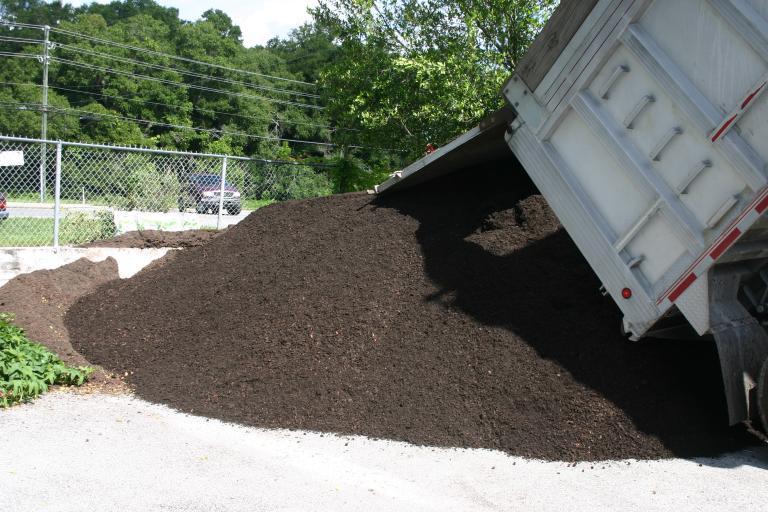

Monday, September 14
The Farmer’s Market went well Friday evening. Two olive trees sold along with fresh from the tree white guavas, fresh-cut okra, and fresh-dug sweet potatoes. Alex stuck many more Arbequina olive cuttings in the propagation house Friday and Saturday. This week, I already have several orders for delivery of our super high quality potting soil and compost.
Friday, September 11, 2015
Today is Farmer’s Market Day at Artisan Alley in downtown DeLand 6-9 p.m. I’ll have delicious white guavas picked ripe from my guava tree, fresh-cut okra from the nursery, and sweet potatoes fresh dug from our potato beds.
Yes, we have a lot of olive cuttings to stick from this year’s fall pruning (in September, right after picking the olives).
The guavas, pineapple, and sweet potato were all home-grown!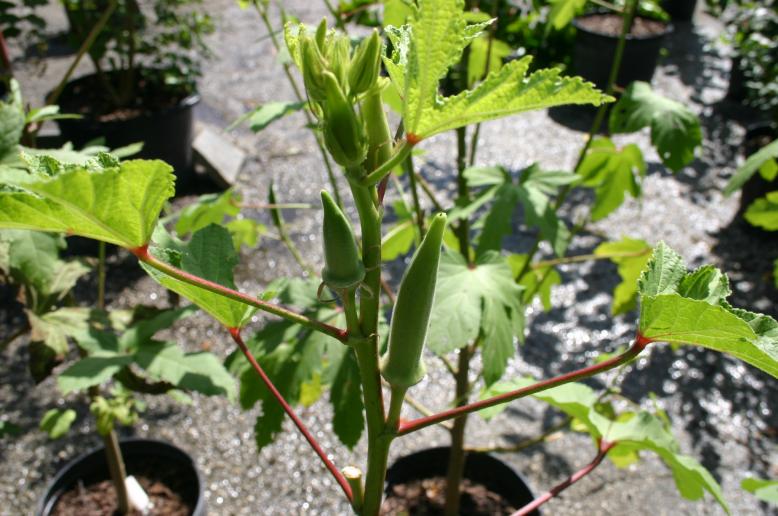
Okra plants at the nursery have never looked better.
We dig a lot of sweet potatoes from our shallow beds of compost over woven ground cover.
Thursday, September 10, 2015
Today, I am starting to do a hard pruning on the olive tree at home. The branches that had olives this year will be pruned back to 12-18″ stubs. This year’s new growth on branches pruned last year (that did not have olives this year) will not be pruned because these are the branches that will bear olives next year. Selective pruning is part of the strategy to promote bloom and fruit. Another important practice is to use lots of volcanic pumice and limestone (resulting in a pH of between 7.3-7.5). Also, it is also important to fertilize with our dry, granular 3-0-5 Fertilizer in January, April, and June at the rate of 50 pounds of nitrogen per acre of rooting area or a total of 1.1 pounds of nitrogen per 1,000 sq. ft. of rooting area. This is equal to 1,667 pounds of 3-0-5 Fertilizer per acre or 38 pounds of 3-0-5 fertilizer per 1,000 sq. ft for three applications or 555 pounds per acre per application or 12.8 pounds per 1,000 sq ft per application. Our “Olive Thrive” liquid fertilizer with amino acids and kelp should also be sprayed on the trees in January, March, May, and July. The exact formula, including organic (glucoheptonate chelated) micronutrients depends on the results of the soil and leaf tissue testing. Do not fertilize August through December to harden up the trees for the winter and help the trees go into blooming and fruiting mode come spring-time. Cuttings will be taken from the cut branches for rooting next year’s new crop.
Pruning in commercial groves is commonly accompished by side pruning [trees on] both sides of every other row middle and then alternating middles every year (this results in alternating east-west sides of every tree being pruned every year).
Today I delivered 15 yards of potting soil to Lake Helen and a yard of potting soil and compost to Altoona.
Be sure to listen to Alex Andrews representing Quality Green Specialists on Goliath Radio, AM 1380. Listen between 5:15 to 6:00 p.m. today by going to www.big1380.com and clicking on the “listen Live” button. Listen to us next month on the second Thursday – “same time and station”.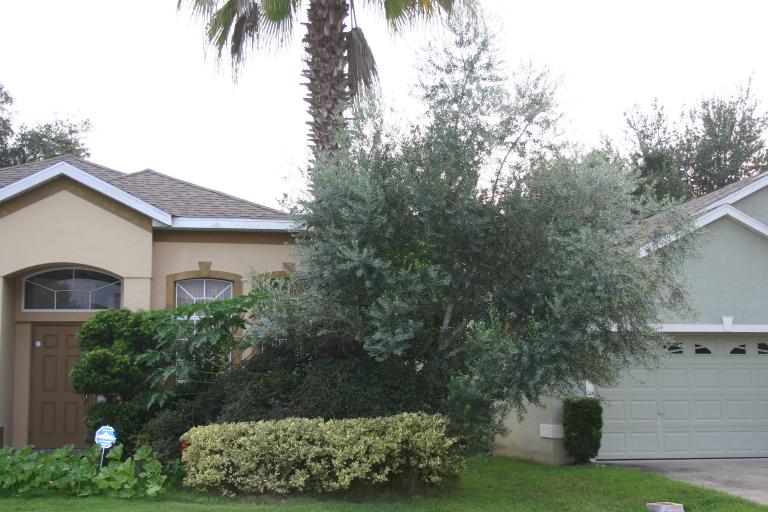
Wednesday, September 9, 2015
Today, I prepared a 20 yard load of our top quality potting & planting soil to be delivered to a daylily grower tomorrow. The word is getting around about how well our potting soil works!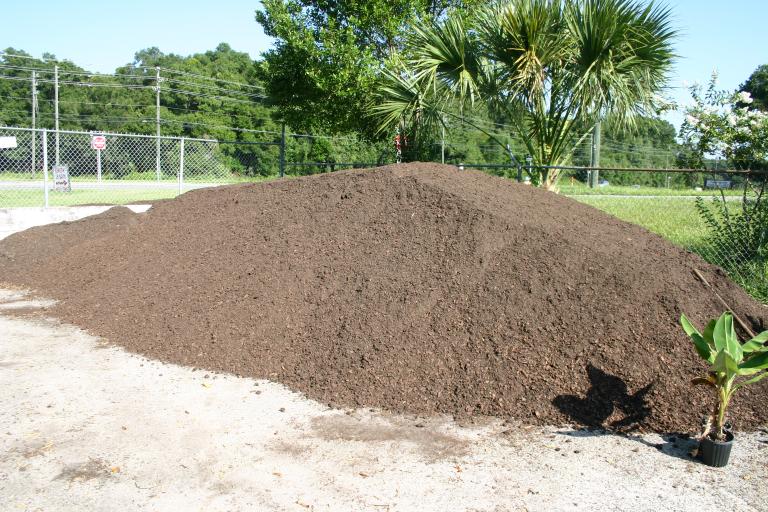
Forty yards of our top quality planting and potting soil.
My beautiful, hardy ‘White Snow’ Guava is full of fruit. This morning I picked 20 (almost) ripe guavas. I waited too long on one. This evening it was ripe on the ground and full of holes where birds had pecked the fruit.
Tuesday, September 8, 2015
Today, I visited two Citrus growers, one in Lake Wales and another in Wauchula, who are enjoying outstanding success with our testing-based annual nutritional and Greening Remediation Program. It is such a good feeling to meet with satisfied growers who have seen their trees come back from the edge of survival to a healthy, productive condtion.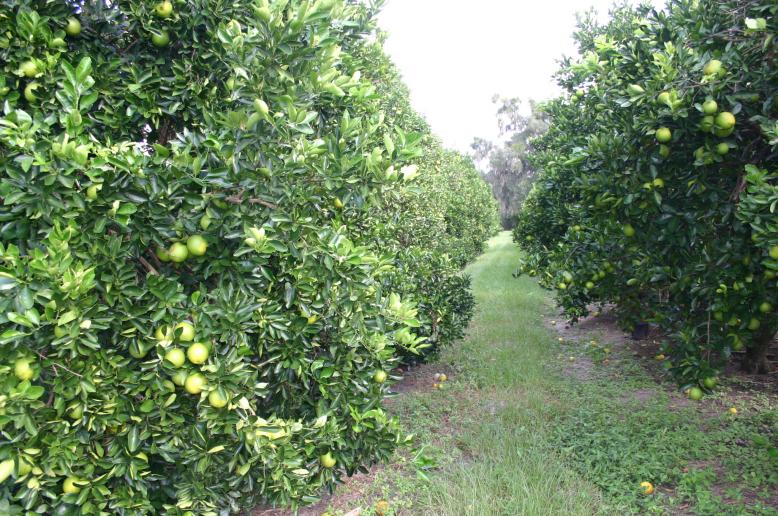
Monday, September 7, 2015 – Labor Day
Yes, we are open today. Come by and see our great selection of Citrus (including Meyer Lemons and Key Limes), Haas & Brogdon Avocados, Barbados Cherries, Kiwi, fruiting Arbequina Olive trees, beautiful, bushy Blueberries, Carambola (Starfruit), Persimmons, Fig Trees, Moringa trees, Peaches, Plums, Florida pears (Southern Home, Pineapple/Sand, Hood), Florida apples (Anna & Dorsett), Papayas, Guavas (pink, white, strawberry, and pineapple guavas), Elderberries, Okra, Peppers, Sweet Potatoes, and much more – over 70 varieties in all now in stock!
Thank you readers for voting us “Best of the West” in the Daytona Beach News Journal for “Best Fruit Tree Supplier”. We work hard to build your trust by having the widest selection of hardy, quality fruit trees for Central Florida.
Wednesday, September 2, 2015
We now have a nice selection of grafted Florida Haas and Brogdan avocados, Meyer lemons/Key Limes/Persian Limes, Barbados Cherries, Kiwi plants, and much more. Shop with us today while the selection is the best!
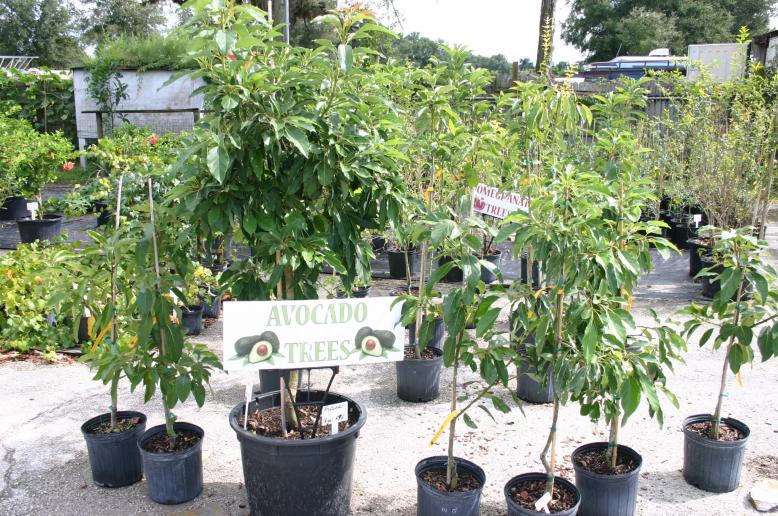
Tuesday, September 1, 2015
We now have a beautiful new flyer to promote ‘Quality Green’. Today, the Florida Wildflower & Garden Festival Committee is meeting to begin planning for next April’s Wildflower Festival, Saturday, April 2, 2016 on Indiana Ave. in downtown DeLand.
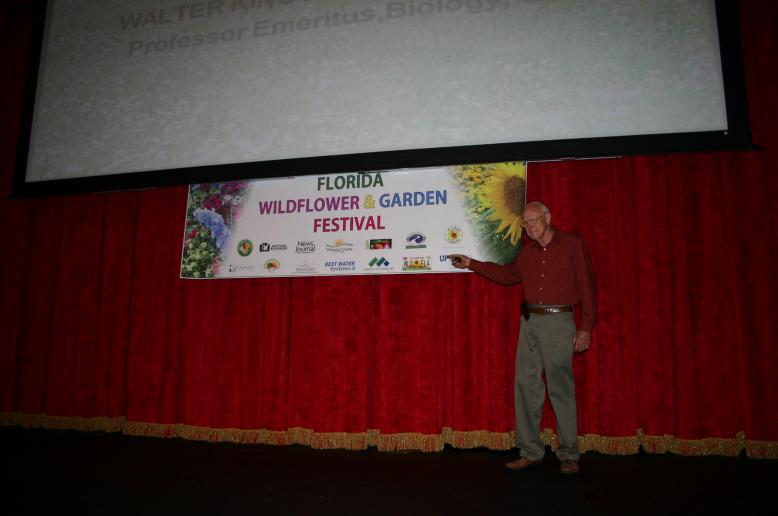
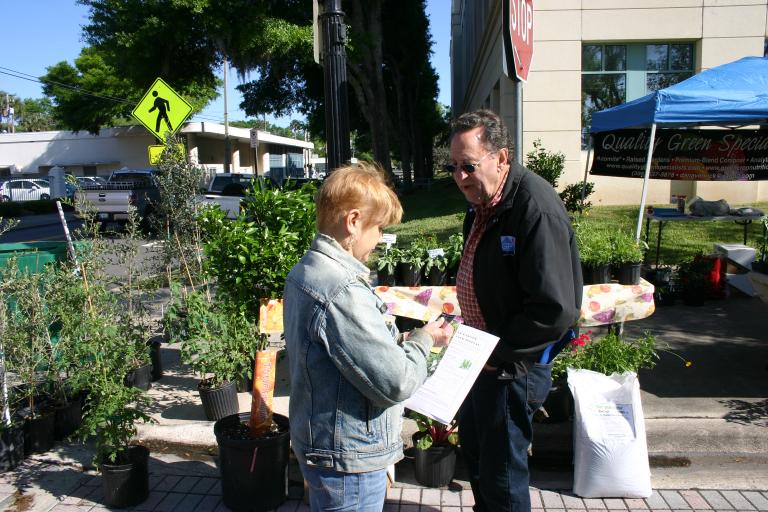

Monday, August 31, 2015
Today, I am delivering 5 yards of our high quality potting soil. Also, I am picking ripe ‘Meaty Red’ and ‘White Snow’ guavas from the trees at home and we will be planting the seeds for a new crop next year. This year’s trees are looking good and are ready for sale. Also, I am picking more Arbequina olives from the large 20′ tree at home and from the trees at the nursery.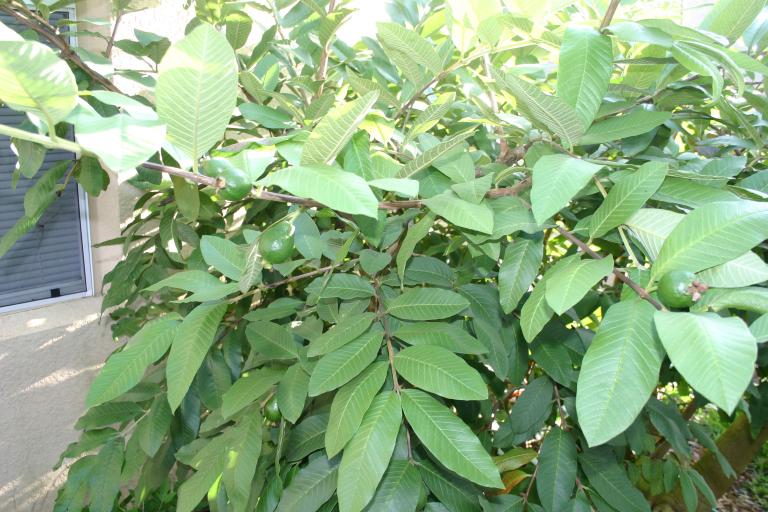

Pink & white guavas, pineapple, and sweet potato – our own fresh picked and fresh dug!
Saturday, August 29, 2015
Yesterday, the display was nice at the Artisan Alley Farmer’s Market. Little puppy Thor was there also! Today, the store and nursery is open 8 a.m. to 5 p.m.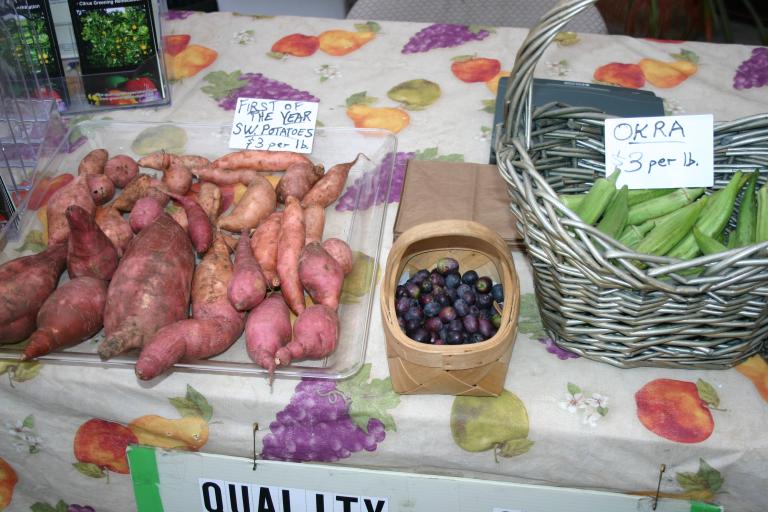
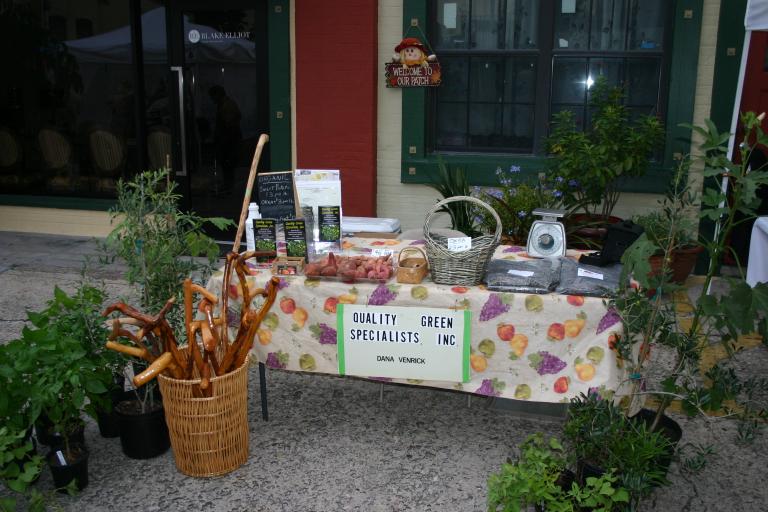
Friday, August 28, 2015
Today is Farmer’s Market Day on Artisan Alley (1/2 block west of the intersection of Woodland Blvd. and New York Ave.) in downtown DeLand. I plan to have fresh-dug organic sweet potatoes and fresh-cut okra. Also, okra plants, sweet potato vines, and Arbequina olive trees with ripening olives! Check out my custom-made canes and walking sticks made from native Florida woods. See you there!
Wednesday, August 19, 2015
Today, I picked the first three pink guavas and enjoyed eating one. It was absolutely delicious! This is the time of year that a lot of fruit ripen at the nursery: olives, cattley guavas, guavas, pineapples, pomegranates, figs, elderberries, Surinam cherries, and Barbados cherries. Soon other fruit will be ripening in the fall: Satsumas , navel oranges, hamlin oranges, persimmons, apples, pears, papayas, carambola (starfruit), and others.
Saturday, August 15, 2015
We are open today 8-5 and so come on out to see our beautiful nursery, plant nutrition store, and garden center. We have over 50 varieties of fruit trees and fruiting plants. The nursery is designed like a botanical park, and so you will enjoy strolling around and seeing fruiting plants you may have never seen before. Like Curry trees (the leaves are used for the original curry powder in India), Imbe trees from Africa, Moringa trees with dynamite nutritional value in their leaves and seeds, three types of Guavas: pink, white, and strawberry/cattley (some with fruit), Feijoa (pineapple guava), Barbados cherries (some with fruit), Surinam cherries, coffee plants, papayas, real olive trees like those grown in Spain (Arbequina and Arbosana varieties) and Greece (Koroneiki variety), pineapples with pineapple fruit on them, avocado trees (some with fruit), pomegranates (some with fruit), okra plants with edible pods, sweet potato plants, Simpson Stopper (native), beauty berry (native), Miracle plant, dragon fruit (Pitaya), Gogi Berry, custard apple, all types of Citrus, peaches, nectarines, plums, elderberries (native), persimmons, apples, pears, kiwi, allspice, blackberries, blueberries, Rosemary, Terragon, Basil, tomatoes, onions, peppers, as well as non-edibles like Crape Myrtle (red, white, pink, purple blooms), ‘Jack Frost’ Ligustrum, fire bush (native), crotons, live oaks (native), red cedar (native), downy jasmine, Camellias, Coontie (native), Sago palm, Butterfly plant, Hibiscus, Turkish Cap, Poinsettia, and others.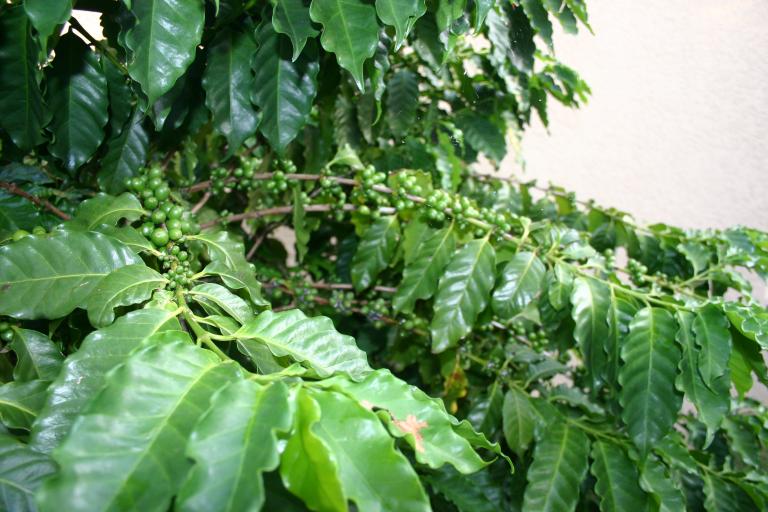

Coffee plants (Arabica) in a protected (from cold weather) location at home in DeBary, Florida. The fruit will ripen this fall. When the cherries turn dark red, we will dry the “beans”, roast them, grind them, and make delicious coffee! The quality of coffee from these beans is very high because I use lots of Azomite® volcanic pumice (O.M.R.I. listed for organic programs) to grow them. Azomite has an amazing composition of minerals including 65% bio-available silicon as silicon dioxide (unlike sand that is silicon oxide) that is lacking in sandy, depleted Florida soils. Azomite is an incredible natural material in many ways, including giving plants high quality nutrition and stress resistance, including promoting protection from diseases, heat, cold, and drought.
Friday, August 14, 2015
Today, the rains came early and heavy. It’s the hot, rainy season in Florida, but fall is coming soon. Now is a good time to start tomato seeds and other warm weather crops for the fall. We are sticking olive cuttings for our fall rooting cycle in our new greenhouse. Today is Farmer’s Market Day at Artisan Alley (6-9 p.m.) in the heart of beautiful downtown DeLand. I’ll have cured and uncured olives from our own trees, sweet potatoes from our own beds, and fresh-picked okra from our healthy, organic plants at the nursery. I took pictures yesterday of the large Seminole pumpkin vine in my landscape and also male and female Seminole pumpkin flowers, as well as pictures of lots of ripening olives on my 20′ tall Arbequina olive tree.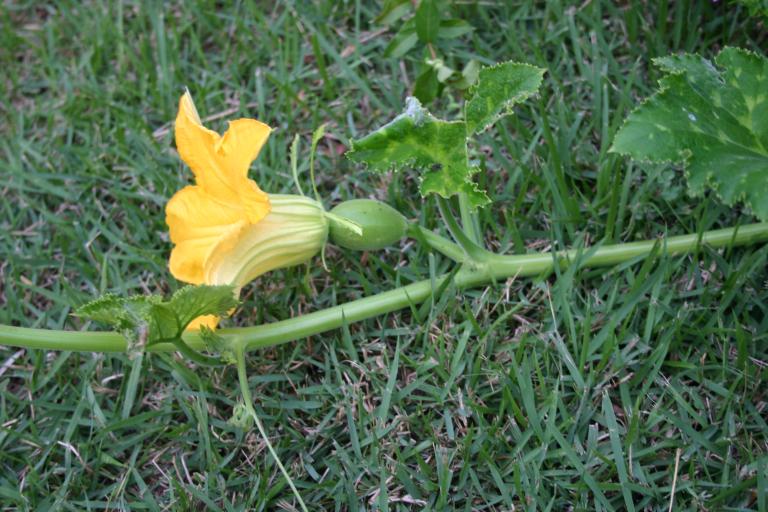
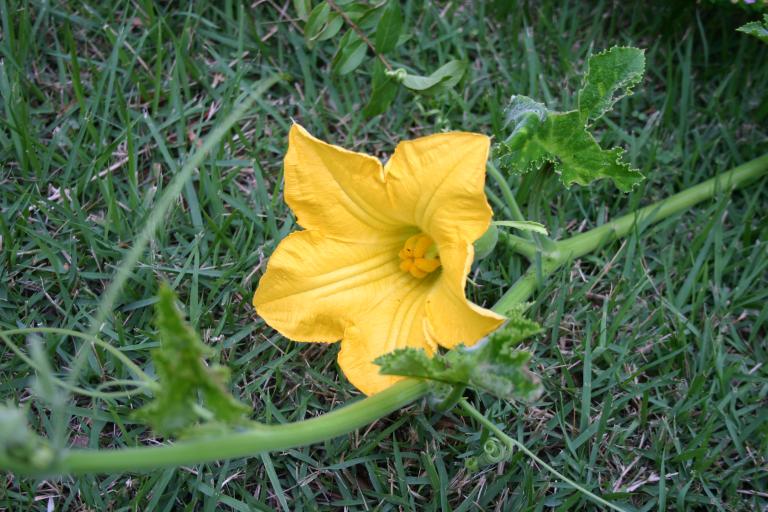
Above two photos: female flower with fruit. Notice the greater complexity of the female flower.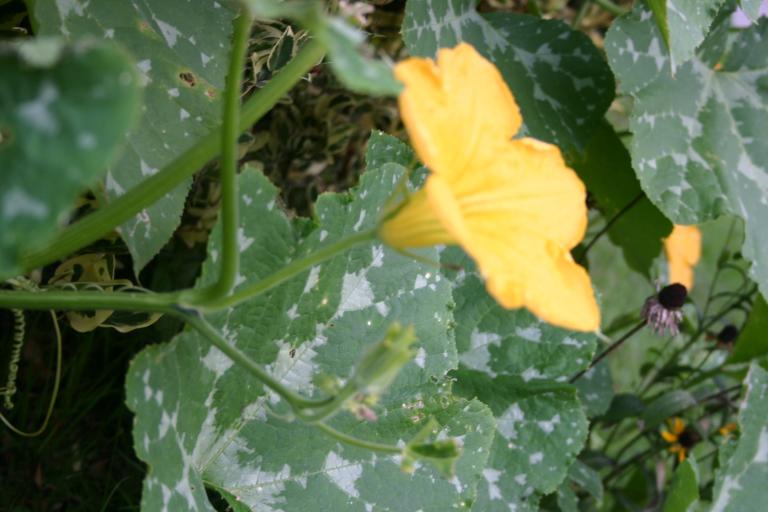
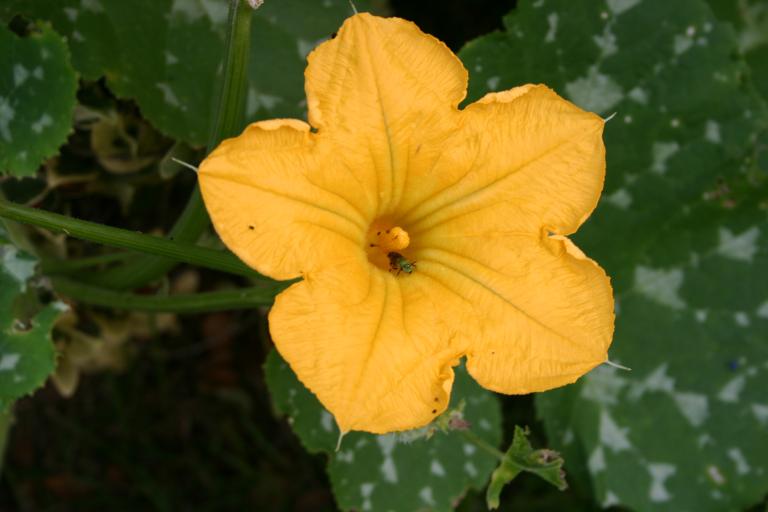
Above two photos: male flower with pollinator.
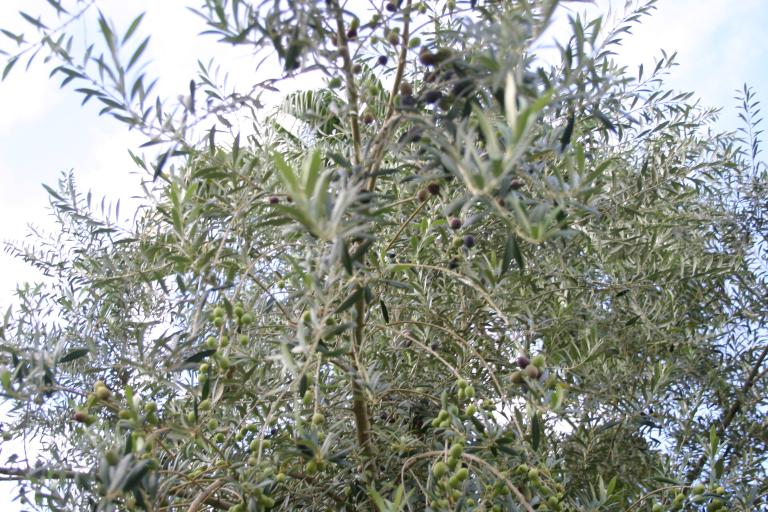
Above two photos: lots of ripening olives on my large Arbequina olive in DeBary, Florida.
Thursday, August 13, 2015
Today, Allen and I worked on a brochure for the company. Below is the section I wrote on our soil, water, and plant tissue testing and our recommendations and crop programs to include remediation of Citrus Greening disease (HLB):
“Our Citrus Greening treatment program works so well because it is based on the most comprehensive & detailed soil, water, and plant tissue testing with easy to follow recommendations and a written, customized program for your Citrus grove. We follow the same high standards when consulting for a wide range of crops, from olives to peaches and more!
We will visit your grove or farm for soil/water/tissue testing and on-site consulting for a reasonable fee. We have the background and experience to give you the best guidance for your special crop. We advise, based on your specific site testing, the best possible plan using the best materials available. Then, we will custom mix the dry fertilizer materials and customize the liquid foliar fertilizers needed – without the use of fillers or bio-solids – and deliver the precise quantities you need for the best, most cost-effective results.
To remediate Citrus Greening, our unique citrus programs include our breakthrough liquid foliar treatment Citra Thrive Plus, rich with organic ingredients like kelp, humic acid, fulvic acid, blackstrap molasses, urea, and strains of beneficial microbes. Along with the organics, Citra Thrive Plus includes added nitrogen, phosphate, phosphite, and BioWash 100 (a high quality penetrant and surfactant) to ensure systemic movement and quickly available nutrition for the entire tree. Targeted liquid organic micronutrients are added to the Citra Thrive Plus – based on our comprehensive testing of the soil and trees – to ensure no limiting elements.
Best of all, our complete nutritional program for your crop is very cost effective, especially when you consider that our recommended materials are 100% nutrition, have slow, steady release to the tree, and build the fertility of the soil, including the beneficial microbes that convert minerals to the ionic form that tree roots absorb. Our recommended inputs are high quality, low salt index materials, many natural and organic. Our recommended materials typically include organic potassium magnesium sulfate (SPM), organic granulated Azomite® organic volcanic pumice mineralizer (O.M.R.I. listed for organic programs), sulfur coated urea (SCU), potassium sulfate (SOP), potassium nitrate, dolomitic limestone (calcium magnesium carbonate), sulfur coated urea (SCU), our own granular organic Super Green 3-0-5 Fertilizer (Florida registration number F395), our organic-based Citra Thrive Plus with a 4-10-10 analysis, and our own ‘3 in 1’ organic liquid fertilizer. Plus, for fast delivery, we stock most of the items we recommend in our own warehouse.
Tuesday, August 11, 2015
Have you considered guavas for your garden or landscape? Well, we have them! We have pink and white guavas, strawberry (cattley) guavas that have smaller (but delicious) fruit, and pineapple guavas (also called feijoa). All have delicious fruit and all are suitable for gardens or landscapes. The feijoa is particularly cold hardy and will give Ligustrums and Vibernums a run for their money for beauty and screening ability any day of the week. The strawberry guava has good cold tolerance in more sheltered locations and is an elegant landscape plant as well. The regular guava is more cold sensitive and requires the most protected locations (but the meaty varieties we grow have absolutely delicious fruit). I have all three in my landscape. I have many other edibles as well, such as beautiful and edible pineapples. We have a ‘Mini-Sweet’ cultivar that has a beautiful bloom as well as bearing a delicious fruit.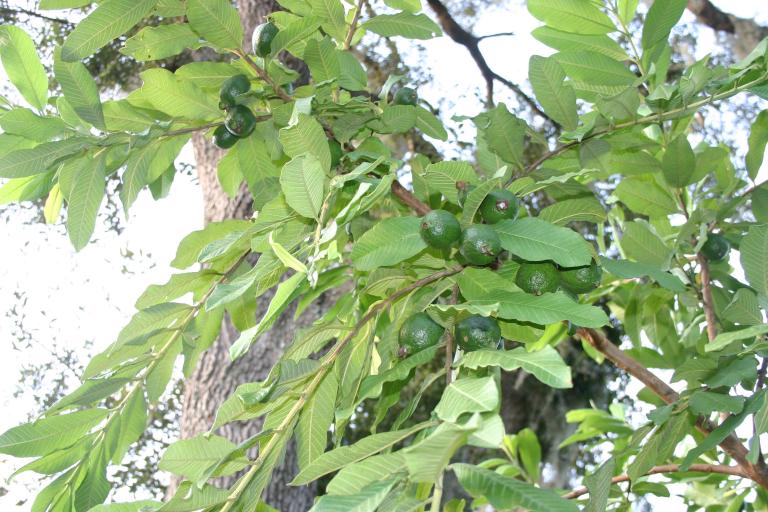
Above: My ‘White Snow’ Mother Guava tree in my landscape protected under an oak tree in DeBary, Florida. With protection from the oak tree and excellent mineral support from Azomite® volcanic mineralizer (O.M.R.I. listed), this tree has survived temperatures as low as 20 degrees Fahrenheit (as measured on my yard thermometer). Note the heavy fruiting even though there is lots of shade! There are several dozen developing fruit on the tree right now. We have nice plants at the nursery that were started from this tree.
Above: Our ‘Mini-Sweet’ pineapple. Note the spectacular red leaf bracts, the blue blooms, and the emerging fruit – it’s a triple treat! We have nice pineapple plants with fruit at the nursery that were started from slips emerging in a large foundation bed of these ‘Mini-Sweets’ on the south side of the house.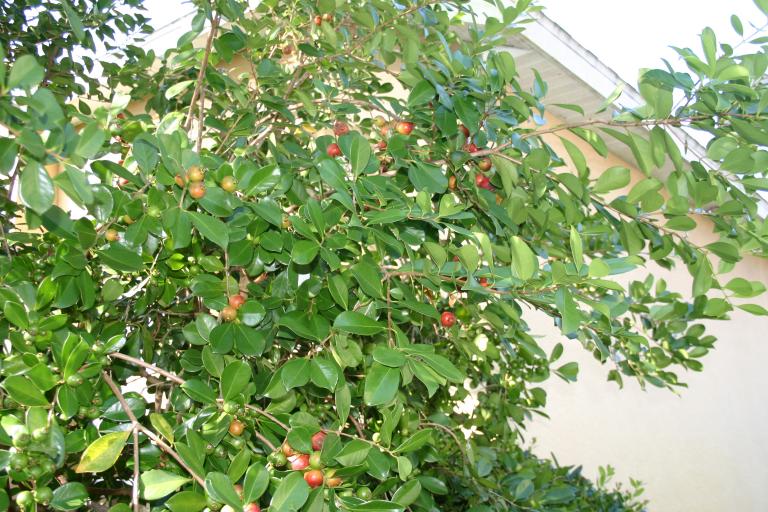
Above: My Mother Strawberry Guava tree that is a corner tree for the right front of the house. I have been picking ripe fruit and selling them at the farmer’s market for a month. It is growing next to my olive tree (that is now also full of ripening olives). We have nice plants at the nursery that were started from this tree. This tree is on the north side of the house and has survived the strong, cold north winds. Azomite and the protecting insulation from the olive tree (out of view to the left side) has helped to keep the tree cold-hardy.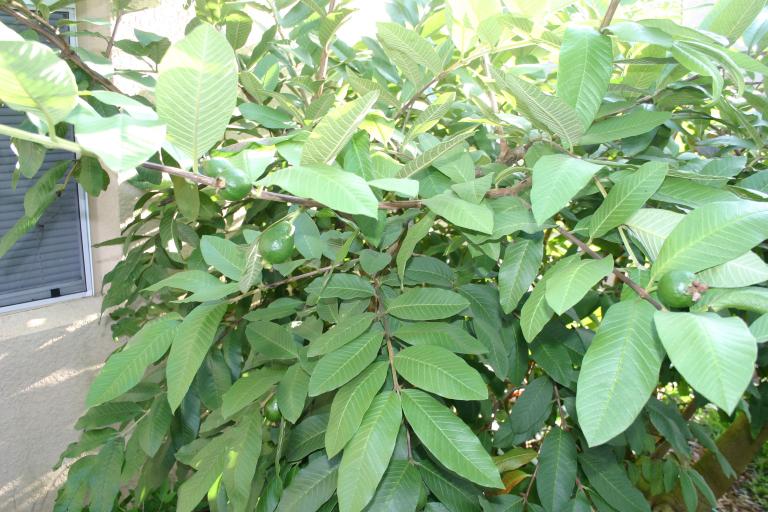
Above: My ‘Meaty Pink’ Mother Guava Tree on the south side of the house. It has a dozen maturing fruit right now. We have nice plants started from this tree at the nursery.
Above: The Feijoa or Pineapple Guava on the left front corner of the house has developing small green fruit. The Feijoa is cold hardy to South Carolina. When mature in the fall, the skin is still green, but the fruit inside is ivory colored and has a delicious, mellow flavor. We have nice feijoa plants at the nursery, which make beautiful landscape plants as well.
Monday, August 10, 2015
Olives are starting to ripen on the Arbequina olive trees at the nursery and my 20′ tall Arbequina olive tree in DeBary. Who would have dreamed of picking olives in central Florida 10 years ago? Now we have a number of olive groves started all over central and north Florida as well as south Georgia.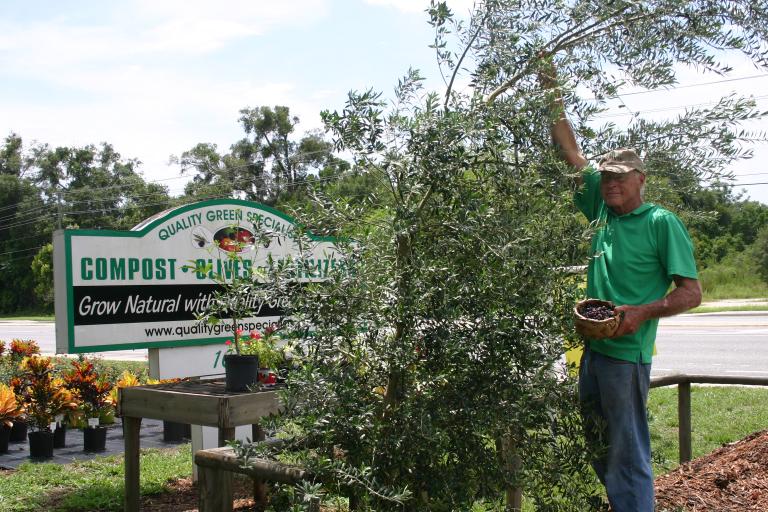

Friday, August 7, 2015
Today is Farmer’s Market Day at Artisan Alley. Look for fresh sweet potatoes, okra, strawberry guavas, and fresh olive fruit. Also, I will have ten pound bags of our great SUPER GREEN 3-0-5 Fertilizer with O.M.R.I. listed Azomite® volcanic pumice, organic potassium magnesium sulfate (SPM), organic humate, and many other organic ingredients – plus beneficial microrganis for promoting strong and sustained nutrient release. Also, I will have 32 quart bags of our outstanding Premium-Blend Compost and composted potting soil. The hours are 6-9 p.m. Artisan Alley is just 1/2 block west of Woodland Blvd., between New York Ave. and Georgia Ave. The latest batch of organic Premium-Blend Compost is now ready. Come by and give it a try, either bulk or by the 32 quart bag. We are well stocked on composted potting soil as well!
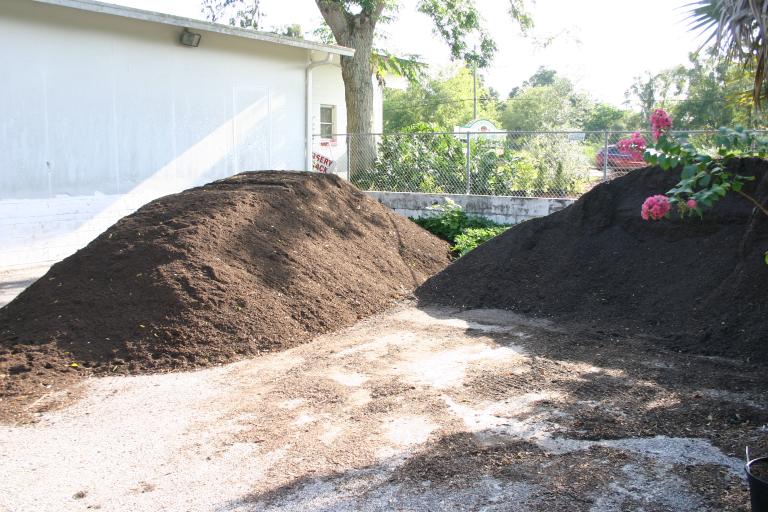
Thursday, August 6, 2015
I gathered 3 gallon Loropetalum (‘Ruby’ cultivar) and 3 gallon Feijoa for a customer order and worked on a formulation for a new “Olive Thrive” product. Olive Thrive, with its high seaweed (kelp) and boosted amino acids to include arginine, is specifically targeted to enhance spring flowering and fruit set. A new batch of Premium Blend Compost is scheduled for release tomorrow or Saturday. 
Wednesday, August 5, 2015
Our Premium-Blend Compost is becoming more and more popular as word is getting around about how well it is working. We go the “extra mile” to ensure that it is well digested and has all the minerals necessary to produce great results for your crop or garden. First of all, only organic, no bio-solid materials are used for the initial composting process. Then, based on a comprehensive standard soil test and a saturated paste test, we add the organic amendments needed to bring the mineral content of essential minerals to sufficiency levels and within reasonable ratios (extreme ratios of minerals cause tie-ups). Plus, we add live beneficial microorganisms to ensure the best possible mineral release. Then the compost undergoes a second digestion process. This “double composting” with added beneficial microbes makes our compost superior in multiple ways.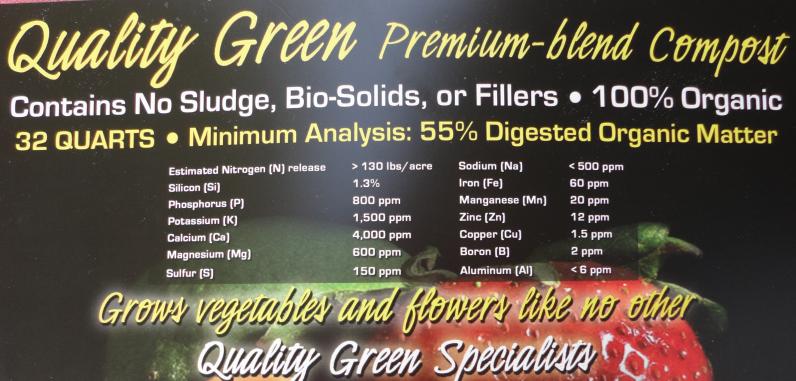
Monday, July 3, 2015
Sticking the first olive cuttings in our new propagation house. Pictured are Alex Andrews closest to the camera and David Wiggins.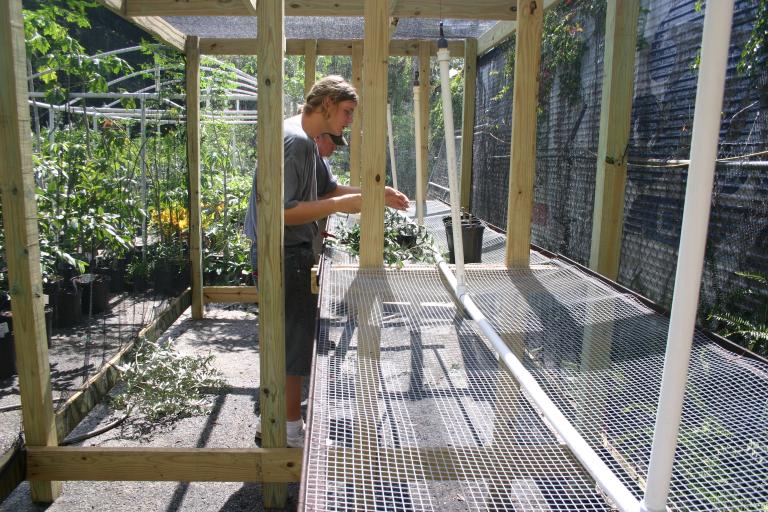
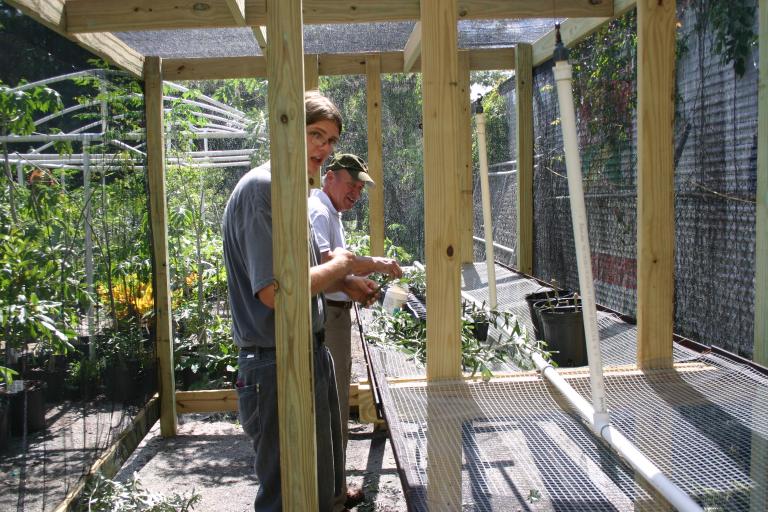
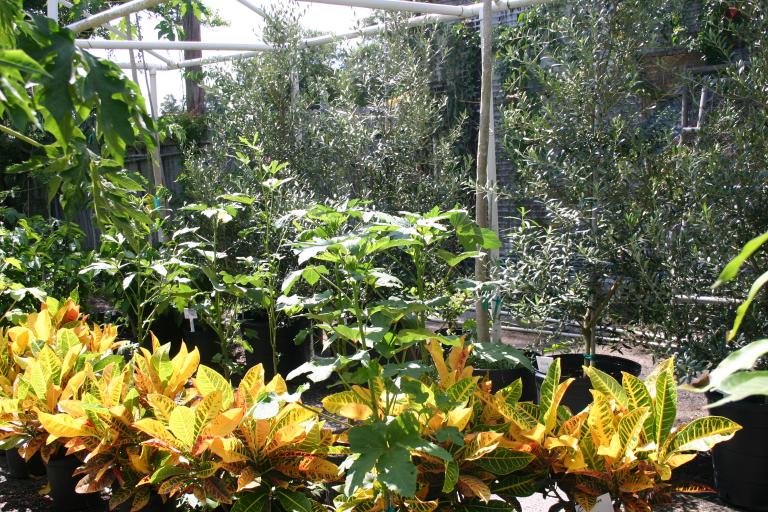
The greenhouse display is looking good with colorful crotons, okra with delicious pods, and big 15 gallon olive trees with lots of fruit!
Friday, July 31. 2015
Today is Farmer’s Market Day. See you from 6-9-p.m. in the heart of downtown DeLand at Artisan Alley Farmer’s Market (between New York Ave and Georgia Ave., 1/2 block west of Woodland Blvd.). Look for Strawberry Guavas, Okra, Seminole Pumpkins, and Sweet Potatoes, as well as olive trees, sweet potato plants, and okra plants. Here are two photos taken of the nursery today. One of the large olive section on the south side and one of the newly decorated Green House: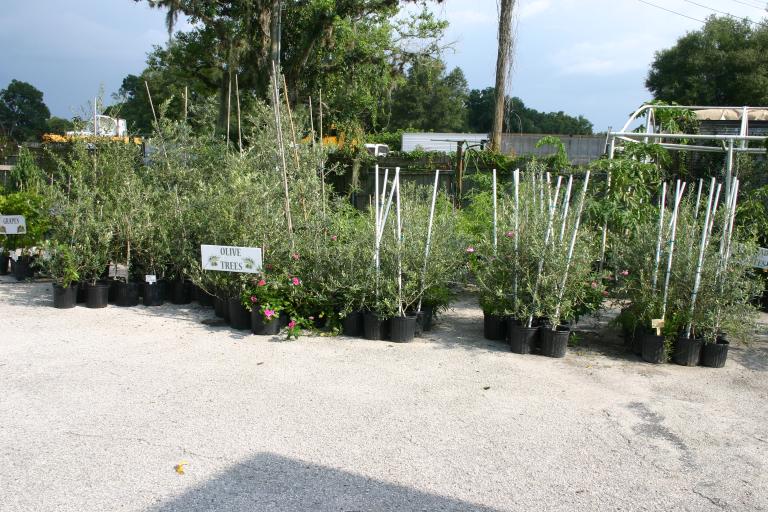
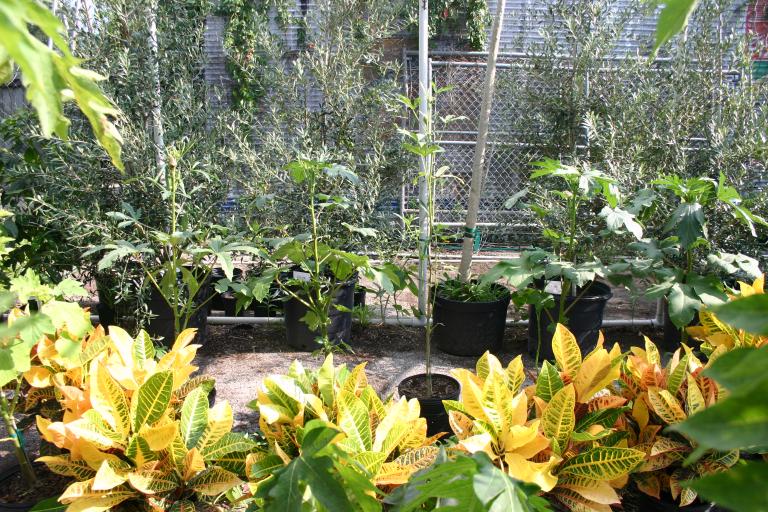
Above from front to back: Petra crotons, Clemson Spineless Okra, and 15 gallon size fruiting olive trees.
Thursday, July 30, 2015
Alex and I are re-building our “Air Garden”. This time it will be simpler and stronger. We removed the old garden today and will start on the new garden tomorrow. This is how the Air Garden looked when it was constructed the first time (shown is Alex Andrews watering the newly planted garden):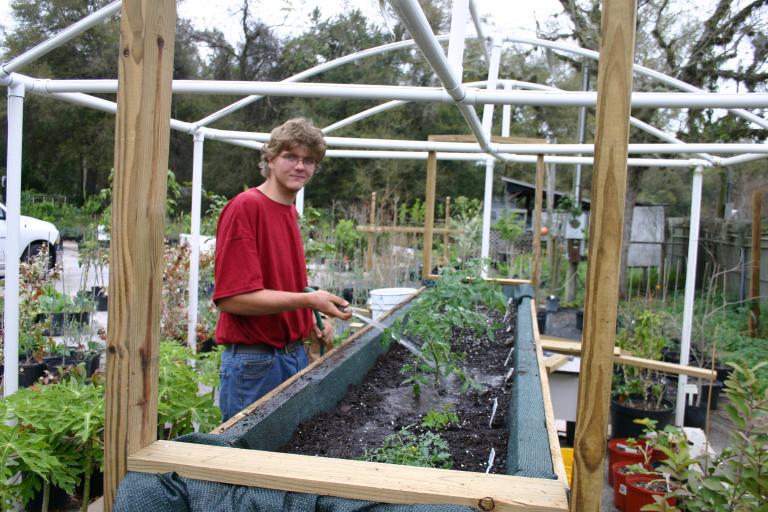
Wednesday, July 29, 2015
Delivered Azomite® silicon dioxide rich volcanic pumice, our SUPER GREEN 3-0-5 Fertilizer, potassium magnesium sulfate, and a special liquid foliar fertilizer to a new olive grower in Winter Haven, Florida. He has a few olives in his second year!
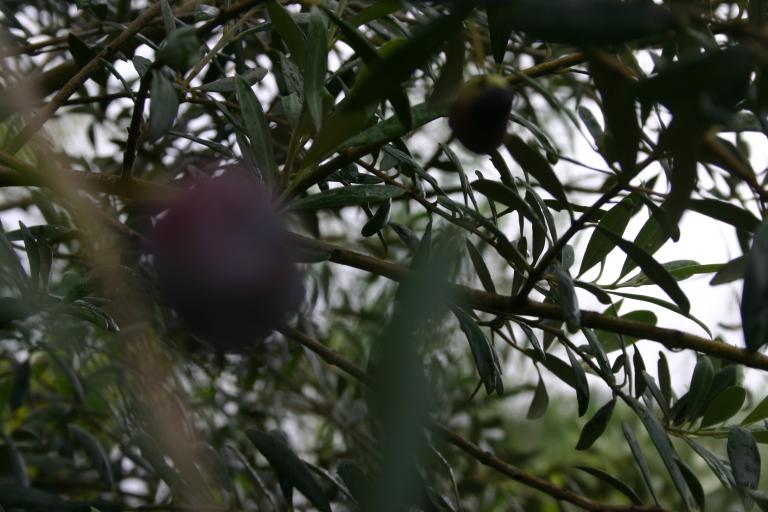
Tuesday, July 28, 2015
The new propagation house is finished. I call it the “Floating Propagation House” because it looks very clean without the usual bulky straps attaching the shade cloth to the structure. Also, a new Guava Section with concrete pillars that serve as tie-down support columns for two tall guavas and gallon container holders on top for four each of ‘Meaty Pink’, ‘Snow White’, and Strawberry (Cattley) Guavas.
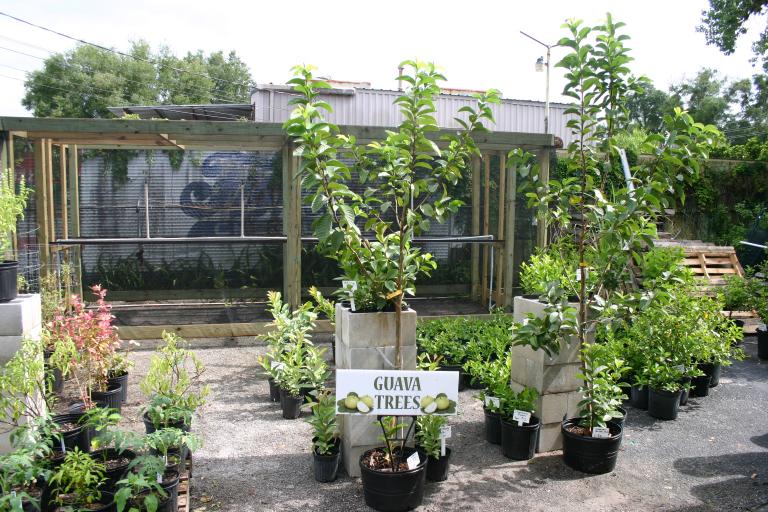
Friday, July 24, 2015
Want to see how many olives you can have after a few years? This dooryard tree planted in 2006 in DeBary, Florida is now 20 feet tall and probably will have 20 pounds of olives on it this year.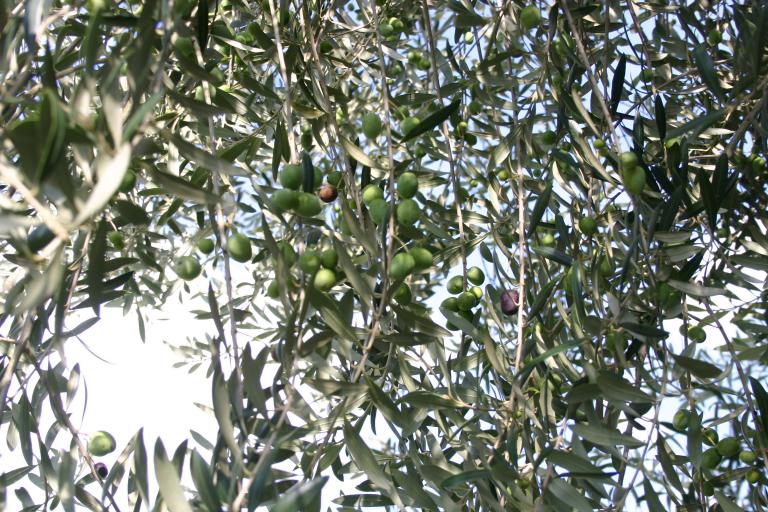
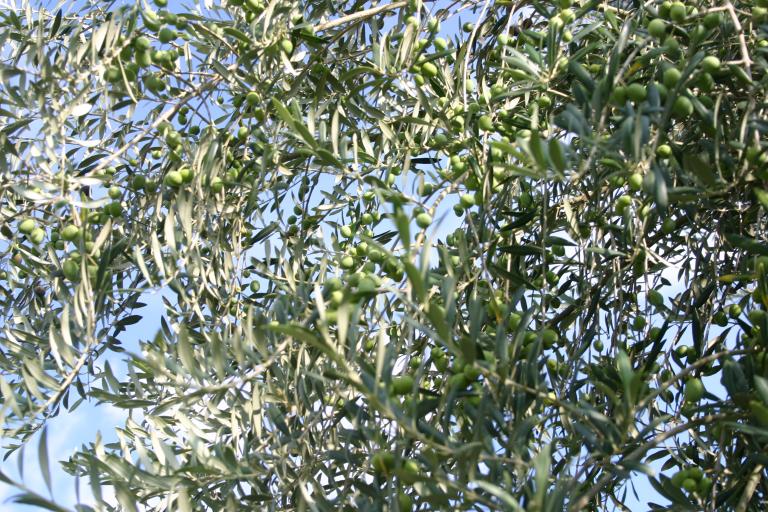
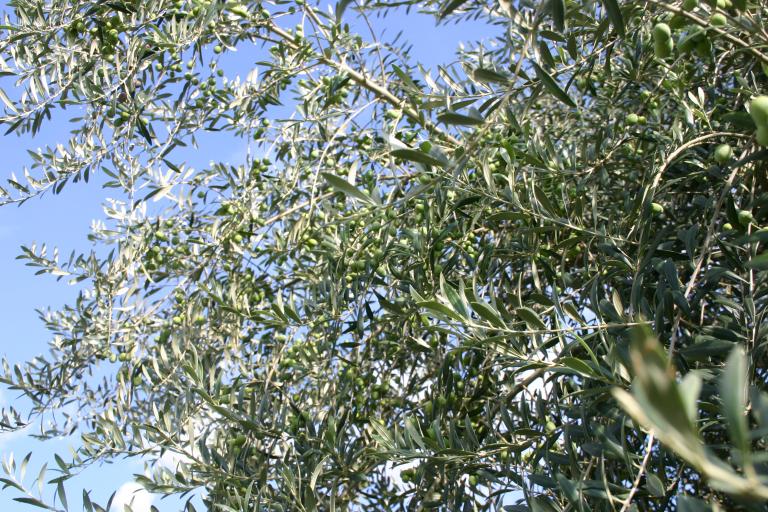
Come by the Artisan Alley Farmer’s Market in downtown DeLand tonight between 6-9 p.m. and check out our olive trees with real olives, sweet potato plants, and okra plants, plus some of our great 3-0-5 fertilizer in 10 pound bags. I will have some fresh okra, Seminole pumpkins, and perhaps we will dig some fresh sweet potatoes as well. For directions, call me at 386-837-3878. P.S. Watch the bats come out of two bat houses at dusk!
Thursday, July 23, 2015
Come by and visit our beautiful nursery and see over 50 varieties of fancy fruit trees, fruiting plants, and vegetable plants (sweet potatoes, Seminole pumpkins, Everglades tomatoes, and Clemson spineless okra for the summer) – plus the herbs rosemary, terragon, and basil. See our innovative “floating propagation house” with an open, airy appearance with no visible tie-downs. You have to see our fruiting olive trees!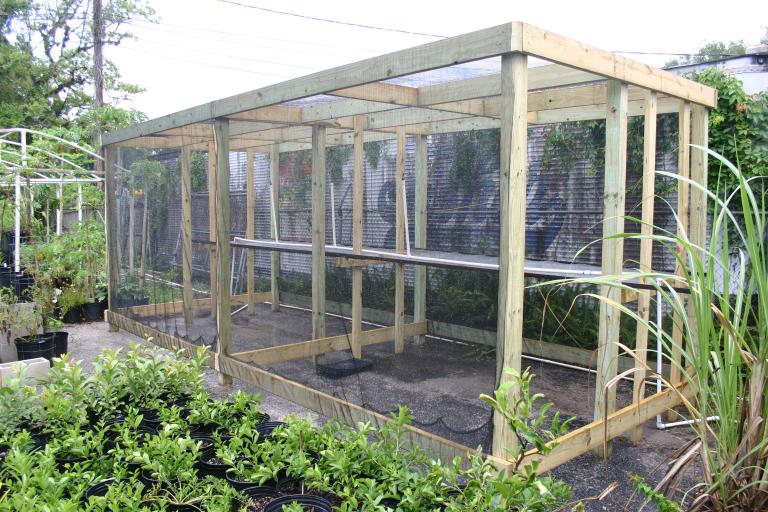
Almost finished!
Monday, July 20, 2015
We are seeing good recovery in groves treated with our Citrus Greening treatment that includes Citra Thrive Plus and needed micronutrients.
Below is co-owner Allen Day in a grove where treatment started early this spring. The trees have gained canopy density, re-greened, and have a bumper crop of big, uniform-sized fruit for this time of year.
Below is Allen Day in an untreated grove that has received lots of cheap, incomplete fertilizer full of heavy metals and toxins. The only thing growing well are the poisonous nightshade and balsam pear (Momordica).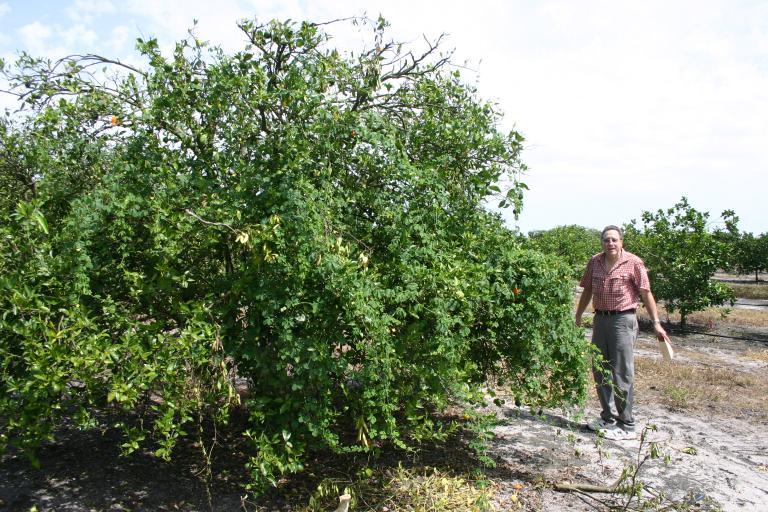
Saturday, July 18, 2015
Alex and I almost finished the new propagation house today. The mist sysem is completed. Most of the shade cloth has been wrapped and secured. One more wrap to cover the ends of the house and we will be ready to root cuttings.
Friday, July 17, 2015
Today is Farmer’s Market Day at Artisan Alley. There will be some okra, Seminole Pumpkins, and perhaps some sweet potatoes (if not today, soon). Check out our Arbequina olive trees with lots of olive fruit, sweet potato plants, and okra plants ready to produe bountiful harvests for weeks! Artisan Alley is 1/2 block west and 1/2 block south of the main intersection in downtown DeLand, New York Avenue (S.R. 44) and Woodland Blvd. (U.S. Hwys. 17-92). See you there!
Wednesday, July 15, 2015
Yesterday, Allen Day and I visited several orange groves affected by Greening that are now showing good recovery. All this in a few weeks following our complete testing and recommended treatment program, including our great nutritionals. Shown is Ron Kelly in his beautiful grove. The re-greening of the trees and a large crop of fruit with good size for this time of year is remarkable.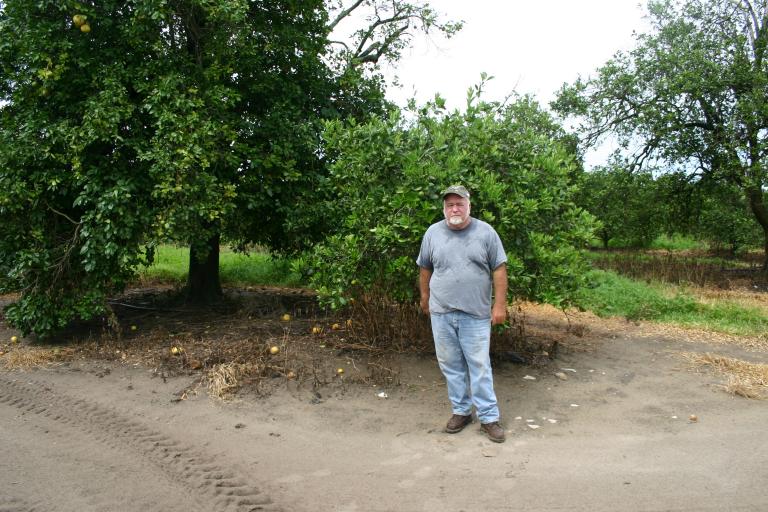
Ron Kelly with his recovering trees: A couple of months ago these trees were looking sick and chlorotic. Now they are looking green and healthy. Ron says his fruit now are the size they were at picking time last year. Thanks to potassium sulfate (not muriate of potash/potassium chloride) and other targeted products and our easy, effective treatments.
The grove is regaining canopy density and has a healthy green glow. Click on “Citrus Greening Answers” (third tab on left) to see how the tree and grove looked in February, 2015.
Monday, July 13, 2015
The heat is on – July heat that is with very little rain this past week. It has been a concerted effort to keep things looking beautiful:
Watering has been job one: David Wiggins watering:

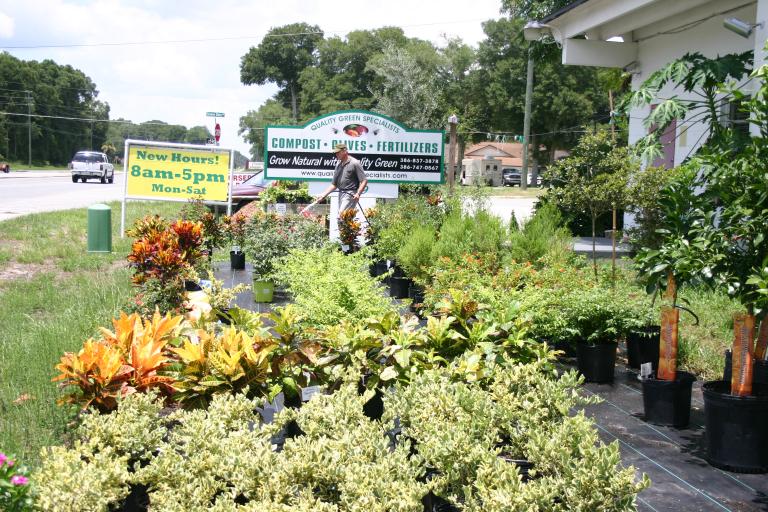
Some special views of the nursery this week:
A big beautiful pineapple: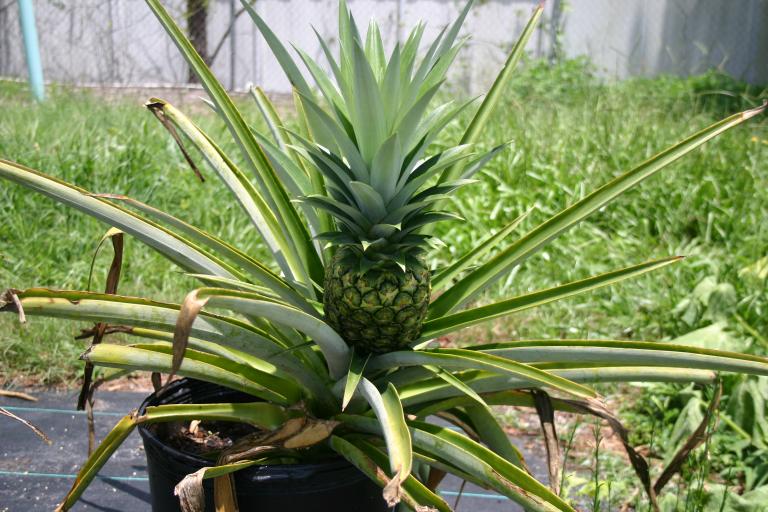
It’s red and white with a red periwinkle (Vinca) and a white cotton bloom. I forgot to put the blue plumbago in the picture!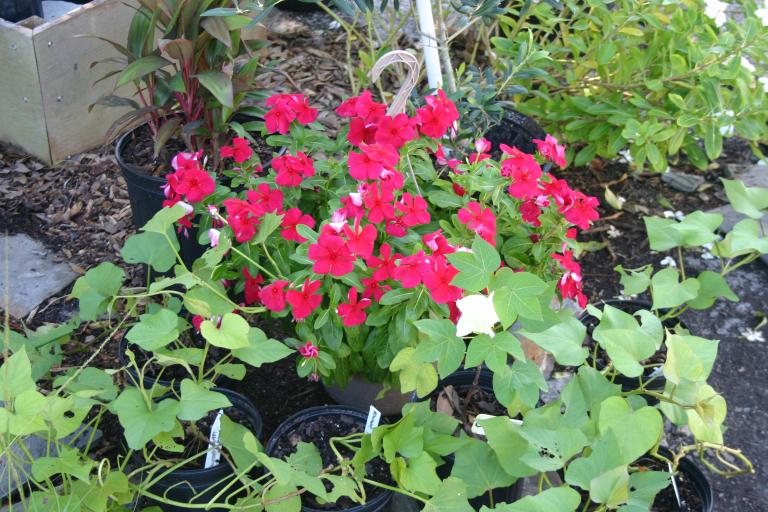
The Crape Myrtles bring summer color: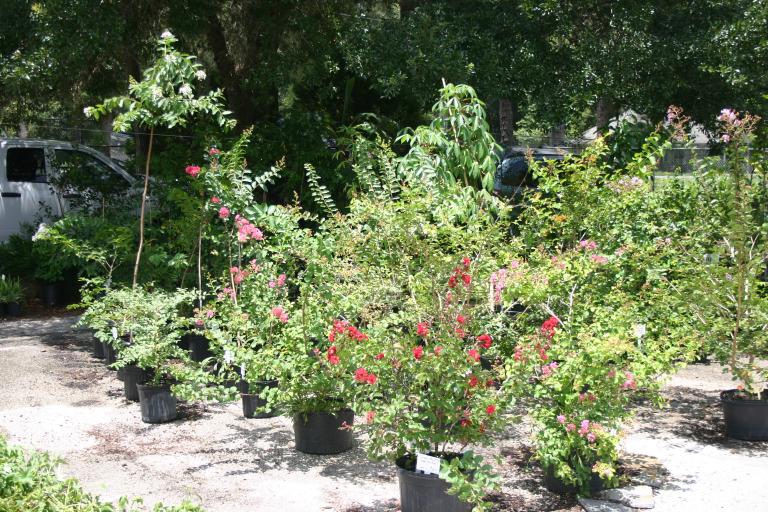
Citrus trees are looking great!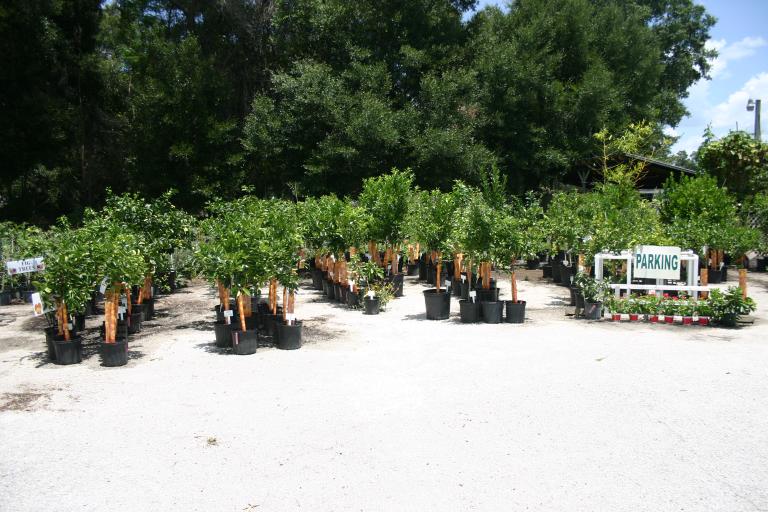
The Nursery entrance looks inviting:
Three gallon sugar apples are growing: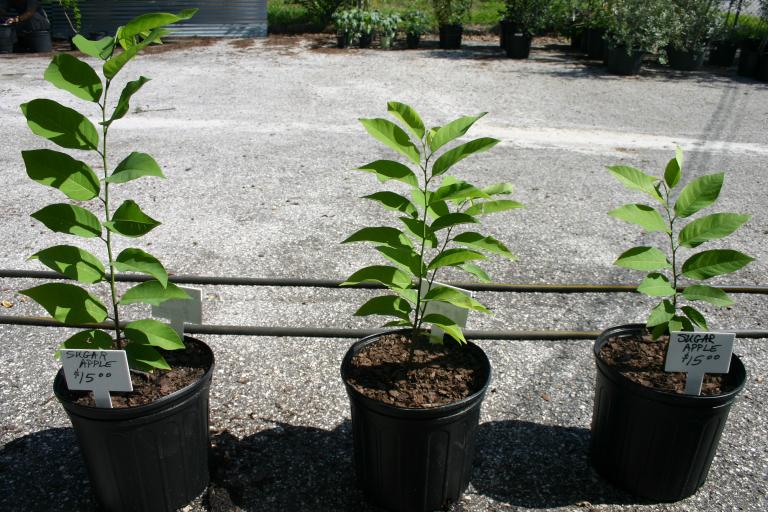
Friday, July 10, 2015
Today is Farmer’s Market Day at Artisan Alley in DeLand. I will be there with the first of the summer okra, some cherry tomatoes, Seminole pumpkins, olive trees, and sweet potato plants. Soon sweet potatoes will be ready for digging! The Artisan Alley Farmer’s Market is from 6:00 p.m. to 9 p.m. and is located between Alabama Avenue and New York Avenue (S.R. 44) and is 1/2 block west of Woodland Blvd. (U.S. Hwys. 17-92). See you there for fresh organic goodies!


Thursday, July 9, 2015
I noticed a post that says baking soda (sodium bicarbonate) makes tomatoes sweet. That is true to an extent, but sodium can easily be a problem in the soil and to plants grown in high sodium (salty) soils. Potassium is the number one mineral to sweeten tomatoes. Potassium and sodium are taken up identically by tomatoes and plants in general; however, potassium is essential in large amounts (the mineral taken up by plants in the highest amounts) and only small amounts of sodium are essential. Naturally mined potassium magnesium sulfate (SPM) is in our 3-0-5 fertilizer in the greatest amount because of the high potassium and the essential secondary minerals magnesium and sulfur. Potassium is the main mineral for promoting protection from plant diseases and for the maturation of fruit including optimum size, quality and high sugar content of the fruit. Potassium content in the soil water should be 15-20 parts per million (ppm) and the total amount in the soil should be 100 ppm or more for better soils. Potassium should be at least twice as much as sodium in the soil or sodium toxicity is likely to occur. Potassium should be 5-8% of the content of minerals in the soil with a positive charge. Over 3% sodium can be very toxic to plants.
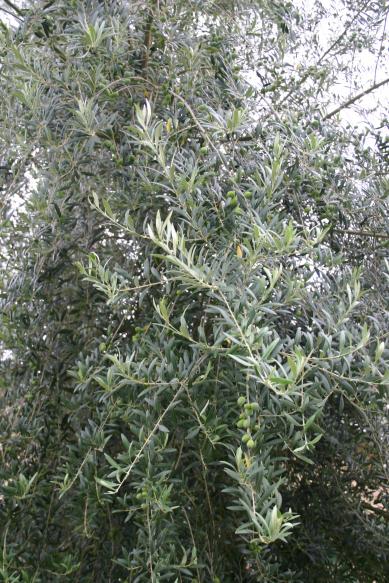
This is how beautiful an older olive tree can be. It was planted in 2006 and is now over 19 feet tall. Not only that, it is full of olives! Photos taken July 7, 2015 and June 29, 2015.
Wednesday, July 8, 2015
I made a lot of progress on the new 8′ by 20′ propagation house as you can see below:
Crape myrtles are starting to bloom:
The summer rains are giving the okra a boost: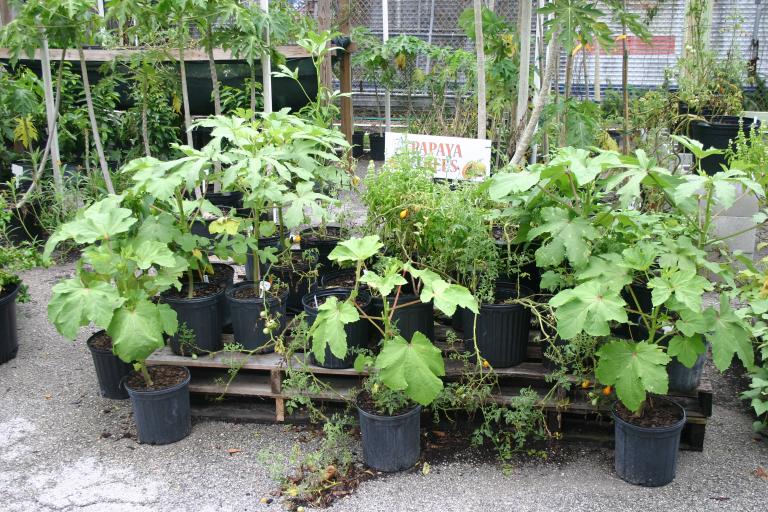
Tuesday, July 7, 2015
Plan to come early in the day to shop at our beautiful nursery and plant nutrition store – beat the heat and the summer afternoon rains! Mention that you saw Dana’s blog post and receive 10% off all your total purchase!
Monday, July 6, 2015
There was a big rainstorm today – just what we have been looking for. We are building a new shade house for the propagation of cuttings and seedlings. It is a strong shadehouse built with 4″ x 4″, 2″ x 6″, and 2″ x 4″ lumber. The rains are delaying construction, but the rains are a good thing! I’ll post a photo soon. Here’s how the blueberries, grapes, and olive trees in the nursery are looking:
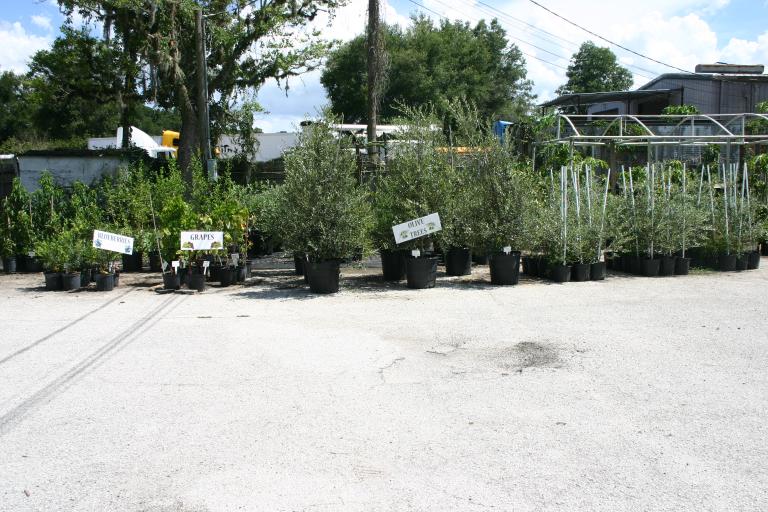
Monday, June 22, 2015
The “pumpkin patch” (Seminole Pumpkins) and the Nursery are both looking good.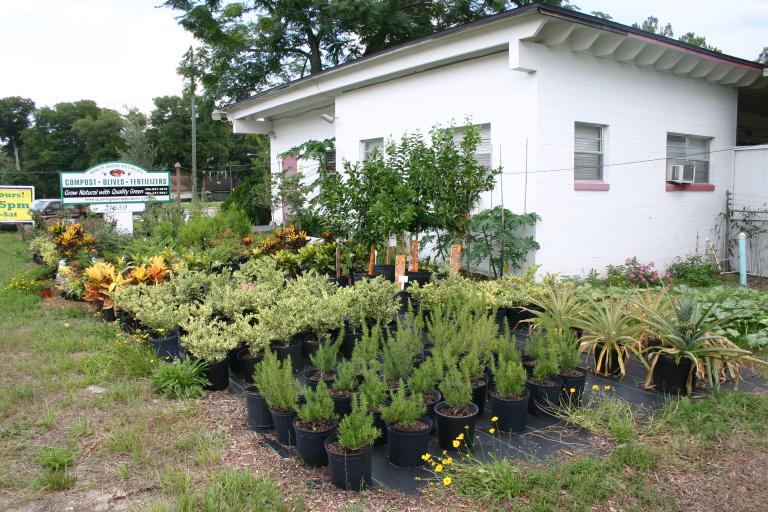
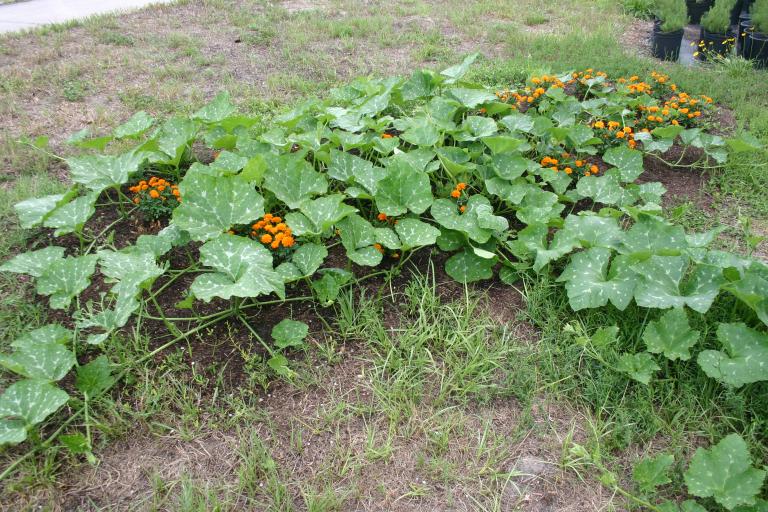
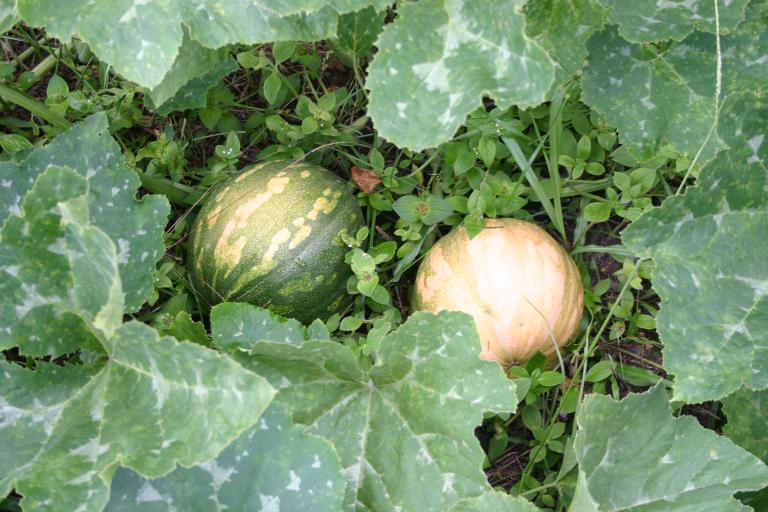
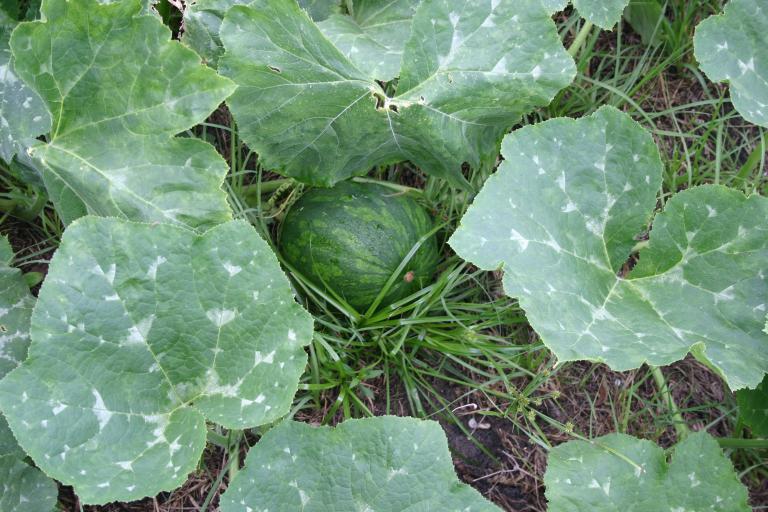
Saturday, June 20, 2015
Finally the rains have started. I didn’t even mind getting a lttle wet at the Farmer’s Market last night. Calabaza squash, tomatoes, olive trees, and super nice Clemson Spineless okra plants were the hits of the night. See for yourself how healthy and dark green these okra plants are grown with good nutrition. They have already started producing pods at this early age!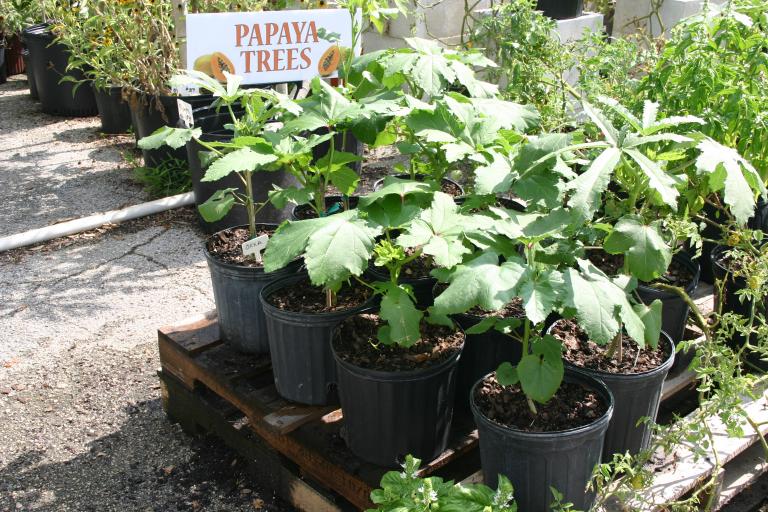
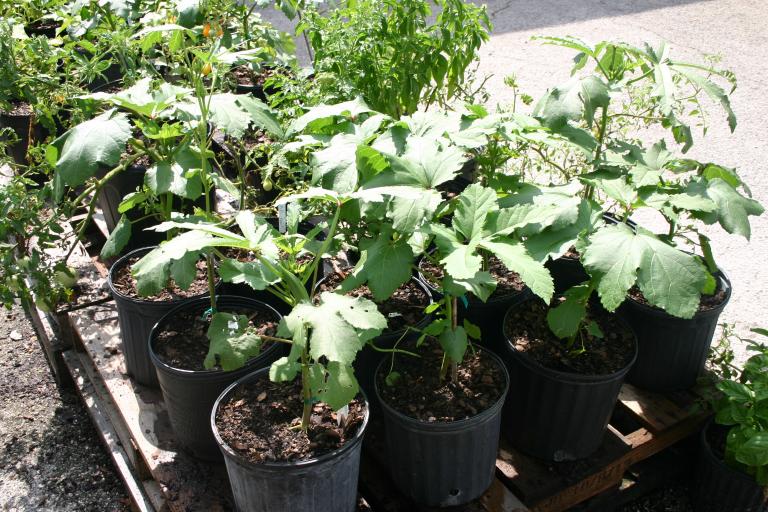
Thursday, June 18, 2015
Remember, tomorrow I will be at the Artisan Alley Farmer’s Market in the heart of downtown DeLand from 6-9 p.m. I will have Calabaza squash, tomatoes, sweet potato plants, okra plants, and olive trees. What a great meeting Monday at the Central Florida Tropical Fruit Society at the Eastside Market on Corine Drive in Orlando. The society members were very receptive and appreciated learning how to remediate Citrus Greening Disease (HLB).
I spent many hours making this presentation very informative, insightful and interesting. I would be happy to give this or a similar presentation to your club or organization. Call me today at 386-837-3878.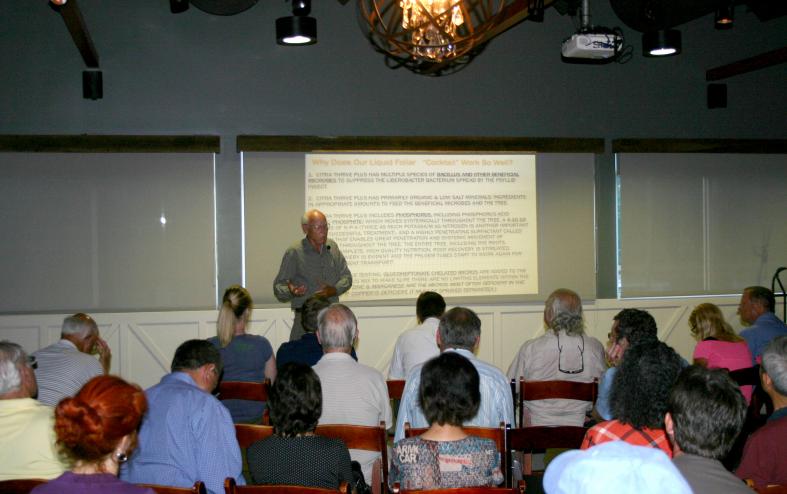
Monday, June 15, 2015
This evening at 7 p.m. I am giving a presentation on how to grow healthy Citrus even with the presence of Citrus Greening. The talk will be at the Eastside Market, second floor. The address is 32001 Corine Drive, one mile east of Leu Gardens. You will learn how we test the soil and plant tissue in mutiple ways and, based on the comprehensive testing, how to properly amend the soil and use quality foliar sprays on a regular basis. Below is how your trees can be brought back to a healthy, productive condition. In a few weeks, this grove went went from weak, chorotic trees to healthy green trees by using the proper nutritionals.
Above: Orange trees have recovered with remedial treatment of needed fertilizer and Citra Thrive Plus. Photo taken May 18, 2015.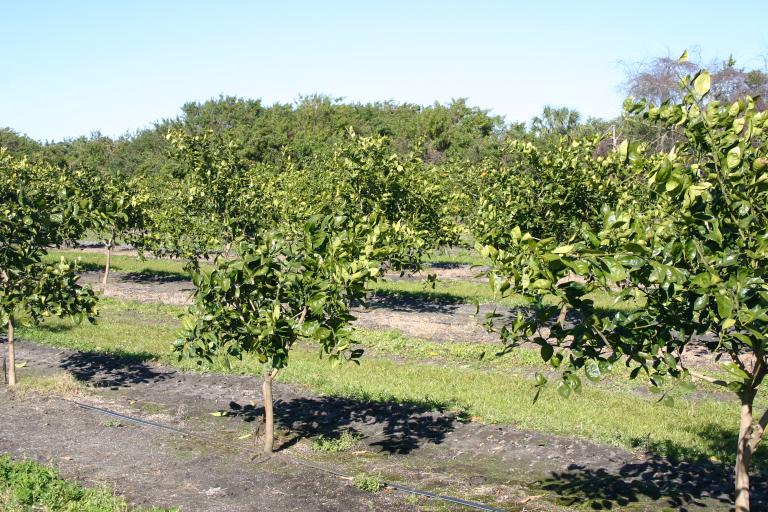
The same orange trees before remedial treatment was initiated. Photo taken February 18, 2015.
Monday, June 8, 2015
I’m back on line after a computer crash. The olives are coming along fine and the nursery is looking beautiful. We had lots of tomatoes and calabaza squash at the Farmer’s Market Friday evening.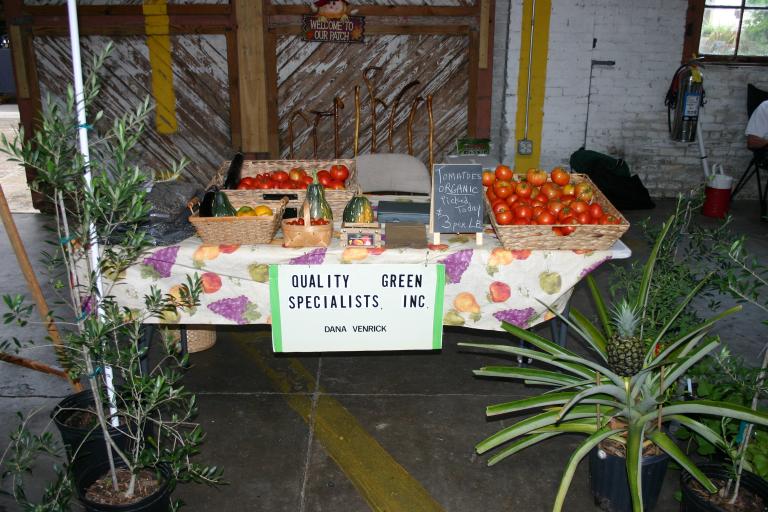
Friday, May 8, 2015
Quality Green Specialists is open today from 8-5. Come by and see our newly re-decorated nursery with lots of new plants and fruit trees. Peaches, bananas, Citrus. olives, Surinam cherries, Barbados cherries, blueberries, blackberries, avocadoes, papayas, Moringa, mulberries, elderberries, pecans, cassava (yucca), figs, beautiful blooming red knockout roses, three varieties of crotons, firebush, firecracker bush, ‘Jack Frost’ Ligustrum, downy jasmine, rosemary, tomatoes, peppers, sweet potatoes, and many more! Come by and see why we won “Best Fruit Tree Supplier” in the reader’s poll, Best of the West in the Daytona Beach News Journal.
Tonight is Farmer’s Market night at Artisan Alley and I’ll be there from 6-9 p.m. to greet you with some fresh home-grown edibles and some nice plants grown at the nursery. Artisan Alley is in downtown DeLand, just east of the main intersection of U.S. Hwys. 17-92 and S.R. 44 (Woodland Blvd. & New York Ave.) behind the Beacon newspaper office. Enjoy the best beverages at the Nest, great food at Dally in the Alley, and craft beer at Persimmon Hollow. As an added fun feature for you and the children, watch the bats come out of two bat houses at dusk.
Wednesday, May 6, 2015
We have lots of small, green (unripe) olives on the Arbequina olive trees. Come visit Quality Green’s Nursery and see for yourself.
Tuesday, May 5, 2015
New! Three types of Crotons and red Knockout roses!
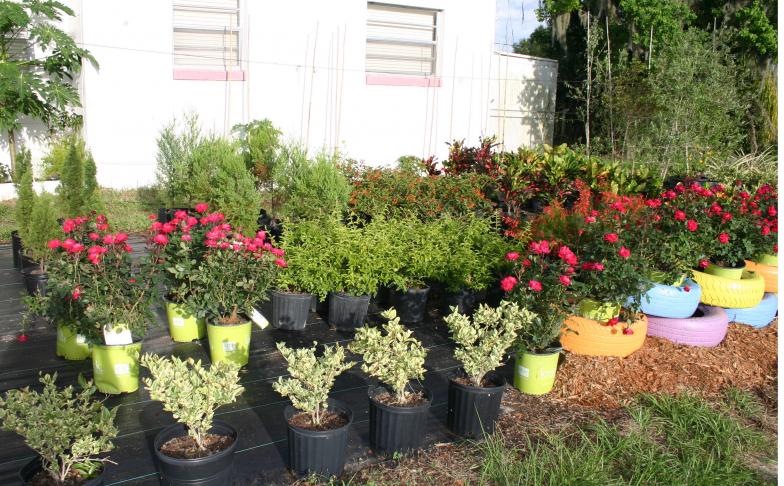
Monday, May 4, 2015
The Nursery is looking beautiful and the selection of fruit trees and fruiting plants has never been better. Come see for yourself.
Saturday, May 2, 2015
What a difference a day makes. Check out our fresh new displays at the nursery and my display at the Artisan Alley Farmer’s Market last night.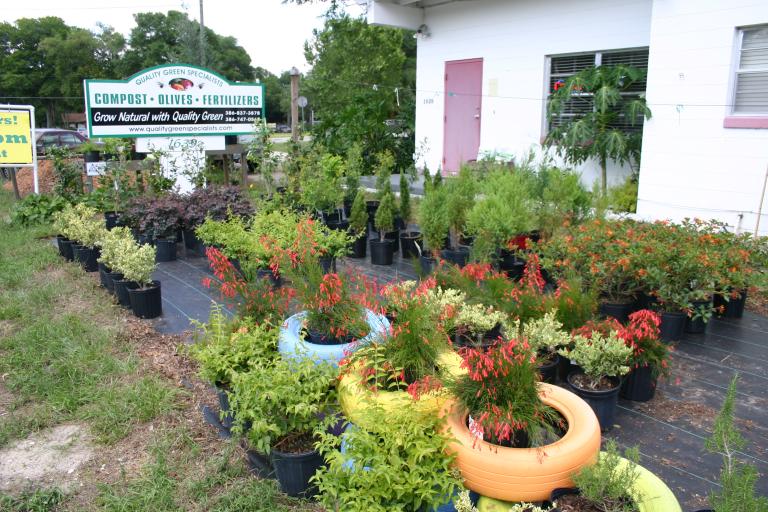
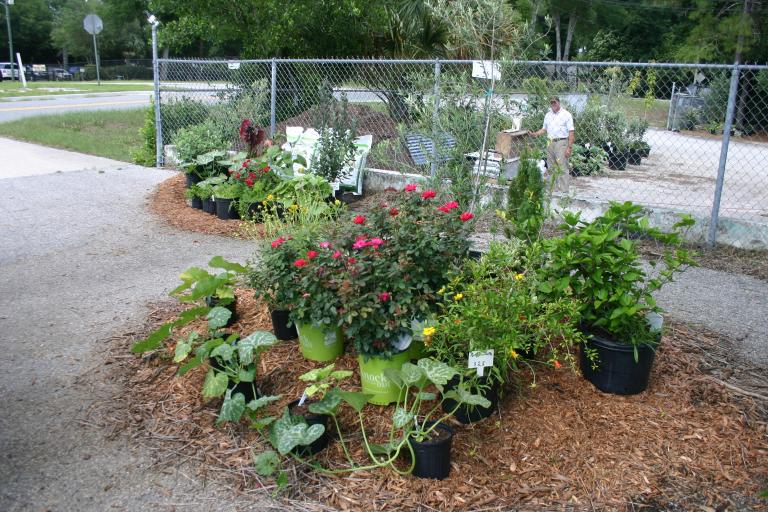
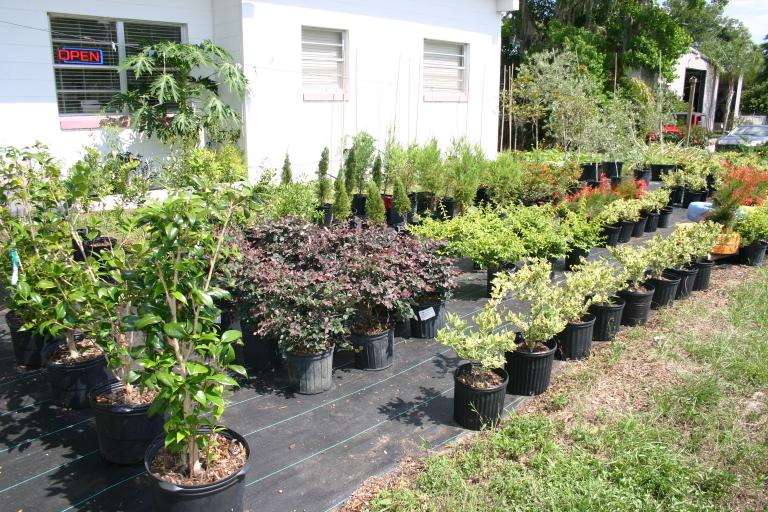
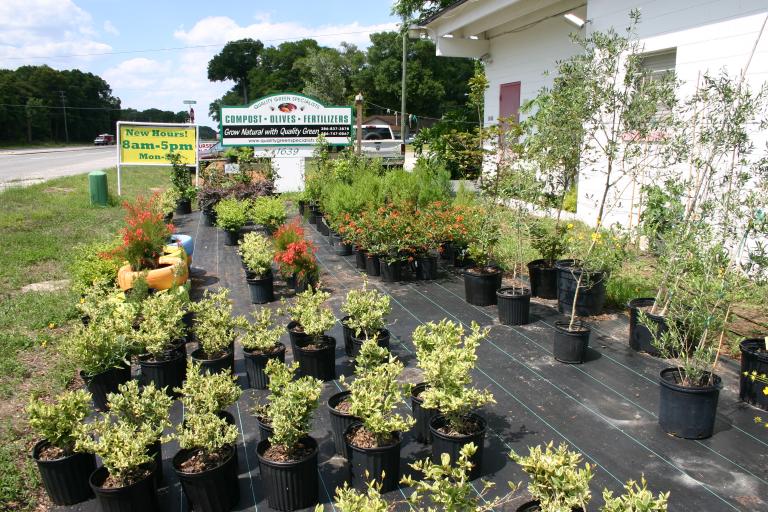
Monday, April 27, 2015
Visit our beautiful fruit tree & fruiting plant nursery this week and you will be amazed by our collection of edibles. For example, our selection of Citrus trees has never been better.


Monday, April 20, 2015
We freshened the displays at Quality Green’s Nursery. Come visit us soon and enjoy a beautiful collection of plants. This is inspiration to include some edibles in your landscape design!
The bed above includes a fruiting Arbequina olive as an accent along with a blooming pomegranate on the back right and a border of vining summer squash. Also in the bed are knockout roses, black-eyed susan, hibiscus, and Italian cypress.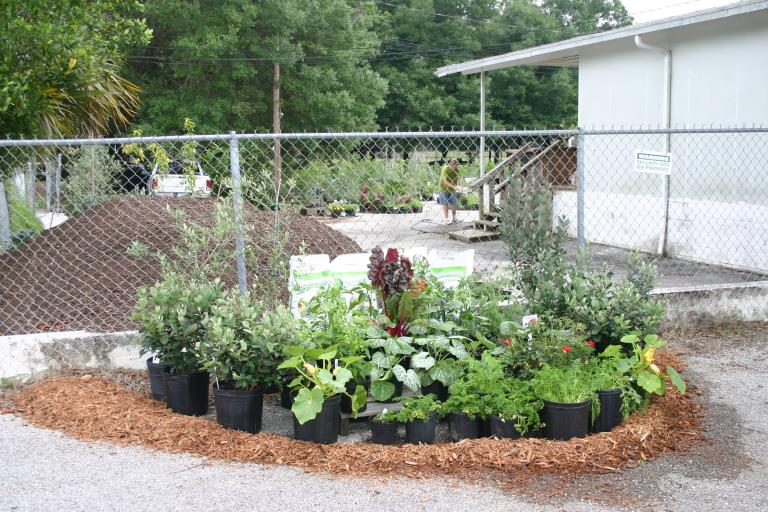
This new bed includes all edibles except one knockout rose. The plants framing the bed look like shrubs but these have edible fruit. They are cold-hardy feijoas, also called strawberry guavas. They make great landscape shrubbery and the fruit are delicious to eat in the fall as well. Also in the bed are carrots (fern-like look in front), parsley (front border), a big red Swiss chard in the back middle, and peppers and tomatoes around the Swiss chard. Who says vegetables can’t help make a beautiful landscape display?
Friday, April 17, 2015
Yes, we have pomegranates and blueberries too. Easy to grow, each in their own way. Pomegranates like a higher pH soil with more alkaline minerals. We have 3-0-5 Fertilizer and Azomite to make growing pomegrantes easy! Blueberries like less alkaline minerals and more organic matter. We have great compost, potting soil, humic acid, fish emulsion and a blueberry special fertilizer that release ammonium form nitrogen that blueberries require. The pomegranates are blooming now and starting to form fruit. The blueberries already have lots of ripe fruit ready to eat and enjoy!

Thursday, April 16, 2015
Does Quality Green Specialists’ Nursery have a good selection of peaches? You bet! As well as vegetables and over 50 varieties of fruiting plants and fruit trees. Citrus (many varieties), Fruiting Arbequina, Koroneiki, and Arbosana olive trees now with fruit, Avocadoes, Pomegranates, Blueberries (several varieties for pollination), Figs, Carambola (Starfruit), Guavas, Surinam & Barbadoes Cherries, Papayas, and so much more. Plus the best nutritional products anywhere, including the best natural mineralizer, Azomite® volcanic mineralizer (O.M.R.I. listed for organic uses). Come see us today. We are open Monday through Saturday 8 to 5.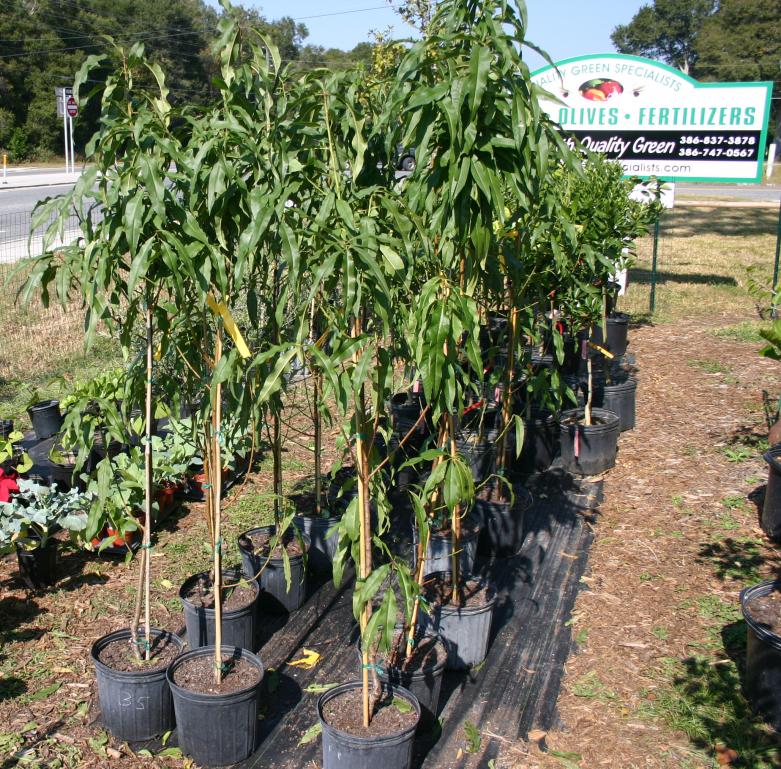
Monday, April 13, 2015
Another challenge for Citra Thrive Plus (Citra Thrive 4-10-10 with BioWash100). This “hungry” mineral-deficient grove in Ft. Pierce is impacted by the phloem clogging induced by the Liberobacter, spp. bacterium helping to cause the Citrus Greening Disease (HLB). This week CitraThrive Plus (along with three deficient micronutrients as very bio-available glucoheptonate chelated form that we documented to be deficient by our comprehensive, detailed testing) is being put to the test. Citra Thrive Plus is being being sprayed on all the trees in this grove. Stay tuned for how the trees respond.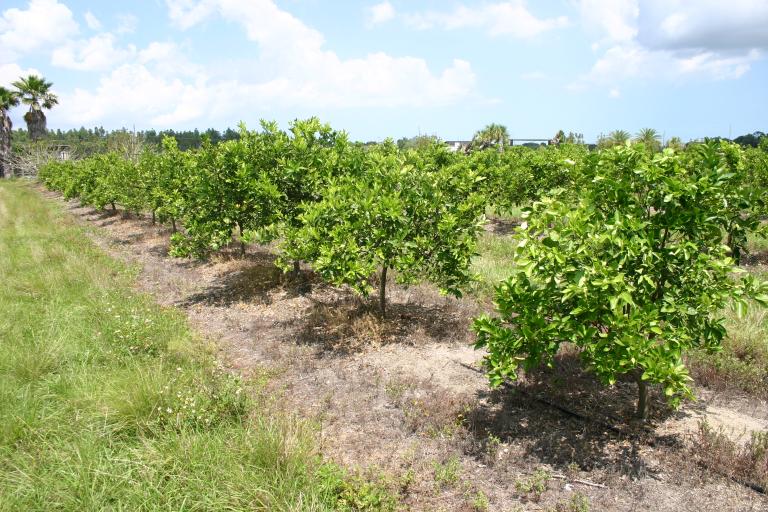
Ft. Pierce Grove, April 10, 2015.
Thursday, April 9, 2015
Let us show you how to help make the world more green and healthy. Come by Quality Green Specialists today and explore our world of green. Just imagine a park full of dozens of varieties of fruit trees, fruiting plants and vegetables – and you are free to explore and absorb. Imagine being in your own edible garden enjoying the heavenly scent of flowers and the sweet crunch of fresh-picked fruit. Whether it’s sweet oranges or thirst-quenching grapefruit – a juicy peach or sweet nectarine – luscious blueberries or refreshing blackberries – fruiting olives to make your own fresh oil or red, thirst-quenching juice from pomegranates – creamy avocadoes, papayas or delicious cherries – we have them all so you can build your own edible garden or landscape to your heart’s desire. Figs and guavas? You bet. We have them all for you to enjoy in Quality Green’s Edible Park. It is more than a nursery – it is the essence of a green, healthy, and sustainable way of life.
Fruits & vegetables with the best nutrition? You bet. The best minerals to support the most beneficial soil microbial life and the healthiest, most productive fruiting plants, vegetables, and herbs. Organic O.M.R.I. listed Azomite® volcanic mineralizer. Mother Nature’s greatest raw mineral support for healthy soil microbial life and super productive fruit trees & fruiting plants. Our own organic Super Green 3-0-5 Fertilizer for the highest quality, best-tasting fruits and vegetables. Organic, easily absorbed foliar fertilizers and treatments of the highest quality, including remediation of Citrus Greening. Compost and potting soil so good your friends will say you have a “green thumb”. With Quality Green, you will learn all the secrets to build your own piece of edible heaven. 
Wednesday, April 8, 2015
Today, I visited an olive grove in the hills west of Dade City. The grower had me pull soil & leaf tissue samples for testing & evaluating why his olives are not performing well. I recommended an organic foliar spray, our Super Thive 3 in 1 Spray along with our 3-6-9 higher analysis fertilizer (the perfet ratio of foliar elements fot nutrionsm. When the analytical testing and recommendations are completed, the right minerals in the right amounts will go on the trees. Here are how the olives look today: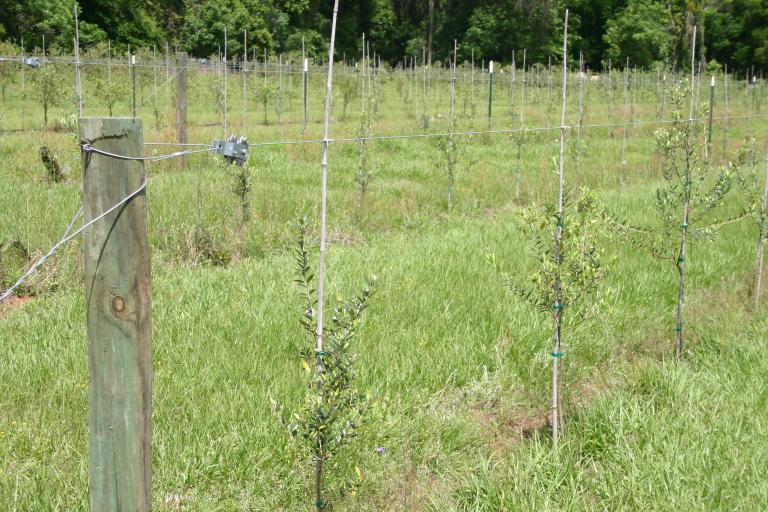
One year old trees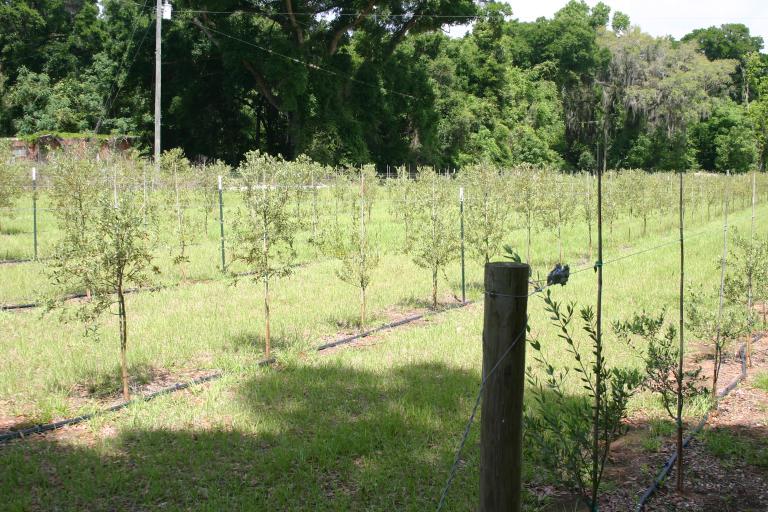
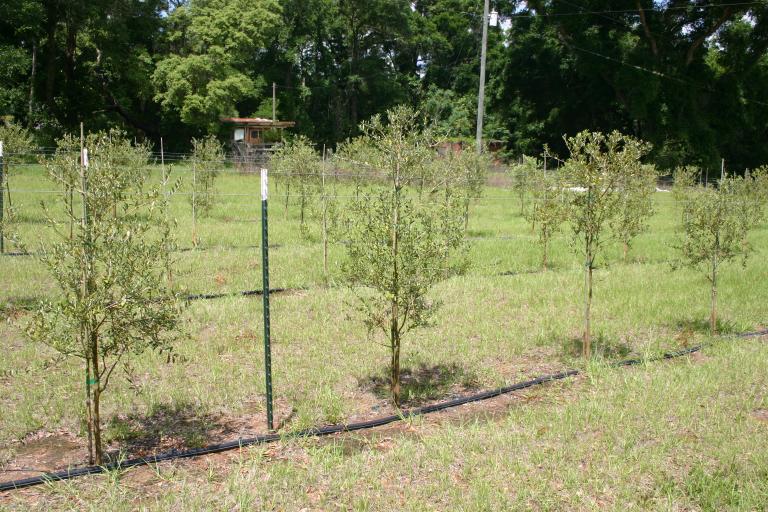
Above photos of mineral-deficient olives taken 5-8-15.
Saturday, April 4, 2015
Today, Quality Green is open 8-5. Come by and see our great selection of vegetables (especially tomatoes & peppers), beautiful healthy Citrus, blueberries with fruit, pomegranates with blooms, olives full of bloom and small fruit, avocadoes, papayas, figs, and much more!
The Artisan Aley Farmer’s Market was a huge success last night with lots of people having a good time. Olive trees and tomato plants were in demand. And it is always fun to see the bats come out of the bat houses in the Alley at dusk!
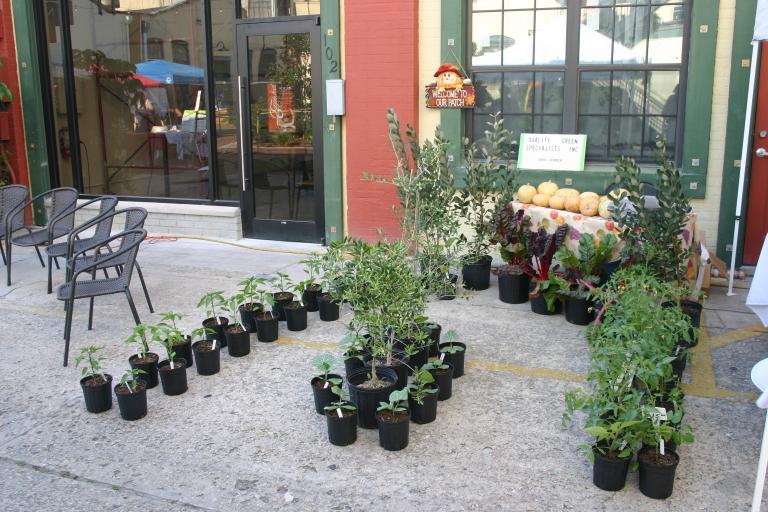
Friday, April 3, 2015
Tonight is Farmer’s Market night at Artisan Alley in downtown DeLand. Be sure to visit the most unique Farmer’s Market around. Fresh, locally grown food and locally made products are there in abundance. The Dally in the Alley Restaurant is a local favorite. The Nest is a popular meeting place. I’ll be there with our natural & organic products and fruiting plants and vegetables. I have a few more Seminole pumpkins from last fall as well. The hours are 6-9 p.m. and the Artisan Alley is just 1/2 block west of Woodland Blvd. and between New York Ave. and Georgia Ave. 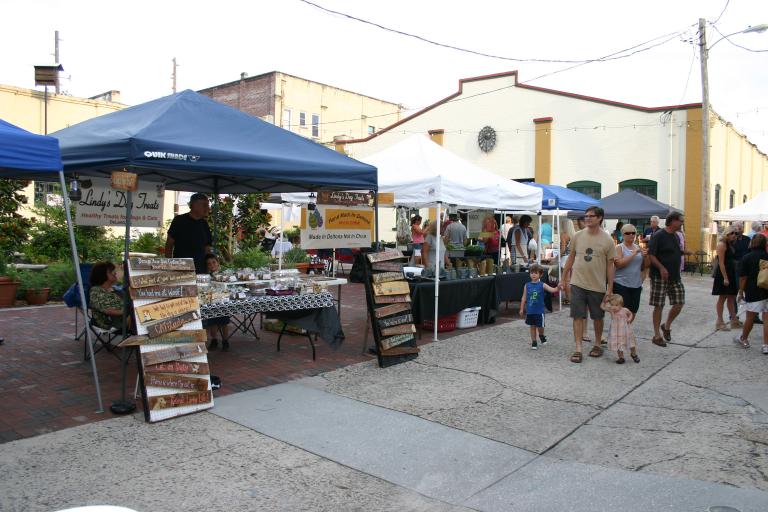

Wednesday, April 1, 2015
April showers bring May flowers. Trust that this is what happens soon because it is getting dry again. I would like to take this opportunity to thank all our loyal customers for your business and that is no April Fool! Thank You! Here are some of our great products you may want to try: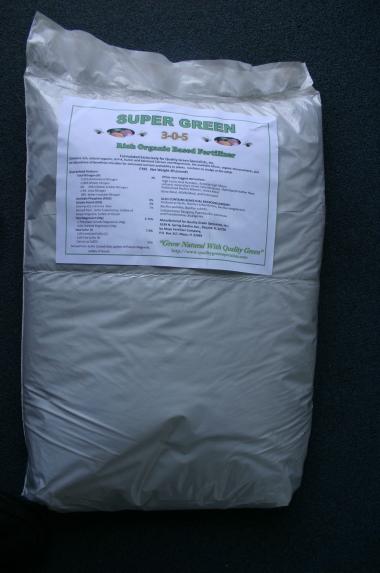
Super Green 3-0-5 Granulated Fertilizer – absolutely the best fertilizer. You will be amazed.
The best natural minerals that we searched the world for and found them in Utah. O.M.R.I. listed for organic growing, it is nature’s best blend of volcanic and sea minerals with hardly any sodium!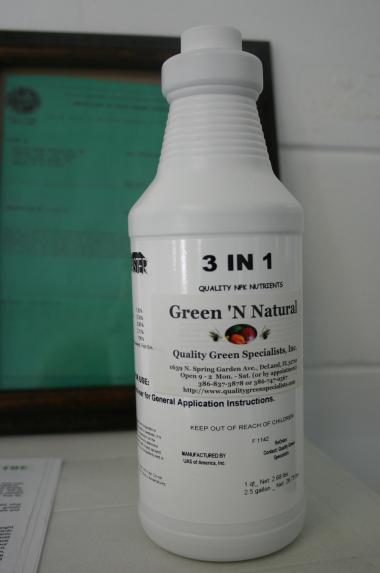
3 in 1. The best natural & organic liquid fertilizer made with a blend of fish, humic acid, kelp, and blackstrap molasses. Works like magic with dry Azomite® and Super Green 3-0-5 Fertilizer.
Tuesday, March 31, 2015
Today, you will find colorful new signs in the nursery to highlight our great selection of fruit trees and fruiting plants. It will make browsing easier and selecting plants much more enjoyable with small signs like the “Olive Trees” marking each main block of fruit trees & fruiting plants: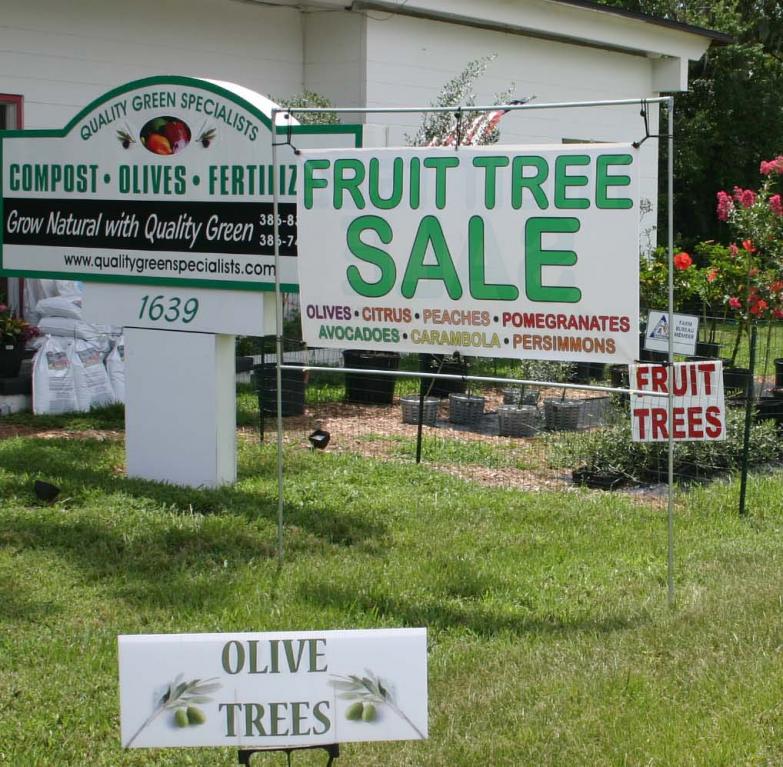
Sunday, March 29, 2015
Today, I measured the height of the olive tree at home full of bloom. To my surprise, it measured 19 feet and one inch high!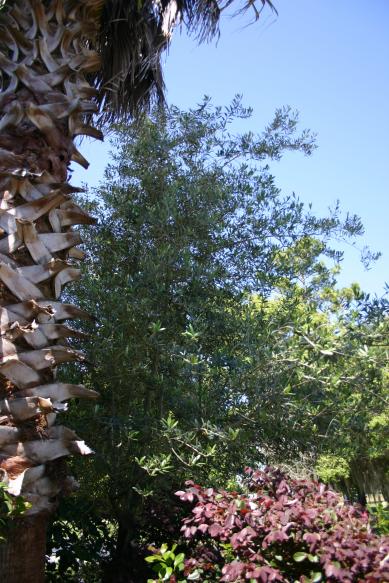
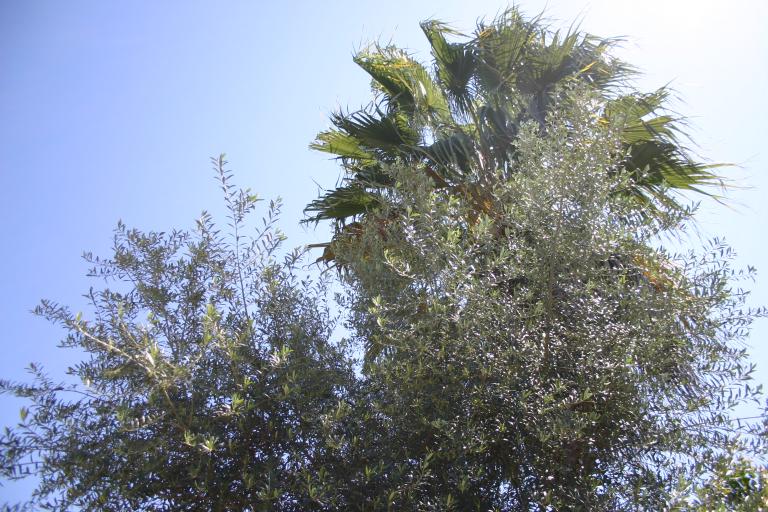
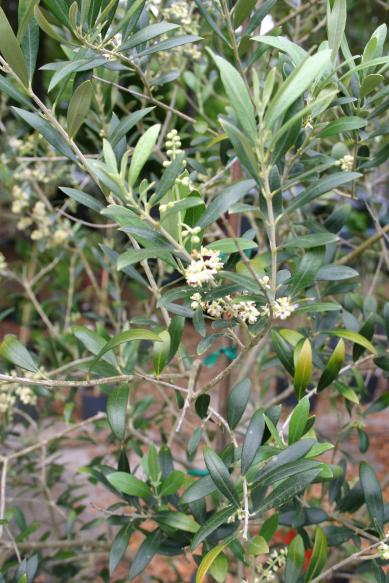
Saturday, March 28, 2015
Photos from the Wildflower Festival today:
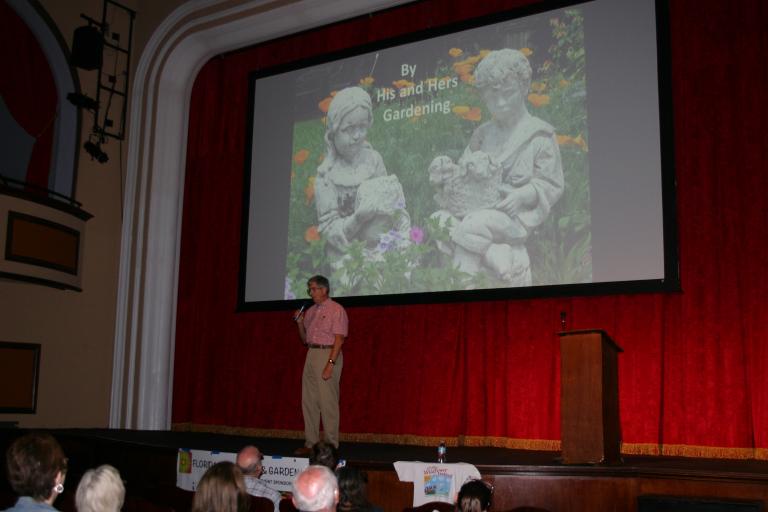
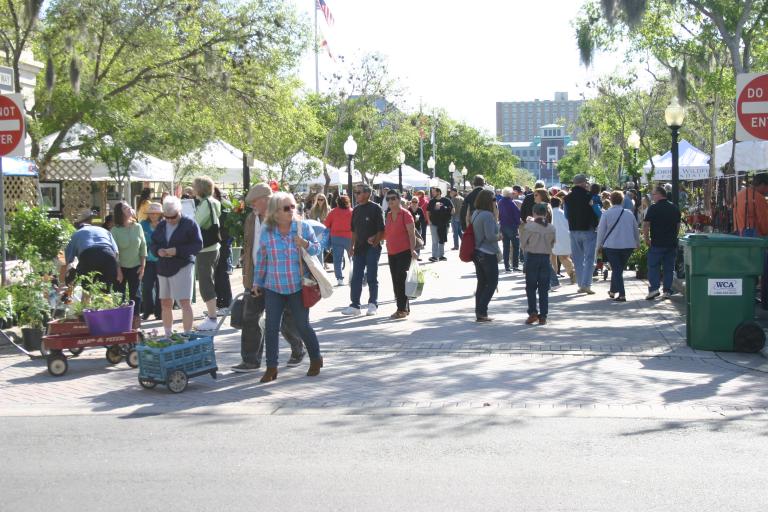
Today is the great adventure in Florida wildflowers and Florida gardens: the 9th Annual Florida Wildflower and Garden Festival in downtown DeLand. The fun and adventure begins at 9:00 a.m., so come early. Take the shuttle and enjoy the DeLand Outdoor Art Festival while you are here. See my post for Monday, March 16 for all the details. See you there!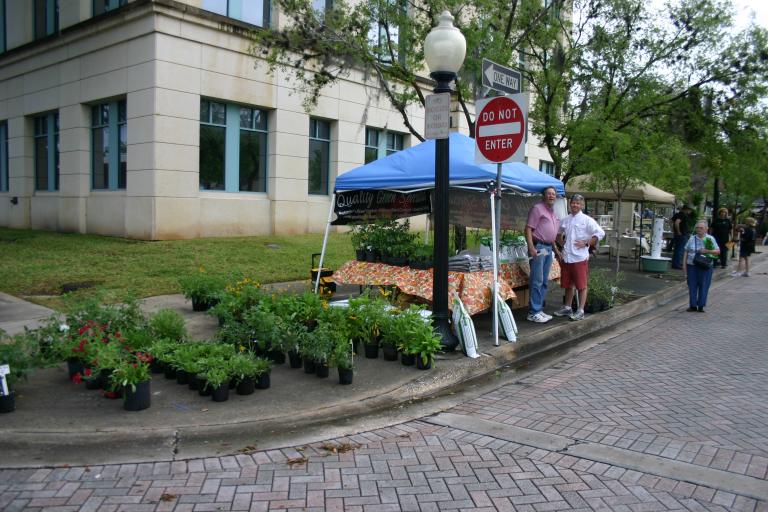
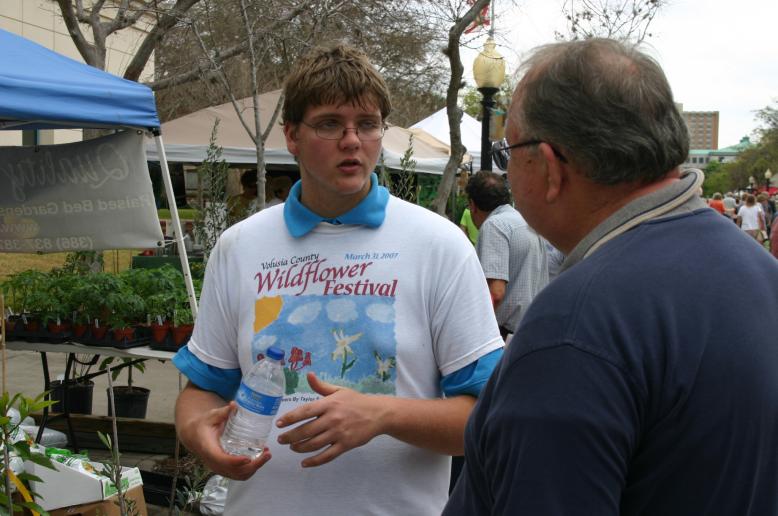
Friday, March 27, 2015
Tomorrow is the great Florida Wildflower and Garden Festival. See Monday, March 16 for all the details. Be sure to hear my wildflower talk at 9:30 a.m. and Allen Day – my business partner’s demonstration on making raised beds at 1:30 p.m. See you there for all the talks and fun events! Sorry, I will not be at the Farmer’s Market this evening. I’ll see you next Friday!
Thursday, March 26, 2015
The demand for our Citrus Nutritional & Greening Remedial program is strong because it is working! Many repeat orders and glowing testimonials are coming in. For example, Theo and Cubberly Walker just received Citra Thrive and BioWash and MZ Miz (glucoheptonate chelated manganese and zinc) for their second treatment for their young orange trees. They are absolutely ecstatic with the results one month after the initial treatent with the needed dry fertilizer materials and liquid foliar treatment. The young trees went from chlorotic yellow with no blooms to one of the most beautiful flushes (full of bloom) you will ever see. For proof, here are the dramatic photos: 
Chorotic orange trees on February 18, 2015 before QGS’s initial Citrus Greening remediation treatment.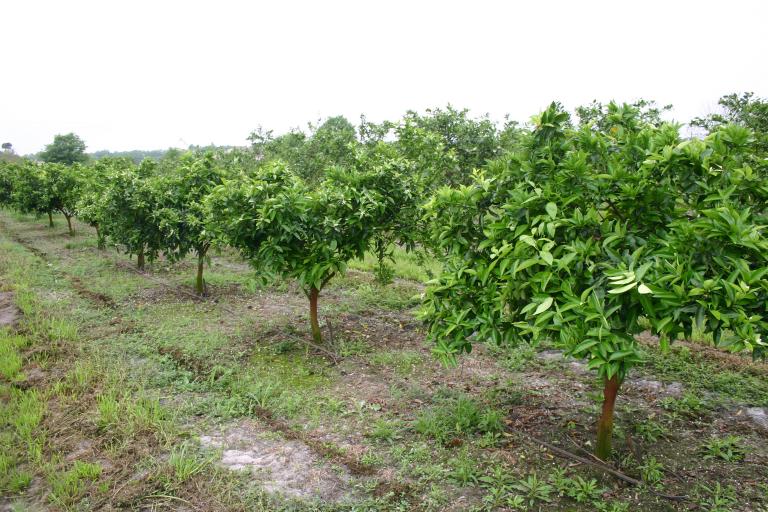
This is how the grove is looking as of March 25, 2015.
Wednesday, March 25, 2015
The rain yesterday gave all the plants and trees a nice fresh green look. The olives and Citrus are blooming nicely. Everything is putting on fresh, green growth.
This Friday I will not be at the Artisan Alley Farmer’s Market as we will be getting plants and products together for the Wildflower Festival Saturday morning in downtown DeLand. Plan now to attend! See my posting for Monday, March 16 for details.
The 20′ tall Arbequina olive tree at home in DeBary is loaded with blossoms!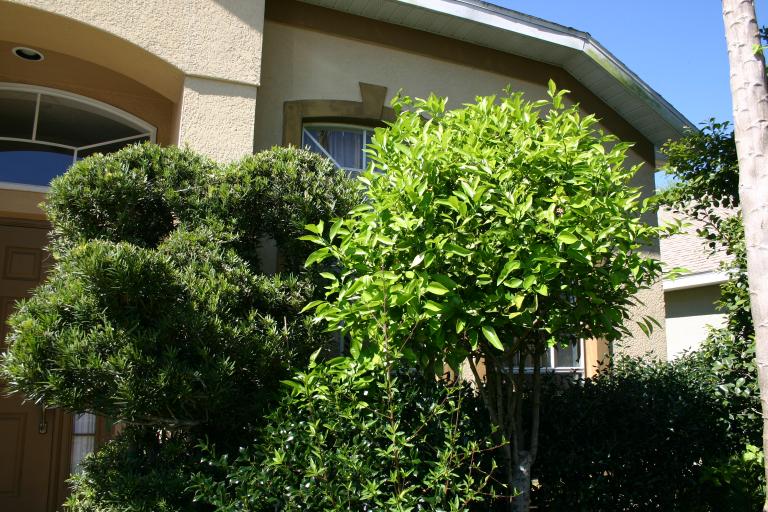
The orange tree with Greening in front of the family home in DeBary is coming out beautifully after being sprayed with CitraThrive & BioWash (CitraThrive Plus)!
Tuesday, March 24, 2015
Today, QGS is open 8-5. The Nursery is looking great, so come by today and find your favorite fruit tree or fruiting plant. Plus, we have all the natural and organic products to make your planting party a huge success. And be sure to come see us at the Wildflower Festival this Saturday, March 28, 2015. See the posting on Monday, March 16 for details!
Saturday, March 21, 2015
The Wildflower Festival is one week from today – Saturday, March 28 from 9 a.m. to 3 p.m. Plan on attending one of the best festivals anywhere! See Monday, March 16 below for details.



Friday, March 20, 2015
See you at the Artisan Alley Farmer’s Market this evening from 6 to 9 p.m. I’ll have fruiting plants, our famous SUPER GREEN 3-0-5 Fertilizer, Citra Thrive spray (Citrus Greening Treatment), our liquid 3 in 1 Fertilizer, Seminole Pumpkins, potting soil, organic compost, and tomato plants ready to put into the ground with our potting soil or compost. The Artisan Alley is located in downtown DeLand: 1/2 block west of U.S. Hwys. 17-92 (Woodland Blvd.) and between S.R. 44 (New York Ave.) and Georgia Ave. (behind the Beacon newspaper office).
We are seeing remarkable recovery on groves with Citrus Greening disease being treated with our Citra Thrive formulation. Here is one grove that was very chlorotic yellow that has come out with beautiful dark green growth and is full of bloom:
Monday, March 16, 2015
The Florida Wildflower & Garden Festival is coming soon. Saturday, March 28, 2015 from 9:00 a.m. to 3:00 p.m. is the date. I will start things off early at 9:30 with a short history of the Festival in the Athens Theater (at the intersection of Indiana Ave. and N. Florida Ave. in downtown DeLand) and photos of some beautiful wildflowers that are easy to grow in Florida.
At 10:00 a.m. Dr. David Hall will present “Native Trees for Central Florida”. At 11:00 Taryn Evans of Creative Garden Structures will present “Pollinators in the Garden: Bringing Back the Buzz”. At 12:00 Noon, Tom MacCubbin, Extension Agent Emeritus with the University of Florida and radio and talk show host of “Better Lawns and Gardens” will present “Florida’s Finest Plants – You Can Grow Them Too”. At 1:00 p.m. Hart Pulapaka, owner of Cress Restaurant in downtown Deland will present “Cooking Locally Sourced Food”. At 2:00 p.m. Prem Subrahmanya will present “Wild Native Orchids”.
There will be be Demonstrations in Chess Park. At 9:30 a.m. David Griffis, Director of UF/IFAS Volusia County Extension, will present “Florida Friendly Landscaping”. At 10:30 there will be “Children’s Gardening Activity – Seed Balls” presented by the Florida Wildflower Foundation. At 1:30 p.m. my business partner, Allen Day, will present “Building Raised Beds for Fun and Beauty.
There will be a free shuttle all day to the DeLand Outdoor Art Festival, being held in conjunction with our Festival. The shuttle will depart and arrive in front of the Athens Theater.
There will be Wildflowers, Olive trees with bloom, potting soil, compost, 3-0-5 Fertilizer, and much more at Quality Green’s booth across from the Athen Theater on Indiana Ave.
There will be children’s activities: Art Activity provided by the Museum of Florida Art, Animals from the Central Florida Zoo, and the Children’s Gardening Activity at 10:30 a.m. presented by the Florida Wildflower Foundation (10:30 at Chess Park between Indiana and New York Ave. on the east side of the old Court House).
There will be 60 vendors in all to surprise and amaze you with plants and products: Wildflowers, Seeds, Plants, Planters, Arts and Crafts, Botanical Products, Honey, Home & Garden, and much more!
Be sure to shop & dine in downtown DeLand, “The Best downtown in Central Florida”.
Admission and parking is free! There is lots of parking one block north of Indiana Ave. off Rich Ave. and also to the west side of the Athens Theater. Come join your friends and fellow wildflower enthusiasts to enjoy a day you will long remember.
Thursday, March 12, 2015
QGS has over 50 varieties of fruiting plants, but did you know that we also grow our own vegetable liners and vegetables in 4″ and 6″ pots (and sometimes in 10″ pots)? Just in time for spring, we have some beautiful 4″ starting plants of tomatoes (many varieties), peppers, and eggplants. Come see for yourself and browse through our beautiful nursery of fruiting plants and fruit trees while you are here.
Wednesday, March 11, 2015
I’m up and running and we are off to plant a fruiting Arbequina olive grove in Winter Haven.
Lots of blooms on the trees in the nursery.
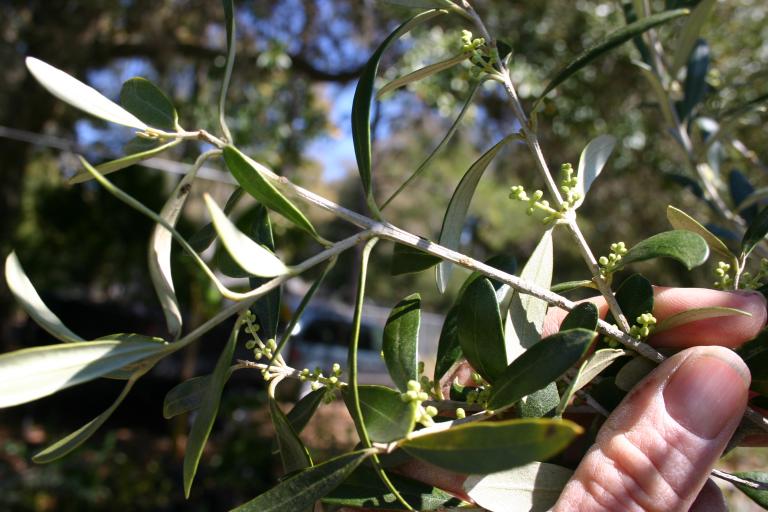
Saturday, March 7, 2015
Today, QGS is open from 8 a.m. to 5 p.m. We have loads of fresh fruit trees now ready for sale. Come see these beautiful fruit trees for yourself! Choose from blooming Arbequina (fruiting) olive trees, Citrus trees of all varieties, Anna apples, pineapple guavas, grafted Christmas loquats, Barbados cherries, strawberry guavas, pineapples, figs, blackberries, blueberries, peaches, plums, nectarines, avocadoes, pomegranates, Surinam cherries, pink meaty guavas, tomatoes, papayas, and much more!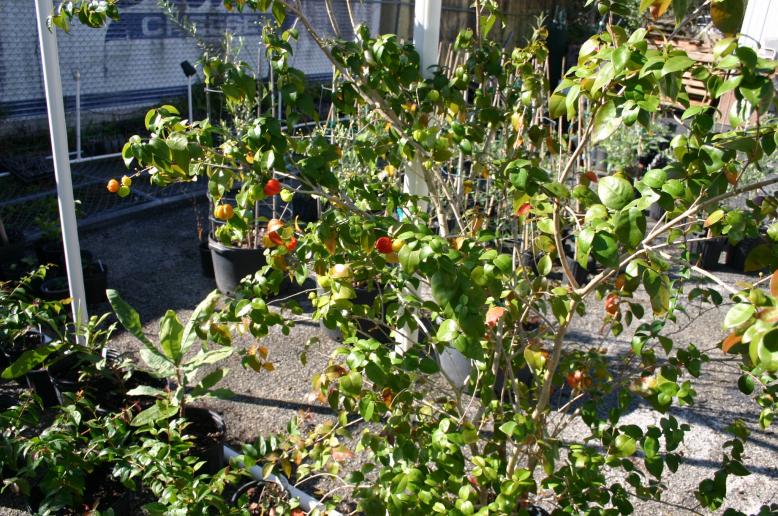
Friday, March 6, 2015
Today, Quality Green Specialists Garden Center and Fruit Tree Nursery is open from 8 a.m. to 5 p.m. This evening from 6 p.m. to 9 p.m. I will be at the Artisan Alley Farmer’s Market selling Chayote squash, Seminole pumpkins, walking canes, Super Green 3-0-5 Fertilizer, Citra Thrive Citrus Greening Treatment spray, tomato bedding plants, and other beautiful fruiting plants. Try one of my fresh-baked gluten-free chocolate muffins. You will be glad you did! During the recent light freeze, we saw something of interest regarding cold hardiness of our papaya plants. Some with no portection received absolutely no cold damge, while others in the same block were damaged heavily. This is one of the ways we keep selecting plants for cold hardiness.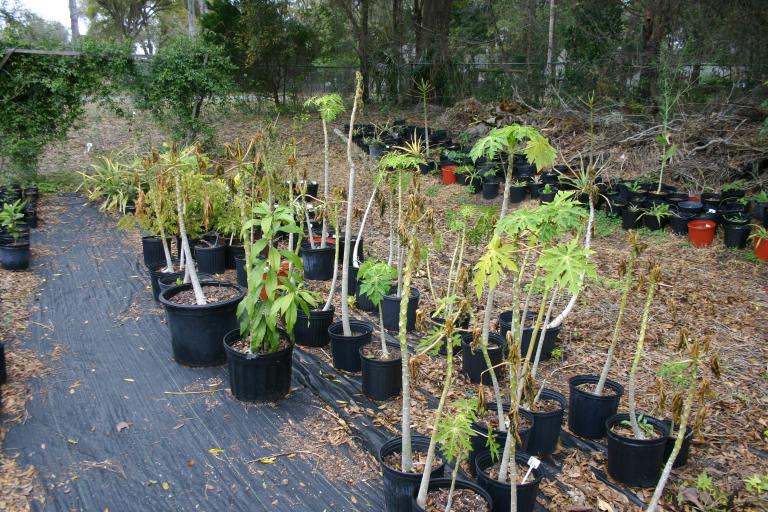
Oh yes, come by and see our great selection of Citrus trees, and over 50 varieties of fruit trees in all: 
Friday, February 27, 2015
Today, Quality Green Specialists is open from 8 a.m. to 5 p.m. This evening I will be at the Artisan Alley Farmer’s Market in downtown DeLand selling Chayote squash, Seminole pumpkins, gluten-free chocolate muffins, walking canes, and selected potted fruiting plants and vegetable plants. The Alley is a lot of fun, with great refreshments at The Nest, great food at Dally in the Alley, great beer at Persimmon Hollow, great entertainment at DaVinci Lounge, not to mention all the vendors selling all types of locally produced products from, honey, to olives, to breads, pastries, fresh juices, fresh vegetables, fresh-collected eggs, fresh hot food, high-quality home-made soaps, candles, jewelry, and so much more.
Artsan Alley is located between Georgia Ave. and New York Ave. 1/2 block west of Woodland Blvd. behind the DeLand Beacon newspaper office.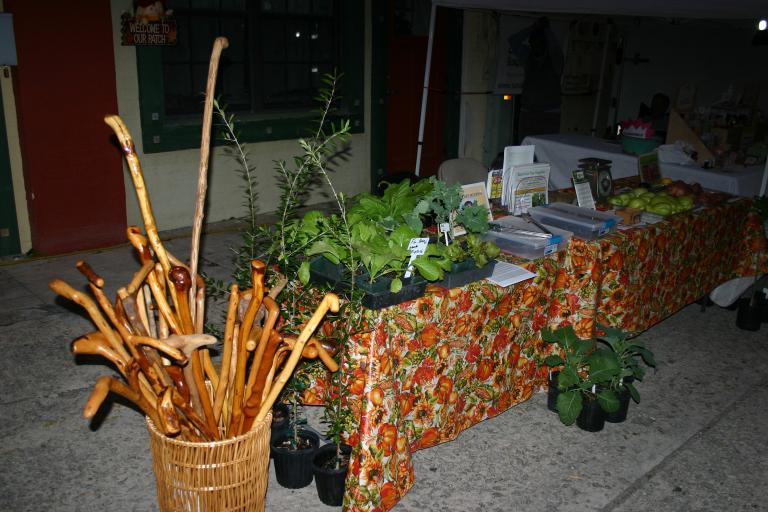
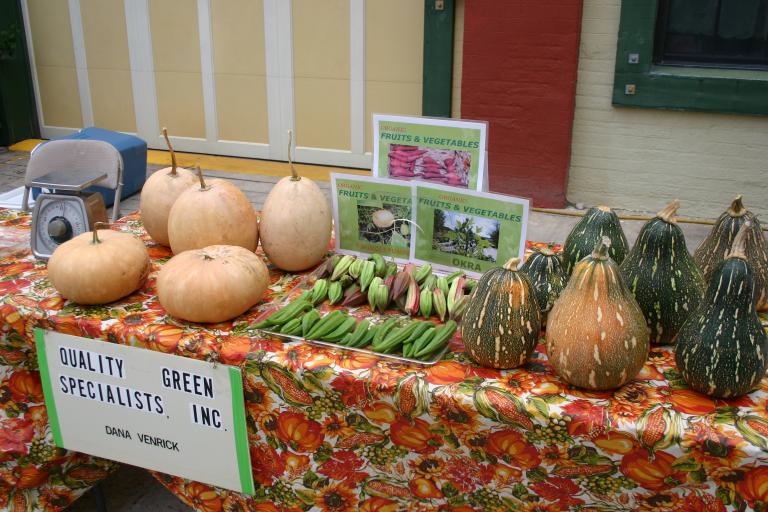
Thursday, February 26, 2015
Come by and check out our great selection of Citrus, olives, and over 50 varieties of fruit trees in all! Did you know that in a commercial olive grove, it takes somewhere in the neighborhoood of 50 pounds of olives to produce a gallon of oil and an acre of olives can produce up to 9 tons of olives (6 tons is more typical). That is a lot of oil per acre and a lot of value!
Wednesday, February 25, 2015
We have blooms on our Arbequina olive trees at Quality Green’s Nursery which shows the adaptable nature of the Arbequina cultivar of olive. Research and trials have shown that Arbequina olives can be grown in warmer areas like Florida. Some of the key parameters of high & low temperature requirements for this cultivar are discussed in an abstract by Malik and Bradford (USDA, ARS in Texas) published in 2006. Flowering is inhibited if daytime temperatures exceed 75 degrees F (+ or – ) every day for too many hours and night time temperatures need to exceed 52 degrees F to initiate bloom. Their research even found that new blooms could be initiated adjacent to existing small fruit when temperatures are favorable. Another study by the same authors in 2009 found that the best low temperatures during the winter months for flower initation are between 40 to 46 degrees F. They also found, contradicting earlier suggestions, that temperatures lower than 40 actually inhibited floral initiation.
Tuesday, February 24, 2015
Come on out to visit us at our beautiful nursery and plant nutrition store. The weather is great and we have over 50 varieties of fruiting plants to browse and choose from. Remember to try our great organic Super Green 3-0-5 Fertilizer and O.M.R.I. listed organic Azomite (“the A to Z of trace minerals including trace elements”) which has mostly overlooked…..very limiting in Florida soils…..the element second in importance only to carbon for plant growth….65% available silcon as silicon dioxide (unlike sand that is silicon oxide). Try Azomite in any of three three formulations: Granulated, Slow Release, or Micronized in 44 pound or 10 pound bags. Plus, we have a wide selection of dry & organic liquid fertilizers and blends for any use, from dooryard to commercial Citrus and olive groves. Try our great compost as well!
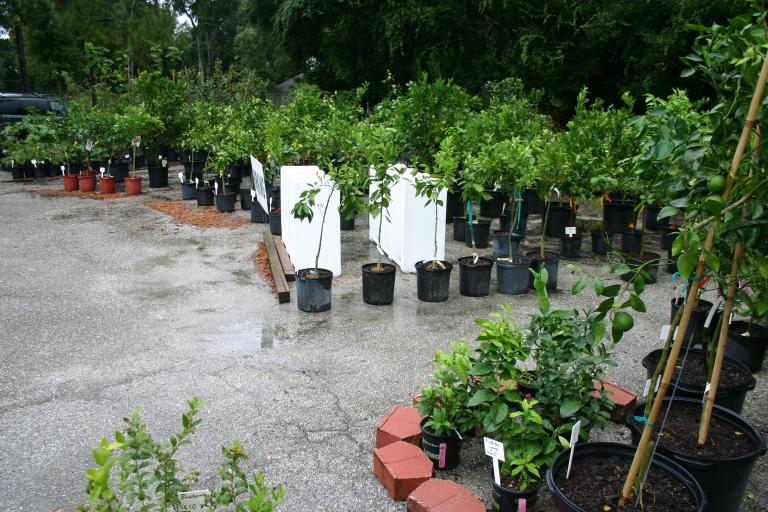
Saturday, February 21, 2015
The Arbequina olives at Quality Green’s Nursery already have pin-head blooms (see photo below taken on 2/20/15). This shows that there was more than enough cold of sufficient duration this winter in central Florida to meet the vernalization requirement.

Another young grove receives our Citrus Greening Treatment. This grove is in Mims, but other groves receiving Citrus Greening treatments this month are in Wauchula, Bowling Green, Vero Beach, Winter Haven, and DeLand.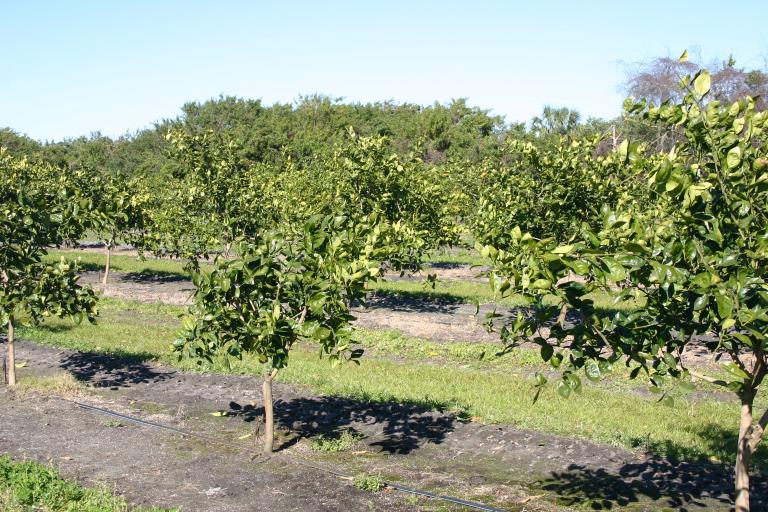
Thursday, February 19, 2015.
March is coming soon – it’s only 10 days away. Many trees in central Florida are budding or blooming. Great news at the nursery. The larger Arbequina olive trees already have pin-head bloom! This morning it is in the thirties, but spring is right around the corner!
Tuesday, February 17, 2015
Another cold week with temperatures in the 30’s at least one night this week. It seems like winter is not over, but believe me, you should be planting your spring vegetables in about two weeks – around the first of March. To have a great garden, prepare the soil now! Our sandy Florida soils are depleted of all types of minerals. The best overall soil enrichment mineral we have found is a volcanic pumice (O.M.R.I. listed for organic practices) called Azomite®. Try mixing some into your garden or planting soil along with some of our composted potting soil or organic mineralized compost. Then use our organic SUPER GREEN 3-0-5 Fertilizer with every crop cycle or 2-3 times per year. You will be amazed with the results of your crop, garden or plantings this year and for all of your lifetime by a little remewal with top applications every year.
Tuesday, February 10, 2015
Now is the time to prepare for spring planting. We have the best selection of fruit trees and fruiting plants in central Florida (over 50 varieties). We have the best selection of high quality natural & organic fertilizers (liquid & dry), potting soil, organic compost (no bio-solids), and natural pesticides. We have the best Greening Treatment for Citrus Greening (HLB), based on the most comprehensive water, soil and plant tissue testing. We have two basic products to stimulate systemic acquired resistance (SAR), which results in long-term tree health and higher production: Citra Thrive 4-10-10 (4% nitrogen, 10% phosphite & phosphate, and 10% potassium) and BioWash100 that includes low amounts of all organic micronutrients. Organic glucoheptonate chelates are specifically included in the liquid Greening Treatment to address nutrient deficiencies in the Citrus tree tissue (often manganese and zinc). Then we address excesses or mineral tie-ups to promote sustained tree health and high production.
A brand new product is now available to promote consistent fruiting of olives in the new olive groves being planted in central Florida. We never rest in our quest to best serve the needs of growers and gardeners everywhere!
Tuesday, February 3, 2015
Yesterday, I delivered 25 gallons of Citra Thrive 4-10-10 (Citrus Greening Treatment) to Umatilla. It is to be sprayed on Gary Scott’s grove in east Umatilla, that is need of this unique treatment that brings a grove back to good health and production. Previous treatments with BioWash certainly helped, but Citra Thive is the key, along with BioWash (we call this Citra Thrive Plus) to real, sustainable health with large production of high quality fruit. Below are two photos showing how the grove looked yesterday. Also, I tested soil and leaf tissue in two groves in Mims. Thursday, Allen and I are visiting three groves in Wauchula and LaBelle. By the way, our fee is nominal: $50.00 per hour for a visit. $50.00 for a soil test and $65.00 for a leaf tissue analysis. These comprehensive tests include a complete analysis and recommendations. This is a key part of our greening treatment with Citra Thrive & BioWash. We correct any severe deficiency or deficiencies with easily absorbed glucoheptonate forms of mineral(s) needed.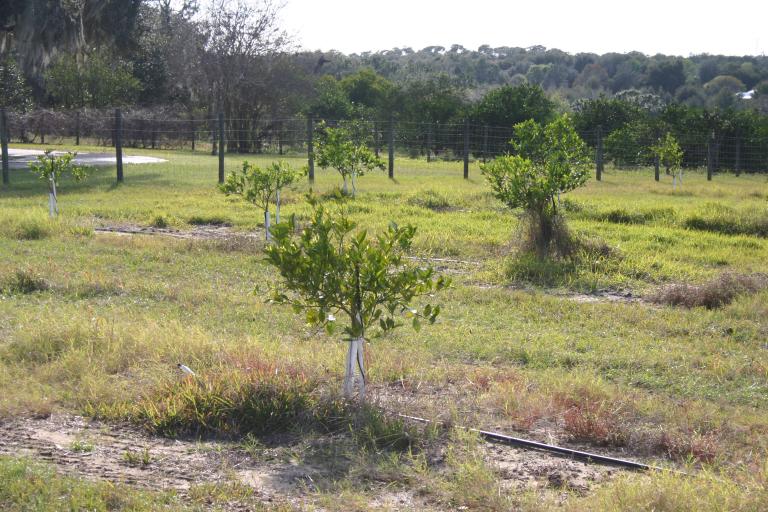

Saturday, January 31, 2015
Today, QGS is open 8-5. We have a great selection of fruiting plants and fruit trees that will amaze you. So come by, bring a friend, and enjoy some time strolling around central Florida’s “Edible Park”. See our warehouse full of natural and organic plant nutrition products. See our beautiful showroom as well. We are here to serve you whether you have a big farm, grove or a small garden or lawn. Yesterday, I was at the Artisan Alley Farmer’s Market with home grown Seminole Pumpkins and potted Surinam cherries, papayas with fruit, and guava trees from the nursery. The Farmer’s Market is open every Friday evening from 6-9 p.m. This was a cool, dry evening at the most fun market anywhere! Come by the nursery if you want a Seminole pumpkin or any of the plants I had at the Farmer’s Market. The Plant Nutrition Store and Nursery is open today from 8 – 5 (we will be closed tomorrow, Sunday). When you visit, you will find the best selection of fruit trees and fruiting plants anywhere. Plus all the best nutritionals, including our own 3-0-5 Fertilizer, our own liquid organic fertilizers, Azomite® volcanic pumice mineralizer (OMRI listed for organic use), our own potting & planting soil, our own organic double digested compost (with no bio-solids but with lots of organic fertilizer ingredients). You will find friendly, knowledgeable help from Allen, Alex, and me as well.
Check out the January “Citrus Industry” magazine. There is an analysis by Bob Rouse and Fritz Roka of their five year experimental grove trial (of various spray “cocktails”) at the IFAS/University of Florida grove planted in 2003 at the Southwest Florida Research & Education Center (SWFREC) that had strong symptoms of HLB (Citrus Greening). I personally saw the grove when it was in a very weak, diseased state before treatments began and then after treatments had been used for some time when there was strong tree recovery. There is a complete analysis of tree response and costs of various components of Maury Boyd’s original Citrus spray “cocktail”. The liquid treatments were applied three times per year timed with the three main flushes – spring, “June bloom”, and fall. Our program looks to be better (and more cost effective except for the oil spray alone) than any of the treatments used. Bob Rouse says that salicylic acid is helpful in that it encourages new growth, but it is not part of the two best nutritional programs. The highest yields were obtained with macro (liquid 3-18-29) and micronutrients (MNSO4, ZnSO4, Na2MoO4 as sodium borate, , K-phite 7LP 9 (phosphorous acid), and Citrus oil. Bob Rouse says that the better treatments contained some combination of macro and micronutrients, a phosphite and salicylic acid. However, it is worth noting that two of the best treatments contained no salicylic acid, in fact the treatment that had the highest overall yield gain over the control (plus 848 boxes) had no salicylic acid as part of the treatment regimen.
Our Citra Thrive 4-10-10 with BioWash is superior to the liquid 3-18-10 used because Citra Thive has a better potassium to nitrogen ratio. The 3-18-20 has 6.7 times as much potassium (K) as nitrogen (N), while Citra Thrive has 2.5 times as K as N, a much better ratio. A 3:1 to 4:1 ratio of K:N is luxury consumption of K. A 5:1 and higher results in mineral lock-ups. Plus Citra Thrive has readily absorbed micronutrients in organic form, systemic, anti-pathogenic phosphite, an amazing plant-based botanical surfactant/penetrant in BioWash, and beneficial microbes to include Bacillus spp.
Growers, please note that this Citrus grove field trial is based on evaluating a static set of nutritional regimens, some of which are not nutritionally sound. None of the studied treatments should be followed exactly as described. Instead, use the study as a guide to a similar program in your grove that is based on a complete soil and leaf tissue analysis taken each year and is modified to any ongoing changes in the nutritional status of the soil and/or tissue.
There are some inputs used in the trials that should not be used in a commercial grove, besides avoiding such an excessive K to N ratio. The dry, ground applied fertilizer that was applied three times during the year using calcium nitrate (using calcium nitrate all the time could in itself over-load the soil with calcium after a few years) had an analysis of 9-1-14 + Mg, Mn, Zn, Cu, and B. The total annual input was higher than necessary at 160 lbs/ac N and 205 lbs/ac K2O, based on our grove experience and use of the 3-18-20 foliar nutritional spray. It is not prudent to soil apply zinc because it is well known that zinc is poorly absorbed and gets clogged up in the base of the Citrus tree (near the bud union) with an amino acid complex and hardly any makes it up into the tree canopy (this tie-up in the trunk is associated with the disease Tristeza).
Copper is normally high in the soil and it takes very little excess to become toxic. Normally, copper should not be included in dry, ground-applied fertilizer. Only apply copper if analytical testing finds that it is deficient. Then spray a chelated form, such as glucoheptonate (at a very low application rate three times per year until the element is sufficient again), that is easily absorbed and metabolized by the Citrus tree. Copper is only needed at 4-5 parts per million (ppm) in the soil. You can see why including copper (Cu) in every ground application of fertilizer will result in toxic levels in the soil. And another thing, if Cu becomes excessive in the tree leaf tissue, do you think that spraying more copper will protect against canker or any other disease? No, it will only poison and weaken the tree and make it more susceptible to disease, because high levels in the soil become very toxic to the roots and high levels in the tissue become very toxic to the tree tissue.
(Analysis of spray cocktails to be continued….. in the meantime, don’t follow any of these static programs because they have some more issues that I will discuss tomorrow. Besides, treatments should be customized to your grove based on our comprehensive and detailed soil and tissue analysis.)
Thursday, January 29, 2015
Here I am at the Florida Citrus Show with Ted Tidwell and Laura Nelson: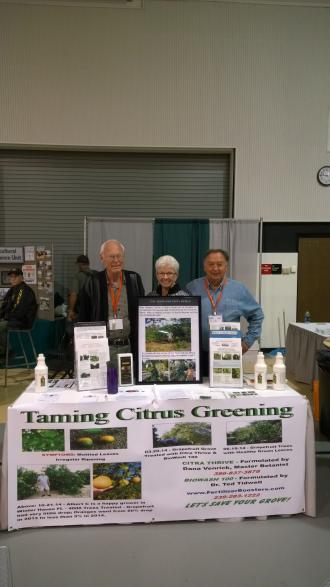
Wednesday and Thursday, January 28 & 29, 2015
You can catch me at the Florida Citrus Show in Ft. Pierce, Florida today and tomorrow if you are in this area. I’m here to tell the amazing story of Citra Thrive and BioWash100 and the amazing remediation of Greening we are achieving all over the state of Florida! The show is at the Havert L. Fenn Center. Allen and Alex will be at the store and nursery to serve you 8-5. I’ll return Friday. If you are in the DeLand area Friday, come by and see the Daytona Beach News-Journaal Reader’s Choice Award “Best of the West” for “Best Frruit Tree Supplier”. Come by and you will see why! Friday evening you will see me at the Artisan Alley Farmer’s Market in DeLand. I will have some outstanding quality Seminole Pumpkins (the original native Florida squash, and they are delicious!) to share as well as some nice edibles and fruiting plants.
Monday, January 26, 2015
The Florida Citrus Show is coming up at the Fenn Center in Ft. Pierce Wednesday and Thursday. I will be there representing Quality green Specialists and Citra Thrive and BioWash. Alex Andrews found a interesting gardening blog site that referenced our site showing pomegranates and persimmons without leaves looking like their trees this time of year with the realization it is normal for deciduous fruit trees. Of special interest is a description and photos of what is called vertical pallet gardens. The link to their site is: http://www.gardeningfl.blogspot.com
By the way, we have a new Fax Number: 386-279-7878.
Saturday, January 24, 2015
Compost is often misunderstood. You may think the main value of compost is to add nutrients to the soil, but this is actually a fairly minor role. In general, compost contains from 1-4% nitrogen (N), 1-4% phosphorus (P), and 1-4% potassium (K). Because the release rate of compost’s N-P-K is very slow, the best results for growing plants may be achieved by using low rates of high quality, low salt index fertilizer, such as our Super Green 3-0-5 Fertilizer combined with compost as a supplement. In a ten year study by USDA, the most beneficial results with the use of composts were achieved at the low application rates of 1.5 to 2 tons per acre. That’s only 69 – 92 pounds per 1,000 sq. ft. (33′ x 33′ area) and only 6.9 – 9.2 pounds per 100 sq. ft. (10′ x 10′ area). Amazingly, there were virtually no disease problems in fields used for growing vegetables when applied at these low rates. More is not better – higher levels (or lower levels) of compost on a field used for growing vegetables, resulted in lots of disease problems. What’s so great about good compost? Carbon, microbes, and fungi are present in compost in abundance. It’s the synergistic alchemy of these biological ingredients that generate the vitality in organic garden or farm soil. So, think of compost as a complete whole foods diet for the soil and the microbes that will help your plants grow and glow with vibrant health. Quality Green Specialists go the extra mile to make our very owm “Premium-Blend Compost”. It is fortified with all essential minerals, so that less fertilizer is required to achieve outstanding results. Plus we add a package of beneficial microbes to speed-up mineral release. Below is a typical analysis of our Super-Blend Compost: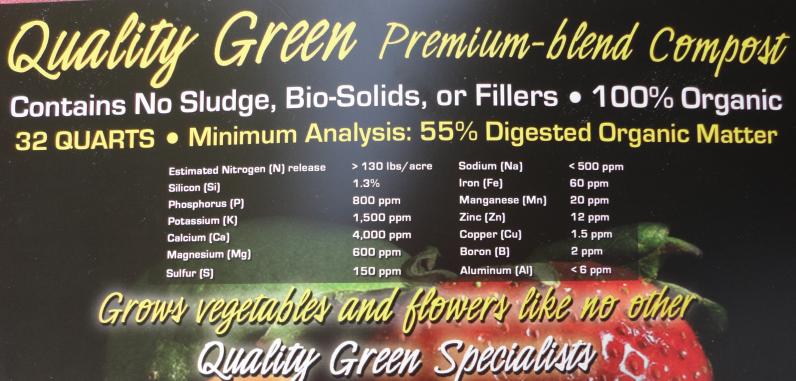
To achieve mineral levels like this, we add more than we have to: Azomite® volcanic pumice, humate, organic minerals, dried blackstrap molasses, beneficial microbes and much more! Plus, we compost a second time!
Friday, January 23, 2015
Want to have beautiful, perfect winter vegetables like the ones in Allen Day’s raised bed (co-owner of Quality Green Specialists, Inc.) as pictured below? Well, just try our potting soil and compost along with our organic Super Green 3-0-5 Fertilizer and our liquid fertilizers with lots of organics tailered to the vegetable’s stages of growth. Then you too will be a “master of gardening”. Also, today is Friday and I will be at the Artisan Alley Farmer’s Market in downtown DeLand, Florida from 6-9 p.m. (see an earlier post for directions). I will have Azomite® (OMRI listed volcanic pumice mineralizer) grown Seminole pumpkins, 3-0-5 fertilizer, chayote squash, and some of our fruiting plants and vegetable liners. See you there!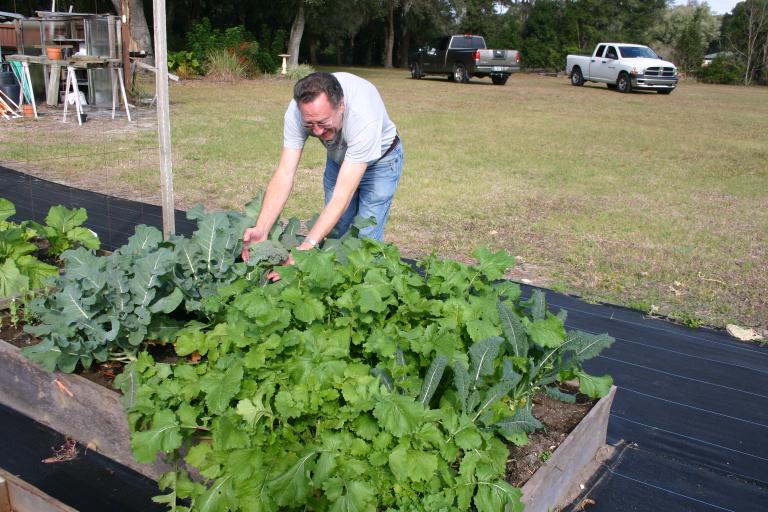
Allen Day shown with beautiful QGS grown kale, turnip greens, and broccoli.
Thursday, January 22, 2015
Another busy day. The weather is great, so come on out to our garden center and nursery to see our huge selection of fruit trees. The selection of Citrus trees has never been better. We have over a thousand olive trees in stock. Plus, we have the best fertilizer anywhere with our very own Super Green 3-0-5 Fertilizer. We only put organic, natural, low-salt ingredients in optimum amounts to grow the best plants, crops, and turf ever! Ingredients include sulfur coated urea, bone meal, potassium magnesium sulfate, potassium sulfate, Azomite® volcanic pumice mineralizer, black humate, kelp, alfalfa meal, composted poultry manure, greensand, dried blackstrap molasses, and numerous beneficial microorganisms.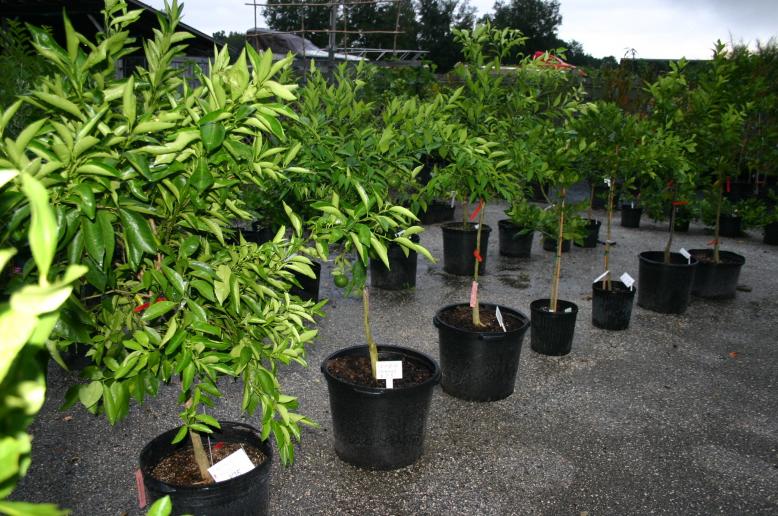
Tuesday, January 20, 2015
Our Citra Thrive 4-10-10 and BioWash100 or Citra Thrive Plus Citrus Greening Treatment is doing a remarkable job of bringing groves back into a healthy, productive, and profitable condition. But it cannot be considered to be a stand alone treatment. To ensure outstanding results, treatments must be accompanied by soil and leaf tissue analysis, the correction of soil pH if necessary, and the careful management, using low salt index materials (such as potassium magnesium sulfate and sulfur coated urea instead of potassium chloride/muriate of potash and ammonium nitrate), of any major excesses or deficiencies in the soil or tree tissue. Very importantly, for optimum uptake and systemic translocation to the entire tree, including the critically important root system, correction of micronutrient deficiencies in the tree foliage must be made with sprays of very bio-available organic forms such as glucoheptonate or lignosulfonate chelated trace minerals.
Saturday, January 17, 2015
A grove in very poor condition in Babson Park was sprayed with Citra Thive & BioWash100 early in December. The trees were in very poor condtion and small branches all over the grove were bare and looked like they were dead or dying. Look at the strong flush coming out solid all over the trees now!
Wednesday, January 14, 2015
We are enjoying great Florida weather. The time to plant Citrus trees is now while we have the best selection of most any variety you can imagine. Come see for yourself.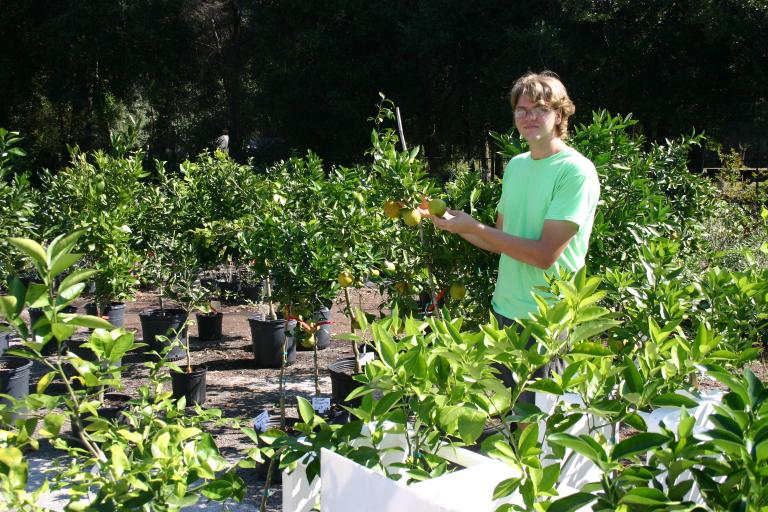
Monday, January 12, 2015
We are open today through Saturday 8-5 p.m. QGS highly recommends our Super Green 3-0-5 Organic Fertilizer. This is the organic fertilizer for Florida Friendly Fertilizer Use & Volusia County Fertilizer Ordinance Requirements (and other counties & municipalities). Contains: √ 100% slow release nitrogen. √ No leaching potential to the ground water with its natural & organic ingredients and low nitrogen (N = 3%) phosphorus (P = 0%), potassium (K = 5%) analysis. √ Natural, low solubility ingredients include unique, amazingly effective ingredients such as OMRI listed Azomite® volcanic pumice mineralizer, sulfate of potash magnesia (SPM), black humate, calcium carbonate, alfalfa meal, greensand, dried blackstrap molasses, and beneficial microorganisms for slow, steady release for months. PLUS, now through February 28, 2015, receive 10% off on this great fertilizer and all our products and fruit trees! This is a copy of our newspaper ad:
Saturday, January 10, 2015
What a beautiful, cool day! Alex and I “spruced up” the nursery today. I drove to Pierson to take a soil test in a small orange grove. Then I drove to Common Ground Farm on Taylor Road in DeLand to give them advice on the lay-out for a new Florida Apple Orchard they are planting. I also gave them advice on their fertilizer program. John and Pat Joslin are growing some luscious vegetables using our potting soil! I must say I enjoyed sampling the delicious produce.
We have our own recipe for making great potting soil with lots of organic amendments, like Azomite® organic volcanic pumice mineralizer, our Super Green organic 3-0-5 Fertilizer, dried blackstrap molasses, beneficial microorganisms, and many more organic ingredients. We sell in bulk or in 32 quart bags (individual bags or by the pallet). We also make bulk deliveries up to 5 yards at a time. We started bagging our own potting soil in 2011. At first we used a twist tie (see photo below). Now we heat seal our bags for a far neater look.
All of our bagged products are now heat sealed:
Wednesday, January 7, 2015
I have been busy testing soil and leaf tissue to help growers improve their crop health and increase their prodution this year. This is a critically important, basic first step to maximize the results of fertilizer applications now and later on this year. QGS has the most complete and accurate soil and plant tissue testing, analysis, and testing service anywhere. A complete test costs only $50 for a conventional soil test, $50 for a paste extract soil test, and $65 for plant tissue analysis. Plus, you receive a 10% discount off these prices during the month of January. Save on the best testing available and save money by not spending money on minerals that may already be excessive in the soil. Spend for only what you need – plus reap the reward of the best turf, landscape, garden or crop you ever had!
Call today – Dana at 386-837-3878 or Allen at 386-747-0567.
Monday, January 5, 2015
January is the time to put the first light fertilizer application of the year on olives, Citrus, and other trees and plants that will be flushing with new growth and bloom very soon. We have the best organic fertilizer available and at a very reasonable price – Super Green 3-0-5 fertilizer. Every day in January is longer than the day before and roots are growing beneath the soil and they need to be fed with a good slow release (controlled release) organic fertilizer with a low salt index. We use good ingredients. We don’t use sludge or bio-solids. Notice on the label below that we use lots of potassium magnesium sulfate, Azomite® volcanic pumice mineralizer, humic acid, organics, and beneficial microbes. Also included (not listed on the label) is dried blackstrap molasses, nature’s best chelate with four complex sugars for optimum mineral uptake. You will be amazed with the incredible plant response when using this fertilizer. Remember, fertilizer does not cause new growth – temperature and moisture are triggers. What you do want is the best mineralized, healthiest new growth that will withstand cold temperatures and other stresses best. Putting a light application of our excellent quality, low-salt index organic fertilizer will be like putting anti-freeze into the plant tissue. 
Saturday, January 3, 2015
Today, QGS is open from 8-5. We are closed tomorrow Sunday, Jan. 4th, but we are open next Monday thru Sat. 8-5. See us for the best plant nutritional products at a reasonable price and the best selection of fruit trees and fruiting plants!
What about Basalt Rock Dust? How does it compare to Azomite® OMRI listed organic volcanic pumice mineralizer? One big thing that stands out like a sore thumb is the high level of iron oxide (pretty much an unavailable form of iron), which is 16.30%. Too many applications of a high iron product like basalt may tie-up other minerals like manganese and phosphorus, which are extremely low in the basalt at 0.18% and 0.19%. Also, calcium is 9.87% and magnesium is 4.69%, a 2:1 ratio. After extended applications, this could lead to an excessive amount of magnesium in the soil compared to calcium. Calcium should be about 60-70% of the base saturation of the soil, while magnesium should be in the 10-20% range. Taking 65% and 15% as the midpoints, the ratio in the soil should be somewhere around 4:1 of calcium compared to magnesium. Taking the extremes of each range 60-70% & 10-20%, the ratios should be not less than 3:1 or not more than 7:1. Tie-up of calcium may occur when the ratio of calcium to magnesium drops to a 2:1 ratio or less. (Tie up of magnesium occurs when the ratio of calcium to magnesium goes over 11:1.) Perhaps even worse is the very unfavorable ratio of potassium to sodium. Potassium should be at least twice as much as sodium in the soil. Using too much basalt or using it for too many seasons may lead to sodium toxicity: the potassium in basalt is 0.86% and the sodium is 2.75%, a very negative 0.3:1 ratio. In other words, the sodium level is 3.19 times as much as potassium!
Here is the typical analysis of Azomite vs. basalt rock dust:
Azomite:
Potassium: 5.13%
Phosphorus: 0.15%
Nitrogen: 0.15%
Calcium: 3.16%
Magnesium: 0.78%
Iron: 1.37%
Manganese: 0.02%
Sulfur: 0.024%
Sodium: 2.05%
Silicon: (as bio-available silicon dioxide): 65.85%
Basalt Rock Dust:
Potassium: 0.86%
Phosphorus: 0.19%
Nitrogen: None listed
Calcium: 9.87%
Magnesium: 4.69%
Iron: 16.30%
Manganese: 0.18%
Sulfur: 0.03%
Sodium: 2.75%
Silicon: Amount not listed
Friday, January 2, 2015
Today, QGS is open from 8-5. Start the New Year out right and come vistit our amazing fruit tree nursery and garden center/plant nutrition store. Also, if you are near DeLand later today, come visit me at the Artisan Alley Farmers Market from 6-9 p.m. on Artisan Alley in the heart of downtown DeLand across the street from the old domed courthouse.
Wednesday, December 31, 2014
Today, I am delivering dolomitic limestone, Azomite® volcanic pumice mineralizer, potassium sulfate and olive trees to an olive grower in central Florida. The grower needs these products based on our comprehensive testing. Of course, we are getting ready for the New Year, 2015! Thanks again to everyone who helped make 2014 such a success! Tomorrow QGS is closed, but we will be open Friday and Saturday! Happy New Year!
Tuesday, December 30, 2014
Today and tomorrow, New Year’s Eve, QGS is open from 8 a.m. to 5 p.m. The year will be gone soon, so I would like to give a special thanks to all our customers, to my business partner, Allen Day, to our Associate, Alex Andrews, and to all our suppliers who have helped to advance a better, more sustainable way to nourish the soil and grow more productive, more nutritious plants. We at QGS are proud to be a part of the local, home-grown food movement and to help agriculture to become sustainable for generations to come.
Monday, December 29, 2014
We are open today 8-5. 2015 is coming soon. It’s time to start thinking about gardening, planting, and fertilizing in January. Every day in January the sun comes up a little earlier and the sun sets a little later than the day before. Microbial life starts to get more active. Lots of new roots start to grow where it is warmer under the surface of the soil. This is the time to plant cold-hardy trees. There is still time to plant winter vegetables such as greens, irish potatoes and carrots. January, in many cases, is when you want to apply the first fertilizer application. Olive trees need the first low nitrogen, high potassium fertilizer before bud break (e.g., our Super Green 3-0-5 Organic Fertilizer) and a special nutritional spray. Likewise, Citrus trees do best with an initial light dry, ground fertilizer application in January. Our 3-0-5 Fertilizer has performed the best for Citrus trees in our trials over the past three years!
We only use great, balanced organic ingredients in our 3-0-5 Fertilizer. See the list of ingredients on the label shown below the 40 pound bag (not included on the label is another great ingredient, dried cane molasses, nature’s best chelate for uptake of minerals). Come by today and check out all our great products. We are open every day this week 8-5 Monday through Saturday, except for Thursday, New Year’s Day. Call me, Dana, at 386-837-3878, Allen at 386-747-0567, or Alex at 386-785-3297.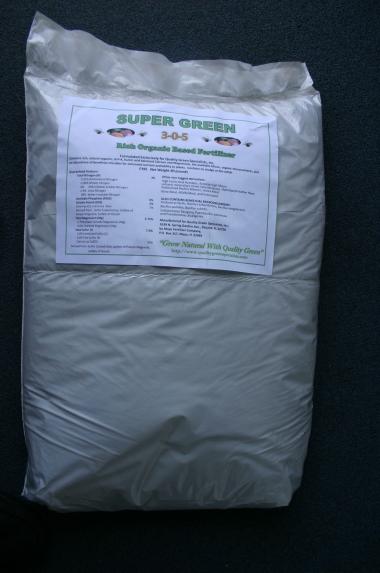

Sunday, December 28, 2014
QGS is closed today but we are open tomorrow. Here is a photograph of a pomegranate grove that is mostly bare of leaves now (they are deciduous), but had lots of fruit late this summer. This is another crop to consider for central Florida that is easy to grow. And they thrive on Azomite® (O.M.R.I. listed organic volcanic pumice mineralizer).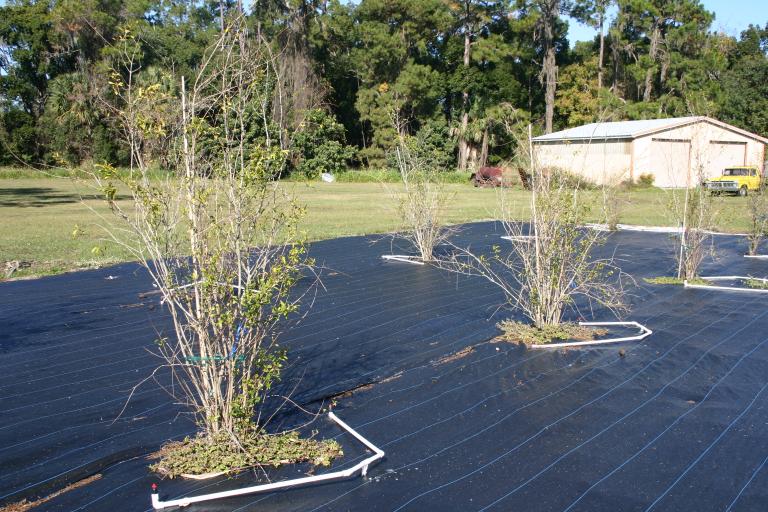
Speaking of volcanic minerals, Azomite literally has no competition. For example, pictured below is a bag showing the label of another volcanic rock dust, but with very poor mineral composition. Unlike Azomite, which has low sodium and much more potassium than sodium, the potassium is very low and there is more sodium than potassium. (This is not a good situation as sodium is taken up by the same uptake mechanism as potassium and a plant amended by this volcanic material will be weak and subject to all kinds of stresses.) Also, the calcium and magnesium are present in about the same amount, while Azomite has about three times as much calcium as magnesium, a good ratio for keeping the soil healthy and preventing tie-up of calcium. It is also more expensive. Compare the analysis on the “Agrowinn” with the Azomite typical analysis below.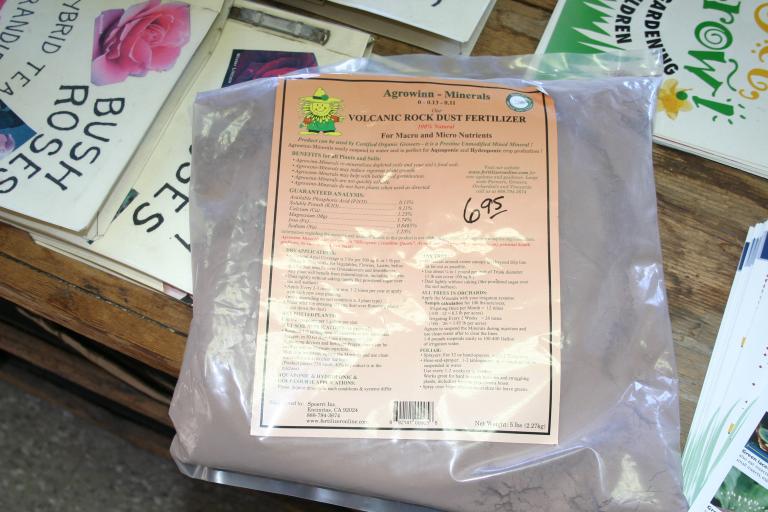
Azomite® Typical Analysis (partial list) has good mineral ratios:
Potassium: 5.23%
Phosphorus: 0.15%
Nitrogen: 0.15%
Calcium: 3.67%
Magnesium: 0.78%
Sodium: 2.05%
Silicon: (as bio-available silicon dioxide): 65.85%
Our competitition, Agrowinn-Minerals:
Potassium (K): 0.11% (too little, especially in relation to sodium)
Phosphorus (P): 0.13%
Nitrogen (N): 0%
Calcium (Ca): 1.23% (Too little, especially in relation to magnesium)
Magnesium (Mg): 1.74% (Danger: a Ca:Mg ratio of 1:1 or less ties up Ca)
Sodium (Na)1.25% (Danger: K should be at least 2x Na)
Silicon (Si): not listed
Saturday, December 27, 2014
Quality Green Specialists (QGS) is open today from 8 a.m. to 5 p.m. We would like to invite you to see our beautiful nursery full of fruiting plants. We like to think of our nursery as a botanical fruit park. We have over 50 varieties of plants and trees you can choose from to help make your own yard an “edible landscape”. What could be better to make “grown locally” more of a reality than being able to eat many of your fruits and vegetables from your own yard. We have the expertise and products, such as O.M.R.I. listed organic Azomite® volcanic pumice mineralizer and our own Super Green 3-0-5 Organic Fertilizer (with lots of potassium magnesium sulfate, volcanic pumice, humic acid, kelp, blackstrap molasses, and eight beneficial microrganisms for some immediate but mostly long-term release) to transform your soil from depleted to super fertile! We love to help you turn your unhealthy, poorly mineralized soils to fully mineralized soils that build & support super healthy beneficial microorganisms that digest (eat) minerals and release ionic forms of minerals that plant roots can absorb. Not only that, the healthy microbes are the very best way to build digested soil organic matter that prevents leaching of all types of minerals! This includes cations like calcium (Ca+), magnesium (Mg+) potassium (K+), ammonium (NH4+, which is the form of nitrogen that blueberry and Azalea roots absorb), etc. and anions like nitrate (NO3-, which is the form of nitrogen that most plant roots absorb), SO4-, etc. Why not make today the day to start the healthy transformation of your yard from all ornamentals to a multi-diversity of edibles beautifully enhancing your landscape? Help improve your health, bring down the cost of food, and reduce the burning of expensive fuel with fewer trips to the grocery store. 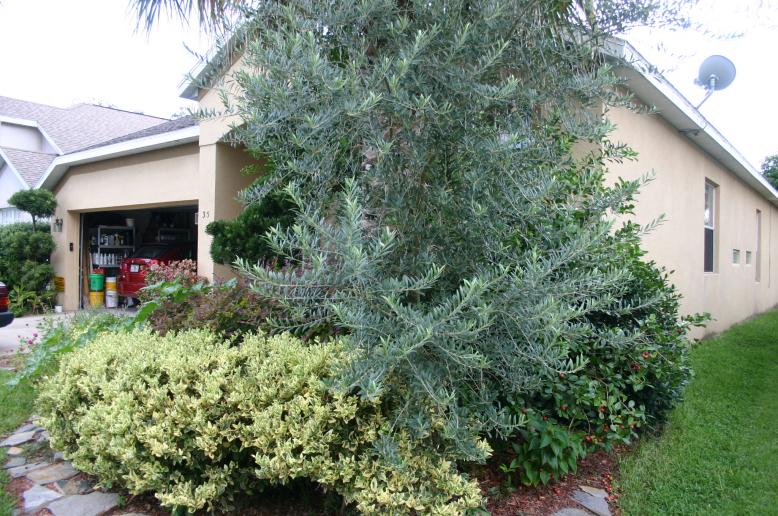
This beautiful landscape includes five edibles in this view alone: an Arbequina olive that has borne olives for the past three years, a strawberry guava showing delicious red fruit, a heavily trimmed orange tree, a Seminole pumpkin, and a Feijoa (Pineapple Guava), which is the beautiful small “tree” on the left corner. They certainly enhance the other ornamental plantings: American holly, ‘Jack Frost’ Ligustrum (the lower yellow-gold plants), Loropetalum, and a Podocarpus (notice the one to the right of the entrance that is trimmed like “Mickey Mouse”). Go figure, this is near Disney.
Friday, December 26, 2014
We are open today from 8-5 and also tomorrow from 8-5. Today, I will be at the Artisan Alley Farmer’s Market in downtown DeLand from 6 p.m. to 9 p.m. with examples of some of our beautiful fruiting plants and vegetables for cool weather. Also, I would like to share three photos of an amazing Phalaenopsis Orchid that has three beautiful bloom spikes and three more bloom spikes emerging. Recently I sprinkled Azomite® volcanic pumice mineralizer around the base of this special orchid. In fact, the only amendment that this orchid has received during the past several years is the amazing volcanic pumice. It is good to know that Azomite (“The A to Z of minerals including trace elements”) is O.M.R.I. listed for organic growing. QGS is the top supplier of Azomite and organic fertilizer with Azomite, so call us today. You will be glad you did. Call me Dana at 386-837-3878, Allen at 386-747-0567, or Alex at 386-785-3297.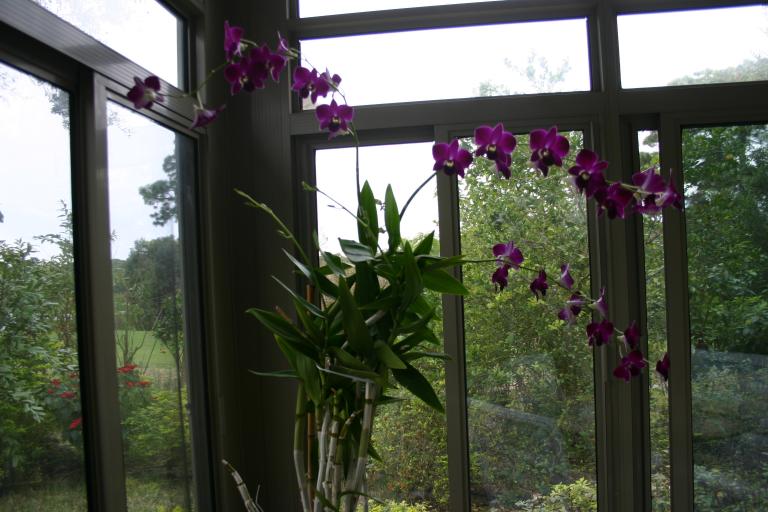
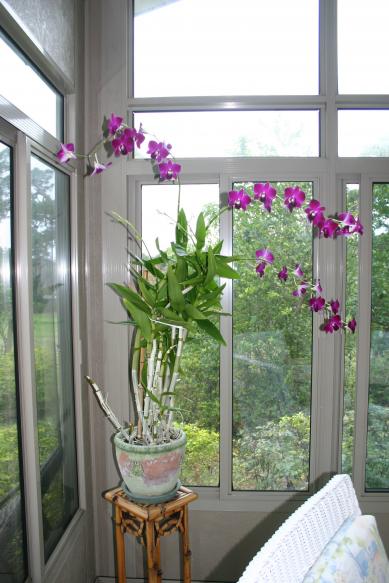
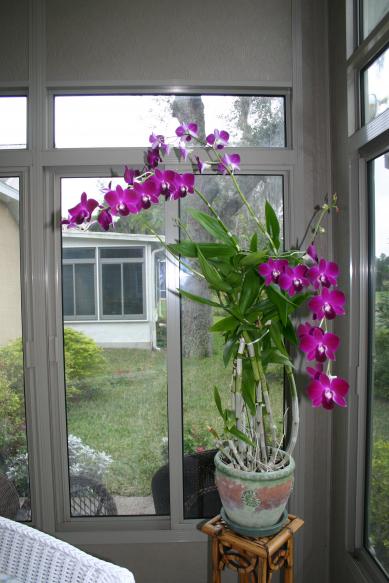
Wednesday, December 24, 2014
It’s Christmas and we will be closed tomorrow December 25. We will be open again Friday, the 26th. Friday from 6-9 p.m. I will be at the Artisan Alley Farmer’s Market in DeLand with plants, veggies, and more. See you there!
Friday, December 19, 2014
The evening at Artisan Alley Farmer’s Market went well. I sold almost all the sweet potatoes and some vegetable plants. Also, the nursery is looking great with a touch of red poinsettias and red cedars as you can see below. Our “Best Fruit Tree Supplier” banner was brought by today by our News-Journal representative.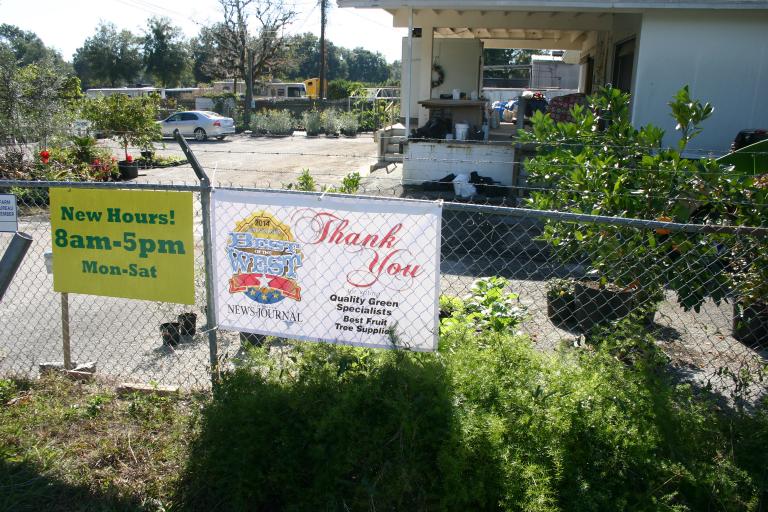
The new “Best of the West” banner, 12-19-14.
Summer, another happy customer at QGS, December 19, 2014.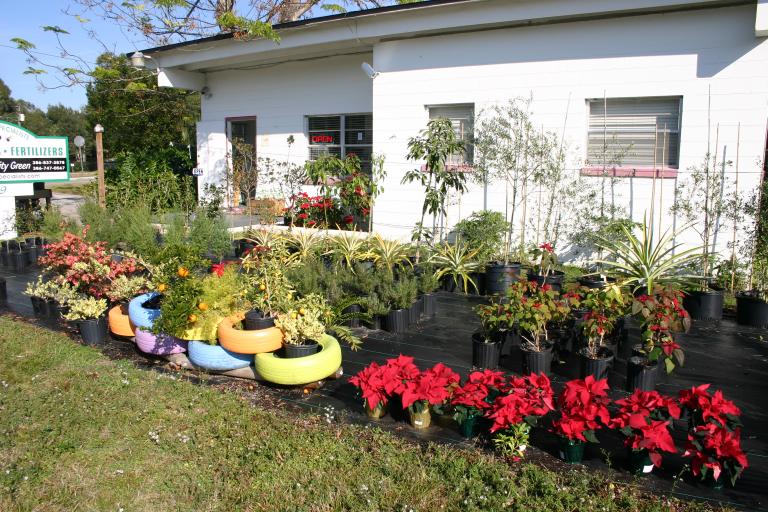
It’s Christmas time in Florida at QGS. December 19. 2014.
QGS sign display of vegetables & poinsettias, 12-19-14 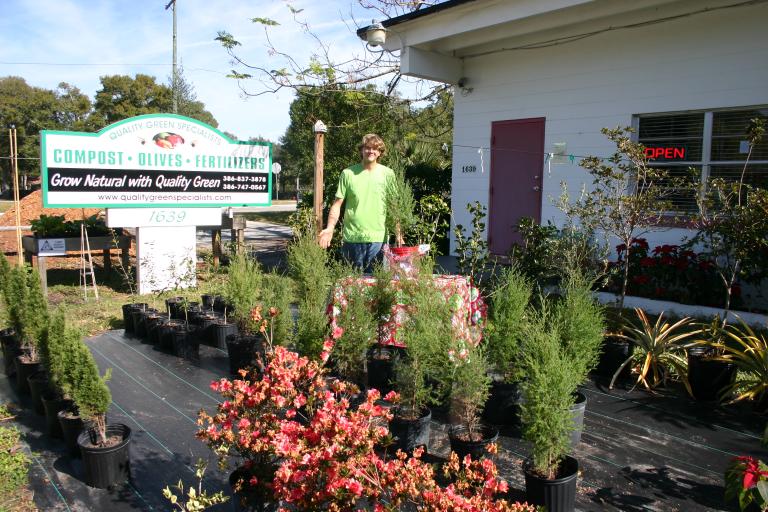
QGS: Alex Andrews displaying “Table-top” red cedars.
Wednesday, December 17, 2014
The weather has a nice chill in the air for that Holiday season. The consultation for the large grove went well on tuesday. Today, Allen and I are finalizing plans for our new “Super Pro” 8-0-9 Fertilizer with Organics.
Tuesday, December 16, 2014
Today, I am doing consulting work on a pomegranate farm and an orange grove. Plus taking samples for a standard soil test, a saturated paste extract test (what is actually dissolved in the soil water solution from rain and irrigation water), and a leaf tissue test. Plus work on recommendations for growers based on laboratory data from completed soil and leaf tissue tests.
My work is cut out for me. Allen is working on a cost per acre analysis for a fifty acre orange grove. Our complete Citrus nutritional & remedial program is surprisingly affordable. Alex is working hard to steadily make Quality Green’s store and nursery even better!
Monday, December 15, 2014
Today, Allen and I delivered Azomite® organic volcanic pumice/mineralizer, potassium magnesium sulfate (SPM), and our breakthrough Citrus Greening Treatment to a Citrus grower in Frostproof. We also did a consultation on a 10 acre orange grove for a grove owner in Wauchula and pulled soil and leaf tissue samples for testing, analysis, and recommendations to improve the grove health and production. Quality Green Specialists will match our testing, analysis, and recommendations against anyone. Our tests are comprehensive and our recommendations are detailed and accurate. Best of all, when our recommendations are implemented, growers see great results. We also delivered Azomite to an olive grower in Haines City. Alex worked hard at the nursery.
Another busy day at QGS!
Saturday, December 13, 2014
The temperature was almost cold at the Artisan Alley Farmer’s Market in DeLand last night. The turnout was still good and I told a lot of people about the Chayote squash because very few knew how easy it is to grow and how delicious it is. There is a photo posted from last week. We have picked dozens of delicious, healthful fruit from the vine on the 15′ x 15′ trellis (and now of the fence) so far. Everyone also enjoyed seeing the big Carambola (starfruit) with ripe fruit on the tree and ripe juicy fruit on other trees I took to the Market. Today is a little warmer. The nursery is looking better. Now is the time to winter-proof your plants with our amazing Azomite® volcanic pumice organic mineralizer. The complete mineral package of Azomite at good ratios (nothing extreme) and high available silicon as silicon dioxide is a great insurance against winter and other stresses!
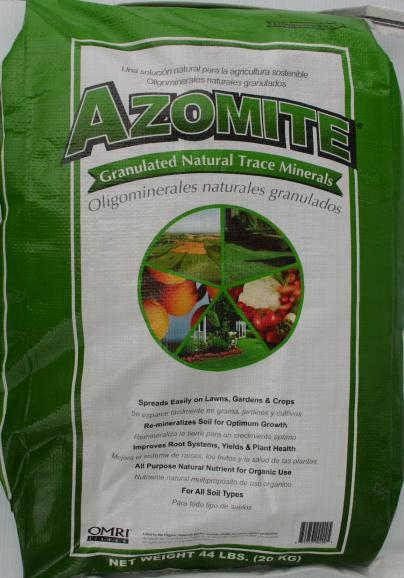
Friday, December 12, 2014
Yesterday, Alex Andrews and I were the “Green Gardeners” on Goliath Radio from 5:15 p.m. to 6:00 p.m. You can listen live every second Thursday at this time on the station’s web site: http://www.big1380.com
Today, I will be at the Artisan Alley Farmer’s Market in downtown DeLand from 6:00 p.m. to 9:00 p.m. Come see some of the special plants we have to offer at Quality Green Specialists and some special treats. The location of the alley is 1/2 block west of the intersection of Woodland Blvd. (U.S. Hwys. 17-92) and New York Ave. (S.R. 44) behind the DeLand Beacon newspaper office. See you there!
Thursday, December 11, 2014
I just completed, along with my business partner, Allen Day, a 16 page detailed article that includes an analysis of establishing an olive grove in mid to north Florida at four different planting densities, low density with 202 trees per acre, medium density with 300 trees per acre, high density with 400 trees per acre, and super high density with 600 tree per acre. The article goes into detail regarding the land preparation, planting steps and cultural practices necessary, as well as as the costs and potential profitablility when planting a grove at each of the four densities. The bottom line is that planting olives in cental to north Florida and the southeastern United States can be hugely profitable when selling gourmet olive oil. QGS has worked hard to help develop a thriving new olive industry. We have the expertise, the contacts and support, and the products to help you become very a very successful olive grower. Call me today and I will send you this 16 page article for only $4.95 plus postage.
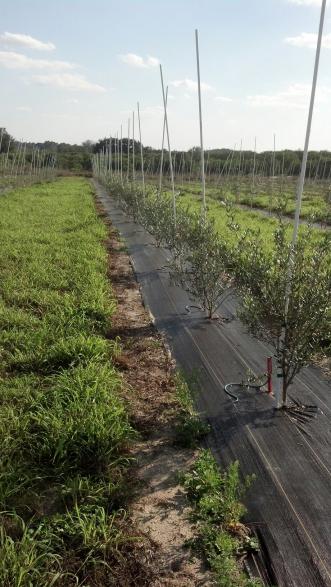
Above: Jim Tschida’s olive grove in Polk City, Florida (near Haines City, Lake Alfred and Winter Haven) with strips of landscape fabric to control weeds, PVC stakes to support the trees and keep them growing with a straight trunk, and micro-jets for irrigation, fertigation, and freeze protection while the trees are being estabished. Once established, olive trees can survive temperatures as low as 12 degrees Farenheit!

Allen Green’s olive grove at 18 months after planting in Port Orange, Florida, a warm coastal area in central Florida. Notice the big crop of olives at an early age. My article describes in detail how to produce big crops of delicious olives that will be very profitable. Pictured is my sister, Louella Venrick.
Tuesday, December 9, 2014
Lots going on today on a cool day in December. We formulated a new liquid nutritional product for enhanced bloom and fruiting of olive trees we call “Olive Thrive”. Lots of consulting, including our advanced, comprehensive soil testing and tissue analysis of plants. Today we consulted with growers about their tests for a Citrus grove, a compost medium, and more. We also received new soil and tissue samples for testing. We made another shipment of Citra Thrive, Mn 6%, and BioWash, our breakthrough Citrus Greening Treatment. Talk about busy. Also, we explored the need for an olive oil presss for the budding olive industry.
Monday, December 8, 2014
I met with a large Citrus grower and his grove manager in Winter Haven, who is very enthusiastic about our Citrus Greening Treatment program and wants to give it a try on a block of trees. Also, I pulled a soil sample and pulled leaves for a tissue analysis for a large grove in Lake Wales. Word is spreading about the effectiveness of our Citrus Greening Treatment.
